by Luis Cotovio and Daniel George

Episode 17: Out of the Forest of Memory
(Japanese Name: 記憶の森から / Kioku no Mori kara)
Director: Kiyoshi Egami
Running time: 24m 41s (21m 00s without credits)
Opening Theme:
- (Cinema/Home Video): Uchuu Senkan Yamato by Isao Sasaki
- (TV):Fight For Liberty by Uverworld
Ending Theme:
- (Cinema/Home Video): Steady as She Goes! Across the Sea of Stars by Hironobu Kageyama
- (TV): Best of My Love by Rei Yasuda
[DG]: This episode starts on Mission Day 90 (275 days left), making it May 12, 2199. It’s coming up on two weeks since the start of the previous episode, which led up to and included the events at Beemela.
[LC]: This episode’s story is mostly original, although its major plot is reminiscent of the original’s Episode 18 and it takes a couple of cues from Episode 21. We’ll discuss more details where appropriate.
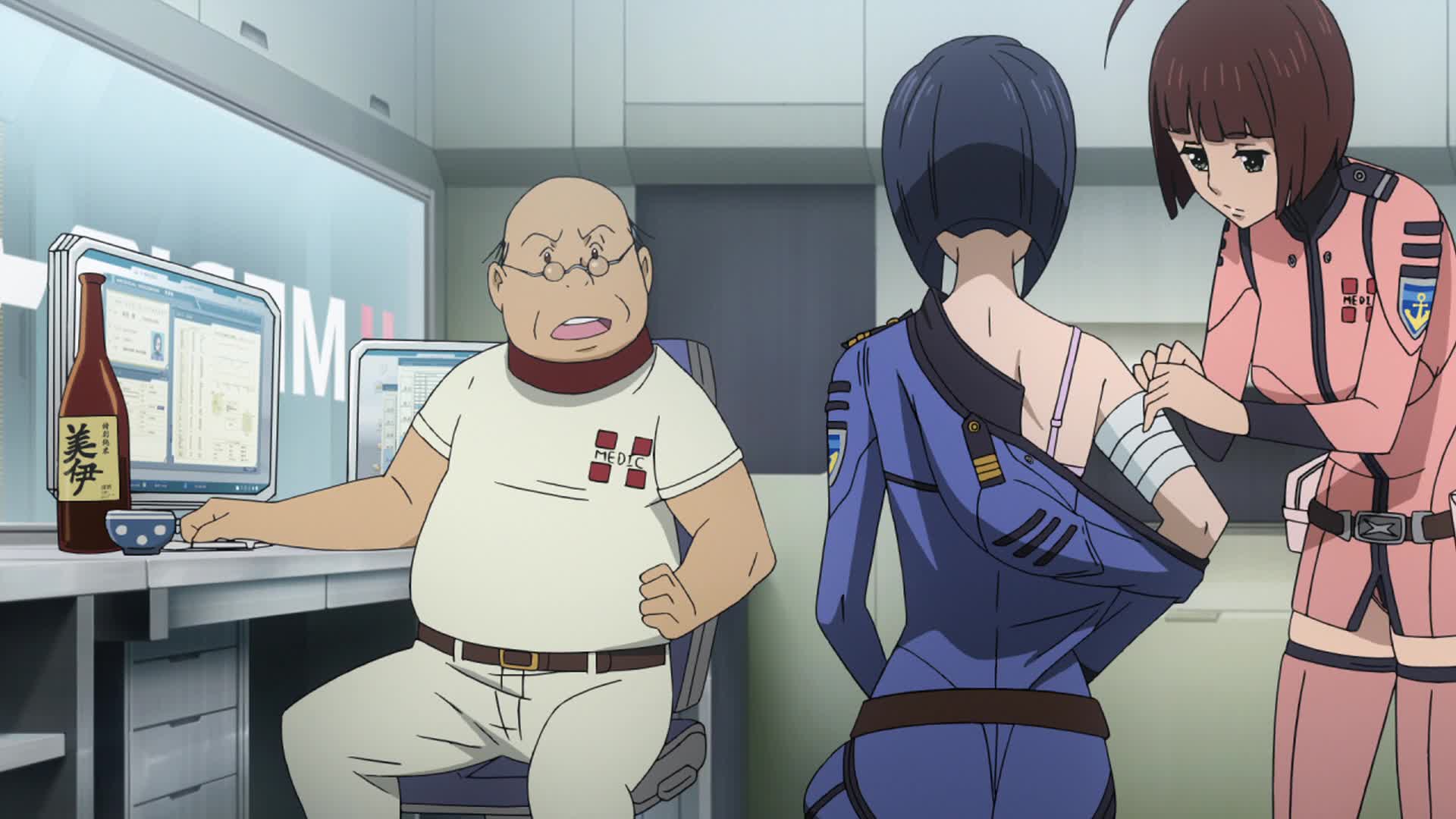
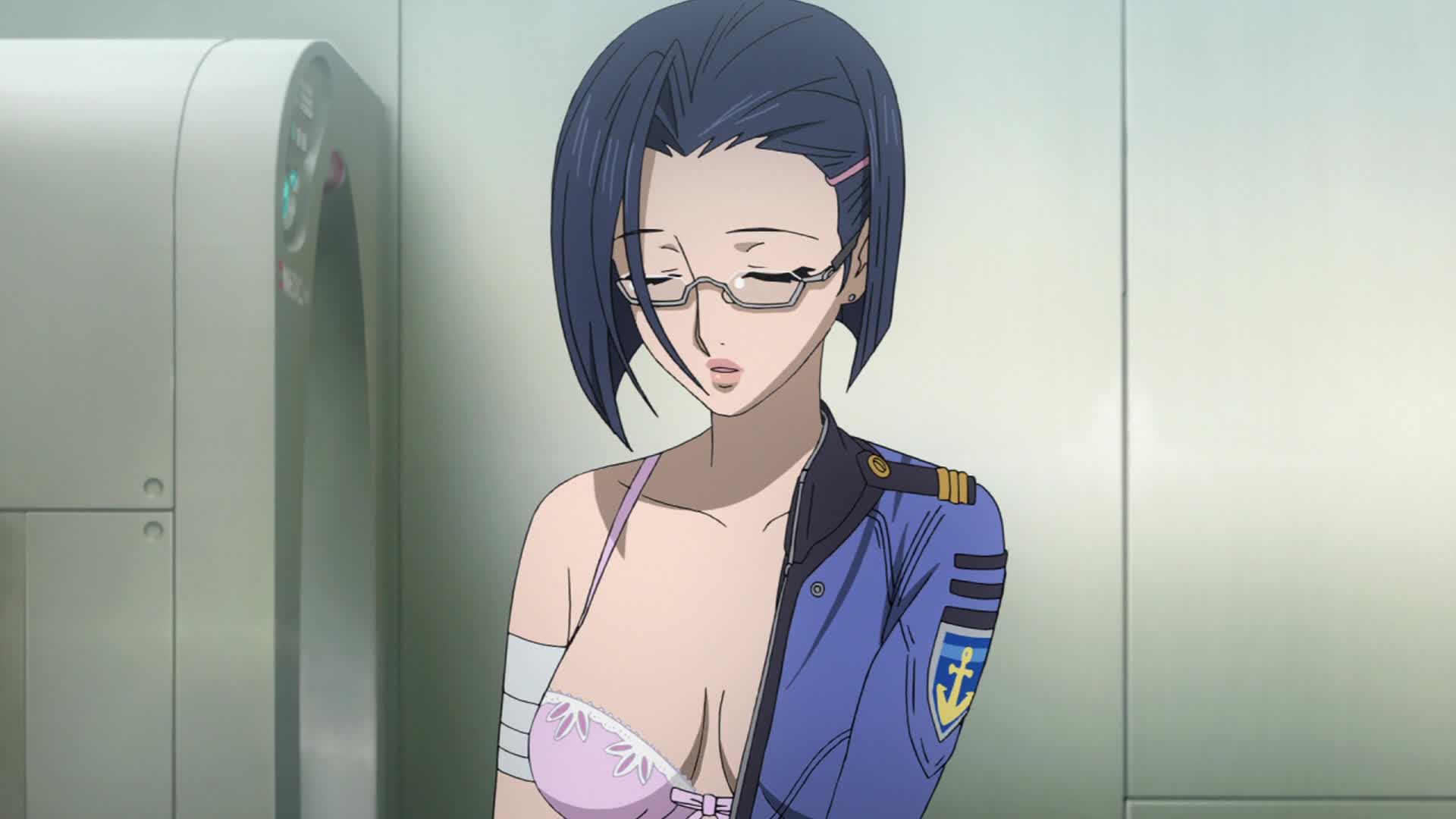
Yamato moves toward the edge of the Beemela System. In the medical section, Sado and Makoto tend to Niimi, who injured herself tackling Ito to save Shima’s life. Sado wonders how such a smart girl made such a stupid decision like siding with Ito. As she zips her uniform, Niimi recognizes she made the wrong choice, an admittance that surprises Sado.
[LC]: This shot gives us only a tiny glance at what’s under the women’s uniform, or for that matter any of the crew uniforms. For all the complex details that were added to the 2199 version of the uniform, very little was ever seen on-screen about how all the layers work in various situations.
Admittedly, after seeing some of the more graphic material published in Nobuteru Yuuki’s artbook and other production materials, that was probably for the best. XD
[DG]: Carefully-planned fan service? Kaoru’s requiring of a bandage is legit, since she was wounded when charging down Ito when he was about to execute Shima. However, it serves a very important purpose: proof positive that in this incarnation, the female crew uniforms aren’t painted on!
Personally, I think there’s a basic distinction between what is fan service and what is not. I think this scene is not fan service. Why? My distinction is simple: this is part of the narrative. She was injured and is being examined. Obviously, she needs to have her uniform open so Sado can do his job.
Now, if there was a close up of her chest or some boob-bounce as she closed it, THAT would be fan service, pointless and gratuitous. Some ass or crotch shots in previous episode are fan service. Conversely, shots like this one or even the bath scenes in episode 11 (which get pretty close to the line) are actually part of the narrative and serve to advance it.
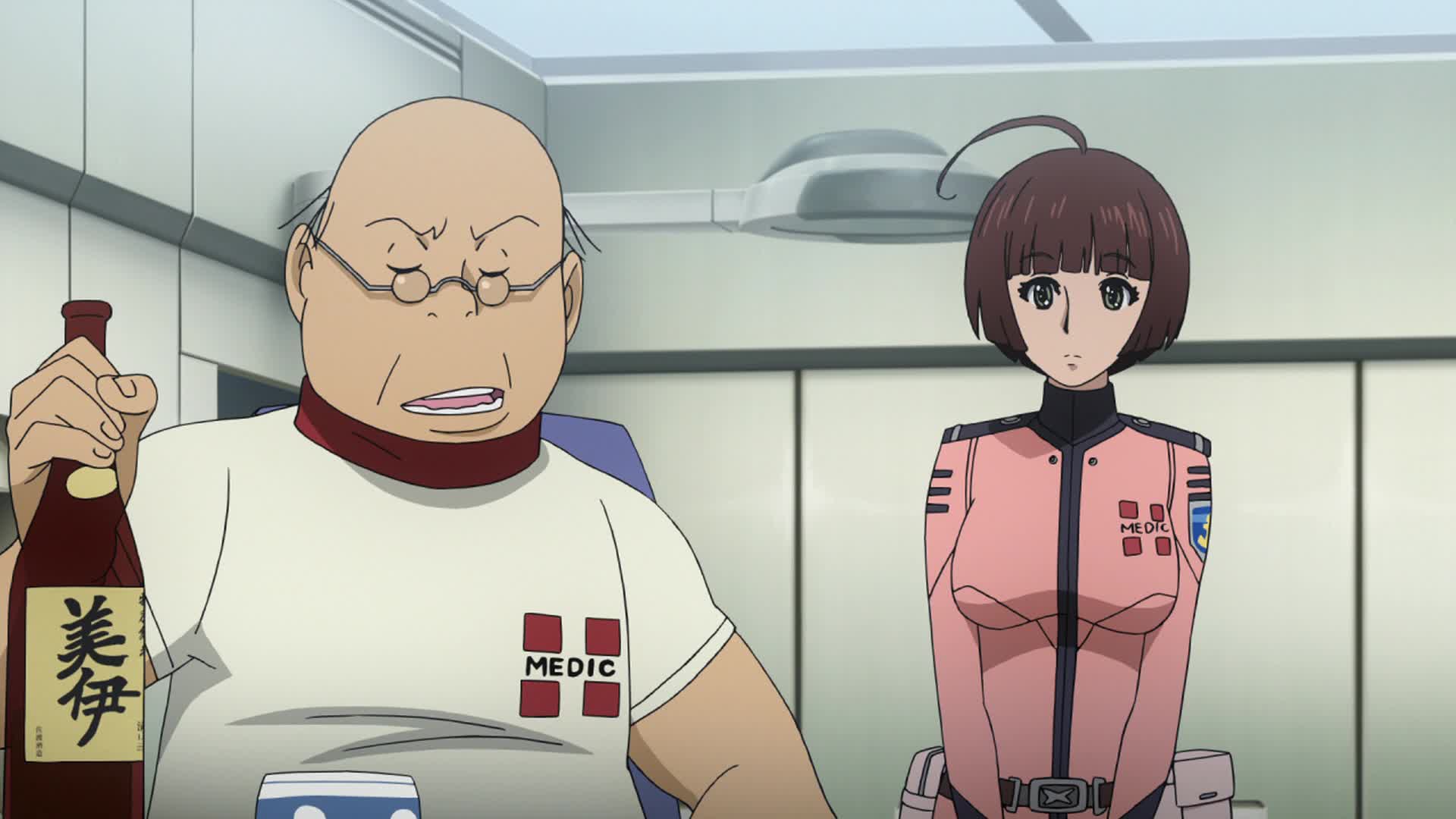
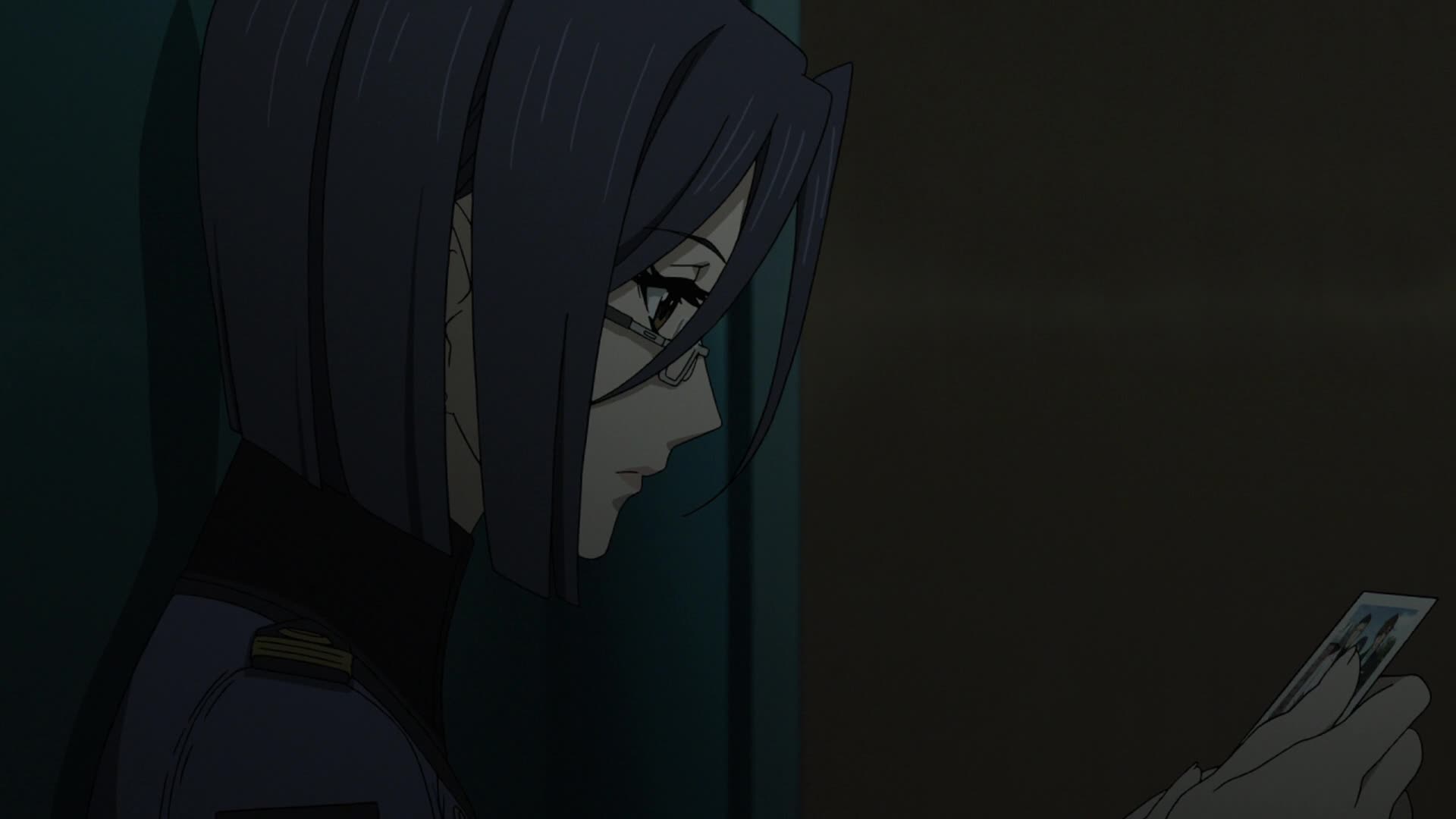
Hoshina is waiting to escort Niimi to the brig. Niimi thanks Sado for his assistance and leaves. Makoto asks Sado if it’s true that Yuki is an Iscandarian. Sado just says that’s even stupider. Niimi is left alone in her cell. She takes a picture out of a box with a few belongings and gazes at it with a certain nostalgia.
[LC]: You can’t help but believe her. All the confidence and duplicity that Niimi has displayed seems to have totally disappeared. She probably never anticipated Ito’s radical actions, especially that he would put a gun to her head for disagreeing with him. Staring death in the face can be quite an eye opener.
Apparently, Sado shares my opinion about this whole Yuki-is-Yurisha nonsense.
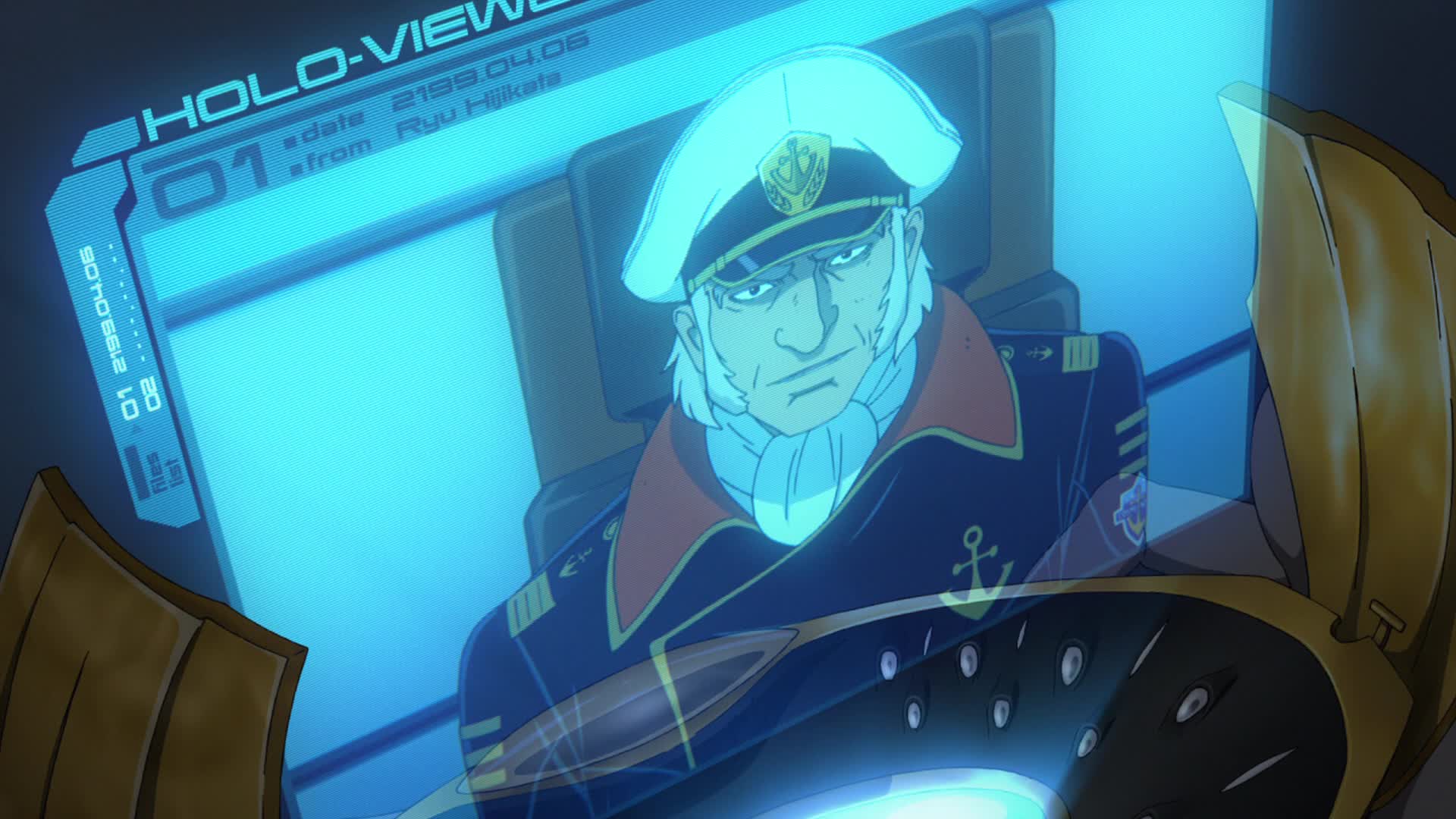
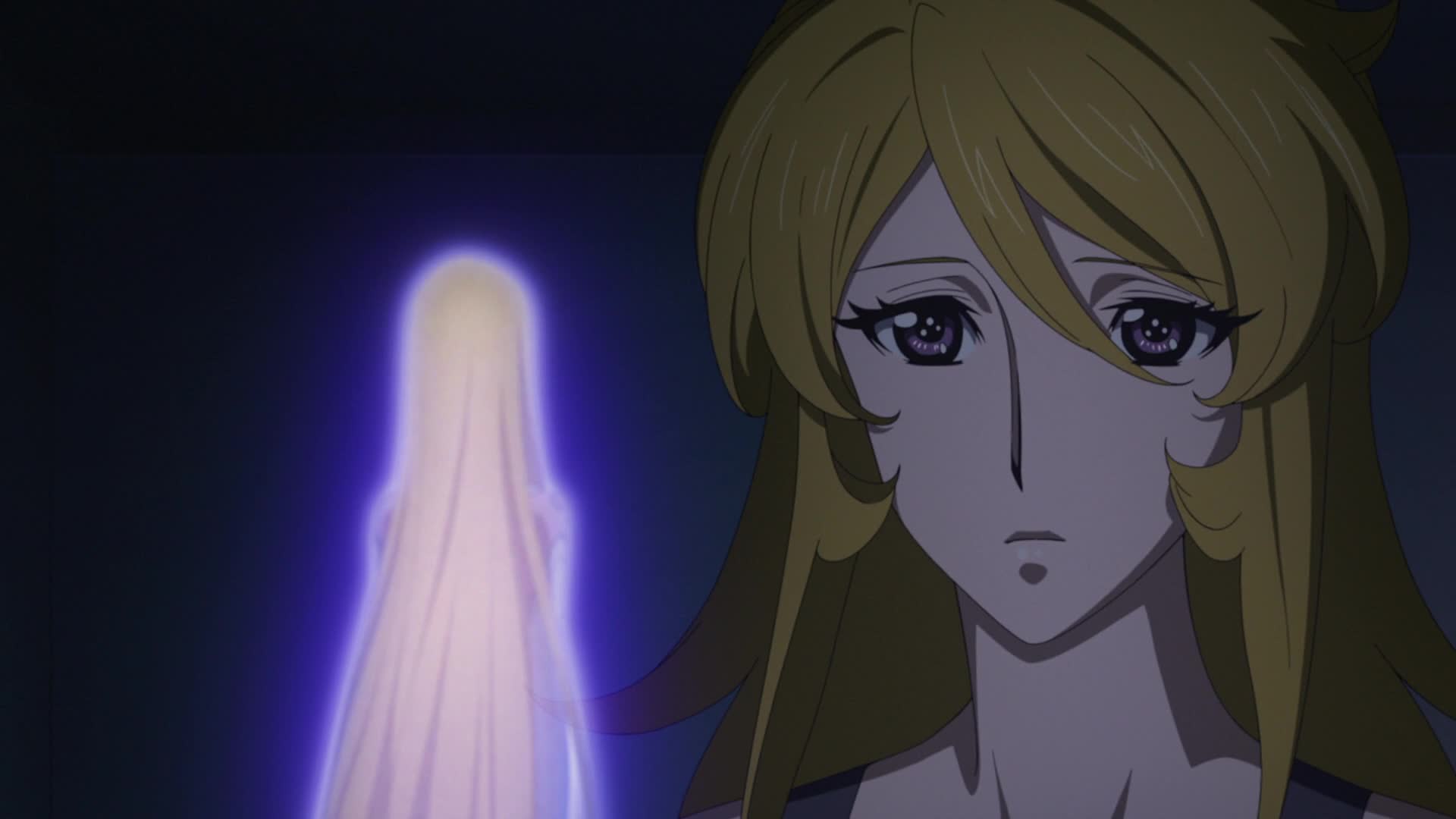
Meanwhile, Yuki is in her quarters, looking at a message in her golden capsule, recorded by admiral Hijikata. He comments on the message recorded by Starsha, entrusting her sister with such a dangerous mission. He tells Yuki she might learn “the truth” during the long journey but that she mustn’t let that sway her. He wishes her safe travels until they meet again. The holographic display with Hijikata’s message closes, followed by Starsha’s own message. Yuki looks at it, rattled by self doubt.
[DG]: Hijikata’s message, at least in English, hints that the question of Yuki’s identity is not an open-and-shut case. However, “You may figure out the truth during this journey” suggests that Yuki still doesn’t know the truth, or possibly, no one else does either. “But don’t let that sway you” also makes you think. Sway Yuki from what? Her mission? Her being “human”?
[LC]: Based on what we learn later in the episode, I think you’re stretching it. There’s a much simpler interpretation for Hijikata’s words. When he speaks of Yuki learning the truth, I believe he’s talking about what they’ve done to Yurisha, which we will learn in a bit. Since only Okita and Sanada seem to be aware of that particular situation, the ethical and moral implications might have some among the crew questioning it. Hence his hopes that learning the truth won’t sway her from seeing the mission through.
The key issue with this scene is the date on the video email from Hijikata: April 6, 2199. Going by normal email convention, this is the received date. Of course, since it’s been established that Yamato left on February 12, this creates a quandary. Is the date plainly wrong? That’s the most likely scenario, but considering that the device is Iscandarian, is it possible that the message was sent by Hijikata post-launch? Back in Episode 7 we heard references to “hyperspace communication.” But this appears to be a throwaway line, since communication with Earth was not possible once they crossed the heliopause. Aside from that, it’s the only time the term “hyperspace” has been mentioned in the entire series.
There are other possibilities; date read, date last read, or maybe it was copied from somewhere else. The easiest explanation is that the date is just wrong. After all, Yuki is closing the device in Episode 2 just before Kodai enters the bridge. There’s a 50/50 chance she was looking either at Starsha’s message or at Hijikata’s.
[LC]: I think the date is supposed to be the present date. There are many examples suggesting that the entire story timeline seems based on the obvious error Yamato launched on January 17. That would be impossible, since that’s when Operation M2 and the first half of Episode 1 take place. Factoring in that mistake, it would place this episode in early April instead of the date we have more correctly attributed. Hence the April 6 date on the message.
[DG]: I don’t think it’s meant to be the current date at all. That makes no sense either, because the difference between February 12 and January 17 is 26 days. April 6 is 36 days back from May 12. That’s a ten-day discrepancy, as it would be April 16 if January 17 was the actual departure date. The end assumption we have to make is that like many of the on-screen displays, the date is meaningless gibberish. The only on-screen display that’s been consistent with time prompts in the series so far (or for that matter had any real discernible dates listed) is the one containing Shima’s personnel file.
To me, we don’t get any evidence that the timeline has jumped the shark until Yuria’s opening monologue in Episode 25. All evidence up to that points to the February 12 launch date, so I don’t know where you’re getting the idea that “there are many examples” that the entire production timeline seems based on a January 17 launch date. In the end, my biggest criticism of this series as a whole is that the production and writing teams don’t seem to have kept a handle on the timeline, and for a series that prided itself on scientific accuracy, that’s bemusing.
An interesting note from a technology perspective is that Hijikata’s message is projected from the large central light source, while Starsha’s is projected from all the smaller ones surrounding it. The Starsha message looks to be 3D while Hijikata’s looks more 2D.
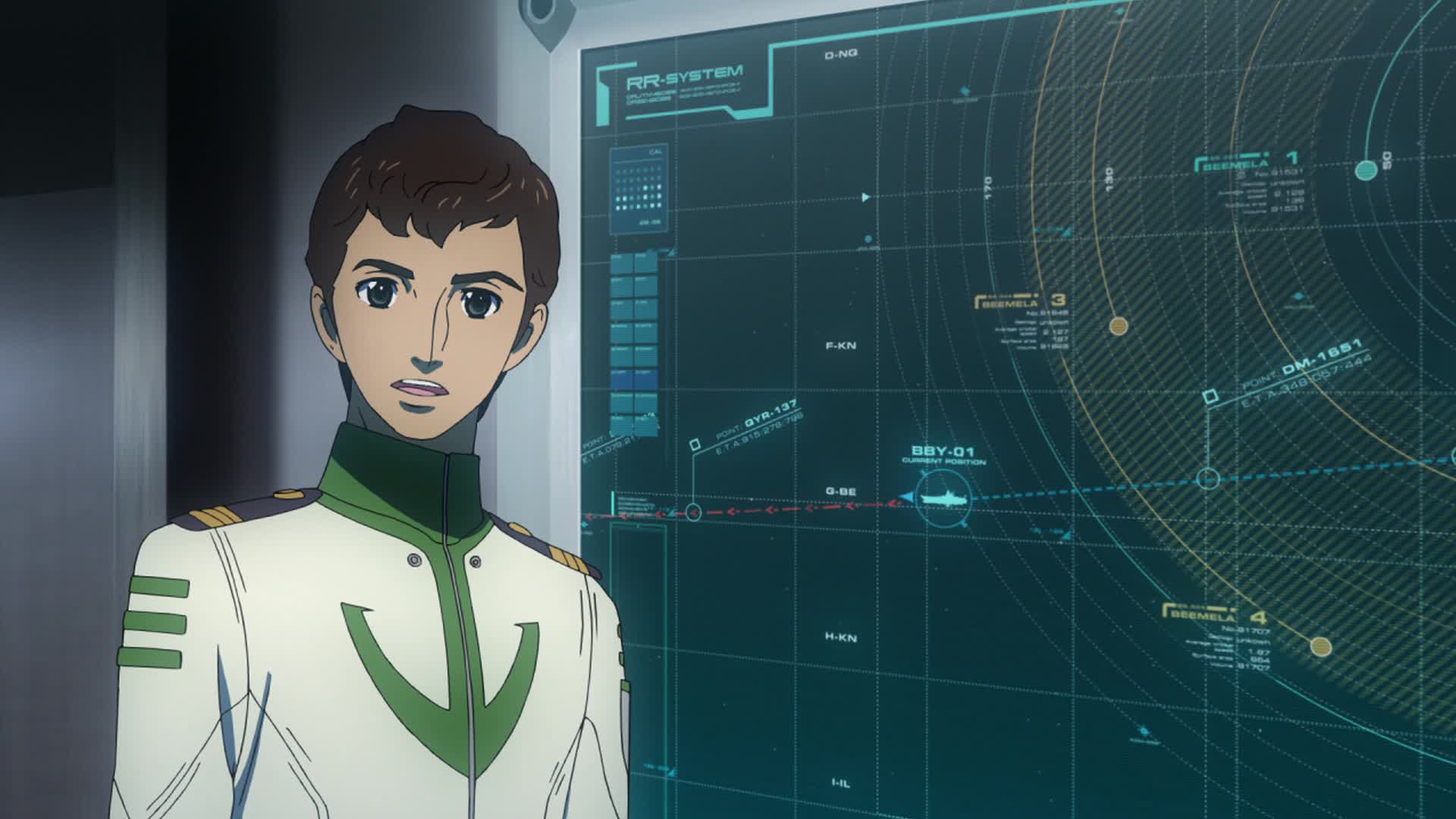
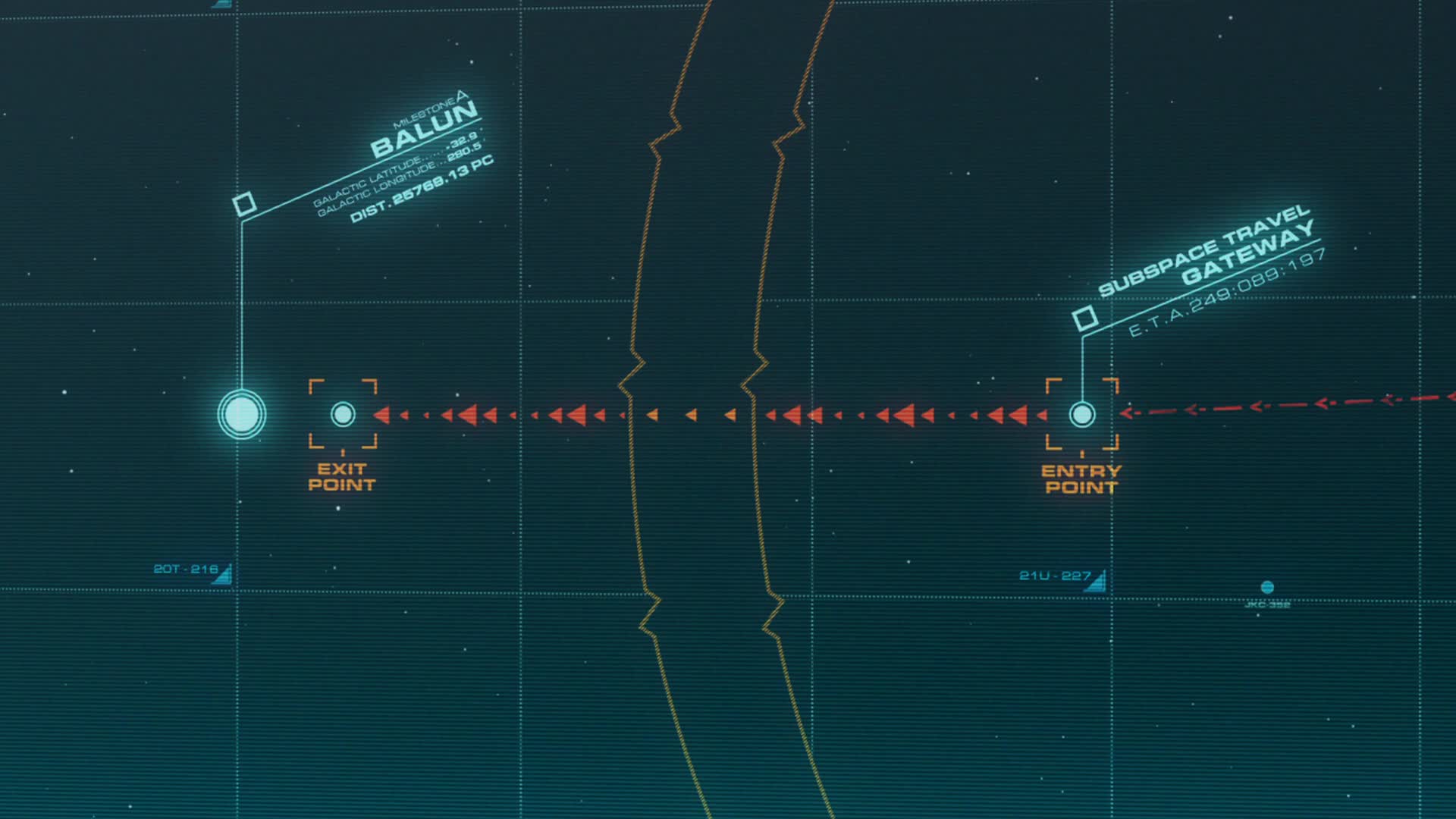
In the navigation room, Shima is reporting on their current situation. They are already 35 days behind schedule, but the use of a subspace gate will allow them to jump 30.000 light years in one go, all the way to planet Balun.
[DG]: The map is not to any scale, but it’s interesting to note that they’ve either only just left the Beemela system or are still on the outer edge of it. Perhaps they turned around and went back to resupply?
Hyothetical scene after the end of Episode 16:
Yuki: What about the supplies?
Okita: …
Shima: …
Hirata: …
Kodai: …
Sanada: Well, ^%$#@!
(Yamato does a 180 degree turn, goes back and resupplies).
Well, based on the image above left they’re headed for the outer limits of the Beemela system, where the subspace gate is located. Makes sense, since you would want it placed outside the gravity well of Beemela’s sun. As for the supplies, they may have taken place in the jump at the end of episode 16. They would also need some time to figure out the data in the core and the actual location of the subspace gate. But your take is funnier.
The map points are taken up with more nonsensical E.T.A. times. Balun shows the distance 25,769.13 PC (Parsecs). This is roughly 84,000 light-years, the distance to Balun from Earth rather than from Beemela, and one quarter of the 336,000 light-year round trip to and from Iscandar. This is the exact same number seen on the electronic chart in Episode 11.
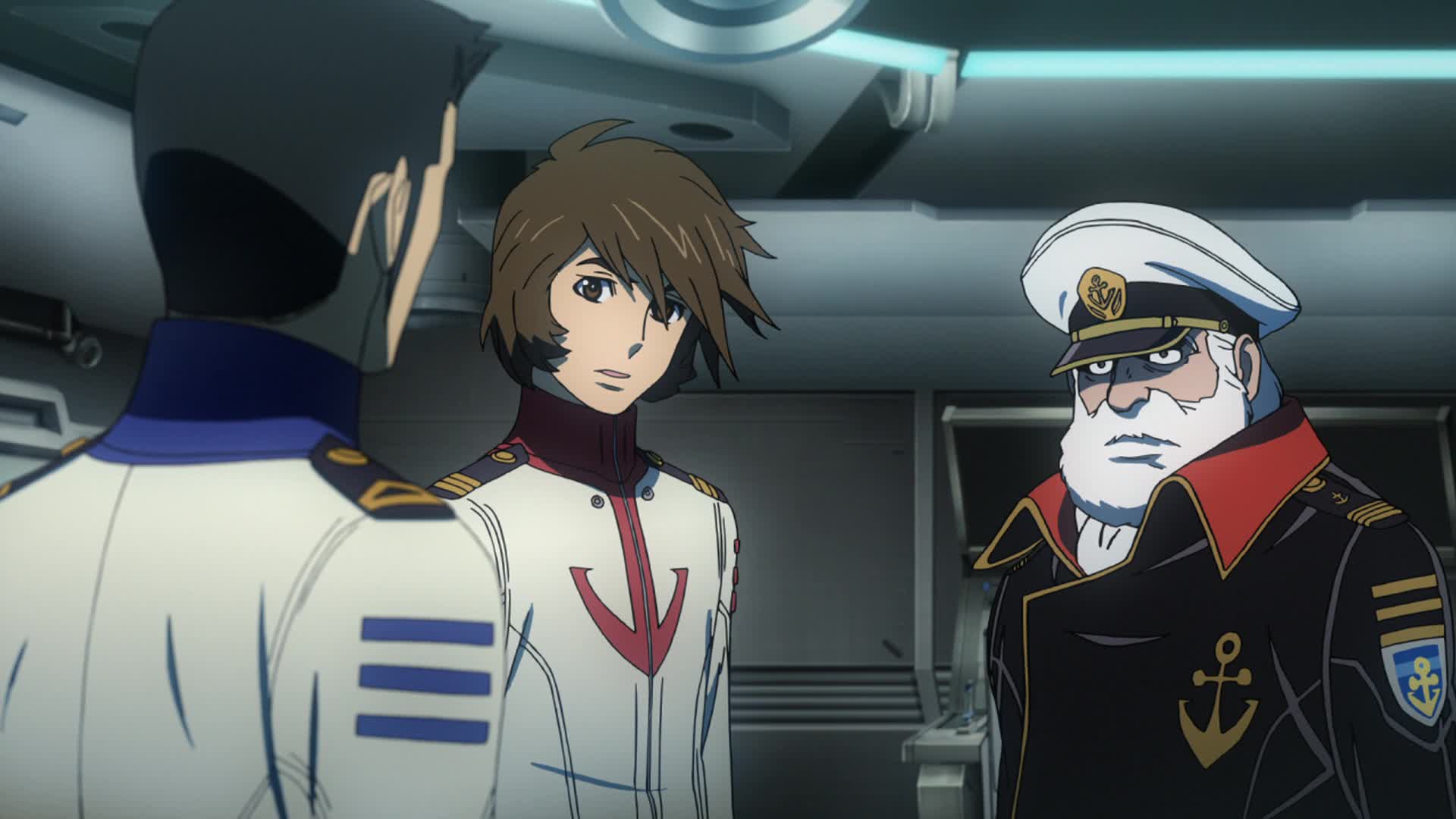
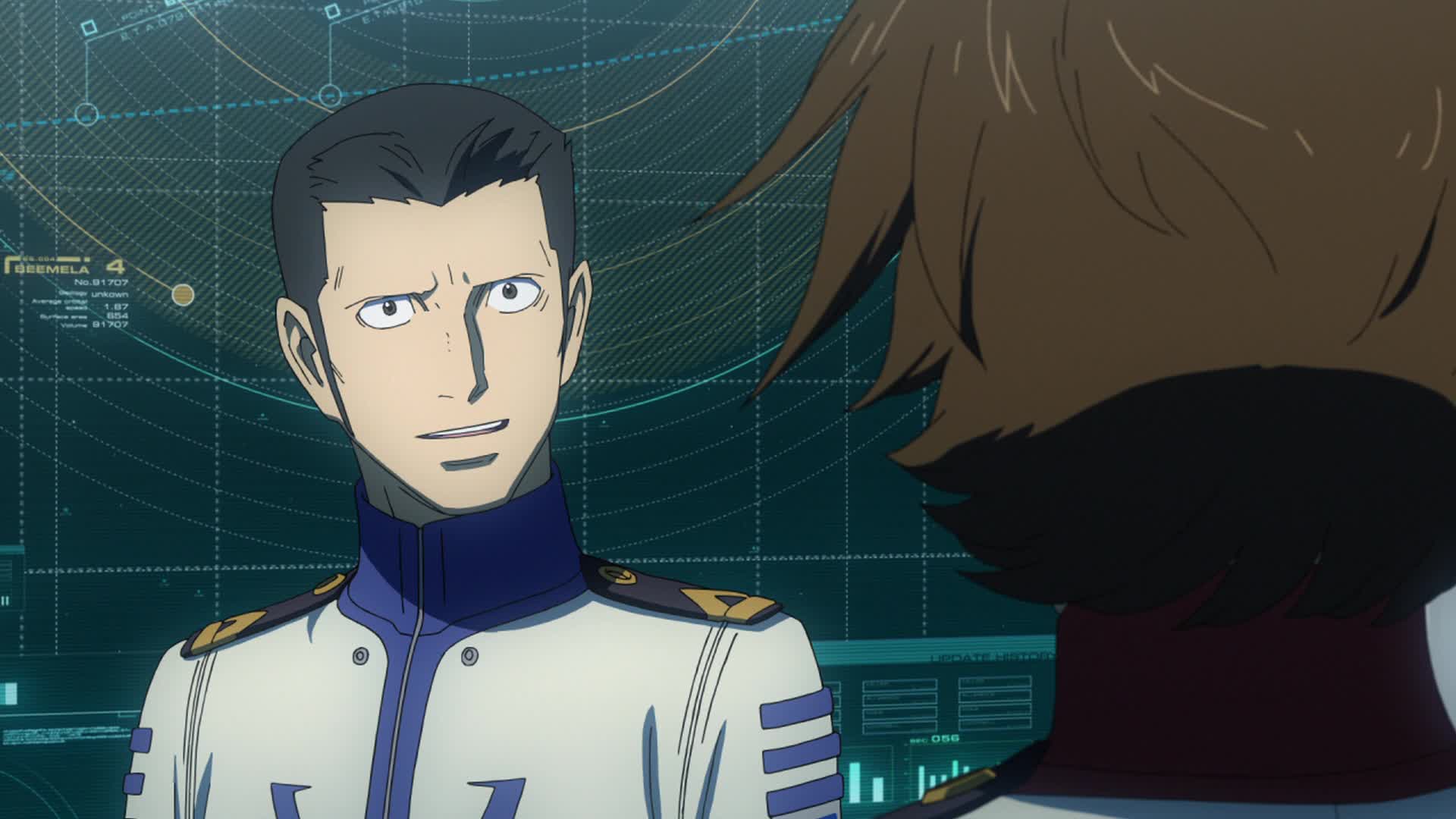
Sanada says that the gate’s control satellite is near, but he’s not certain if they can take control of it. The data recovered from the core found on Beemela contains records of a race which currently controls the gate system, different from that which built it. Okita asks who controls it and Sanada says their name was in the data, too. Noticing Sanada’s hesitation, Kodai tells him to hurry and say it already. Unsurprisingly, it’s Garmillas.
[LC]: I guess this was the moment in which that fancy theory about Garmillas being somewhere in the Milky Way galaxy went down the drain. And still, one has to wonder… Wouldn’t the location of Garmillas be in that data? Or at least the location of its nearest gate? We saw Celestella using it in episode 14, right? So why does it take another four episodes to find that out?! Guess dramatic revelations trump logic.
[DG]: If that were the case, Iscandar’s location would also have been on it. They don’t want to reveal that little gem to the crew until later in the series…
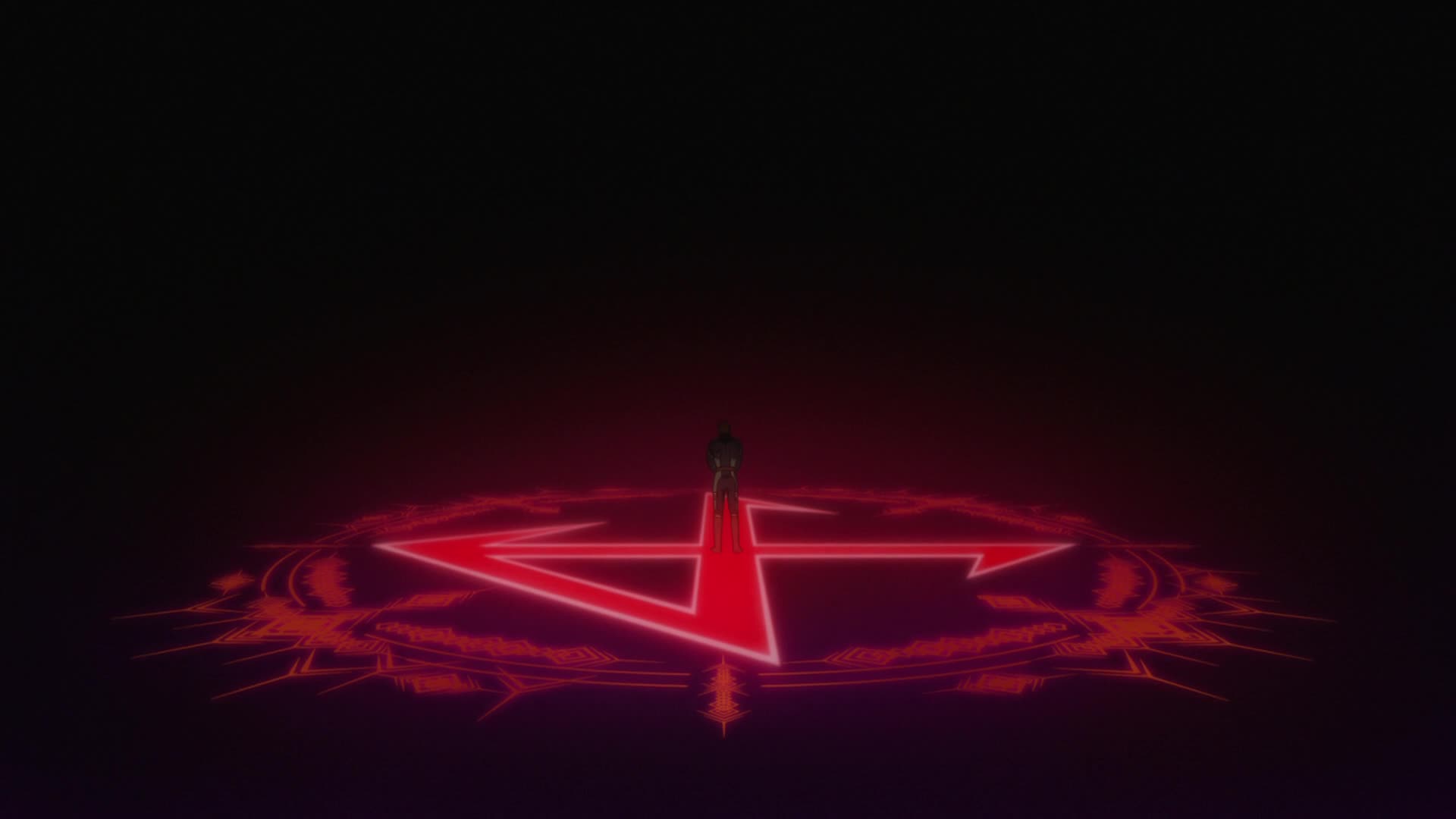
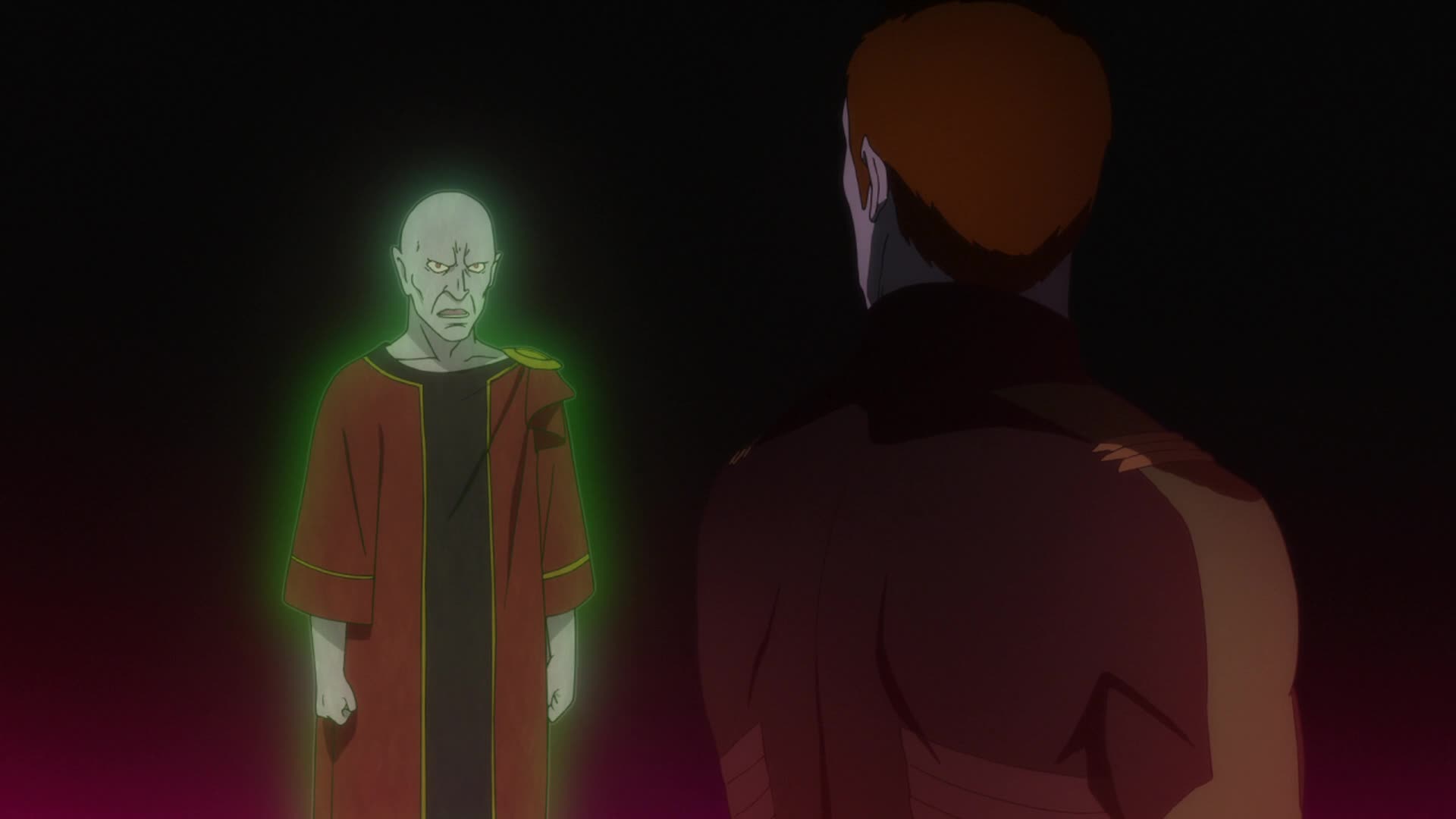
At that moment, on the Garmillas home planet, a handcuffed General Domel stands in a large, darkened room. He demands to know why he was recalled when he was seconds away from destroying Yamato. A hologram of Vice-President Hyss informs him that Leader Dessler’s ship was destroyed through sabotage and the Leader’s been assassinated.
[DG]: It should be noted that in the original screenplay, this was the opening scene of the episode. Hyss was not in it, and three off-screen voices were heard in addition to Gimleh and Domel. Going by the text, it seems Hyss was added in later revisions to make the trial more resemble the scene from the original series, where Hyss presided over Domel’s trial.
The phrase “this morning” in the subtitles makes no sense. Quite a number of days must have passed by now unless this is a flashback, and there’s no suggestion (in an episode riddled with flashbacks) that this is the case. Thanks to a translation of the Japanese by a native-speaking friend, I can confirm that the reference to “the early hours of the morning” or “this morning” is actually in the spoken dialogue.
[LC]: Yeah, that line makes no sense. Also, there’s no way this could be a flashback. Not only is there no narrative indication of that, but the following scenes take place right after the trial, as seen by Zoellik’s reaction. Since Dessler was “killed” even before Domel’s fleet attacked Carrel 163 and the whole Izumo mutiny played itself out, two or three weeks have gone by. So… either it’s an error or the days in Garmillas are really, really long.
[DG]: I’m going to go with sloppy scriptwriting. It seems to be the norm in this episode.
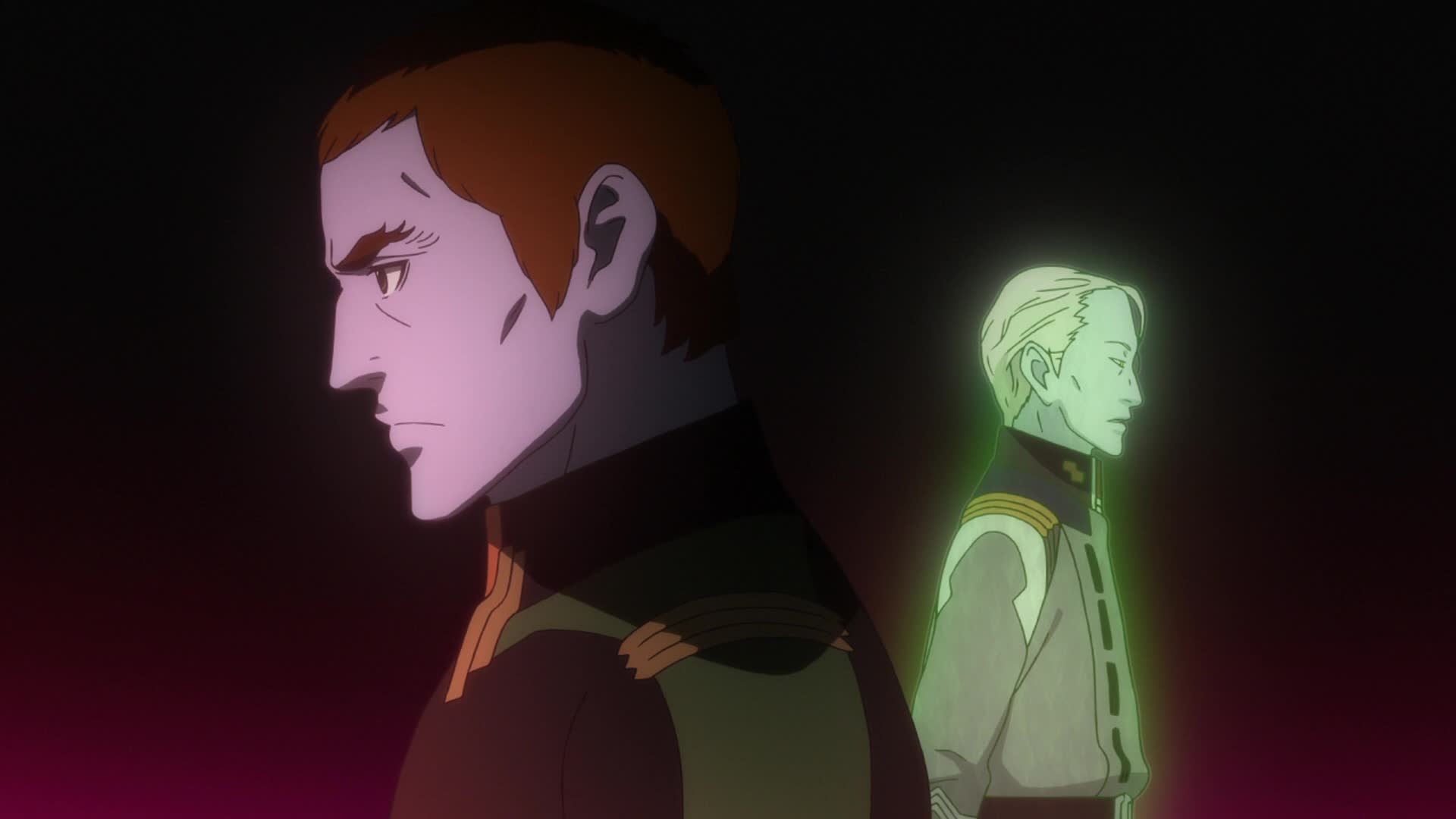
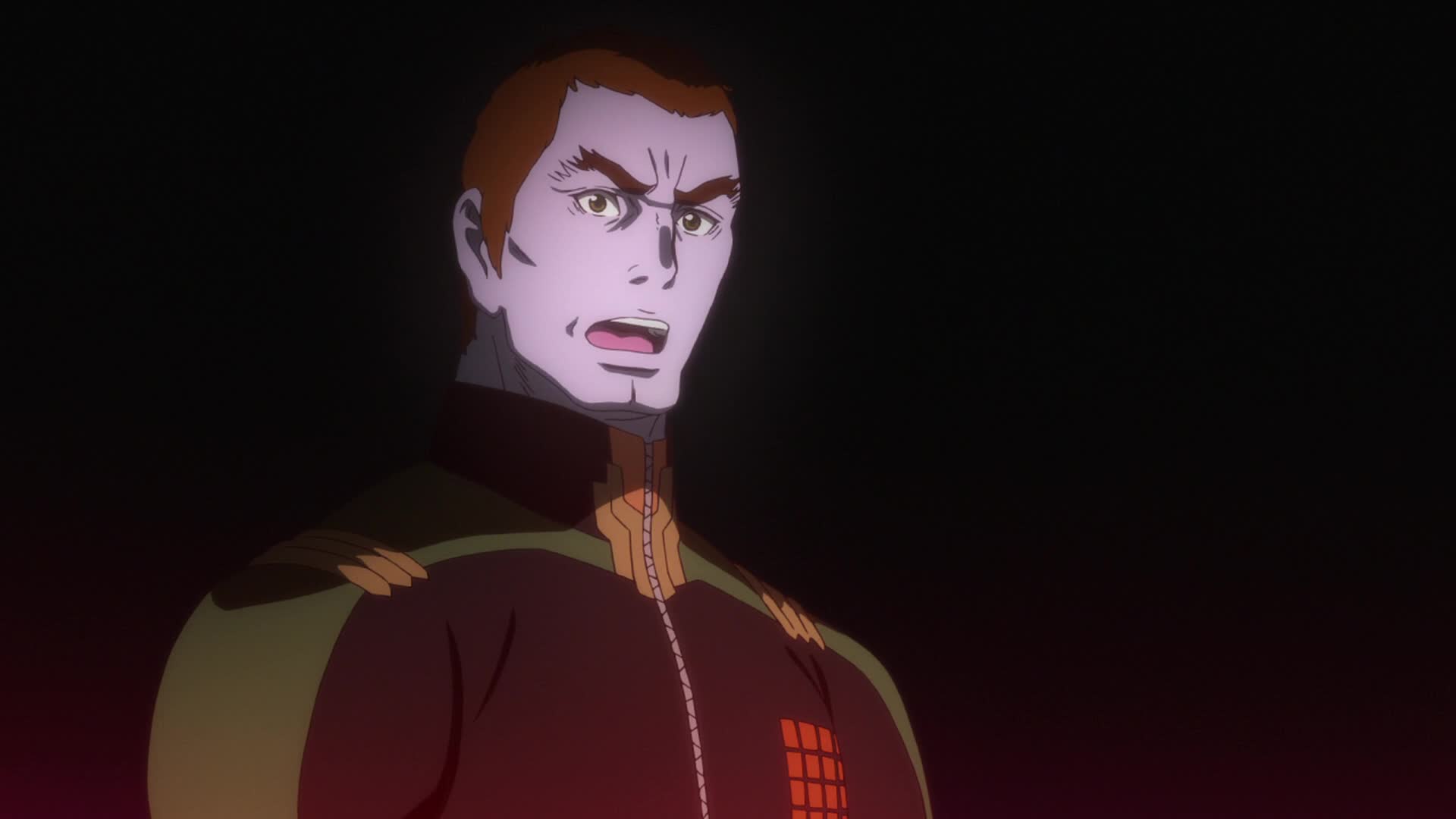
Domel is stunned. A hologram of Gimleh appears. He tells Domel that only two people knew of the Leader’s plans to visit Balun, Admiral Dietz and Domel himself. Domel sighs, anticipating what’s coming next. Gimleh is accusing him of plotting the Leader’s assassination. Domel tells him that’s crazy. Gimleh questions if Domel and Dietz worked together to assassinate Dessler and take control of the empire, which Domel categorically denies, telling Gimleh he has no time for childish fantasies. Amused, Gimleh wonders if they are indeed fantasies, even though Domel’s wife has been arrested.
[DG]: This trial reeks of the Volksgerichtshof, the “People’s Court” of Nazi Germany. This was a notorious special court set up by Hitler, after all but one of the defendants tried for starting the Reichstag (Parliament House) fire of 1934 were acquitted. It was infamous in that it operated outside the normal bounds of German law, and it was nothing more than a “kangaroo court” used to condemn opponents of the regime to death for treason. The presiding judge was dressed in red robes, not dissimilar to those worn here by Hyss and the jurors.
Domel’s inspiration, Field Marshal Erwin Rommell, was spared from facing the Volksgerichtshof’s judgement after being implicated in the unsuccessful July 20 Plot to assassinate Hitler in 1944 (depicted in recent years in the movie Valkyrie). When his involvement in the plot was brought before Hitler, the Fuhrer realized that branding Rommell a traitor would destroy morale on the front. Instead, he offered Rommell an alternative: commit suicide. His death would officially be announced as succumbing to wounds, his family would receive a full pension, and he would be buried with full military honors. If he refused, his staff and his family would all suffer dire consequences (his staff would have faced execution, and his family would have been hauled off to concentration camps like the families of the plot’s ringleaders).
Here it looks like Gimleh isn’t affording him this opportunity. He’s already arrested Elisa, and it’s reasonable to suspect that had his son still been alive, the boy would have faced imprisonment also.
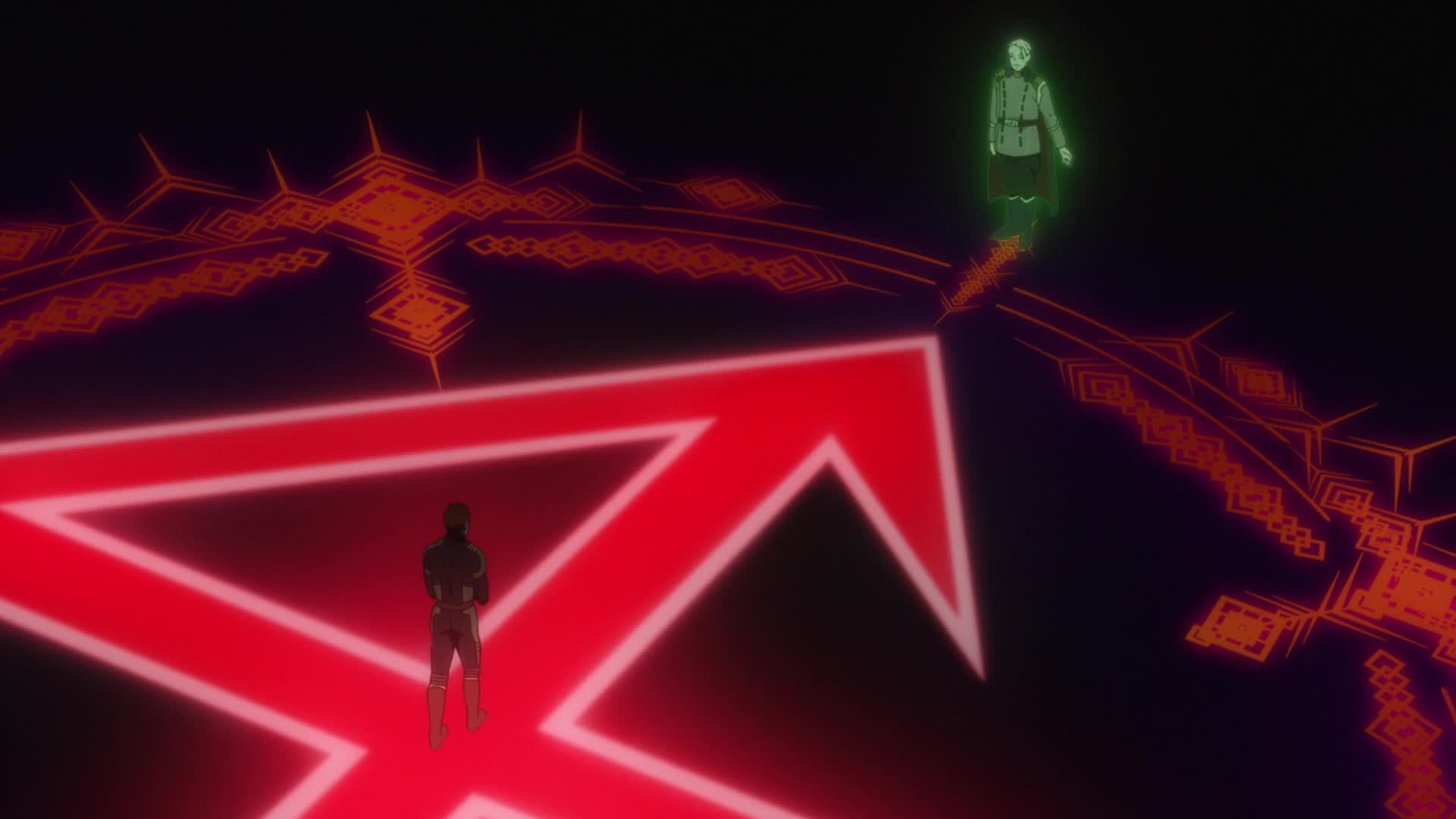
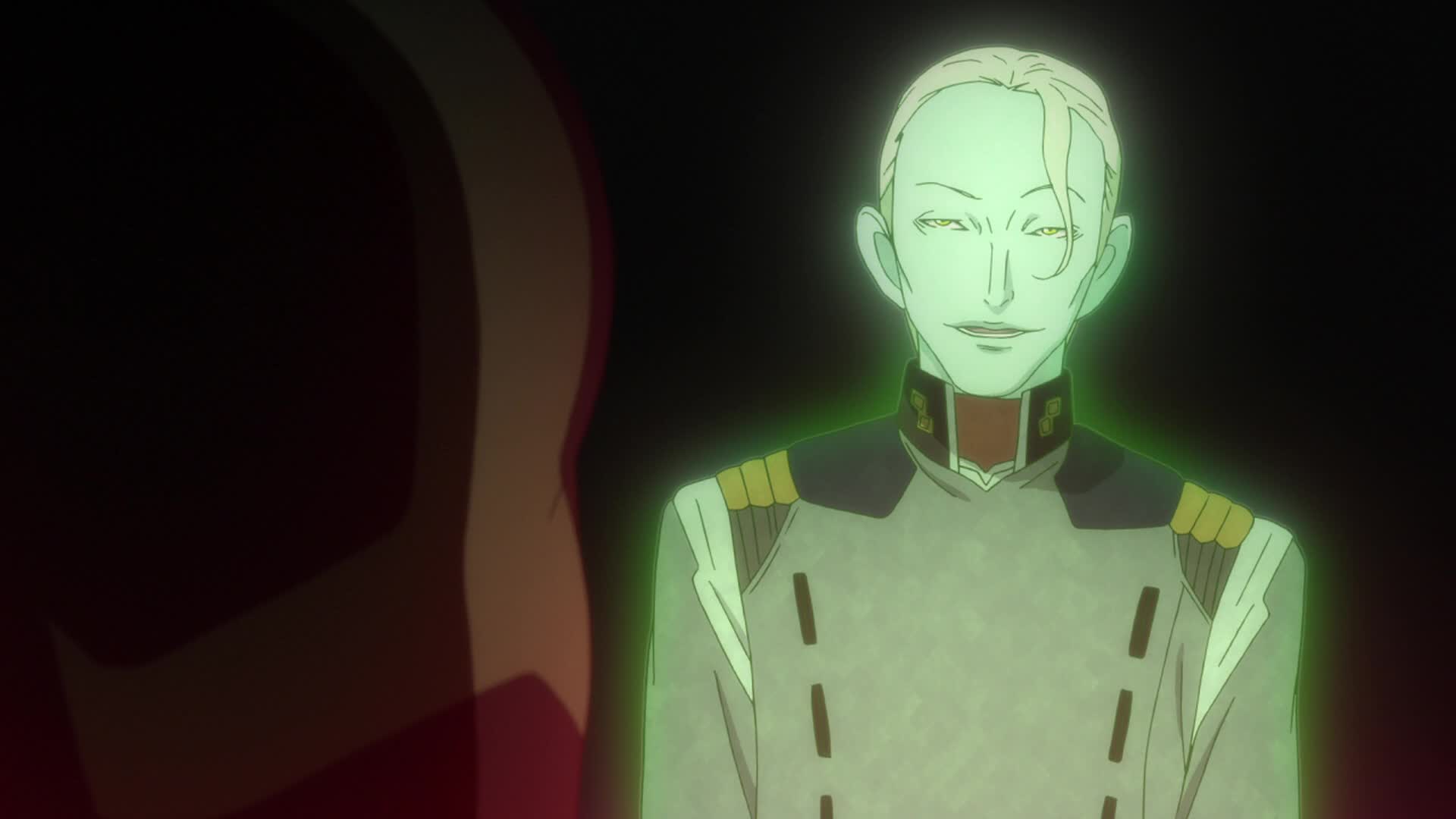
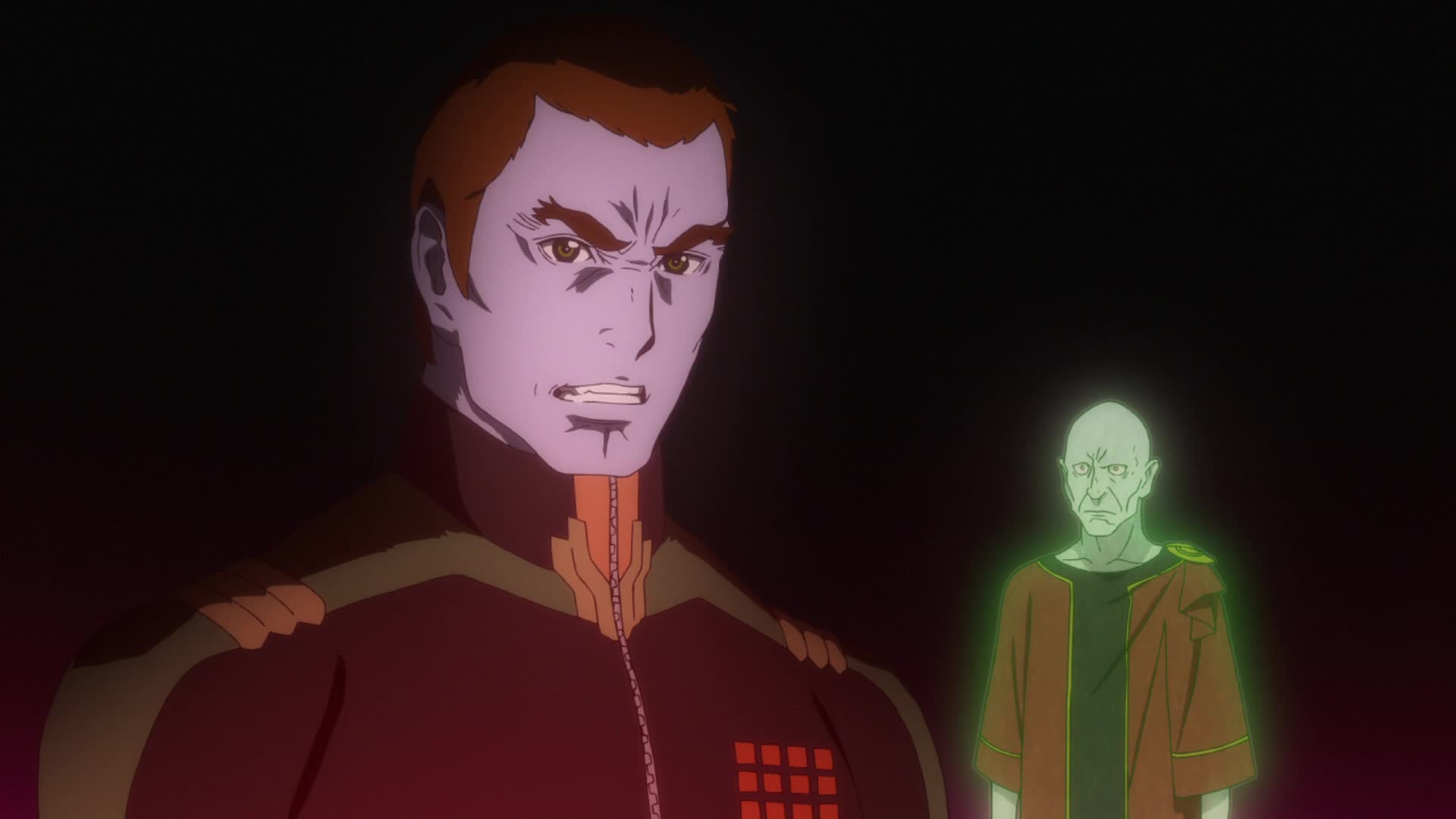
Caught off guard by this, Domel asks what has Elisa done to be arrested. Gimleh reveals she’s been part of an anti-government movement, but Domel says there must be some mistake. Gimleh replies that is what everyone says. He proceeds, saying that order is the foundation of any nation. It must be maintained, and those suspected of wrongdoing must be punished without exception. Domel knows he’s been played, giving an irate look at Gimleh, who smiles with undisguised satisfaction.
[DG]: The trial is a sham; Domel and Deitz are both being accused solely on Gimleh’s accusation that they were the only ones aware of Dessler’s intent to travel to Balun. Yet Hyss, whose background is in the civilian sector, doesn’t ask for further evidence. At this point in the series, you might well ask if he’s involved with Zoellick’s conspiracy.
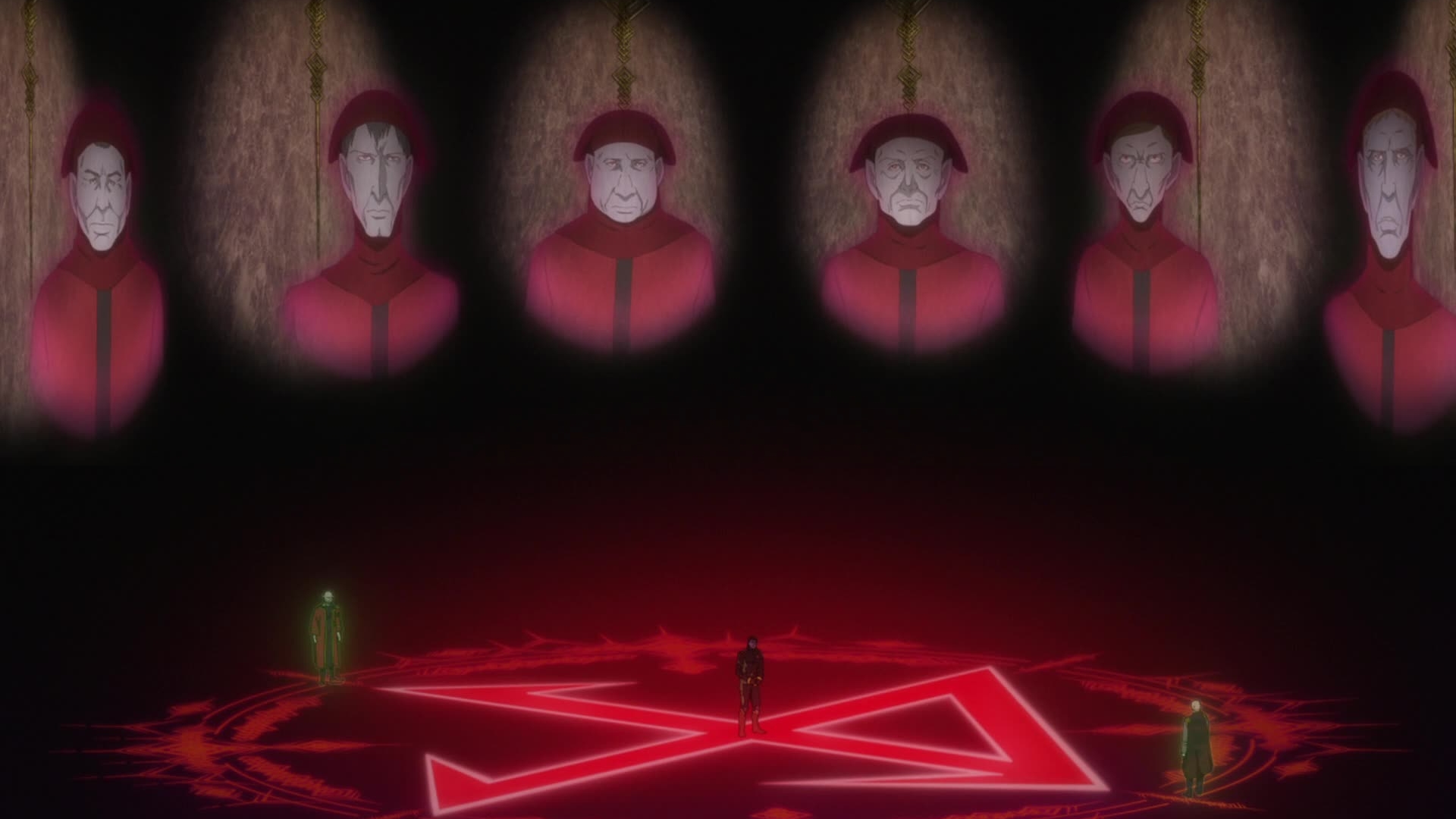
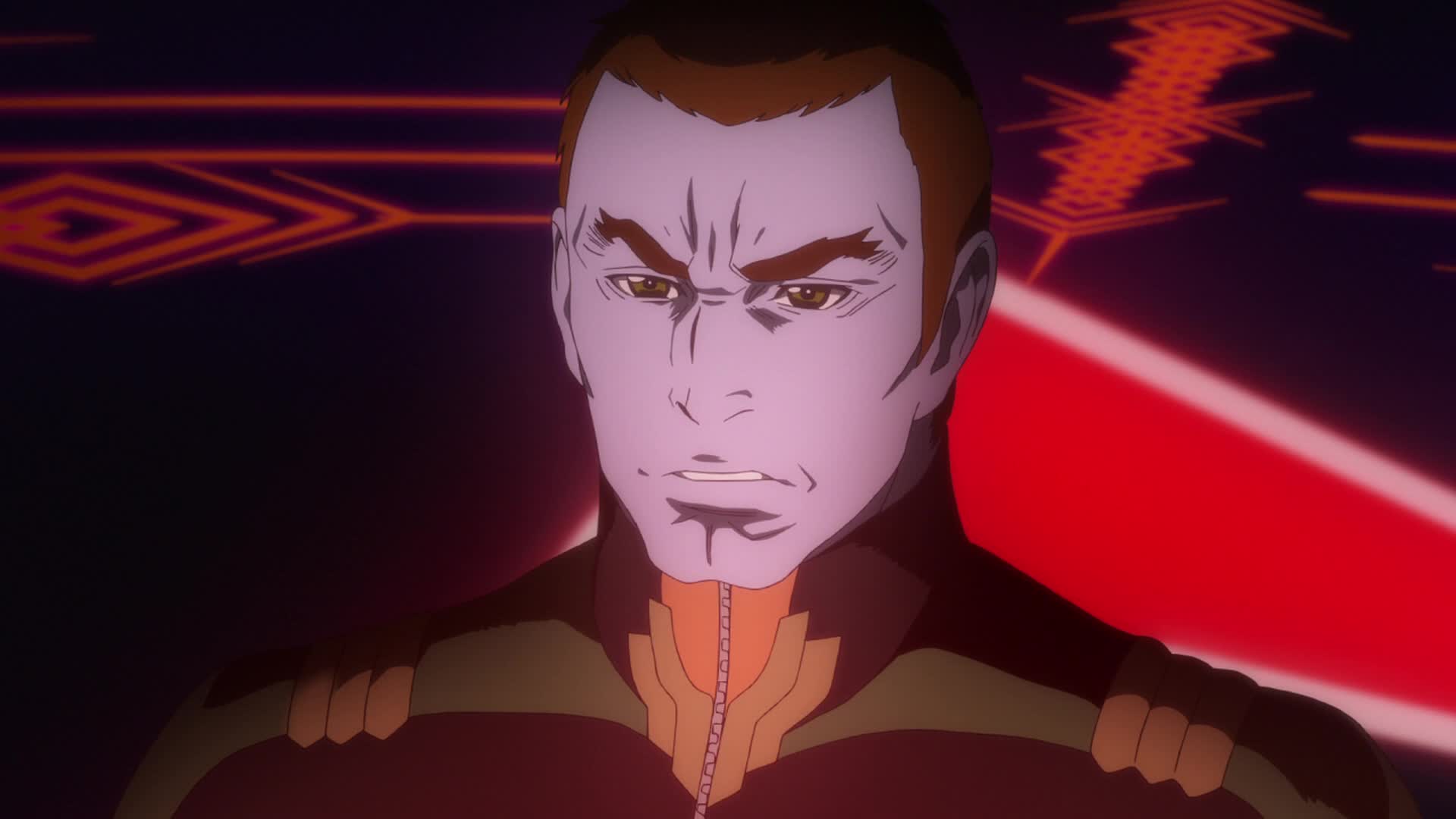
Hyss calls upon the panel of judges. One by one, the judges cast their votes. The verdict is unanimous; the tribunal sentences Domel to death. Domel stands in silence, filled with rage.
[DG]: At first glance, Hyss seems too eager to convict Domel on little more than hearsay and circumstantial evidence. You’d think someone with a background in business would be more interested in ensuring facts were raised, especially since Domel is a national hero. Surely there can’t be something else afoot here?
[LC]: The six judges are unnamed in the production materials. Also of note, for such an important office, the robes they and Hyss wear are incredibly plain. I’d expect the magistrates of Garmillas to be adorned in lace and gold. Quite interesting that they went the exact opposite. Click here to see the production design.
[DG]: Probably to keep it in line with the Volksgerichtshof analogy.
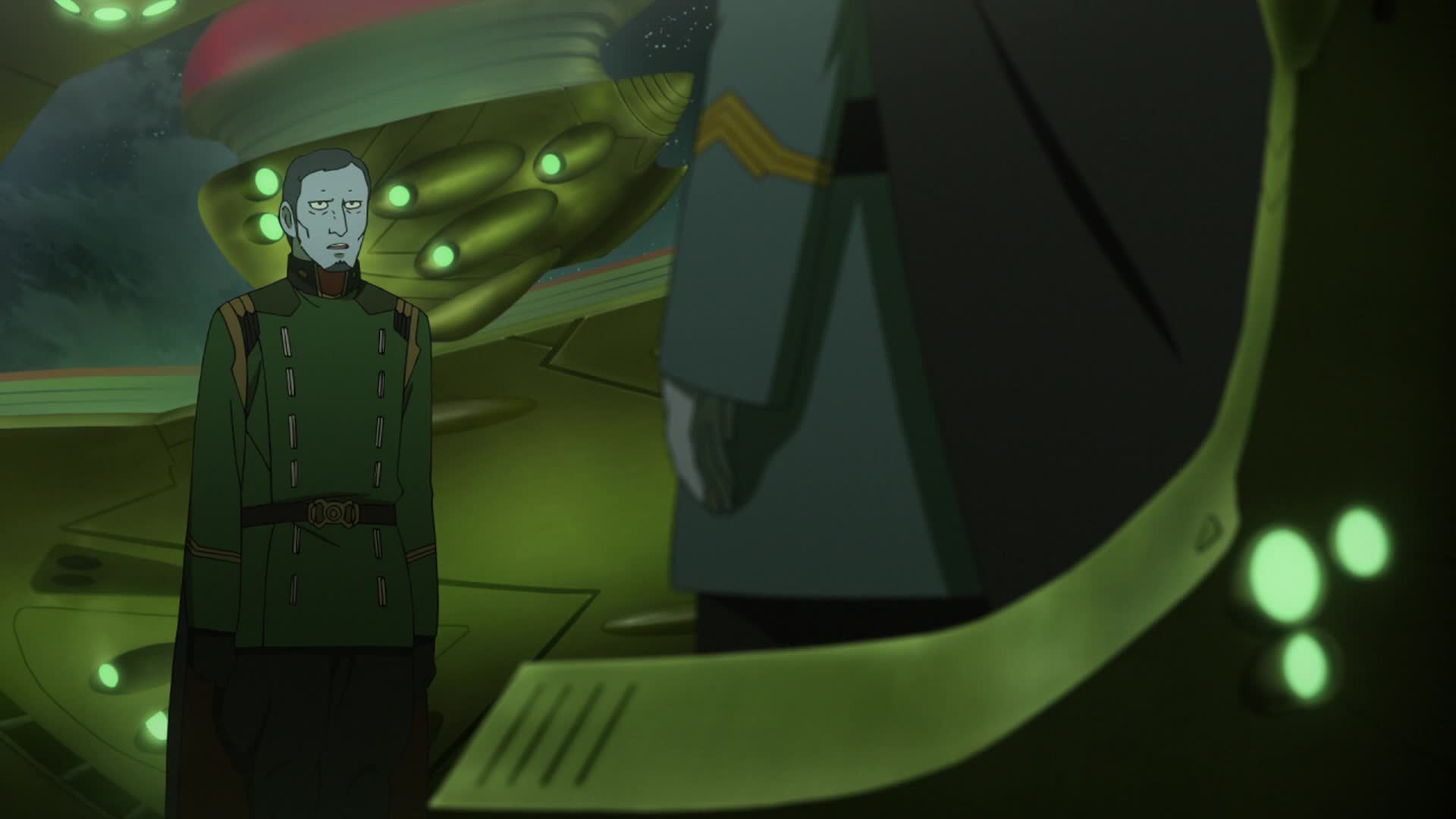
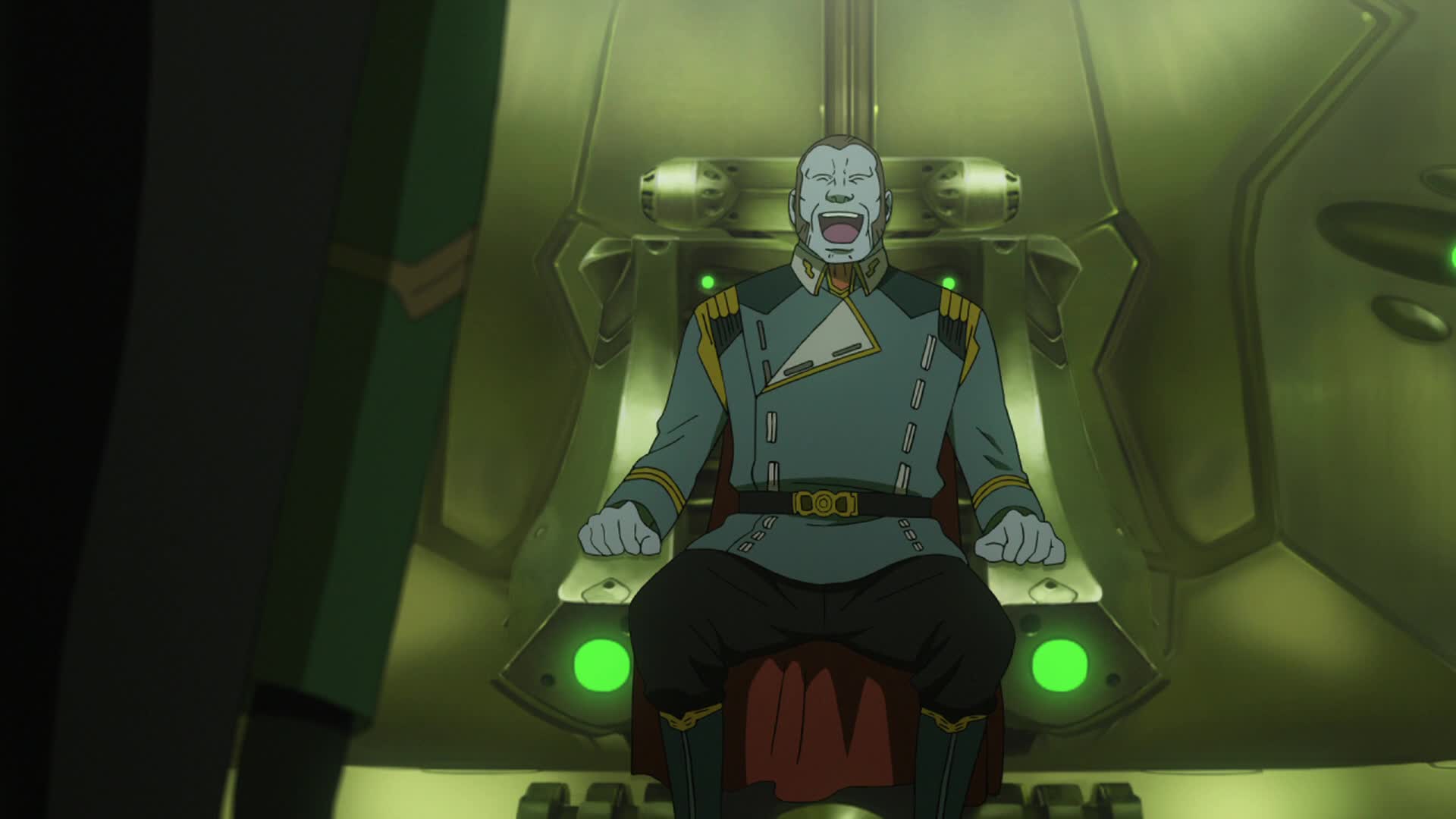
An overjoyed Zoellick arrives at the bridge of the Zoellugut II, where Bash Vandevel awaits. He reports the ship is ready to depart for the naval review and asks about Zoellick’s visible happiness. The Inspector-General tells him Domel has been sentenced to death and Vandevel congratulates him.
[DG]: This scene was not in the original draft of the screenplay. Instead, Zoellick is seen toward the end of the episode talking with Gimleh.
[LC]: Here we meet the captain of the Zoellugut II, Bash Vandevel. In the original saga, he appeared in episodes 11 and 12 of Yamato 2. In Star Blazers he was named General Garotte. He’s the one that came up with the idea of using star flies to disable Yamato on its journey to Telezart. After his plan failed miserably, he was executed by Dessler. He’ll be seen again (still aboard the Zoellugut II) in the prologue of Ark of the Stars. But not for long.
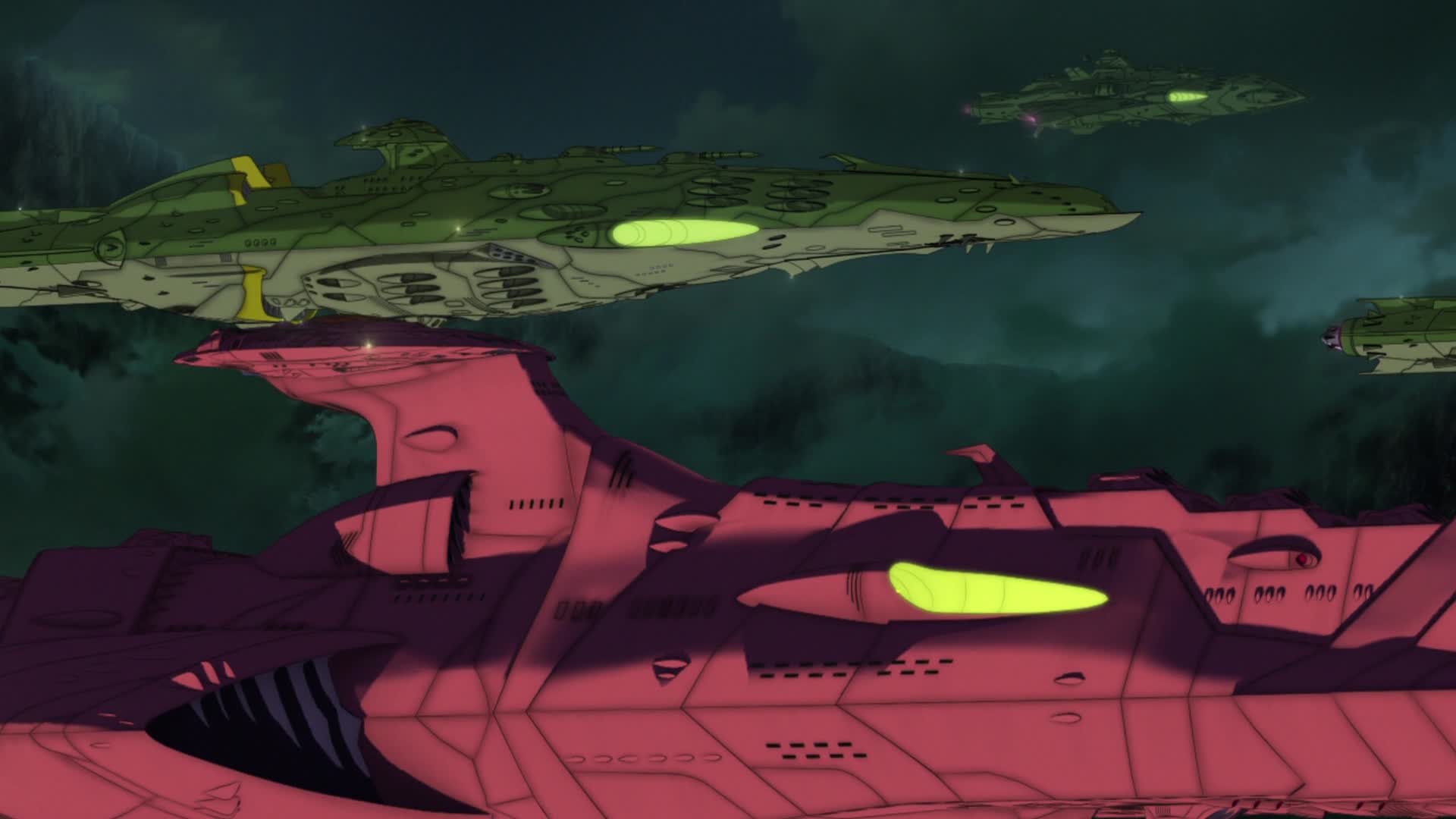
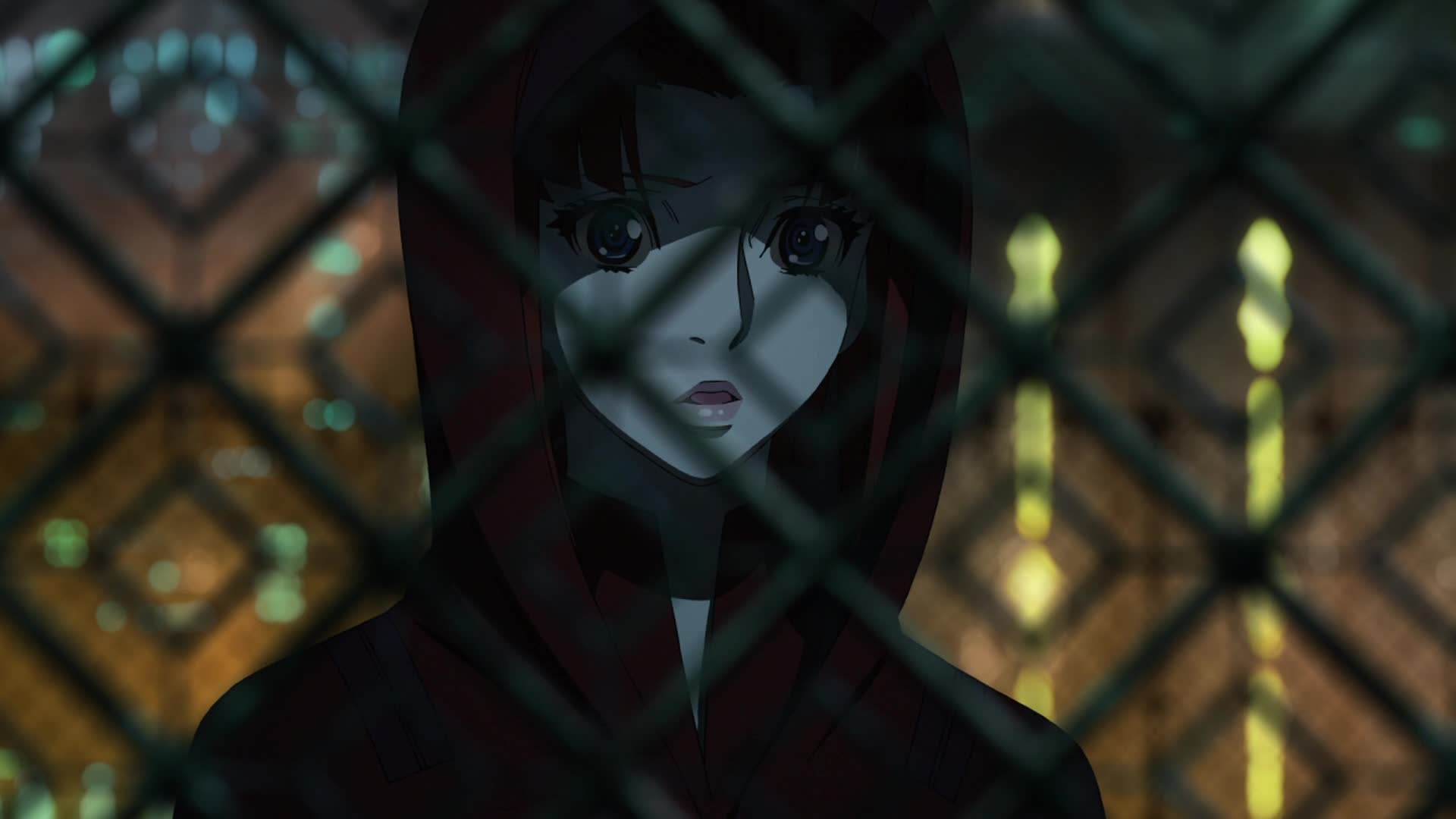
Zoellick laughs and orders the fleet to set course for Balun. The massive Zoellugut II accelerates, surrounded by its escorts. At a nearby astro-port, as a massive transport ship takes off, a hooded figure stands by the fence. It’s Melda Dietz.
[LC]: This is the first on-screen appearance of the third and final Zoellugut-class super-dreadnought in the Garmillas fleet, the red-colored Zoellugut II, assigned to Zoellick. Much like the Deusler I or the Domelaze III, its name is an obvious reference to its master. If you’re wondering why this class is named after Zoellick instead of Dessler, that’s due to Zoellick’s part in the development and construction of the super-dreadnoughts. For more detailed information, check out this article from the September 2014 issue of Dengeki Hobby.
Also, if memory serves me, these are the first standard-colored Haizerad-class battleships we see in the series, the others being Celestella’s and Gimleh’s custom-colored ships.
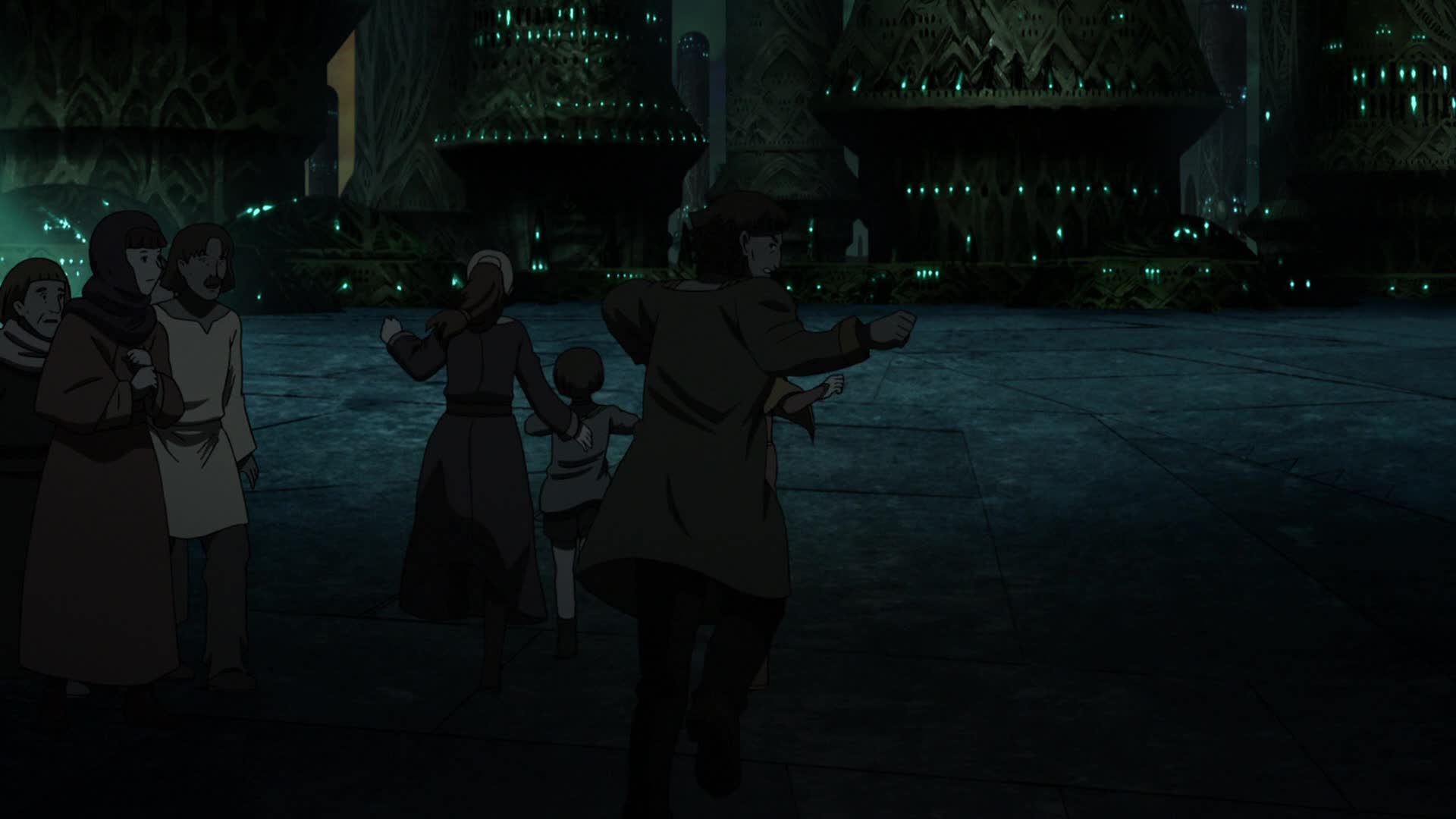
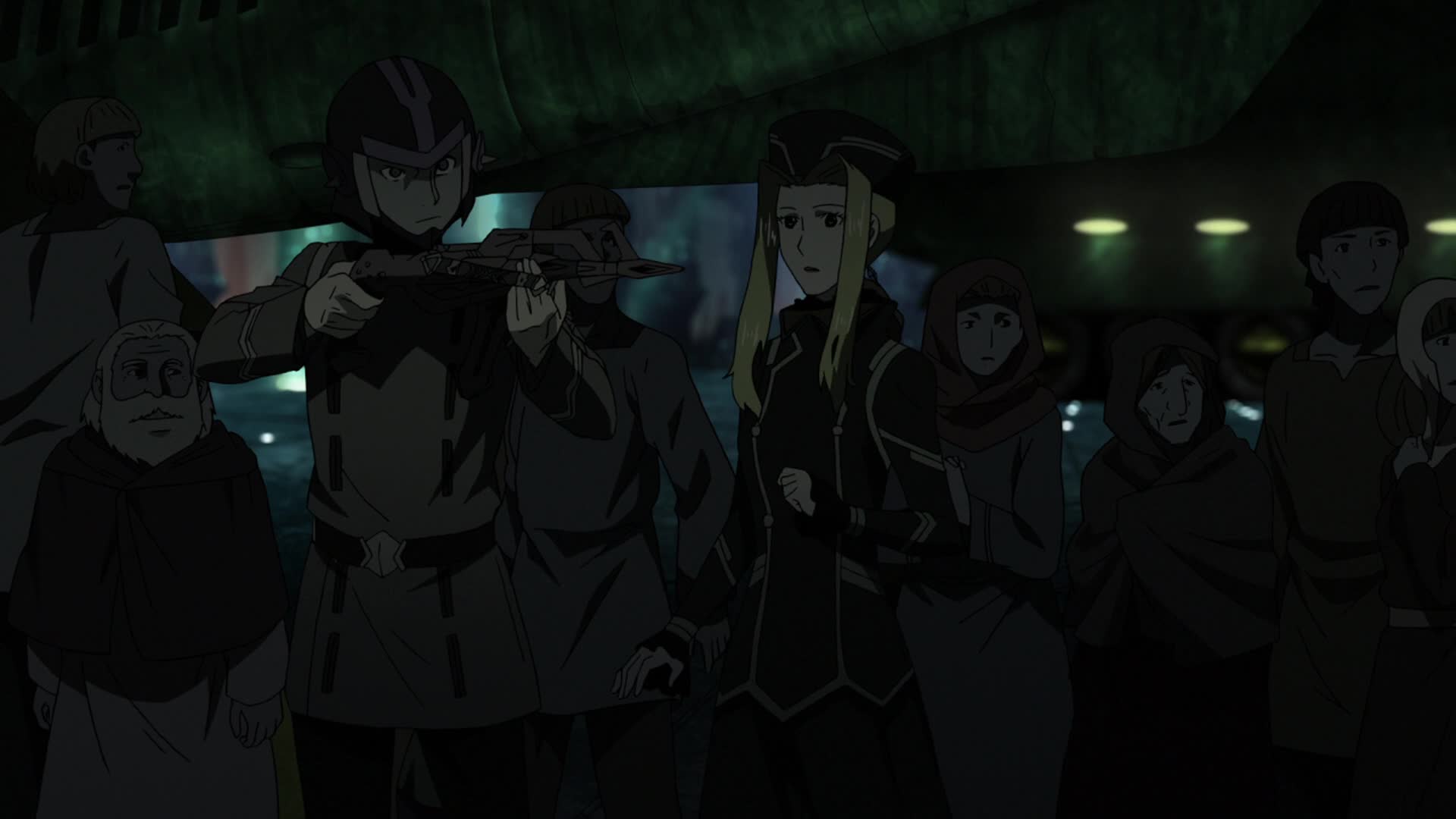
She watches as the imperial guard shepherds groups of prisoners into massive transports. There is a sudden commotion as a family of three attempts to escape, with a guard promptly training his gun at them.
[DG]: Here we see another parallel to Nazi Germany; people being hauled off to prison camps (or in this case prison planets) for as little as being associated or related to traitors. After the July 20 Plot’s failure, the Third Reich implemented sippenhaft, a policy whereby relatives of traitors were similarly arrested, imprisoned, or in some cases, executed. A prime example of this was the wife and brother of Claus von Stauffenberg, who planted the bomb in Hitler’s conference room. They were arrested and sent to concentration camps despite having no involvement in the plot.
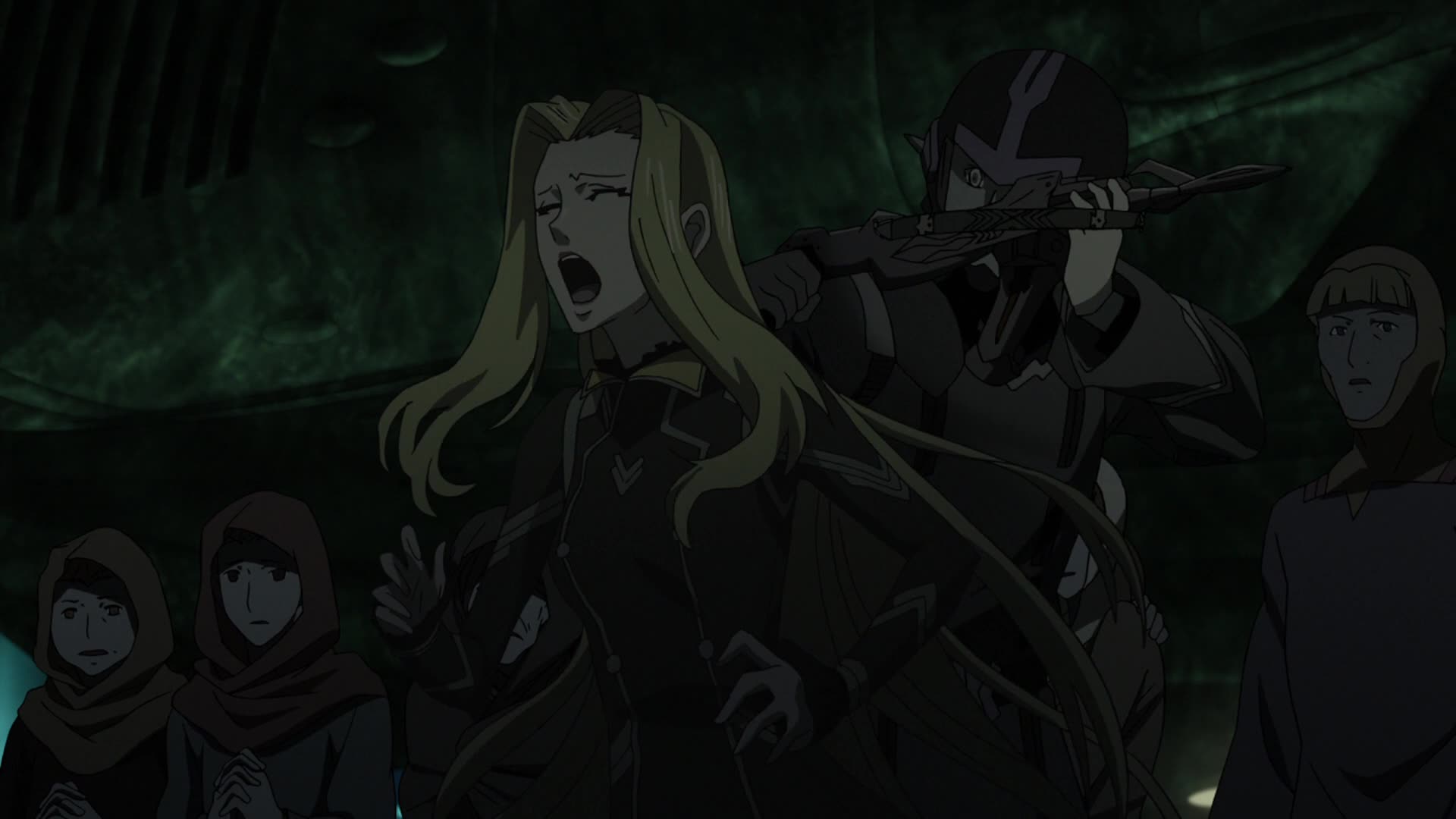
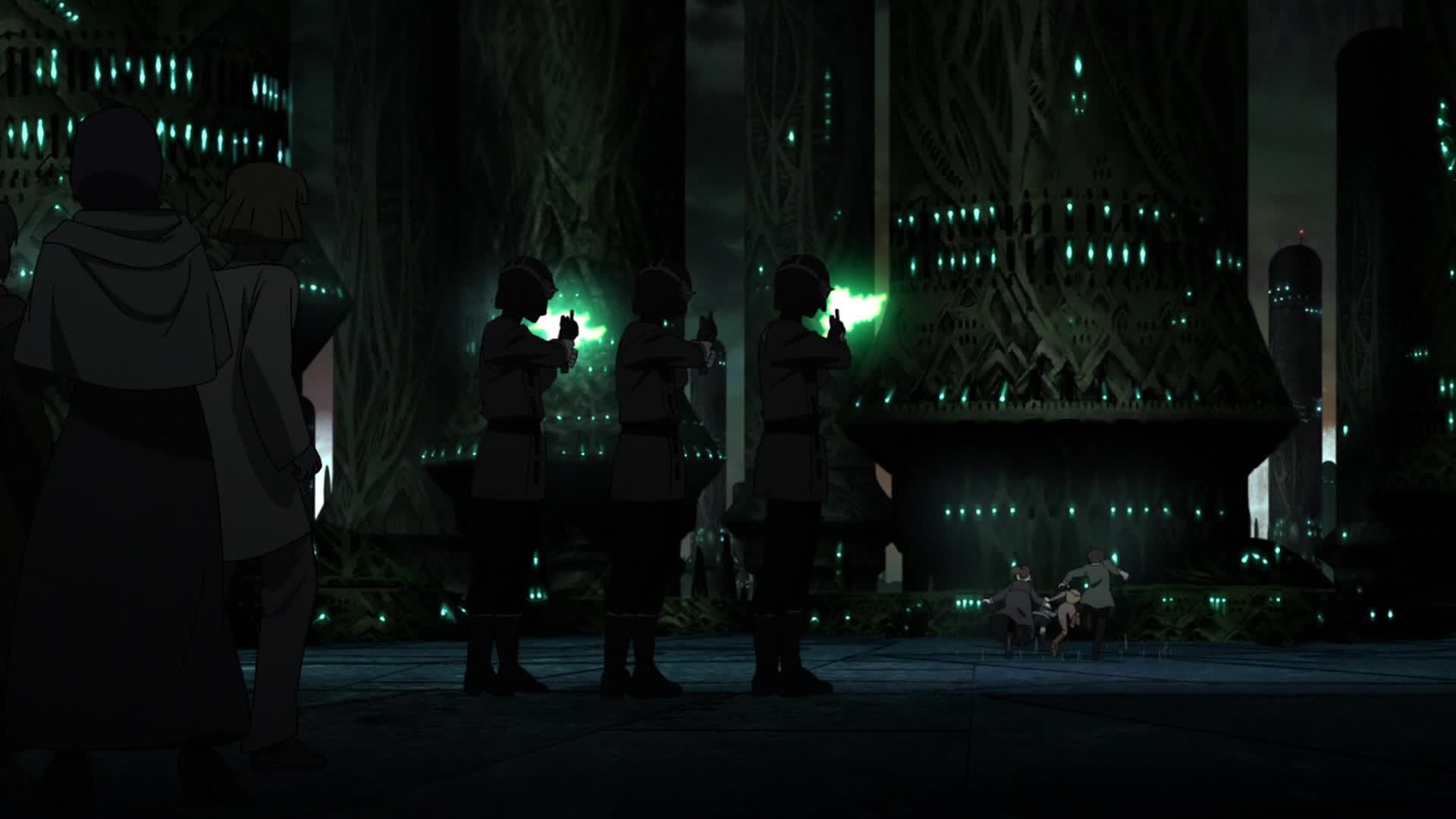
Elisa Domel pushes the guard, trying to prevent him from firing, receiving a crack on the head for her troubles. To everyone’s horror, the runaway family is gunned down without mercy.
[DG]: In the original screenplay for the episode, a scene with Elisa and Melda took place right after the opening trial scene, including an exchange in which Melda addressed Elisa as “Elisa obaa-san,” suggesting there was a close relationship between their two families, beyond what the friendship of Eruc and Gul implied.
[LC]: In the manga, this particular scene – minus Elisa – takes place between Frakken’s attack and Domel’s ambush at Carel 163. At the end of chapter 36, a much more provocatively clad Melda watches the slaughter, accompanied by a completely new character, who she adresses as “爺.” Though the immediate translation of that kanji leads to the word “grandfather,” in this instance it means simply “old man.” So… no, that’s not the admiral’s father. He’s most likely a trusted servant, the Dietz’s very own “Alfred.”
Melda grabs the fence in disbelief as Elisa is pushed back into line by the guards. The astroport’s PA system issues a stern warning that any attempts to escape will result in summary execution. Too late for the unfortunate family.
[LC]: This large ship is simply called Passenger Ship in production materials. This suggests they were used as passenger liners before being used for prisoner transport. The ship is an original design by Makoto Kobayashi. Size comparison charts put its length at 268 meters, making it roughly 185 meters wide. Click the image above right to see some production designs.
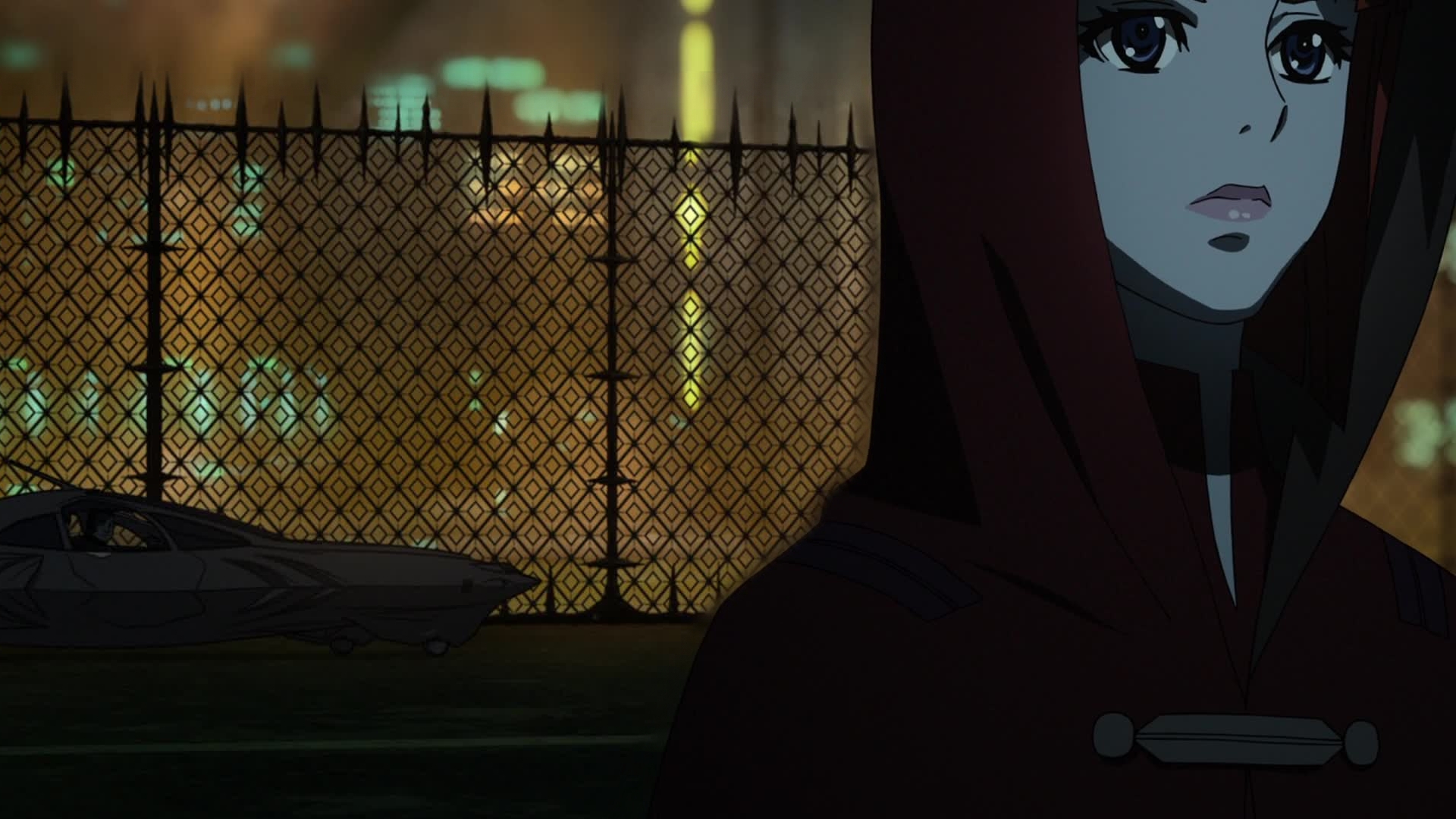
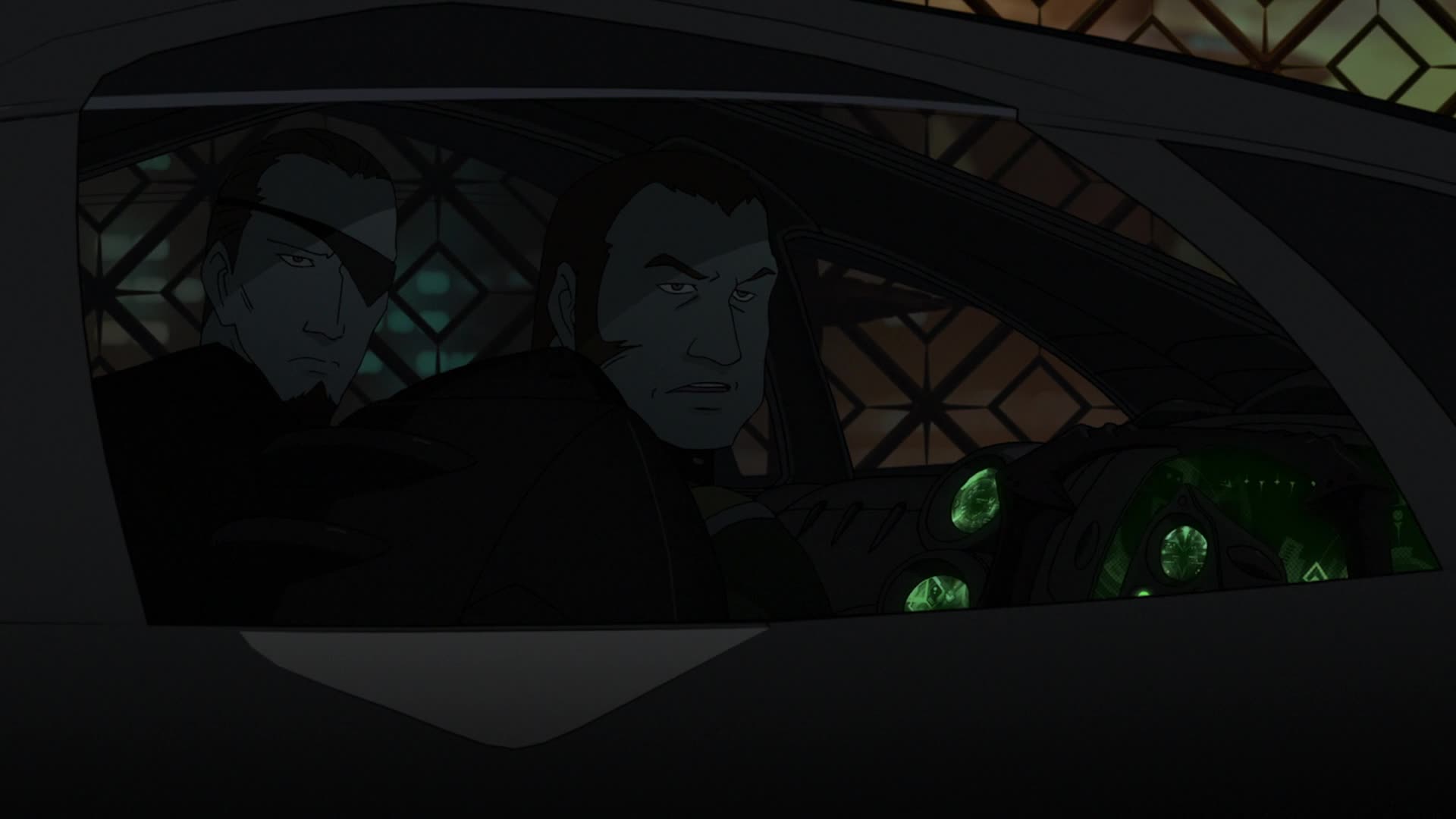
Melda watches as the massive transport takes to the skies. Inside a nearby parked car, two men watch the scene. One of them asks if that’s “the one,” with the second one confirming.
[LC]: These two fine gentlemen are Lance Larkin (the one with the eyepatch) and Orto Dolmen. We will see more of them in the following episodes. Click here for their character designs.
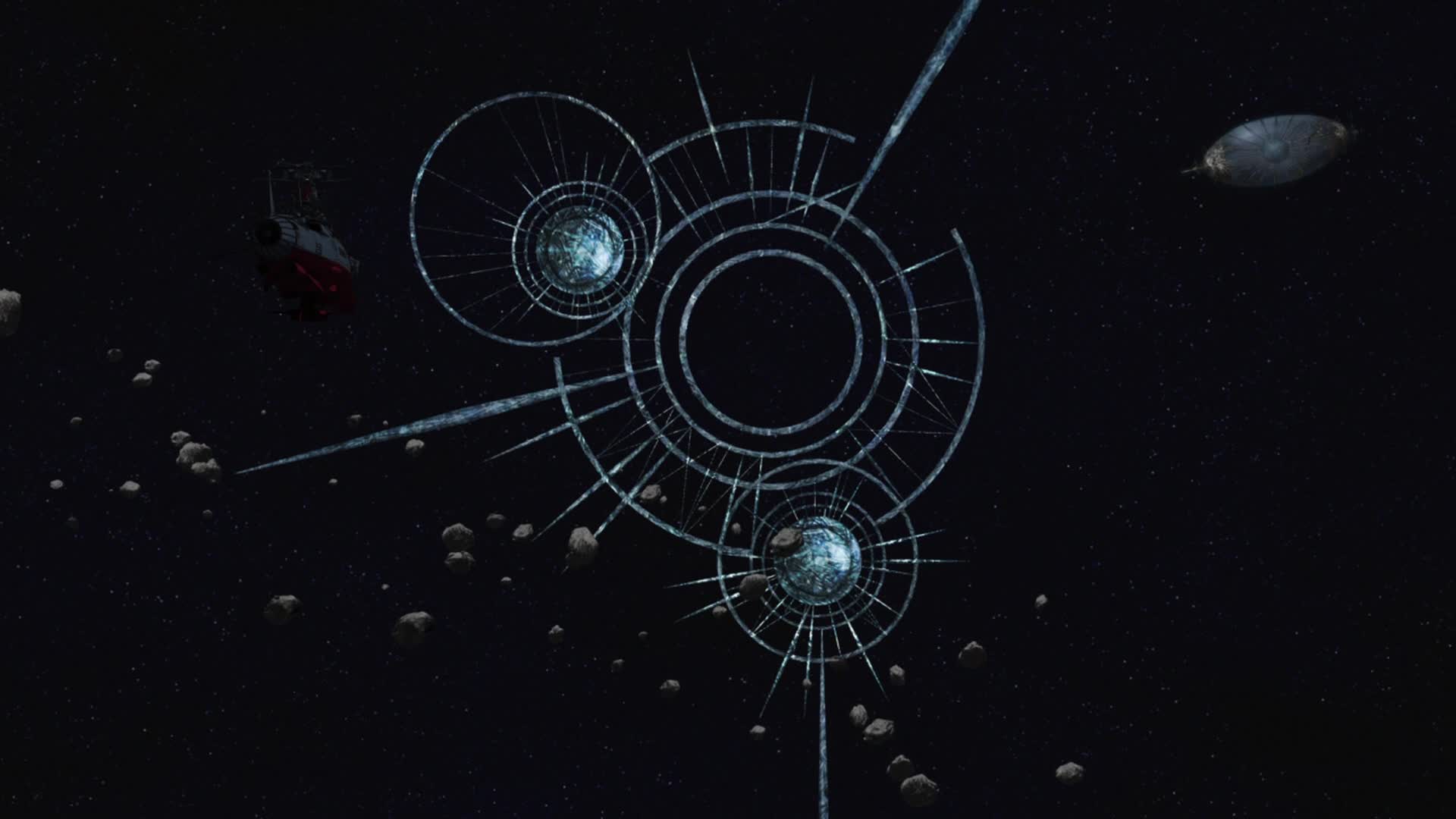

Yamato has reached the Beemela system subspace gate. Shima, Kitano and Nanbu look at the gate, commenting that it doesn’t look operational. Kitano wonders if it can really propel the ship thousands of light years at once. In the second bridge’s observation deck, as if she had heard the officer’s question, Yuri(sh)a says “yes.”
[LC]: These recurring scenes of Yuri(sh)a answering someone from elsewhere on the ship… wonder if she’s actually psychic or if her spirit is still connected to the ship’s mainframe and listening in on everybody. I don’t know which of those options is creepier.
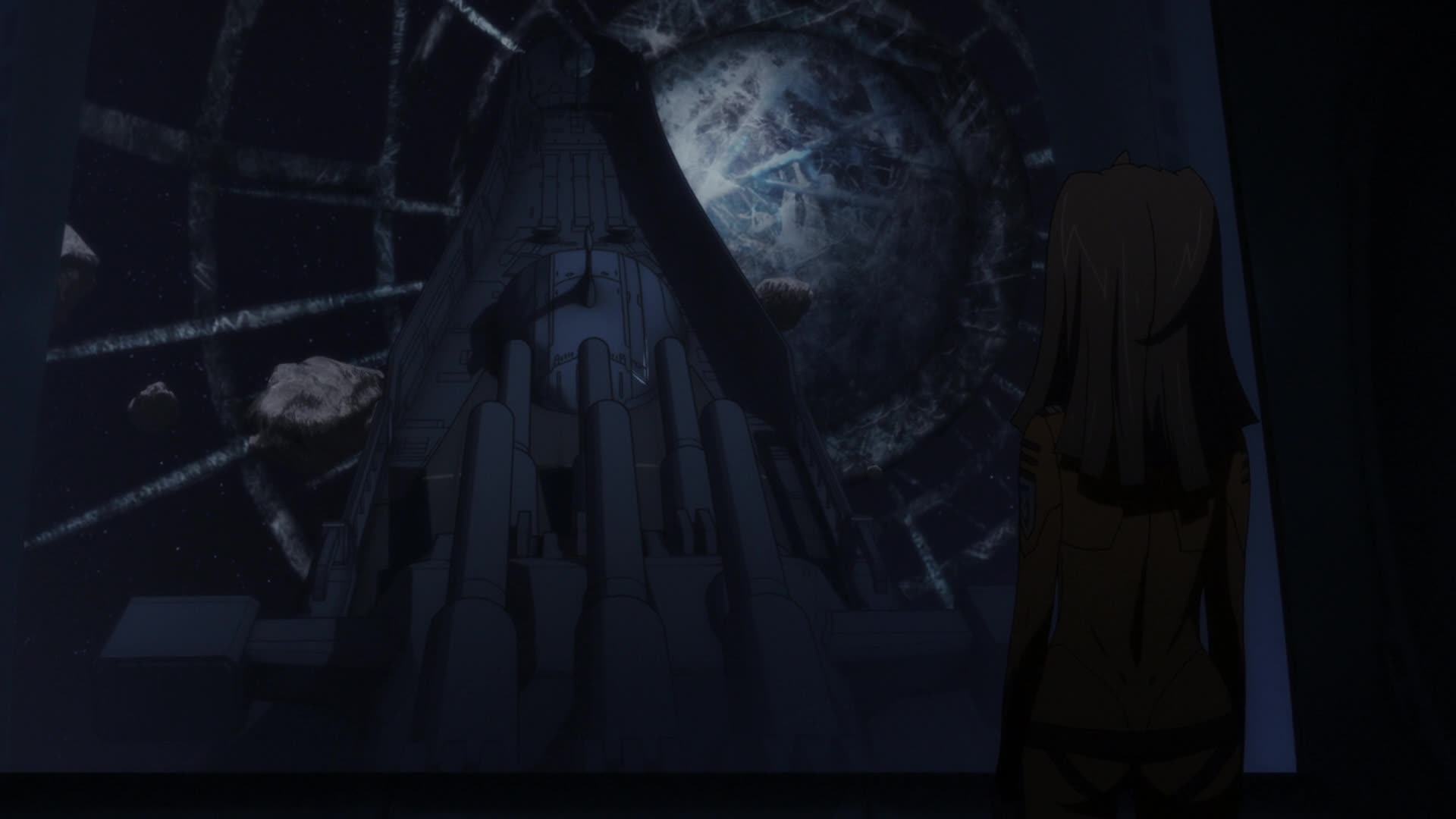
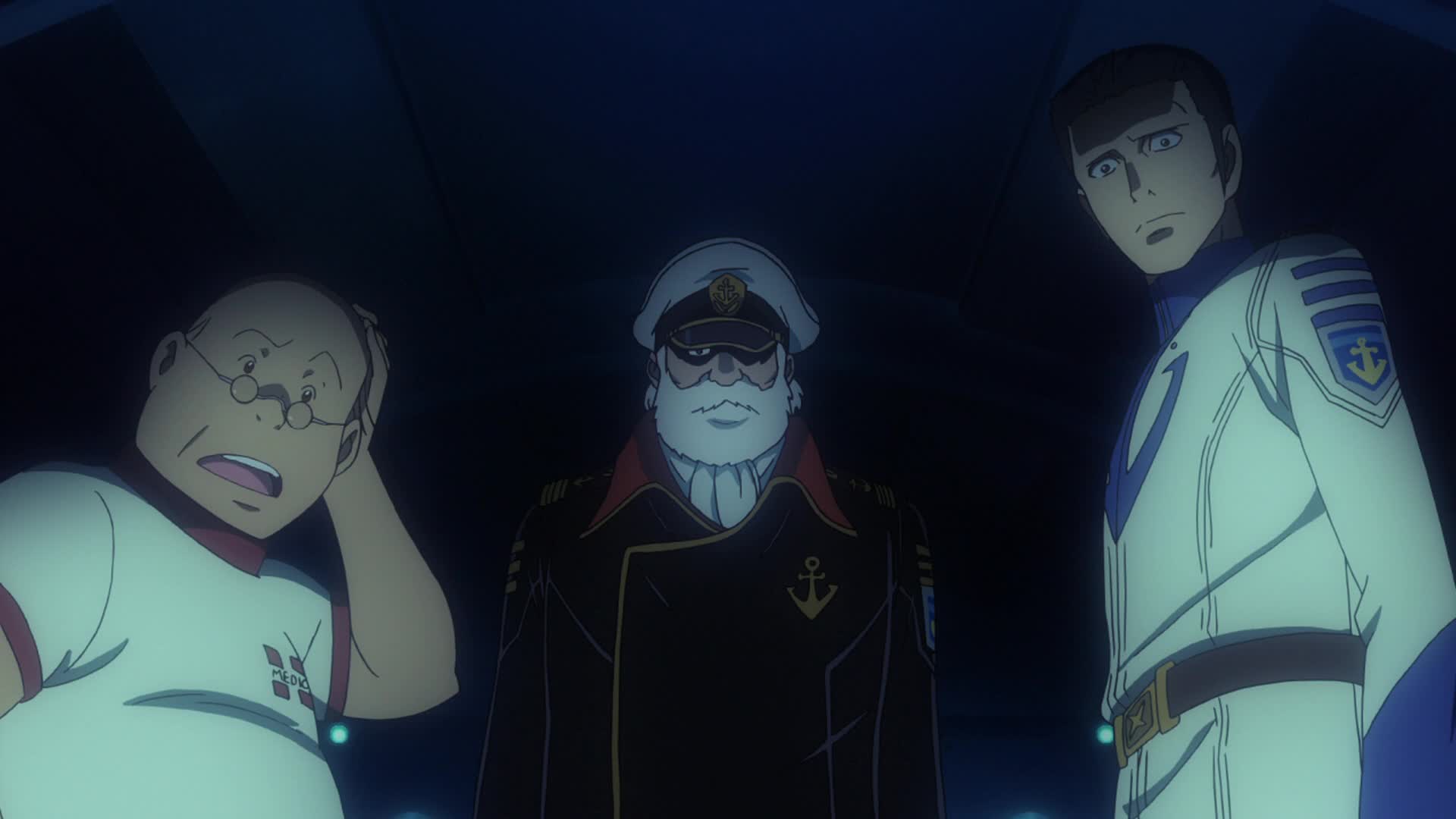
She then turns her attention to the large dome on Yamato’s forward deck where the automatic navigation room resides. Okita, Sanada and Sado are inside, with Sado still reeling from what the other two have just told him. He says that he can’t do anything about it. Sanada says that soon, ship’s functions will begin to be affected.
[LC]: This scene seems to confirm that Okita and Sanada are most likely the only ones who know what is actually going on inside this room. And judging from Sado’s reaction, that might have been a mistake. Sure, the ethical and moral implications can be discussed at length. But most of all, if the crew had known the truth all along they might have accepted it, especially in light of the explanation Sanada gives later in this episode. Also, a lot of screen time wouldn’t have been wasted with this Yuki/Yurisha BS.
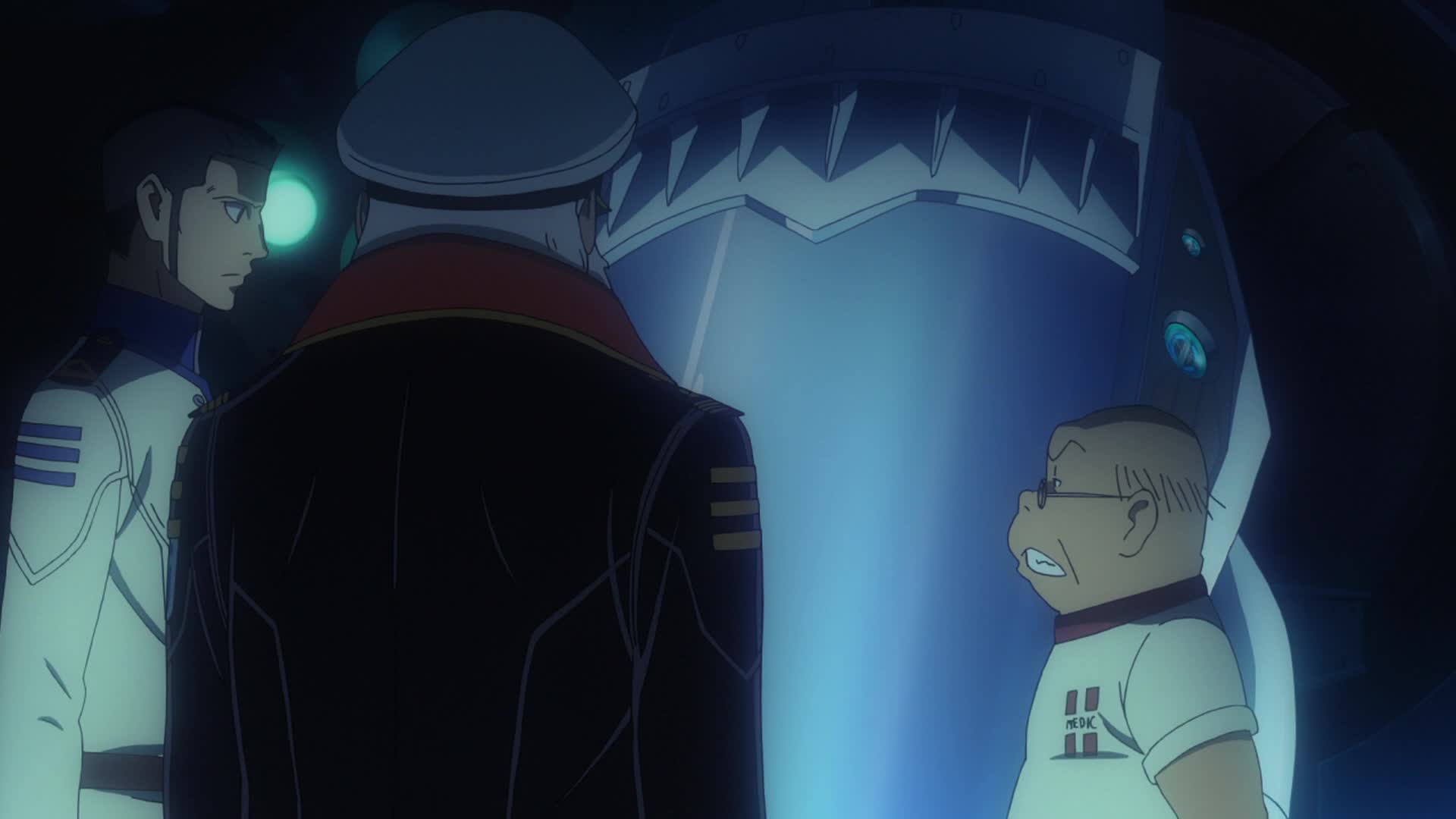
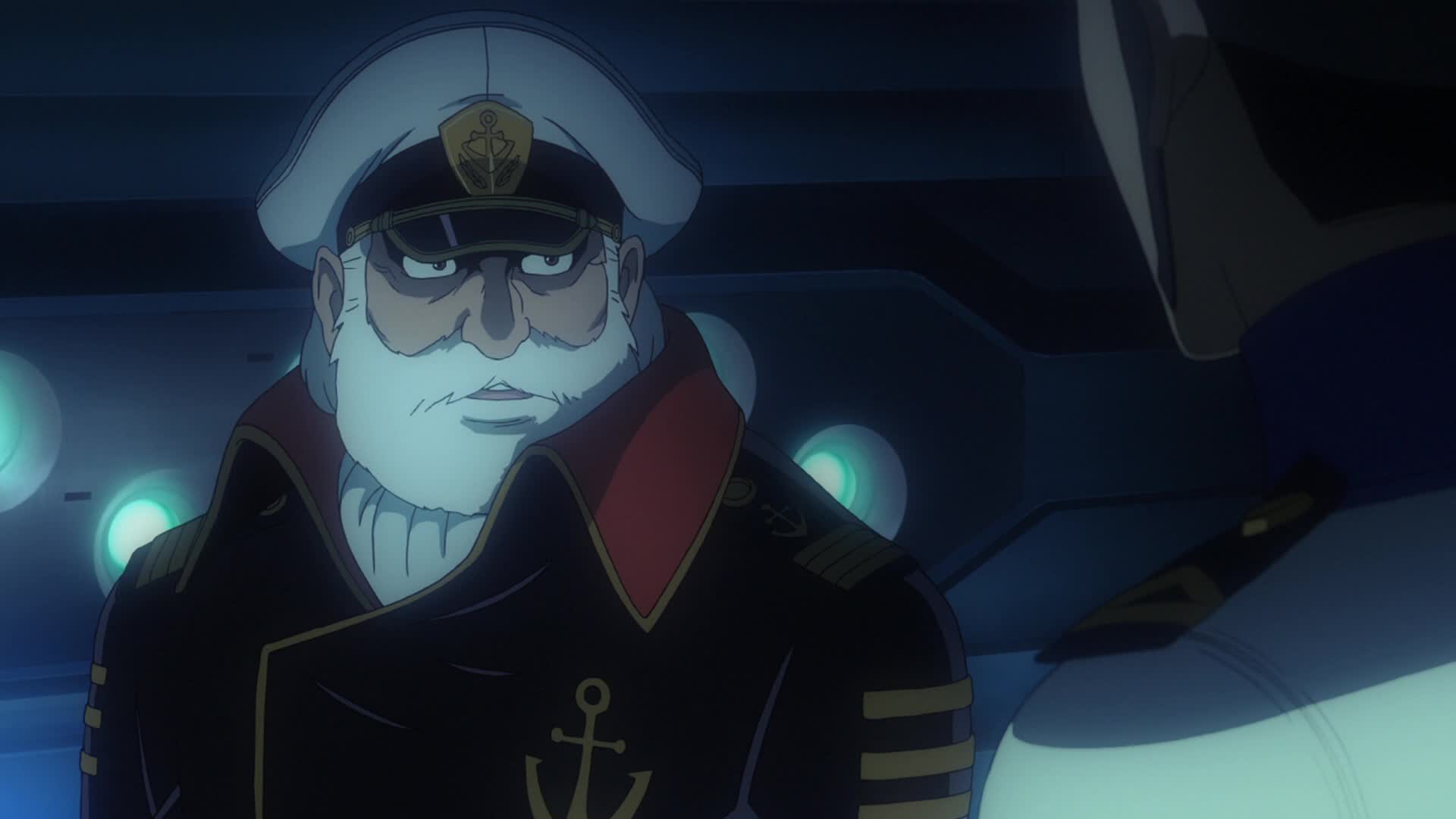
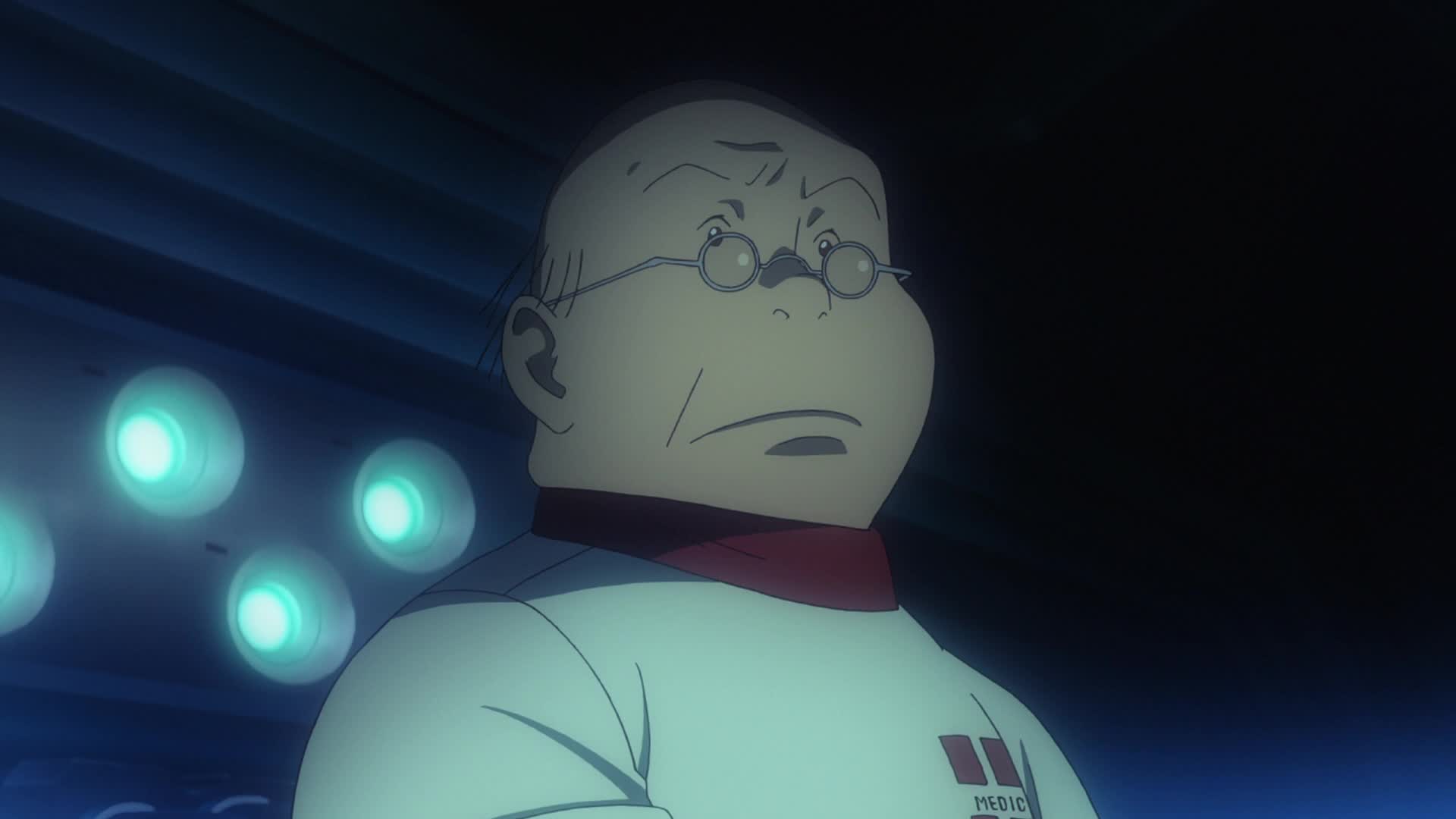
Sado asks if ship maintenance is a doctor’s duty, which Sanada recognizes is not. Sado asks Okita to explain why that was done and how unlike him it is, and why he didn’t tell anyone about it. Okita remains silent and pensive. Sanada says those were the orders from Central Command. Sado cuts him off, saying that’s not what he asked. Okita recites his old creed about needing “the courage to disobey an order you believe is wrong.” He remembers the time he told that to Kodai. The other two men look at him in silence. Okita recognizes they should have been honest and says he will assume full responsibility for the disclosure of this secret. Sado looks with apprehension at the misty capsule next to him.
[LC]: Funny that for all the times Okita recites that line, he keeps doing what he’s told. The only time he didn’t was in 2191 when he actually refused the order to fire on the Garmillas. In this particular situation, I can understand why he went along with it. They have this one chance to save Earth and they’re out of cards to play. And if the only way to reach Iscandar is to hook up a comatose girl to the ship’s navigation system, he’ll do it, even if he doesn’t really like it.
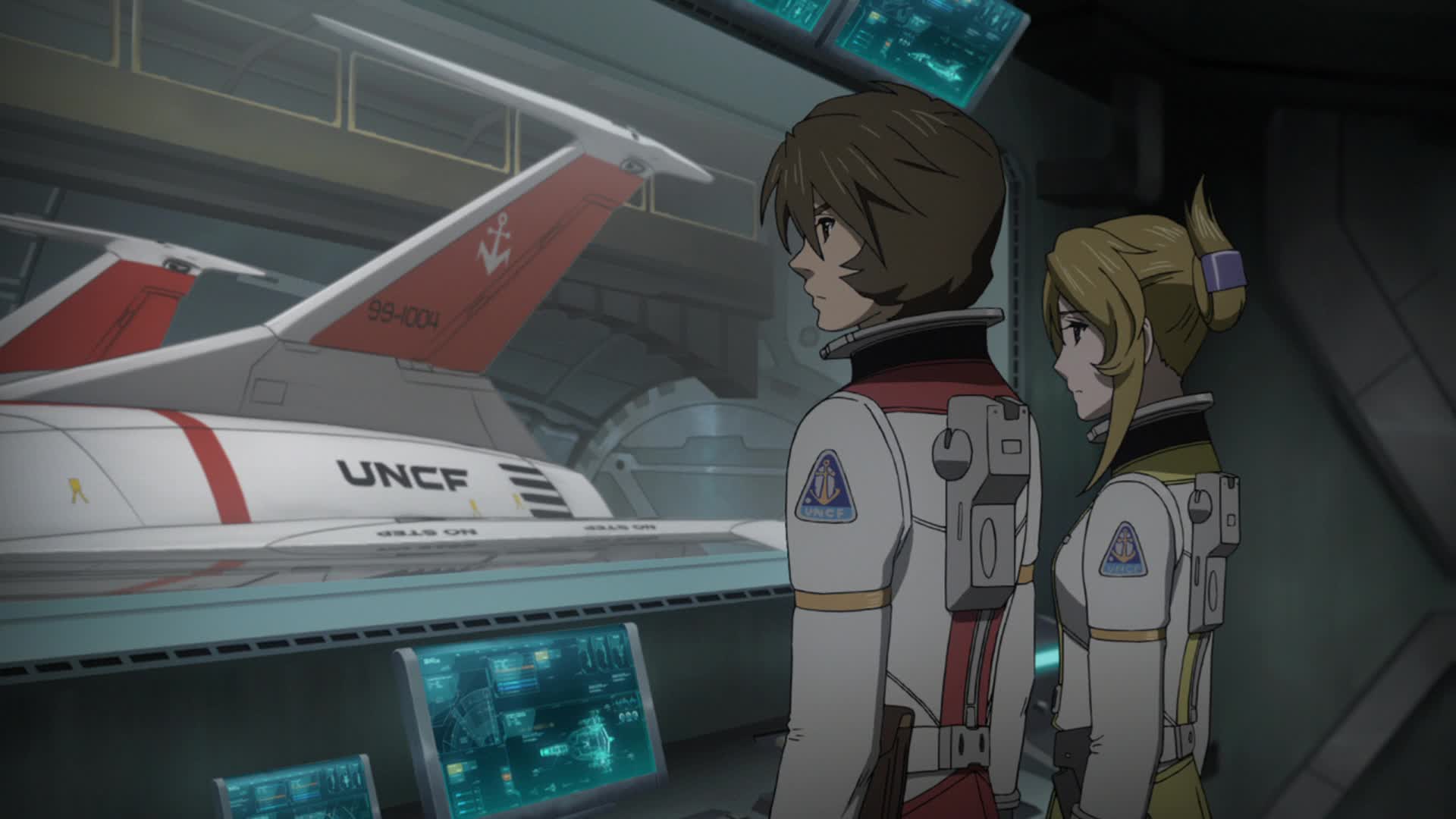
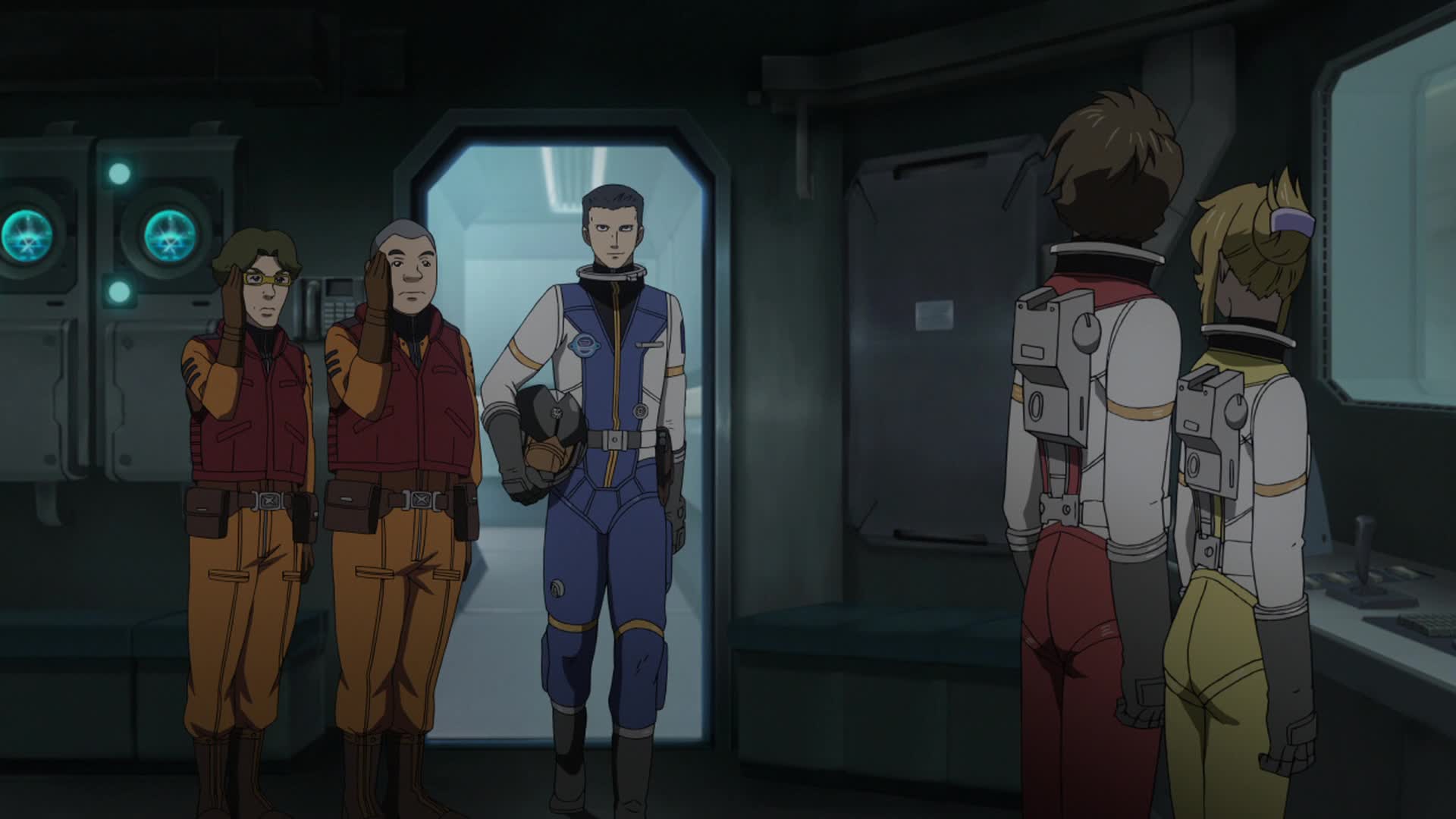
In the starboard dome of hangar 3, Kodai and Yuki watch as a Type-100 is railed in. The door opens as Toyama and Iwata approach the control room. Not noticing the two officers inside, Toyama says he’s disappointed that Yuki is an alien. He stops talking when he sees the officers and salutes them. Iwata isn’t as lucky and carries on, saying he was a huge fan of Yuki. He is stumped when he sees Kodai and Yuki and joins his colleague in saluting them, reporting that the Type-100 is ready to go. Kodai thanks them. He looks at Yuki, who returns the look but remains pensive. Iwata and Toyama (still saluting), step aside as Sanada comes in, stating he is ready.
[LC]: I can’t help but laugh at how awkward those two feel that they stand there, motionless, saluting the two. And the side step when Sanada comes in… priceless.
[DG]: We now have proof that the utility craft hangar we’ve seen on the port side is replicated on the starboard side, as hinted at in the cover art of the Earth and Garmillas design sheet books.
Number 004 was the Type 100 that Yuki used to contact Kodai from the port side hangar on Beemela. So either the hangars are connected from the underside of the hull, or the 004 craft has (between the end of last episode and this point) been flown and returned to the starboard hangar.
While all official materials (including model kits) list the complement of Type 100s and Seagulls as two apiece, some sketches show how each side hangar could stow two Type 100s. This, along with the numbers 003 and 004 on the craft seen in flight, made me think the ship carried two on each side. After further investigation, it would appear that the Type 100s and Seagulls form a composite squadron of four aircraft – two of each type. The Seagulls’ full number are seen on the tail (99-501 and 99-502), while the Type 100 in this episode we clearly see “99-1004” on the tail fin. It’s reasonable to assume that “99” represents the squadron number and the numeric prefix on the second part of the number is to distinguish it from the other type in the squadron.
The detail on this closeup of the tail section of the Type 100 is impressive. We clearly see numerous markings on the aircraft, including the “No Step” labels on the leading edge of the wing.
I am kind of curious as to how that clip is keeping Yuki’s hair up. There doesn’t seem to be another part to it that’s preventing it from falling down.
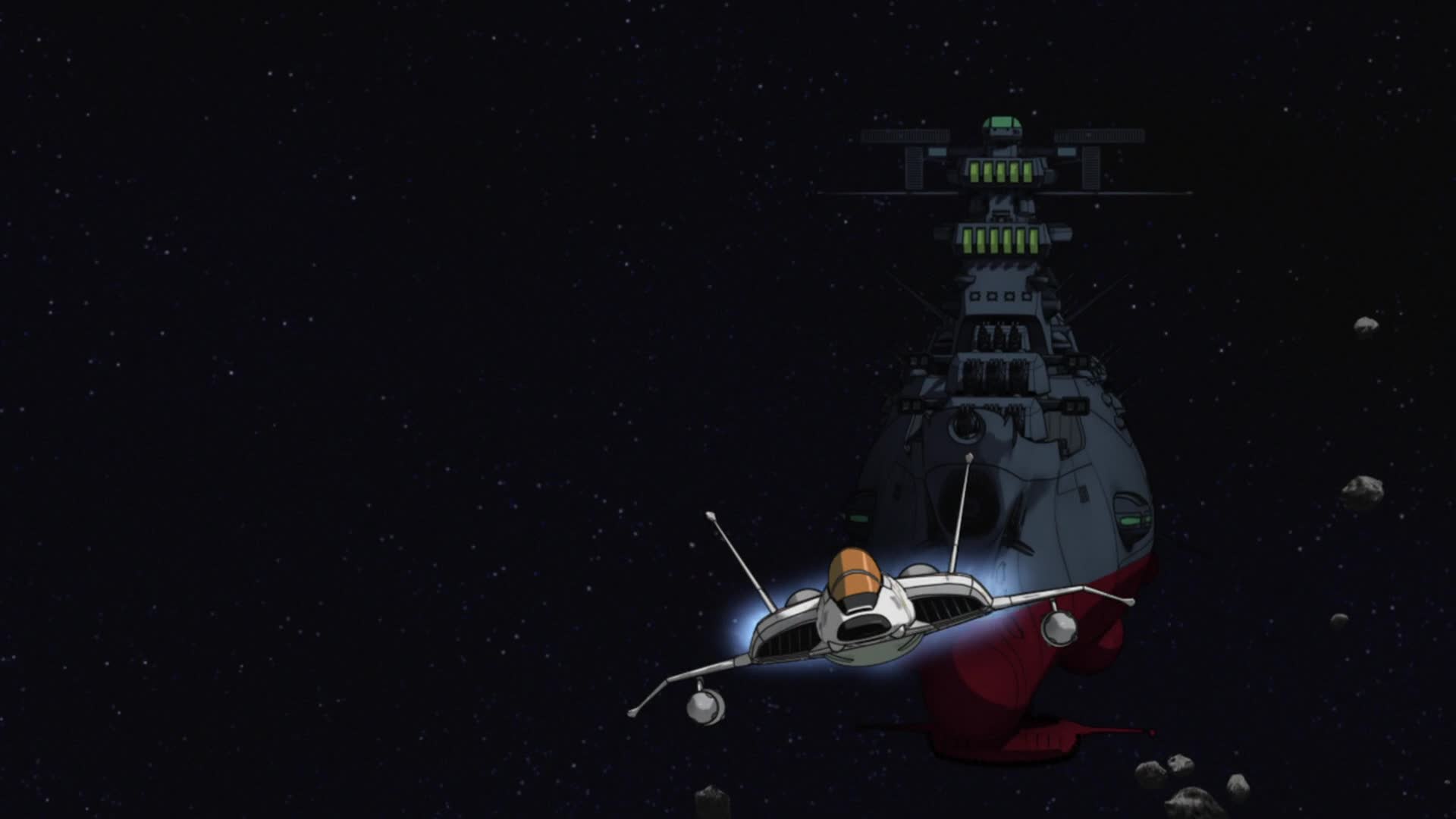
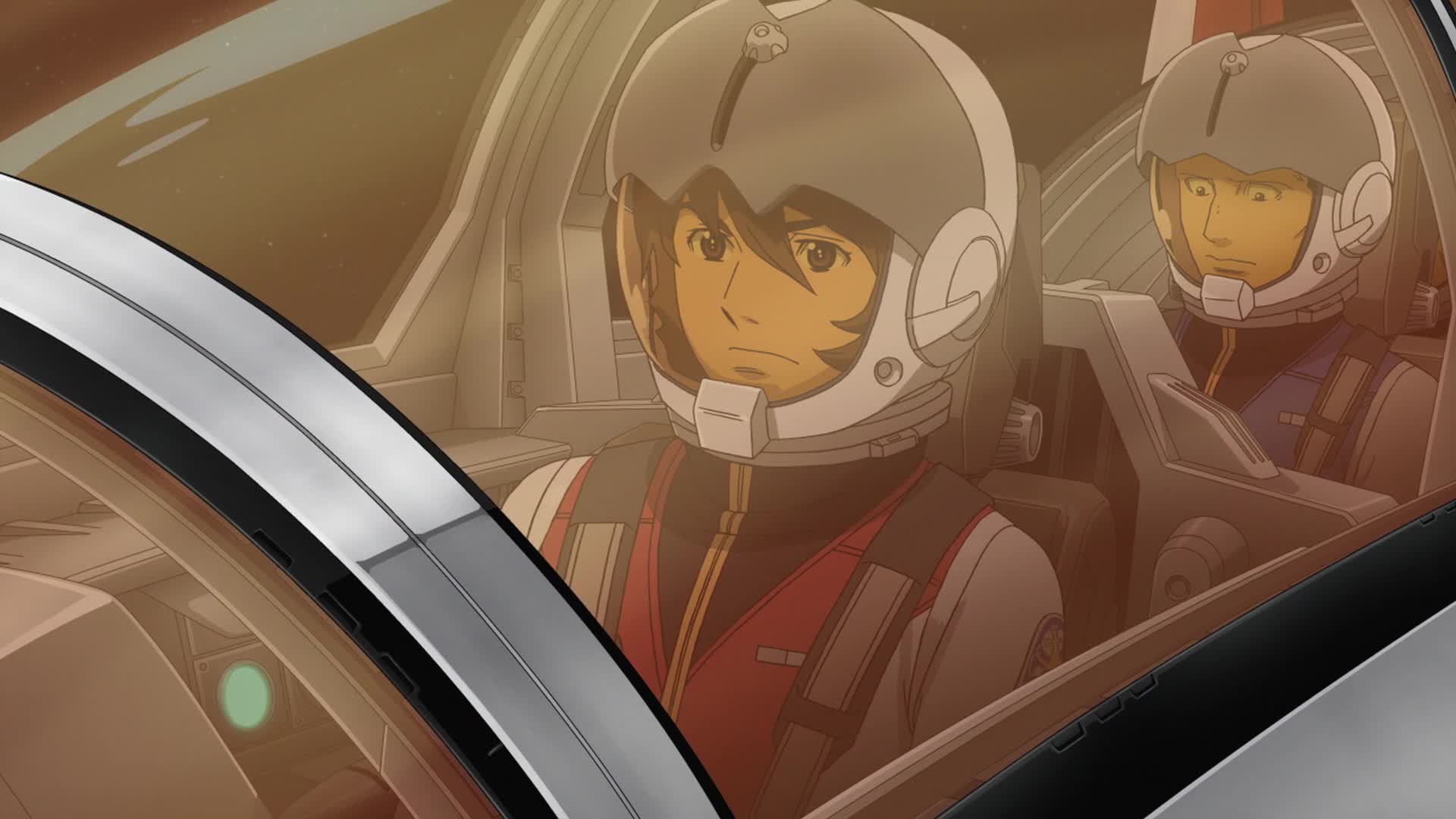
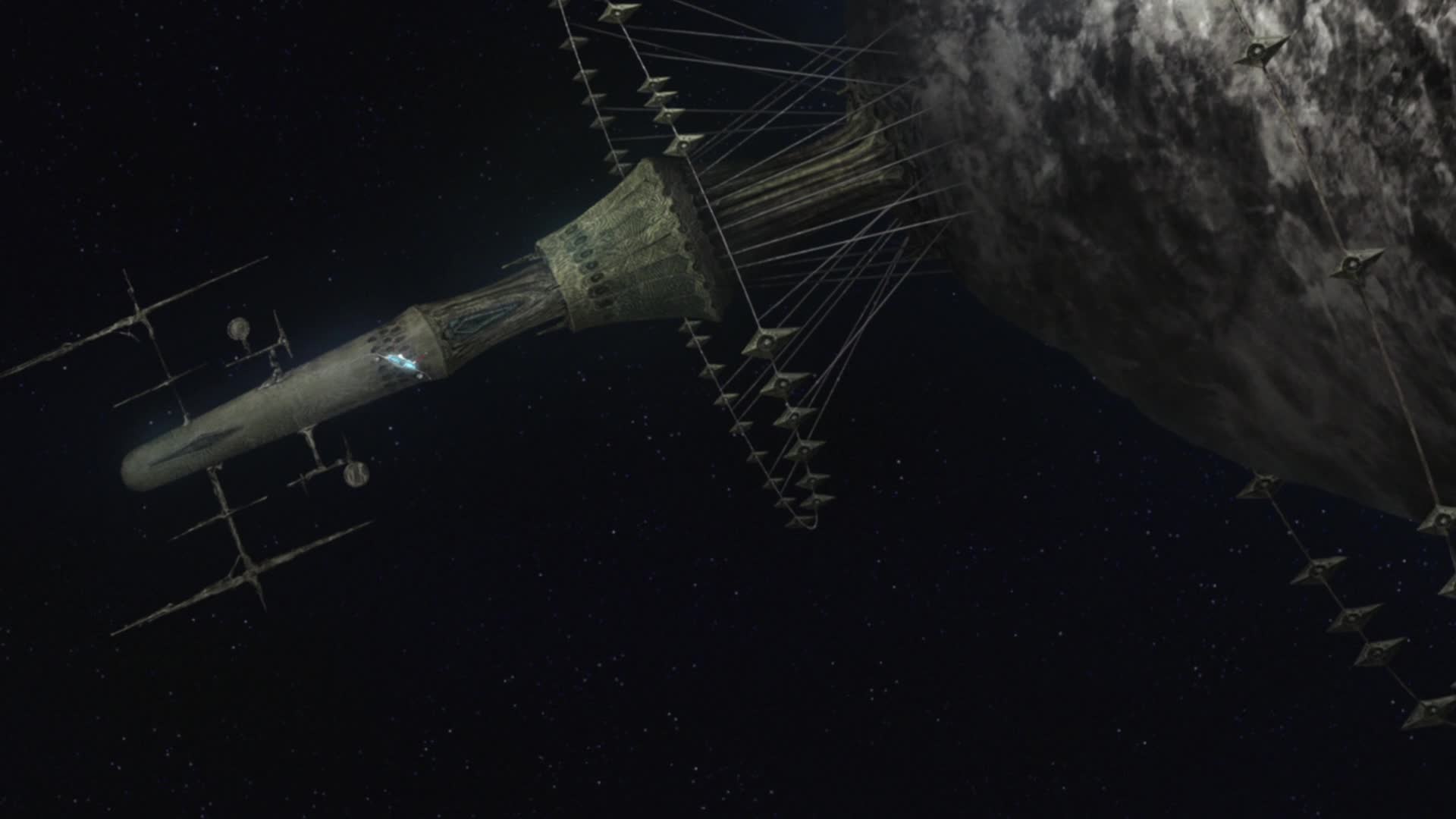
The Type-100 takes off and heads for the control satellite. Yuki sits quietly in the backseat as Kodai makes his approach to the satellite’s main tower.
[DG]: Further proof of the starboard hangar’s existence: from a camera angle afore of the bow, we see the Type 100 coming from the starboard side of the ship.
[LC]: Sanada’s incursion into the control satellite with Kodai and Yuki is based largely in Episode 18, in terms of revealing Sanada and Mamoru’s past friendship. Though the “magnetron wave fortress” was dropped in favor of the subspace gate control satellite, the overall design of the satellite and core is reminiscent of it. Click here for a comparison and the satellite and gate’s design files.
This is the first time we see the Type-100 using its full seating capacity. Yuki’s seat is usually stowed and concealed by retractable panels, much like the Cosmo Zero. Only the Cosmo Falcons seem to be single-seaters.
The satellite’s main tower, as well as the satellite itself and the subspace gates, were all designed by Makoto Kobayashi. The tower’s design is reminiscent of the one on the floating continent’s resupply base.
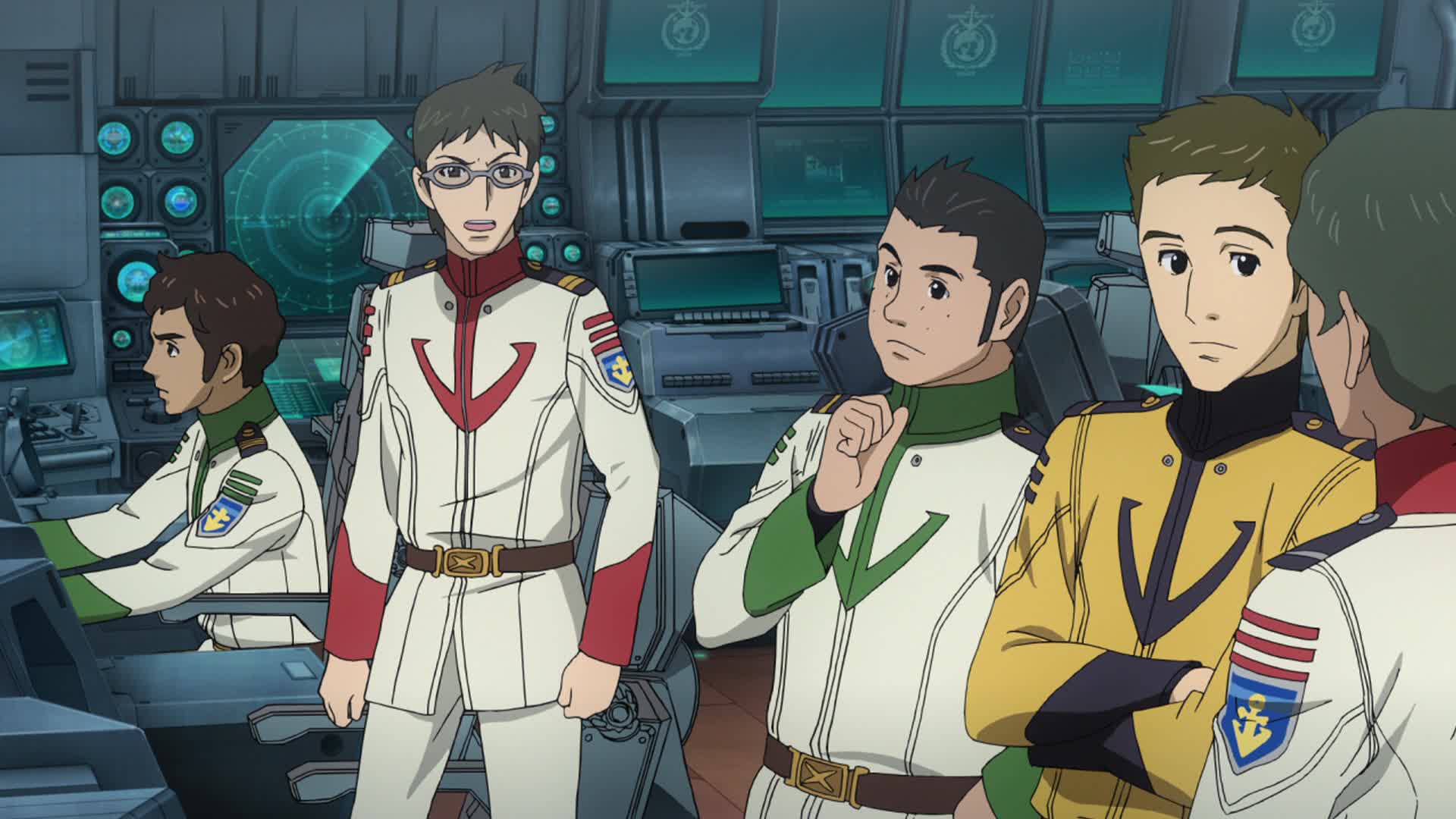
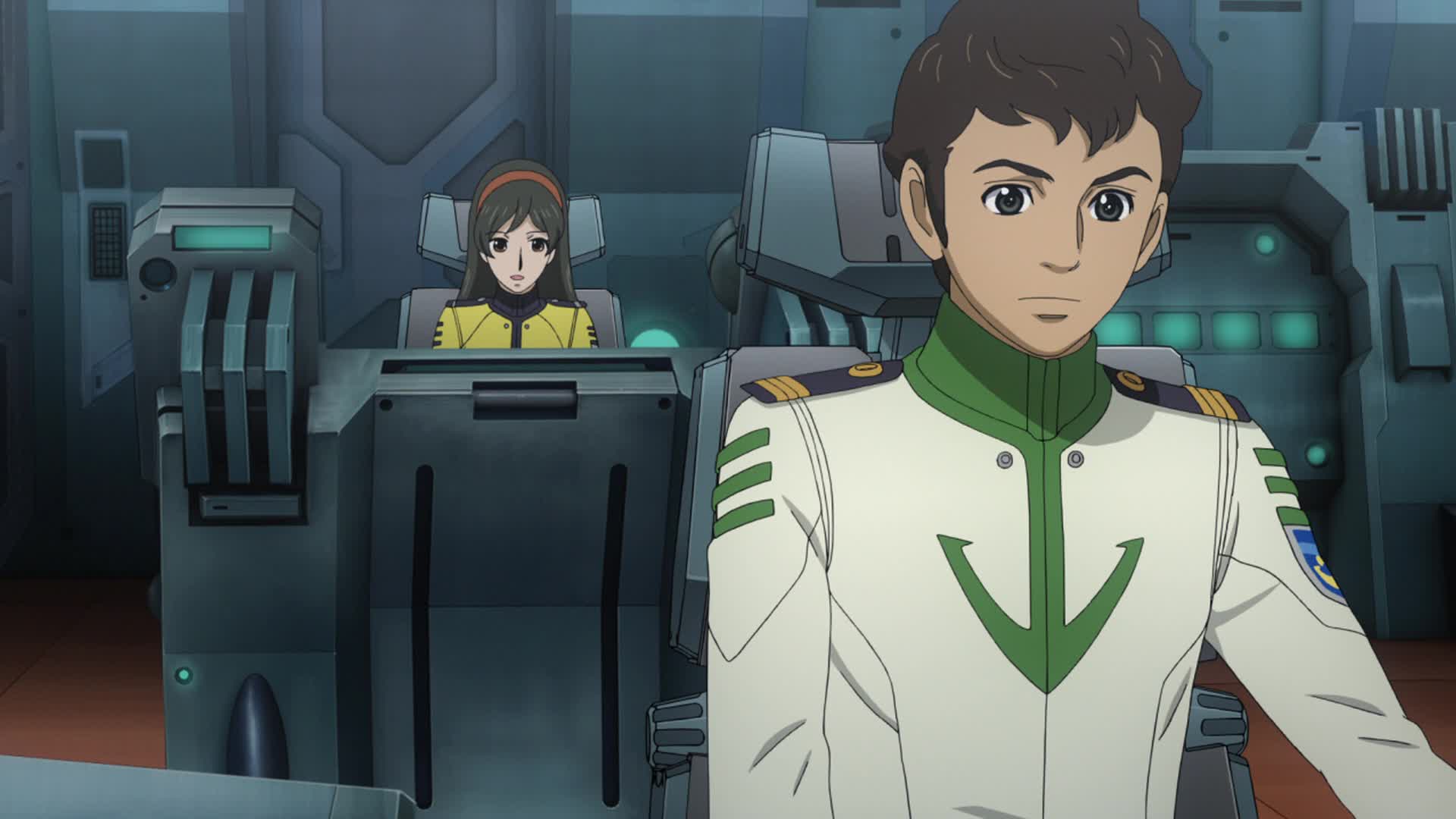
On the main bridge, Aihara wonders why Sanada took Yuki with him, since Kodai would be enough to provide protection. Kitano proposes that it was because she’s an Iscandarian. This causes an outburst from Nanbu, who is manning the main gunnery console, denying that Yuki is an alien. Ota points out that she did have Starsha’s message capsule and Kitano adds that she has no memories from over a year ago. Nanbu tells them to stop speculating. Shima puts an end to the exchange, reminding them they’re in the middle of a mission. Miki reports the Type-100 has entered the satellite.
[LC]: Despite the ridiculous response by Kitano, Aihara’s question does raise a good point. Why take Yuki at all? It’s obvious that she needs to be present to advance the plot and for all the exposition Sanada will make. Maybe we can justify it with them wanting to get her out of what must currently be, as typified by Kitano and Ota, a rather awkward environment for her. Also, perhaps Sanada wants her to know the truth before everyone else on board, since Okita has decided to let the Iscandarian cat out of the bag.
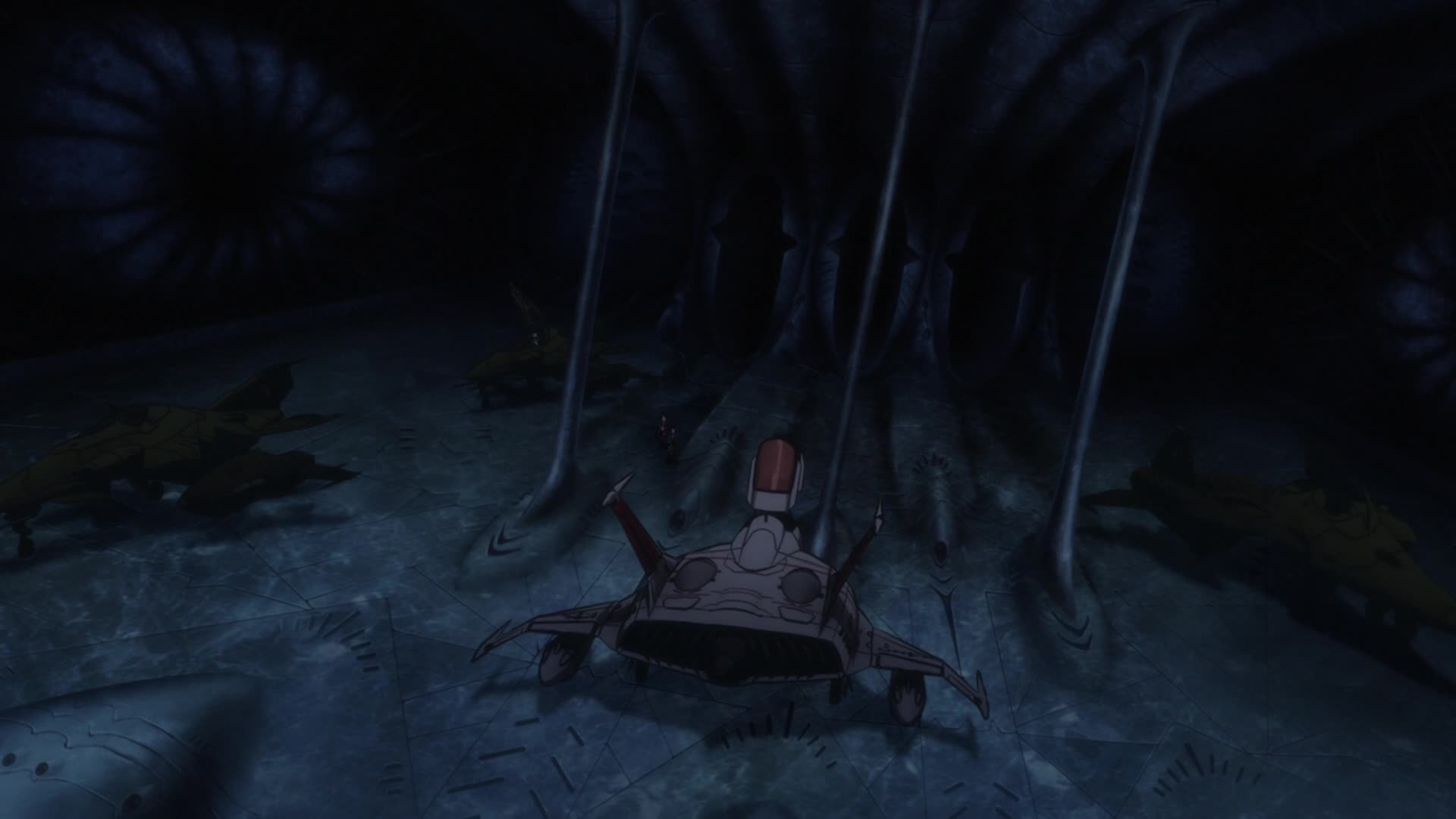
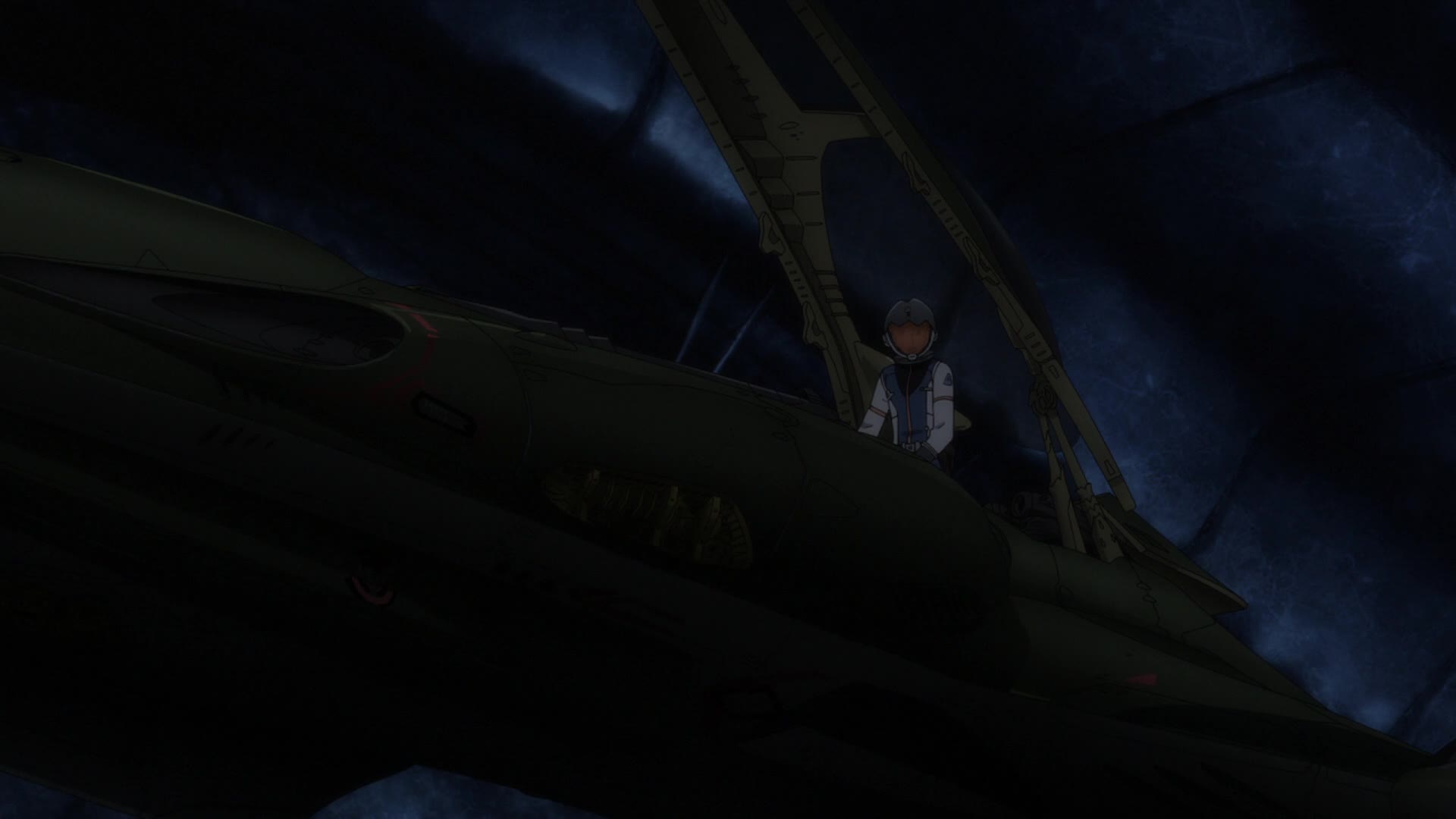
The ship has landed in a large bay where several Garmillan Czvarke-type craft are docked. Sanada is inspecting one of them, saying there don’t seem to be any booby traps. The base appears to have been abandoned long ago. since the inertial mass system (artificial gravity) is on-line, he expects the rest is still functional too. He says they’ll take one of the Czvarkes aboard once the mission is over, as it might still prove useful.
[DG]: Sanada’s reference that this is a “long-ago-abandoned base” is an interesting one. You would think that this gate was being used for quick transport from Balun to the Milky Way galaxy. But the Czvarkes are the most modern of the space superiority fighters in the Garmillas arsenal. Either they have been around for a lot of years, or this base is less recently abandoned than Sanada thinks. Perhaps they are only kept here as emergency inventory should someone be required to man the base.
That said, There’s nothing to suggest that the gates can’t be activated some other way. When Shangri-la travels to Balun using the Salazar warp gate, and then returns the other way, we are led to believe that Garmillas ships can activate the gates’ power systems remotely.
[LC]: Well, they may have other gates in the Milky Way in more strategically sound locations. With the Beemelans wiped out and no bee jelly flowing, they might not have any particular interest in this system any more. They left it powered down in case they might need it again.
The problem here is not the remote activation of the portal. You don’t need to man the control satellite to open it. But you do need the control satellite, and by extension its power core, to be active in order to power the gate. No juice, no gate network access.
As for the choice of having Czvarkes in a “long abandoned base,” it may not be the most chronologically sound, but we know why they chose them. Sanada deciding to take one on board sets up the plot for the next episode. But any fighter would do for that particular situation. What they’re really setting up is the return of a certain Garmillan female officer to Yamato, involving a few gallons of red paint. It had to be a Czvarke. She wouldn’t look the part in anything else.
I’m guessing when Sanada refers to the Inertial Mass system being in operation, he’s referring to the means where the power station is being kept in a static position.
Personally, I thought he was referring to the artificial gravity. We’ve seen it referenced that way a few times before
Possibly, but that would be a major scientific faux pas for Sanada to make. Inertial mass and gravitational mass are two very different things. Hence, from that standpoint I view “inertial mass system” as a reference to something else; maybe a system that stops the station floating off into the ether and keeps it more or less anchored to the gates. The gates themselves must also have a similar system in place.
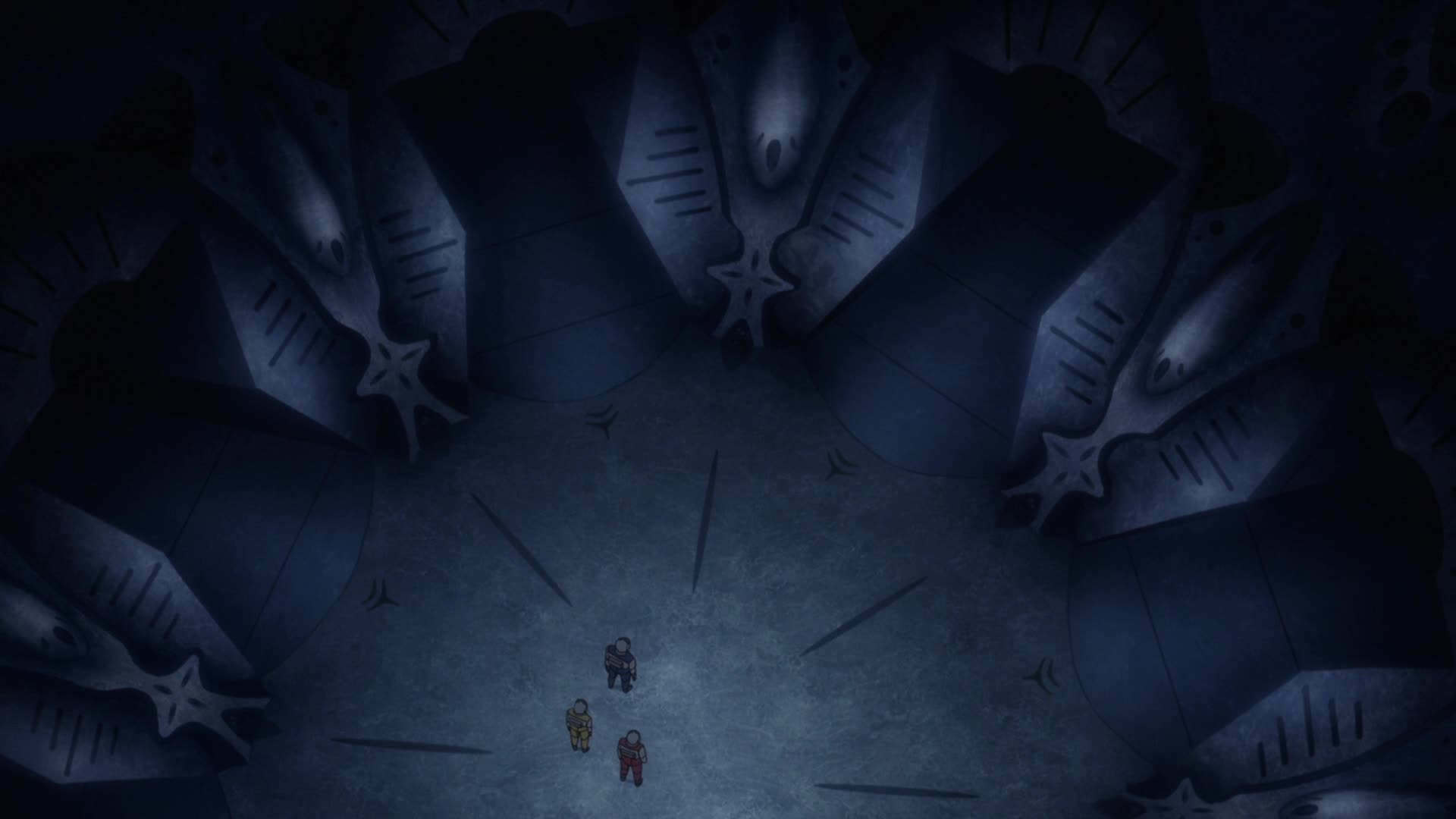
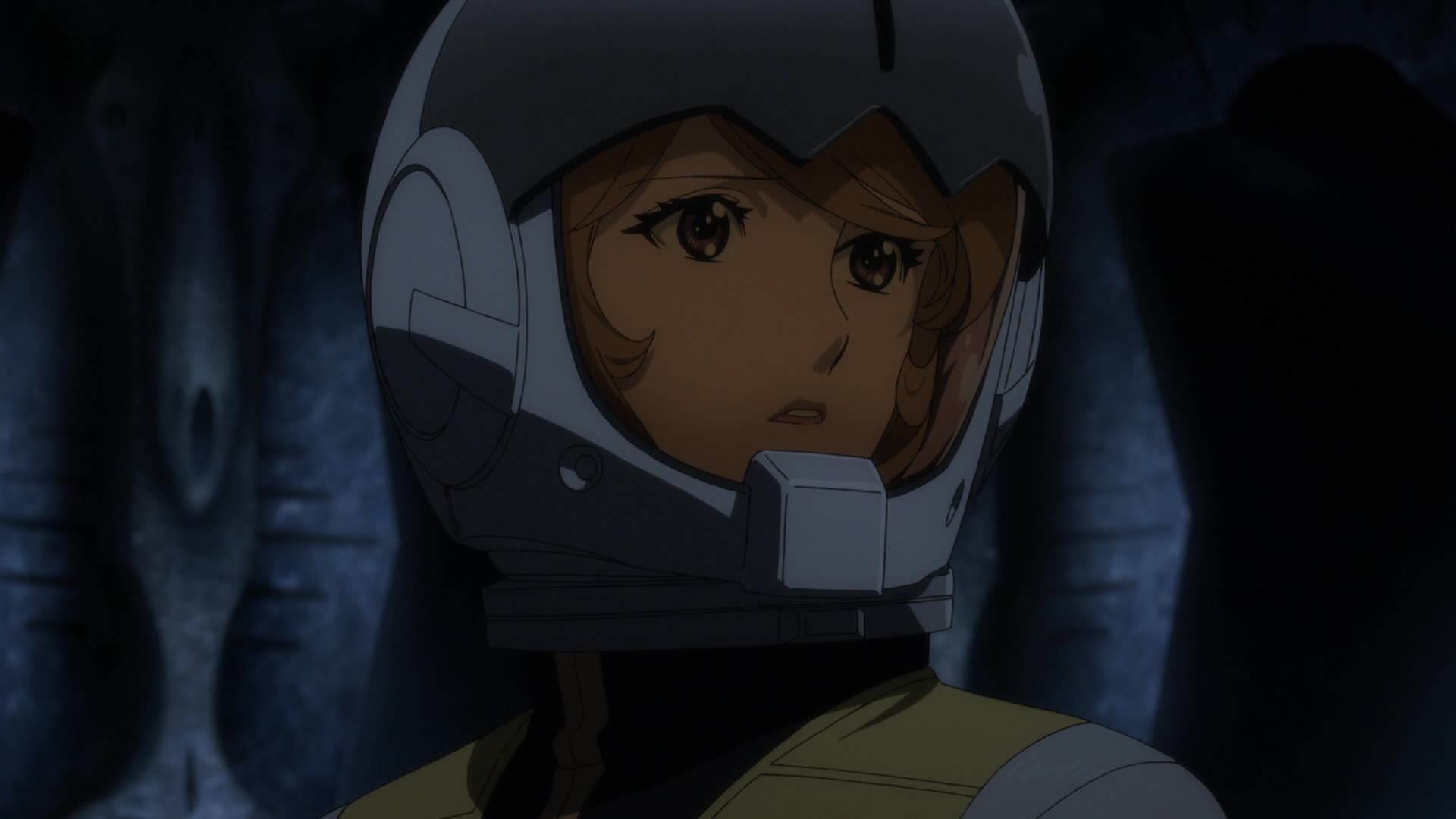
Kodai looks at Yuki, who’s been silent since they left the ship. He proposes they get the job done. They walk the large corridors, coming upon an intersection. Kodai has no idea which way to go and Sanada concurs, trying to deduce their next step from his pad. Yuki finally speaks, recalling that Sanada told them the station had been built by a civilization older than the Garmillas. When Sanada confirms, she wonders if they’d be upset that the Garmillans have tainted it.
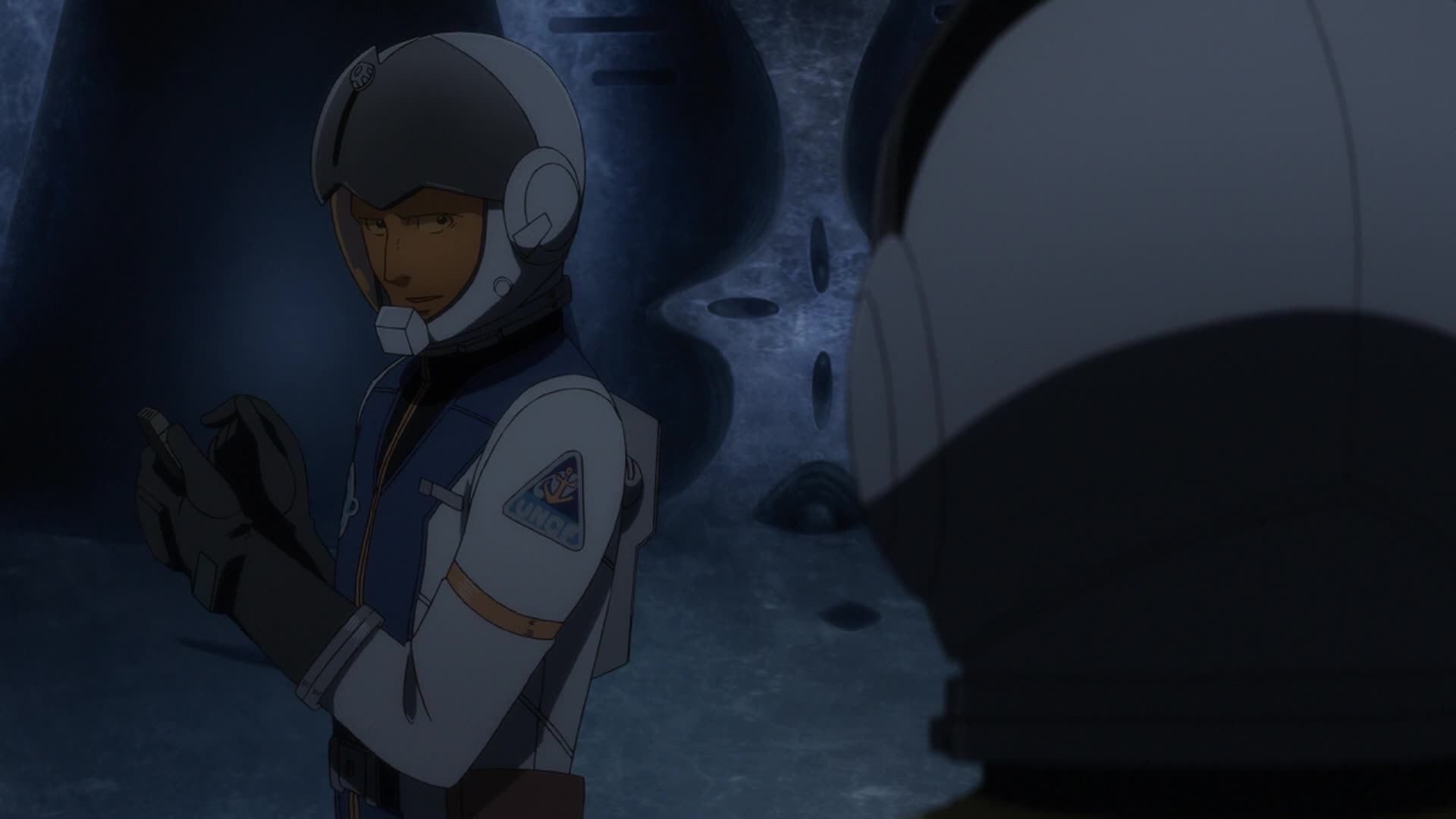
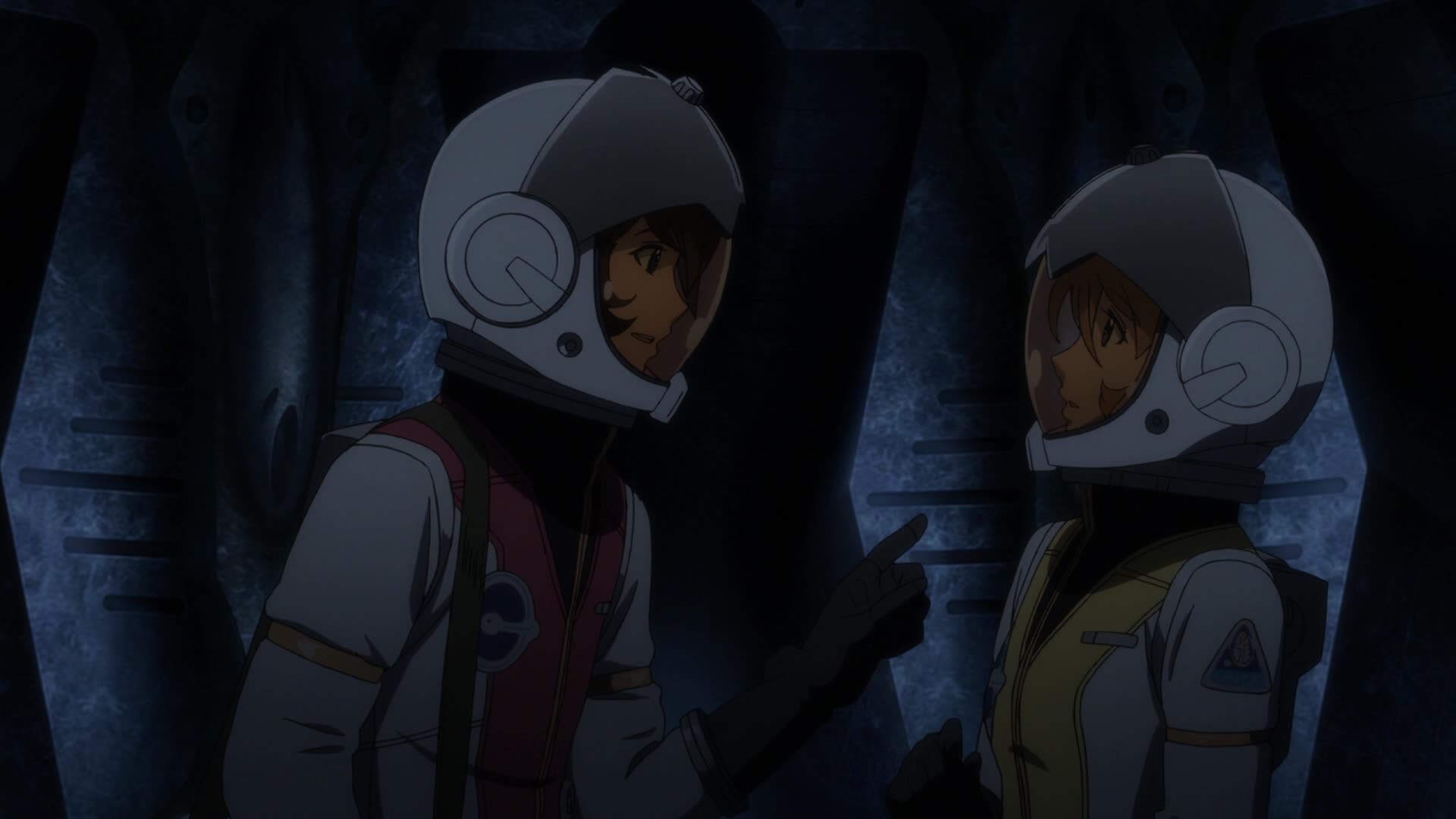
This prompts Sanada to respond with a verse from an ancient poem, saying “The sadness of being tainted makes the snow fall once more.” Kodai is at a loss but Yuki quickly recognizes the quote as belonging to Chuya Nakahara. Sanada says that he once knew someone who loved that poem. Yuki recalls he was a 20th century poet. Kodai immediately takes the chance to lighten Yuki’s mood, asking her if she thinks the Iscandarians would know about such an ancient poet – hinting that because she does, she can’t be from Iscandar. This puts a smile on her face.
[DG]: I’m not sure about this. Was he trying to lighten Yuki’s mood or was he simply trying to edge his way into a conversation that he had no idea about? Yuki’s initial reaction was one of her “remind me why I like this guy again” looks that we saw her pull after Kodai failed to see the cause of Yamamoto’s mood a few episodes back.
[LC]: Well, to be honest, Kodai doesn’t seem to know anything about Chuya Nakahara. It’s only because Yuki and Sanada comment about him being a 20th century poet that Kodai manages to make that leap. But his reasoning is somewhat logical. Even if Kodai seems a bit out of it at times, he’s not a complete idiot. We’ve seen him giving glances at Yuki and noticing that she is quite disturbed by the recent events. He was probably looking for some way to get a smile out of her and took the chance.
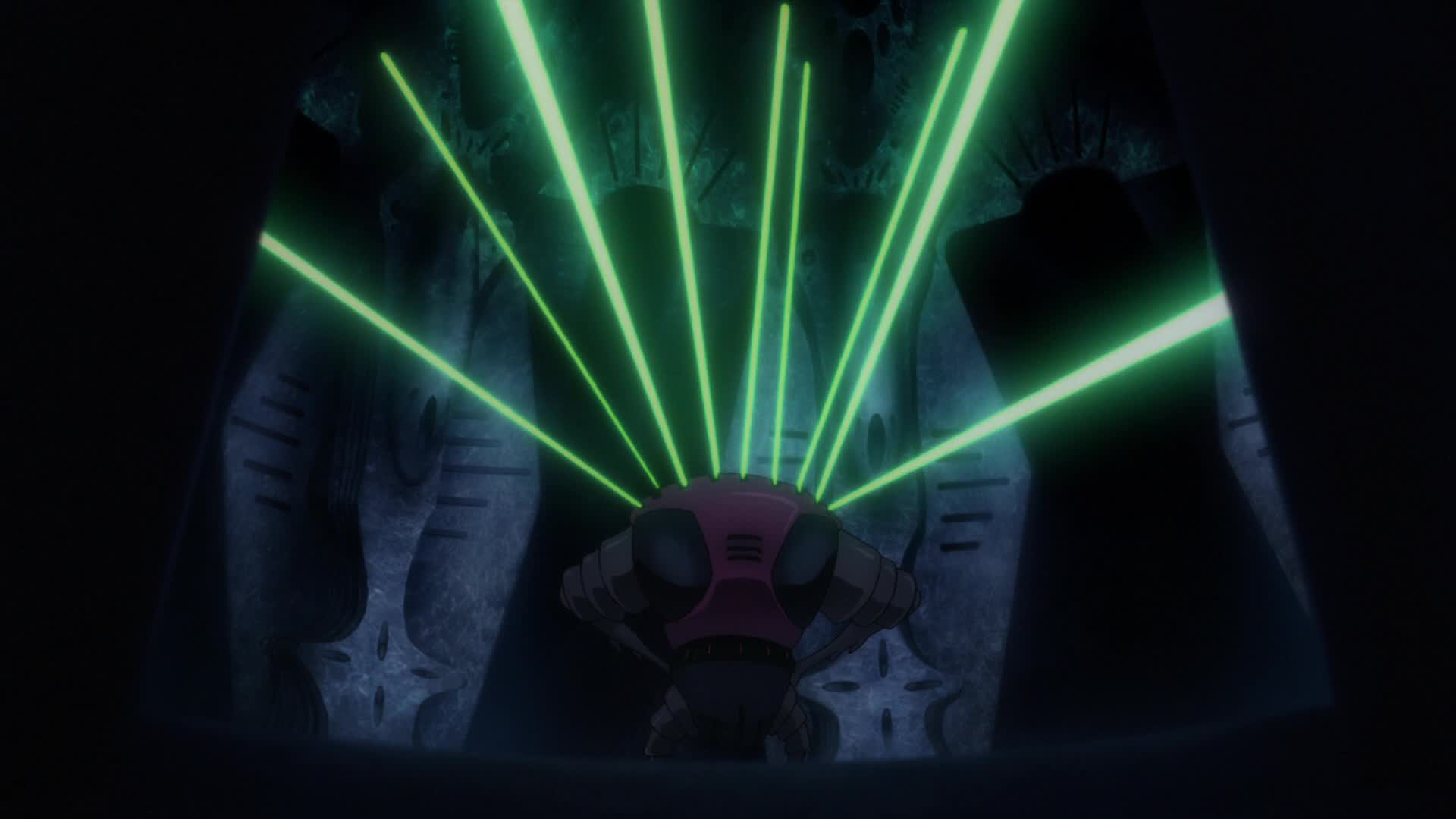
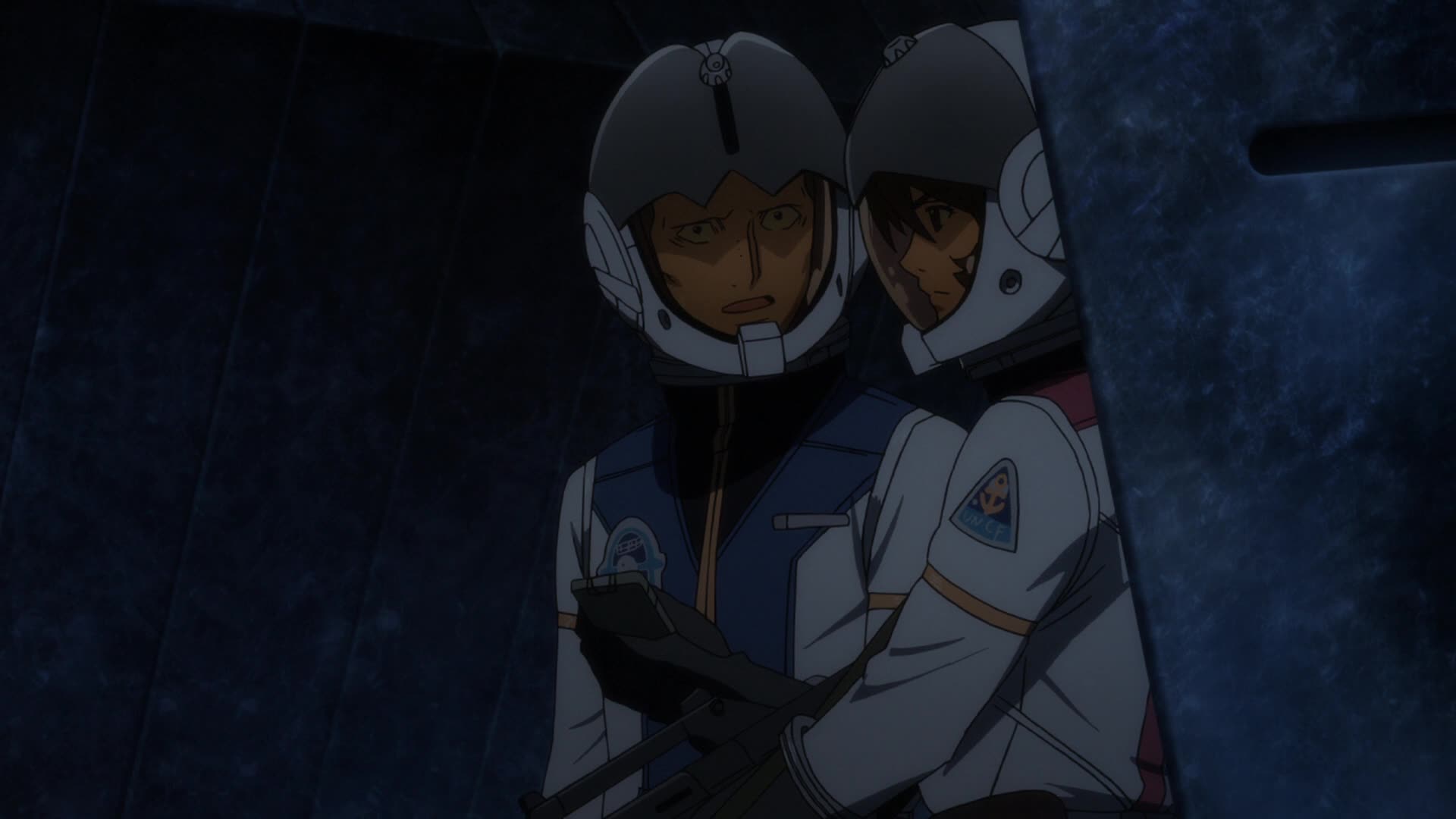
Sanada breaks the moment, telling them to get out of sight. A guard drone appears, scans the chamber, and then moves on to another corridor. From his hiding spot, Kodai says it seems the Garmillas left some guard dogs behind. Sanada says there may be more, before finally choosing the right path.
[LC]: Another bit taken from the original Episode 18. This robot, designated Null VI Patrol Robot, is an updated design of the ones guarding the Magnetron Wave Fortress. Oh, the nostalgia is strong in this one.
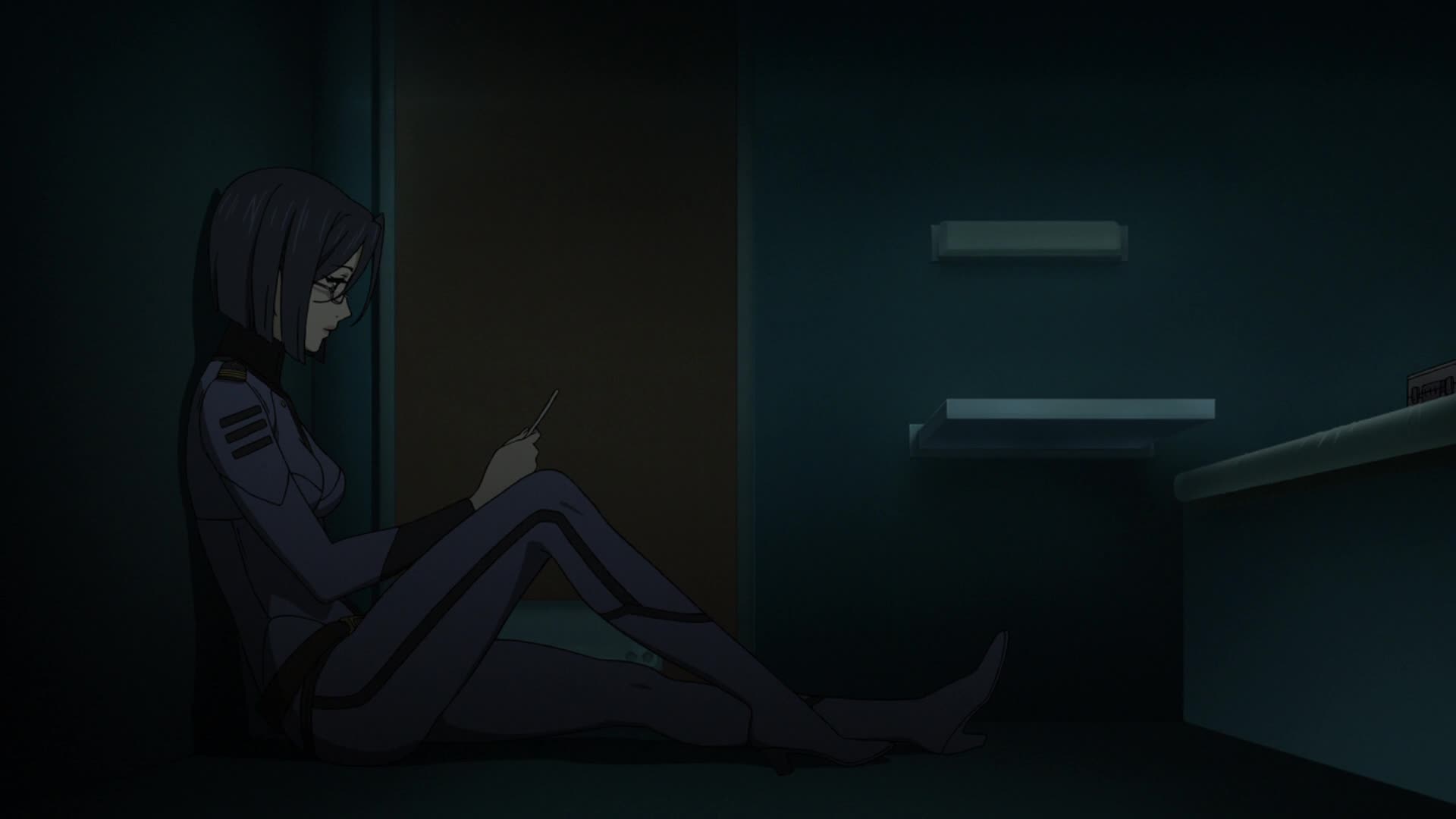
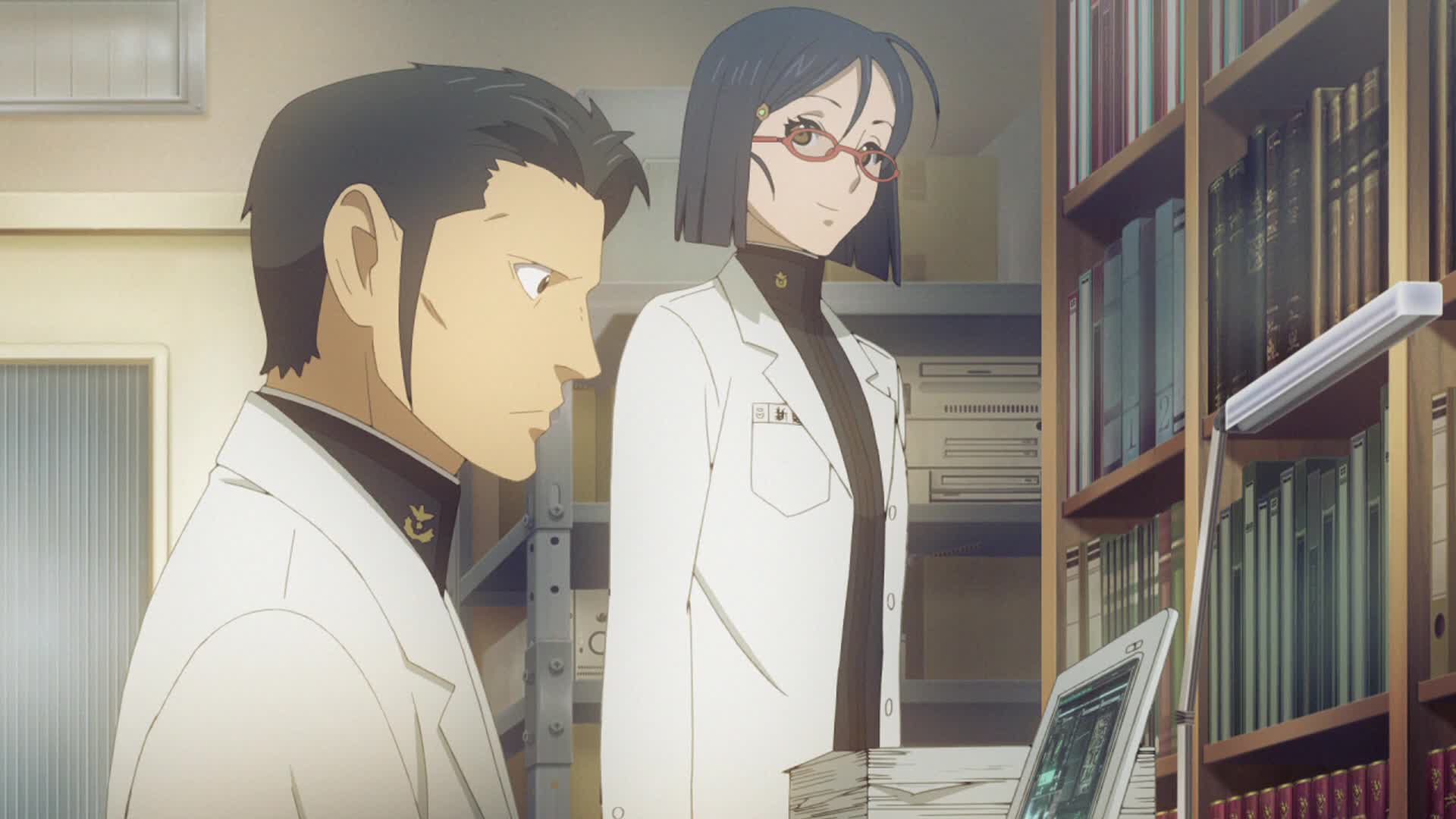
In her cell, Niimi recalls that “he” was always that way. That whenever she didn’t know what to do, he’d show her the way. Flashback to 2192, seven years ago. We see Niimi bringing Sanada some papers he had requested. He thanks her and proceeds with his work.
[LC]: I like how they subtly set this scene up. We see her holding the photo, and from our POV she is reminiscing about Sanada, how he guided her as a mentor back at the academy. But is that truly it? Lets move along and dive into this when necessary. 🙂
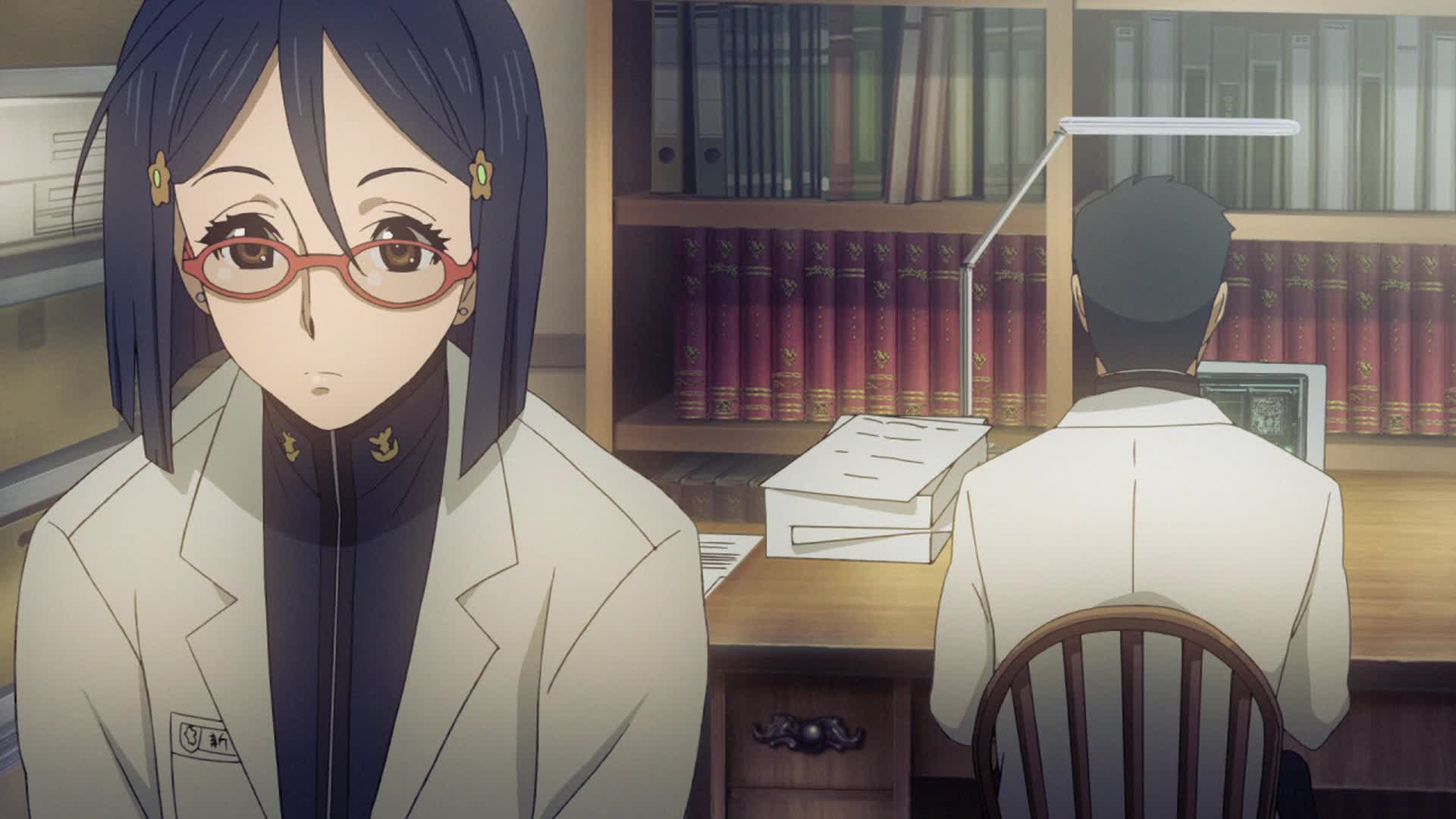
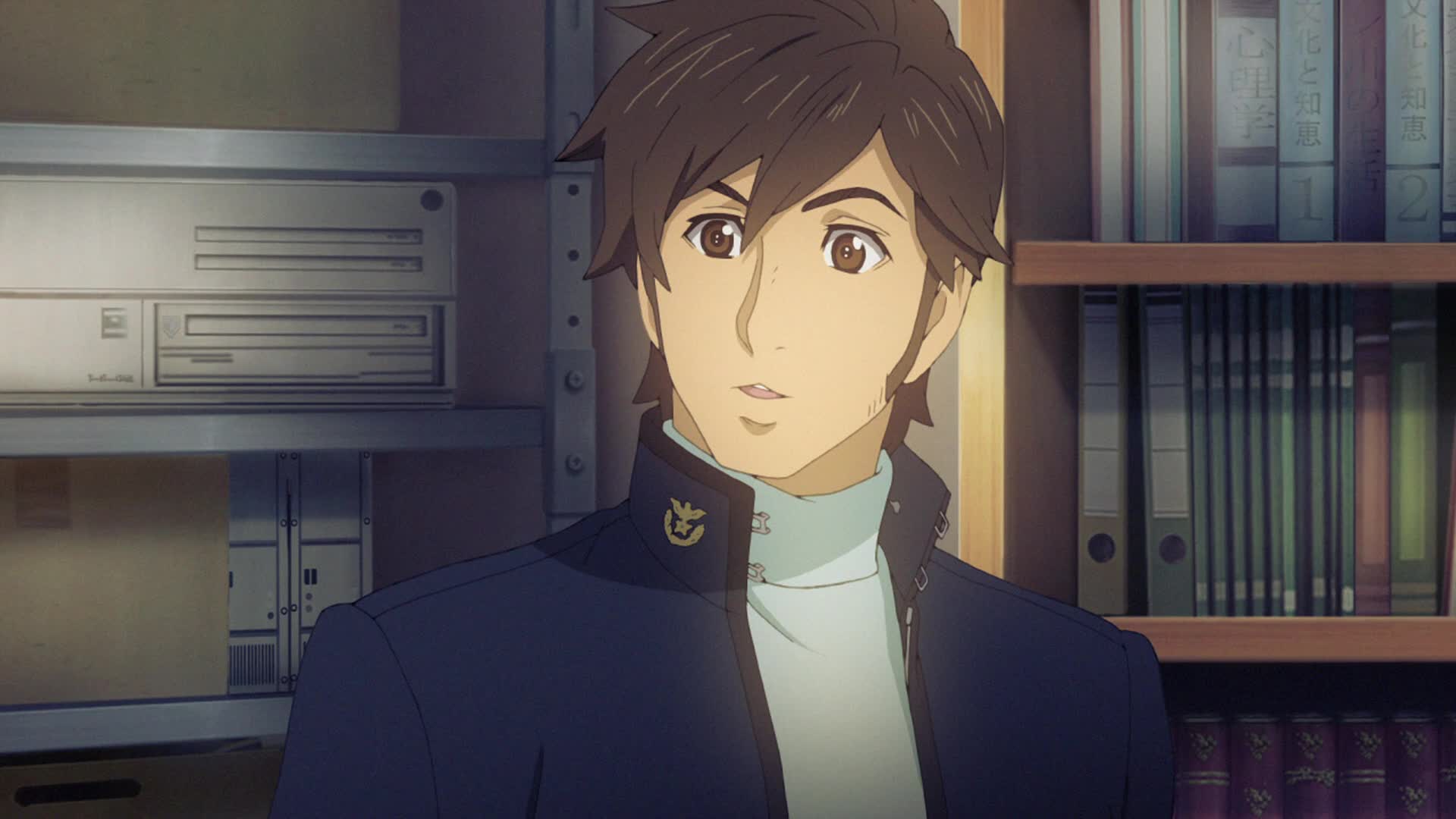
After a few seconds watching her mentor, she says that it appears the alien fleet has reached Mars. Rumor has it that the shelters from the Inner Planets War have been upgraded and everyone was evacuated there. A voice coming from the door tells her not to worry. She turns and sees Mamoru Kodai, who says they’ll soon be starting a big operation to defend Mars. Niimi asks him where he got that information, but he says it’s a secret.
[LC]: These shelters eventually became the underground cities. Using a previously existent infrastructure is more plausible than building them from scratch when the Planet Bomb attacks started.
There is a slight inconsistency here. Mamoru is still at the academy and a long way from becoming a UNCF officer. This conversation seems to indicate that Operation K2, also known as the second battle of Mars, is about to take place. This was “the one battle we won,” as Tokugawa will say in a few episodes. It was because of this battle that the Garmillas retreated to Pluto and began attacking with Planet Bombs.
In that same upcoming conversation, Tokugawa reveals Mamoru was Kirishima’s new Weapons Officer. On the one hand, that would explain how he knows this information. However, I don’t see how the UNCF would put put an academy cadet in such a position, unless ship duties were part of the program. Age wise, Mamoru was 21 at the time. At only 20, Susumu is the Tactical Officer of Yamato. Sure, he is only in that position because the original crew got killed. Perhaps a similar lack of personnel led Mamoru to that position. Still, it takes a bit of juggling to make all the pieces fit.
It’s not uncommon during wartime for very young people to find themselves in positions not normally accorded to their age. Mitsuru Yoshida, author of Requiem for Battleship Yamato (his account of the events of April 7, 1945) was 20 and a law student at Tokyo Imperial University when he was called into the Japanese navy in 1943. Two years later, he would be the sole surviving officer from Yamato‘s bridge crew. Unlike the brothers Kodai, he was conscripted directly out of university and given minimal formal officer training.
Interestingly enough,the book’s English language translator, Richard H. Minear, notes that amongst his other works was an essay entitled “The Space Cruiser Yamato Generation,” published in English in Japan Echo (Volume 6 Issue 1, [1979] pp 80-87). Also of interest is the following note made by Minear regarding the anime:
To be sure, that spaceship is modeled on Yoshida’s Yamato; but one can only speculate on the number of the cartoon’s fans who know much at all about the real Yamato.
[As an aside, for those who haven’t read Requiem for Battleship Yamato, I wholeheartedly recommend it. The book is available on Kindle and Google Books. It was recommended to me by Ed Hawkins; for those interested in The Space Cruiser Yamato Generation, you can read the paper here].
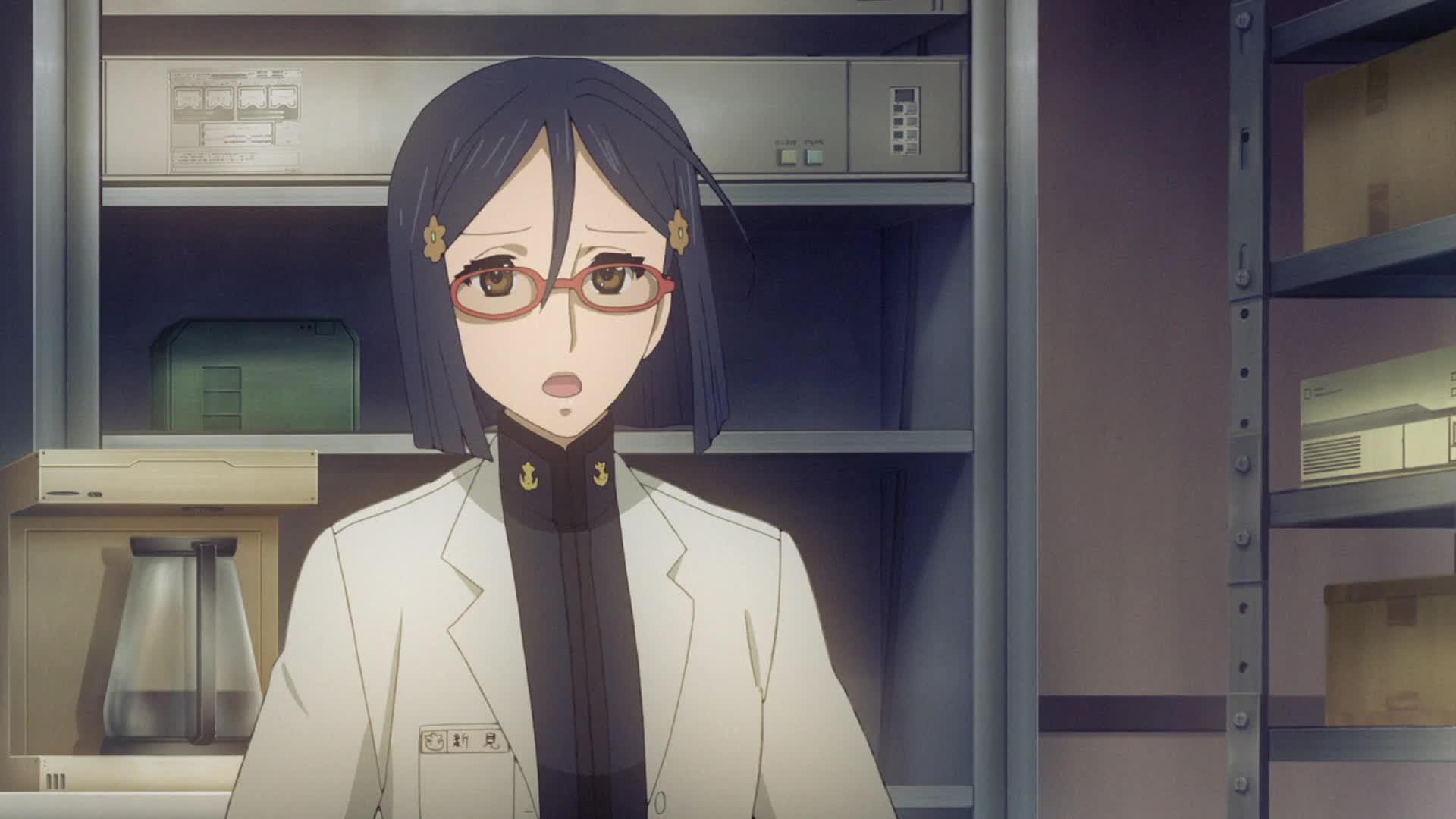
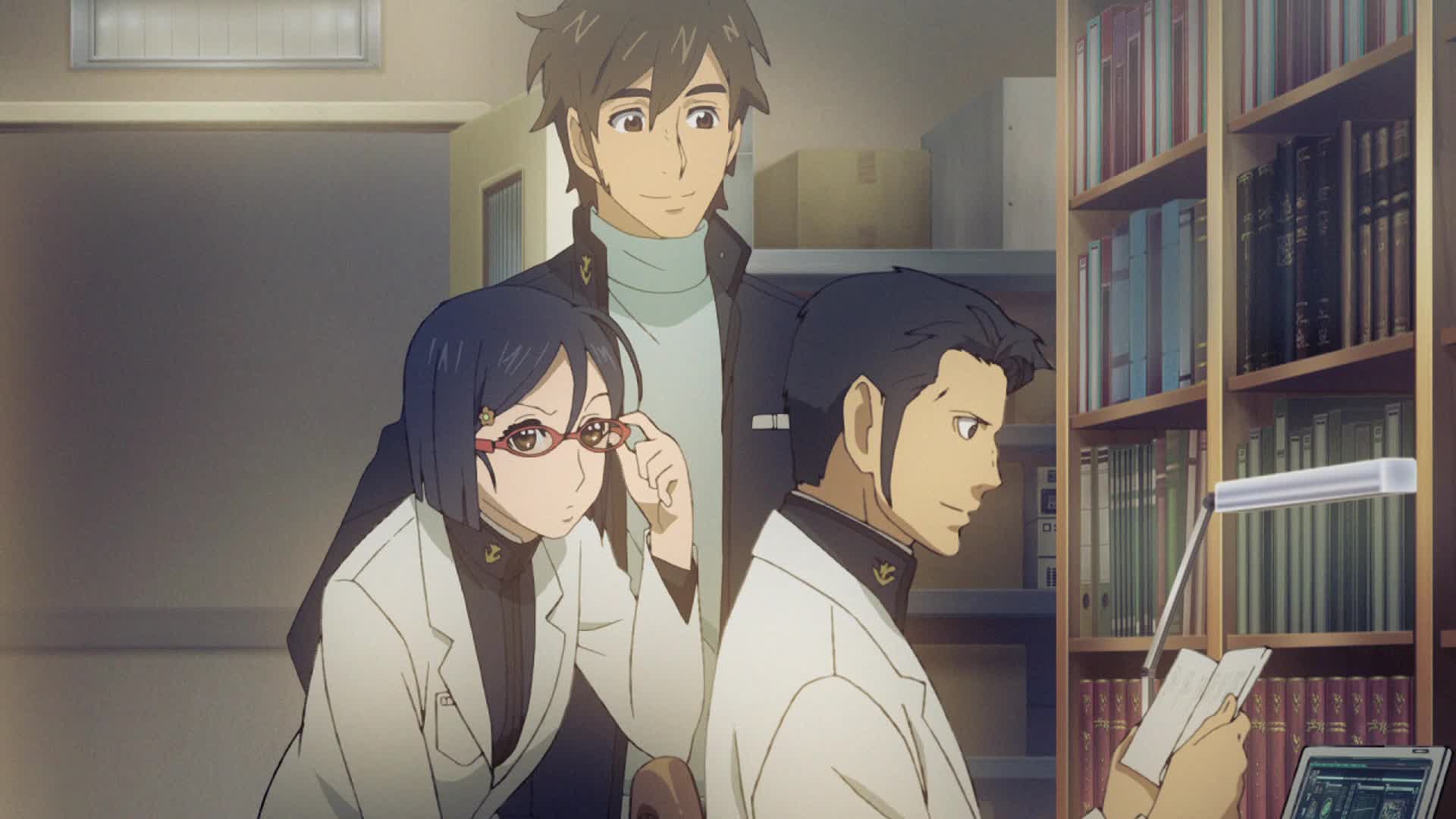
Annoyed, Niimi asks what he wants, since he can’t enter the lab without permission. He asks her if she has permission, to which a flustered Niimi responds she was there delivering some papers to Sanada. Sanada smiles at their interaction, and Mamoru says he’s also there to make a delivery. He takes a small book from his jacket pocket and hands it over to Sanada, recalling that he said he’d like to read it sometime. Niimi looks at the book, surprised at the content. It’s a book of poetry.
[LC]: It’s a nice touch that the book Sanada still carries around with him was actually given to him by Mamoru. For a bit more information about this book and a full translation of the poem that’ll be quoted often in this episode, click here.
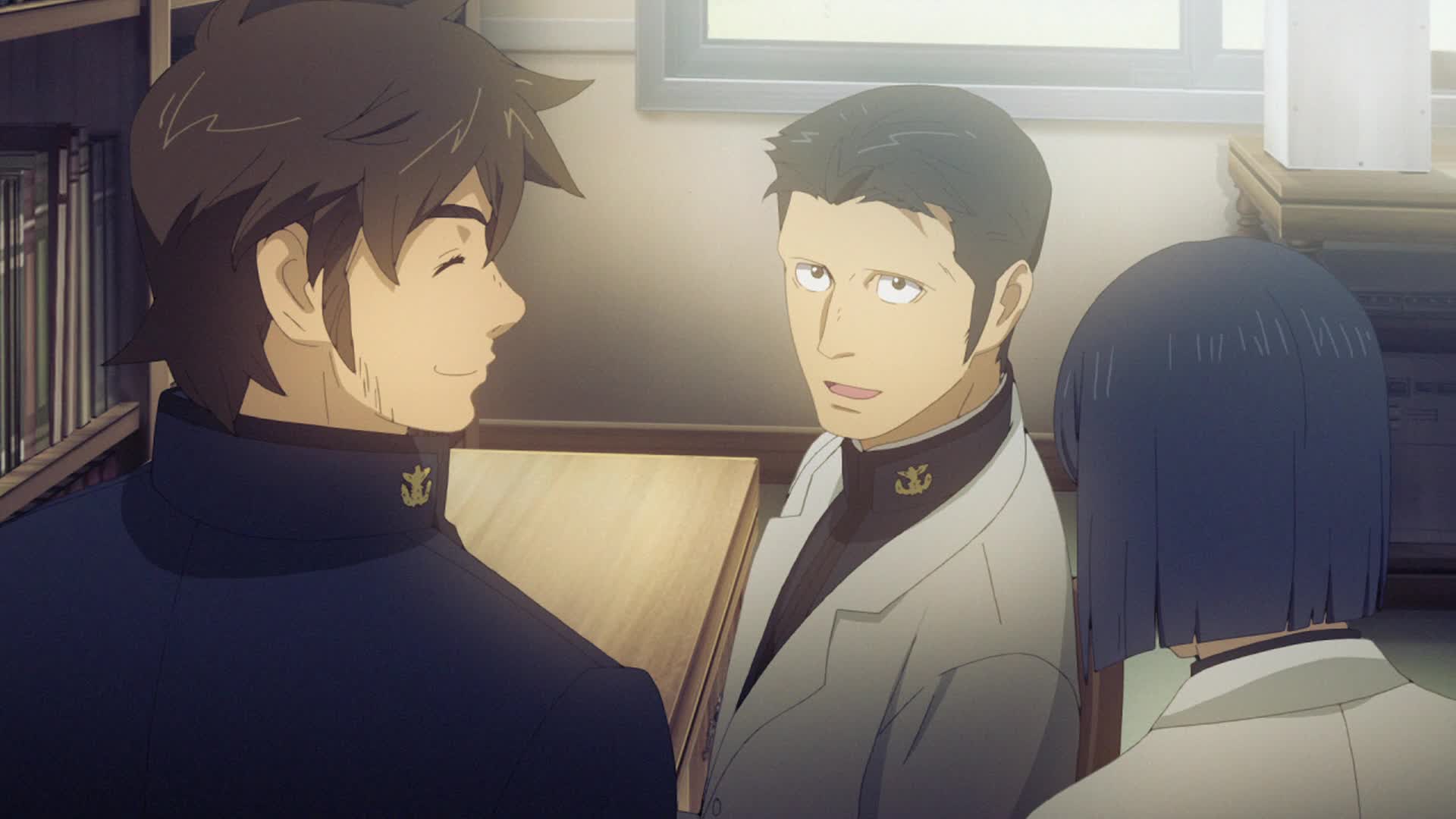
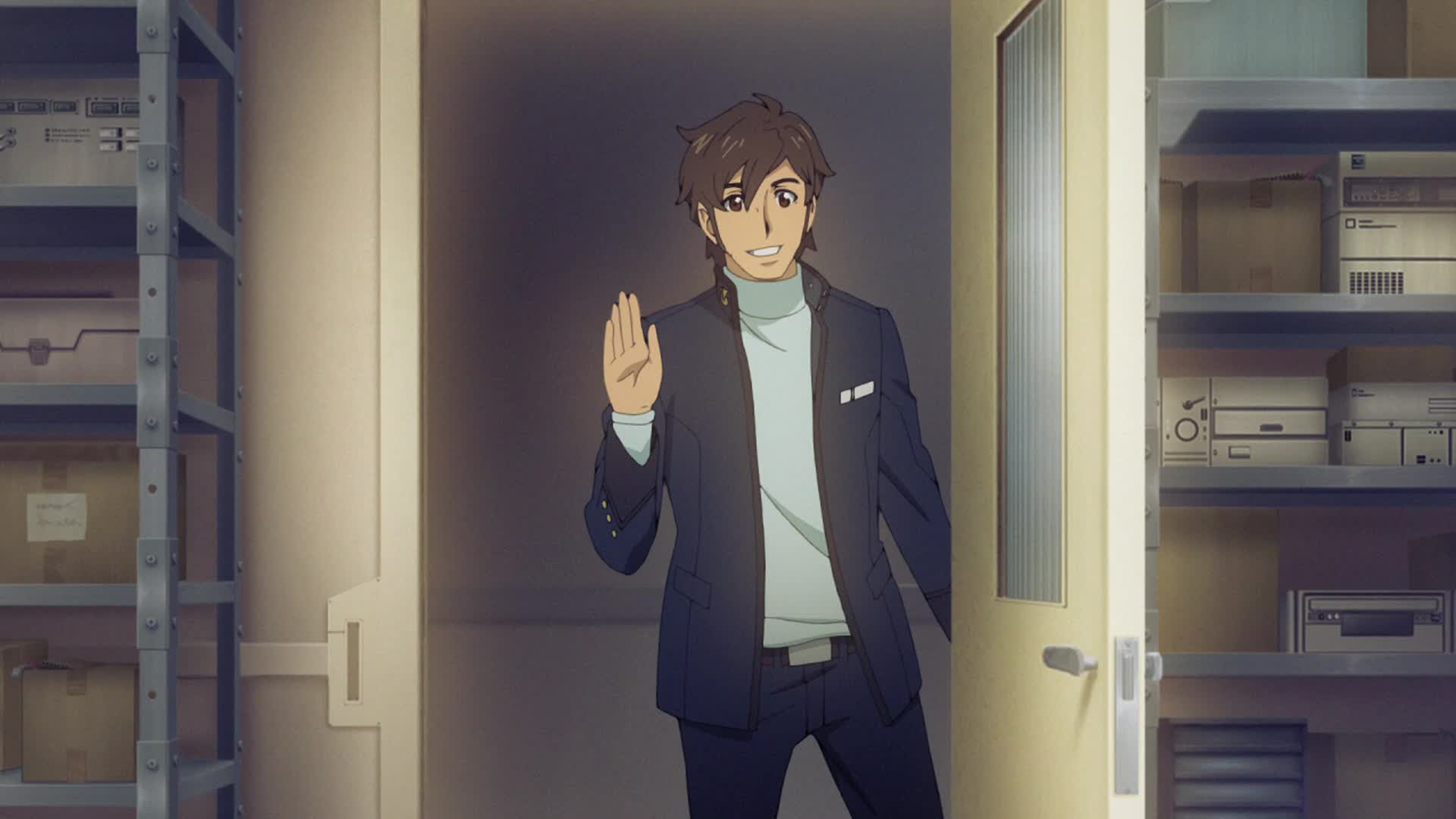
Mamoru says he thought equations were Sanada’s only interest. Niimi initially nods in agreement but then tries to clumsily back off. Smiling, Sanada warns Mamoru that his “friend” has arrived. Mamoru looks at the image on the screen where a security video feed show a young boy standing by the entrance gate. Startled, Mamoru remembers he had promised to meet Susumu, then runs out.
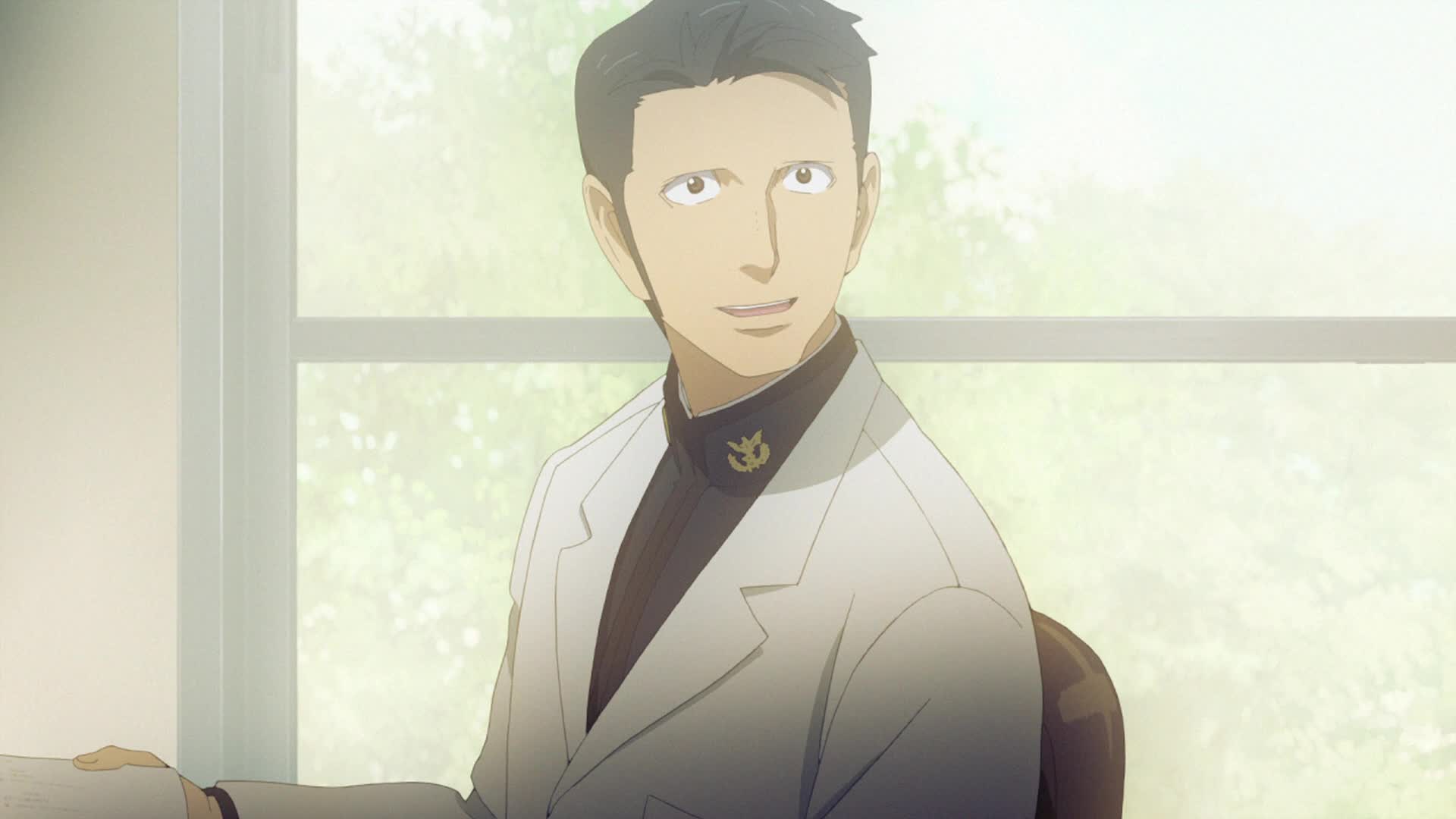
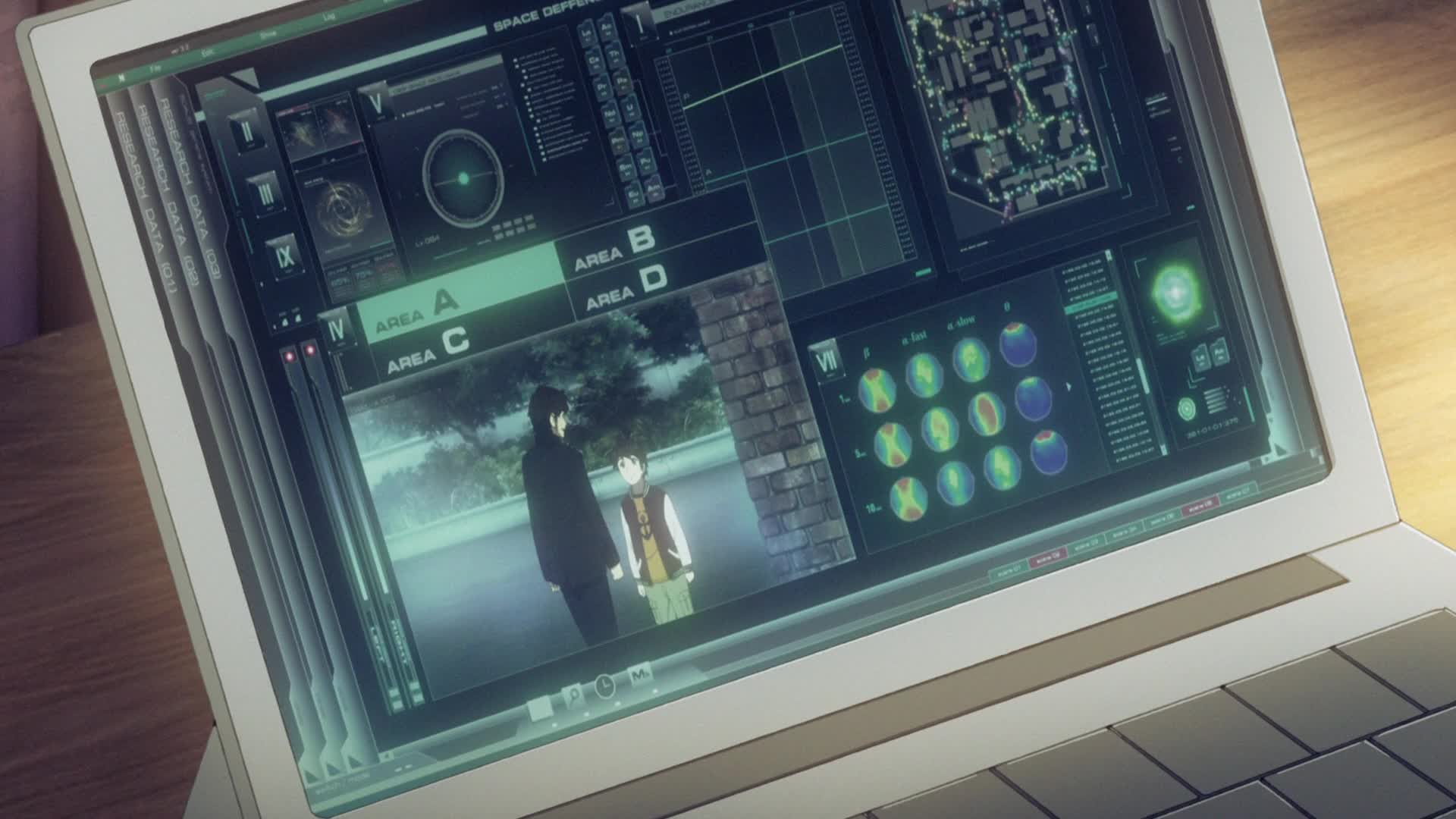
Niimi comments that Mamoru always does whatever he feels like. Sanada responds he’s honest with himself and that Niimi could learn a thing or two from him. Niimi is surprised by this but remains silent. Sanada watches as Mamoru meets Susumu by the gate.
[LC]: Susumu’s visit to the academy is reminiscent of the one he makes in the original series, the day their parents are killed by a Planet Bomb strike. Susumu was on his way back home when the bomb hit. In 2199, this visit takes place some time before the bombings begin. In Episode 14 we learned that Susumu wasn’t home when his family was killed because he was headed to the space port to pick up Mamoru.
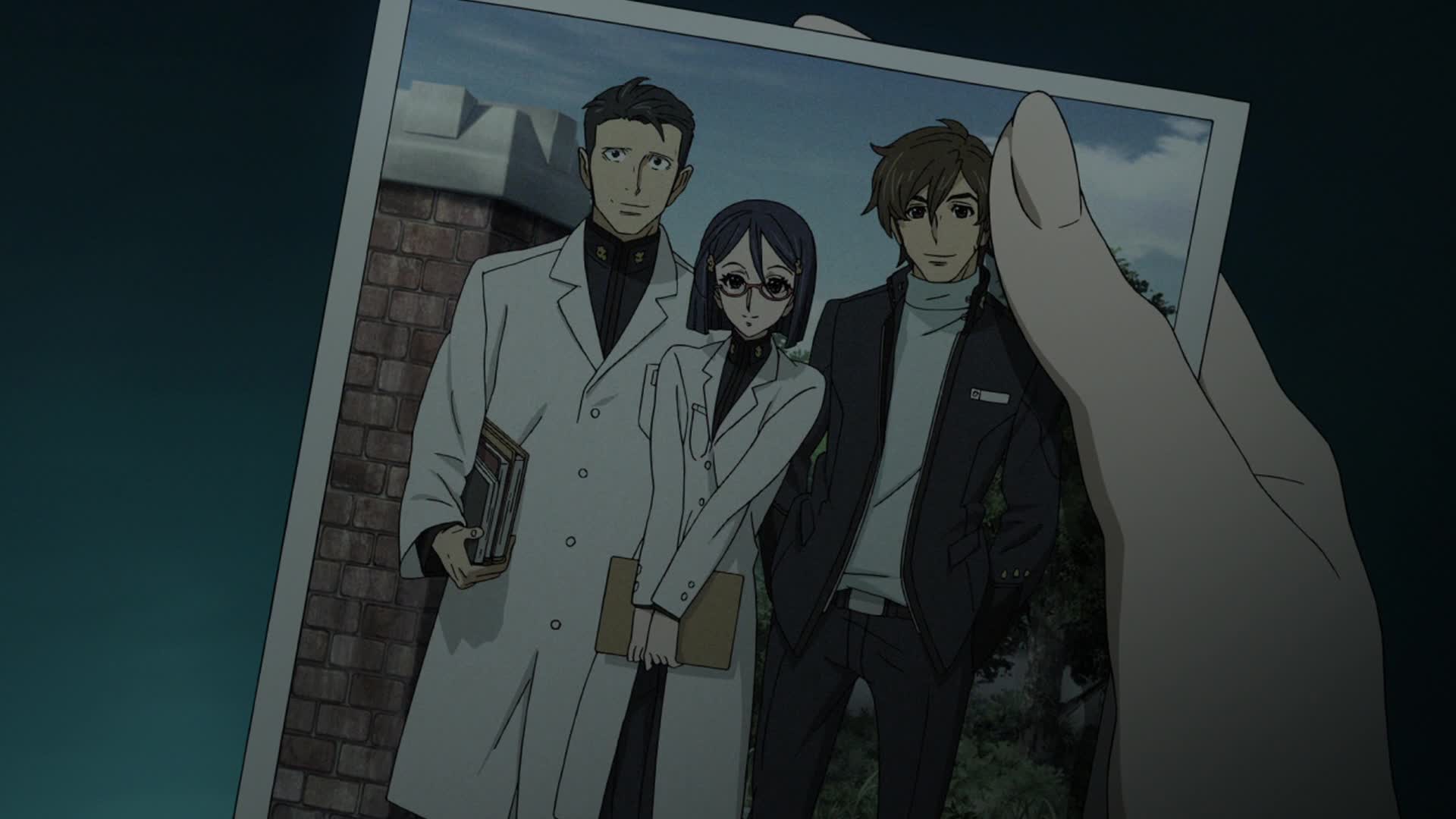
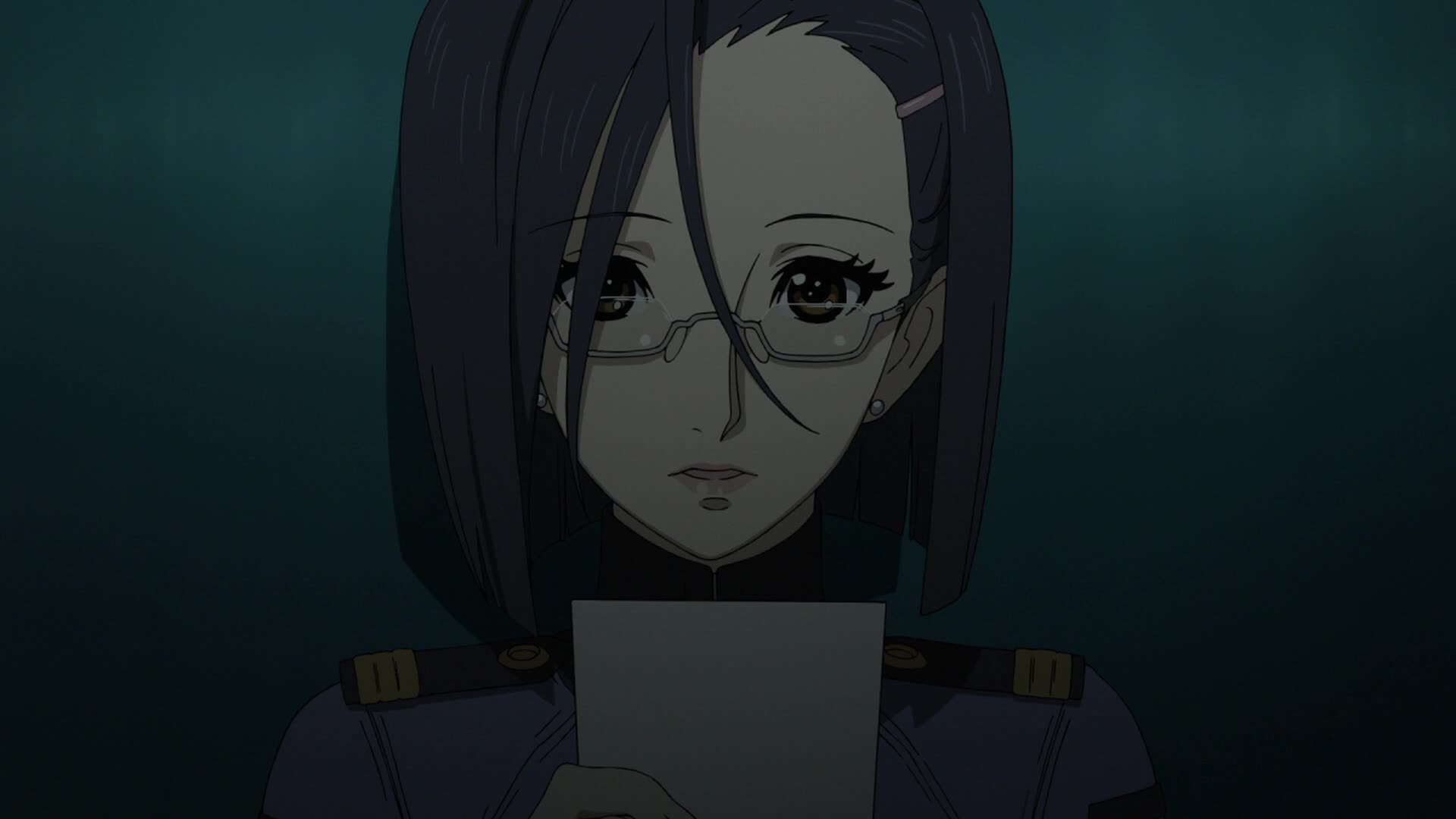
Back to present-day Niimi, still holding the same photo as before. She moves her thumb to reveal the third person: Mamoru. She closes her eyes and sighs his name, a sigh filled with longing.
[LC]: This is the point where Niimi’s true feeling come to light. In some scenes it seemed she was pining for her sensei. Looking back at those scenes after this episode, particularly the one in Episode 4 where Sanada is saluting the wreckage of Yukikaze, we suddenly realize that she was actually longing for someone else. As much as Sanada is suffering from the loss of his friend, Niimi is suffering for both Sanada’s pain and the loss of her own love. For me this really changed my perception of her character.
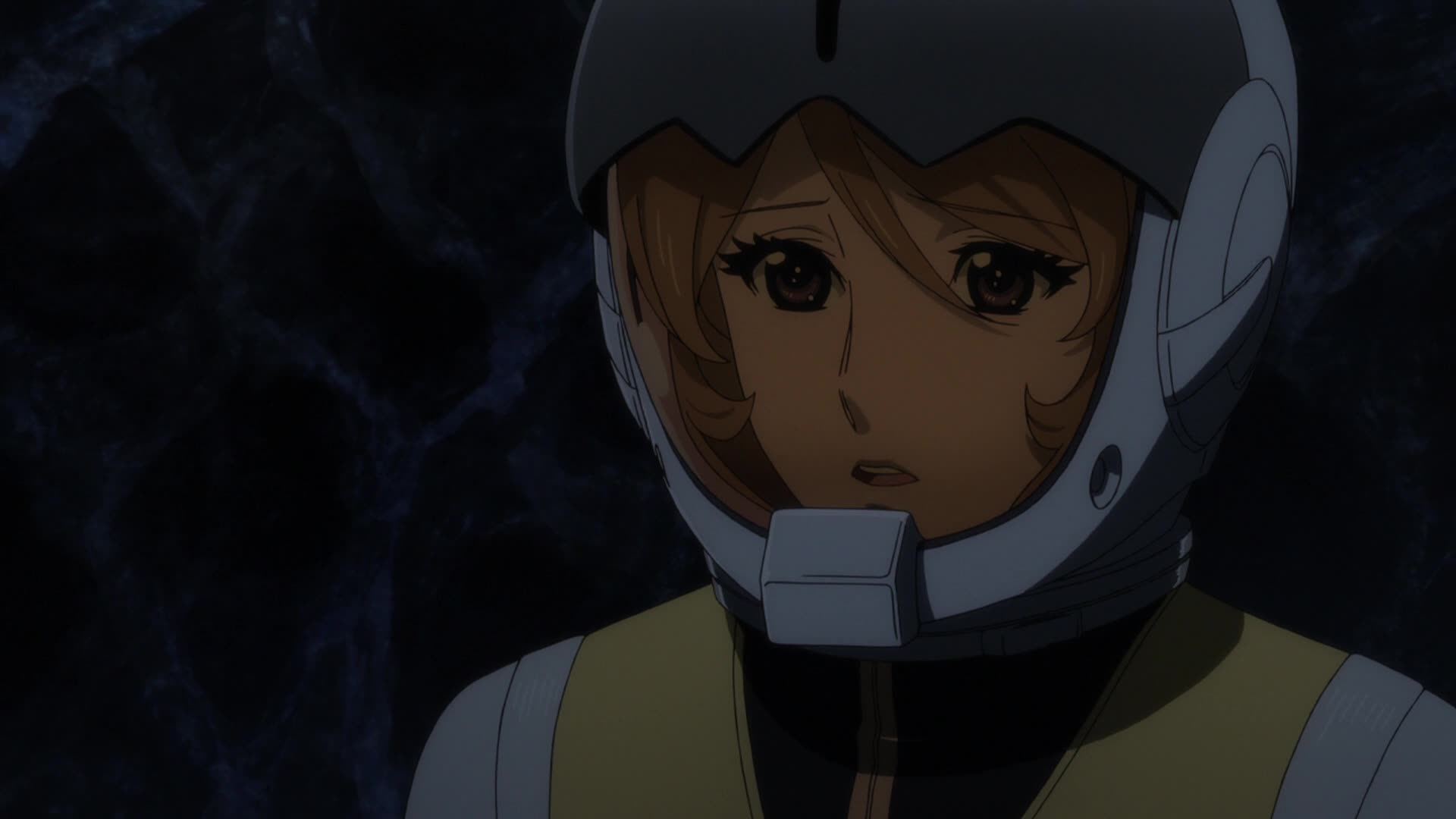
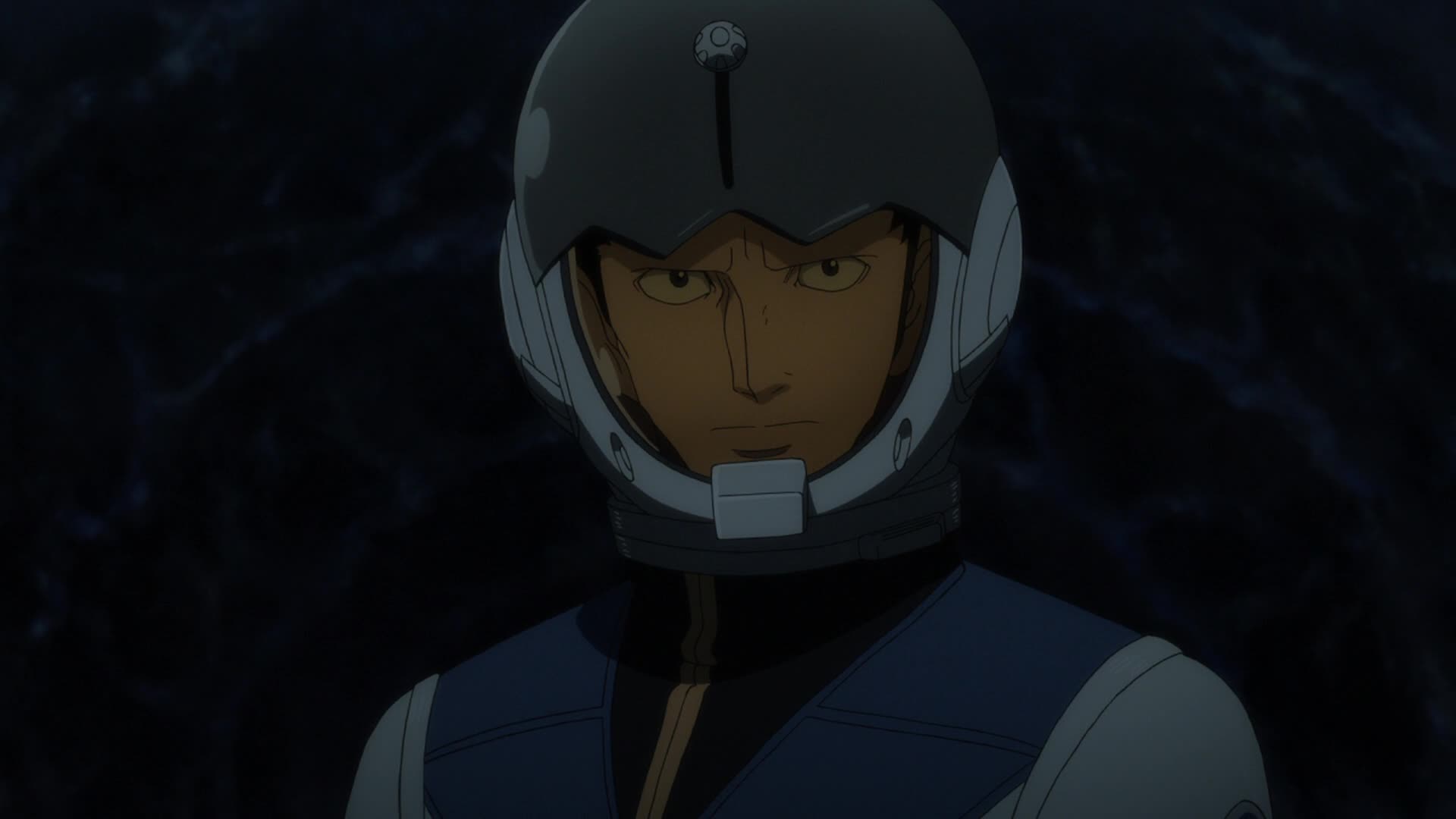
Sanada is immersed in thought, recalling the same “honest with yourself” line. Kodai is glad he was able to prove Yuki is an Earthling with his previous bit or reverse logic. But Yuki then wonders… why is it that she has no memories from beyond a year ago? And whether or not it’s just a coincidence, that’s when Yurisha disappeared. To the young couple’s surprise, the answer comes from Sanada, who claims that it is not a coincidence. The group stops as Sanada faces Yuki, saying he should have told her the truth sooner. He reveals Yuki and Yurisha were both involved in the same accident.
[LC]: Finally, some straight answers.
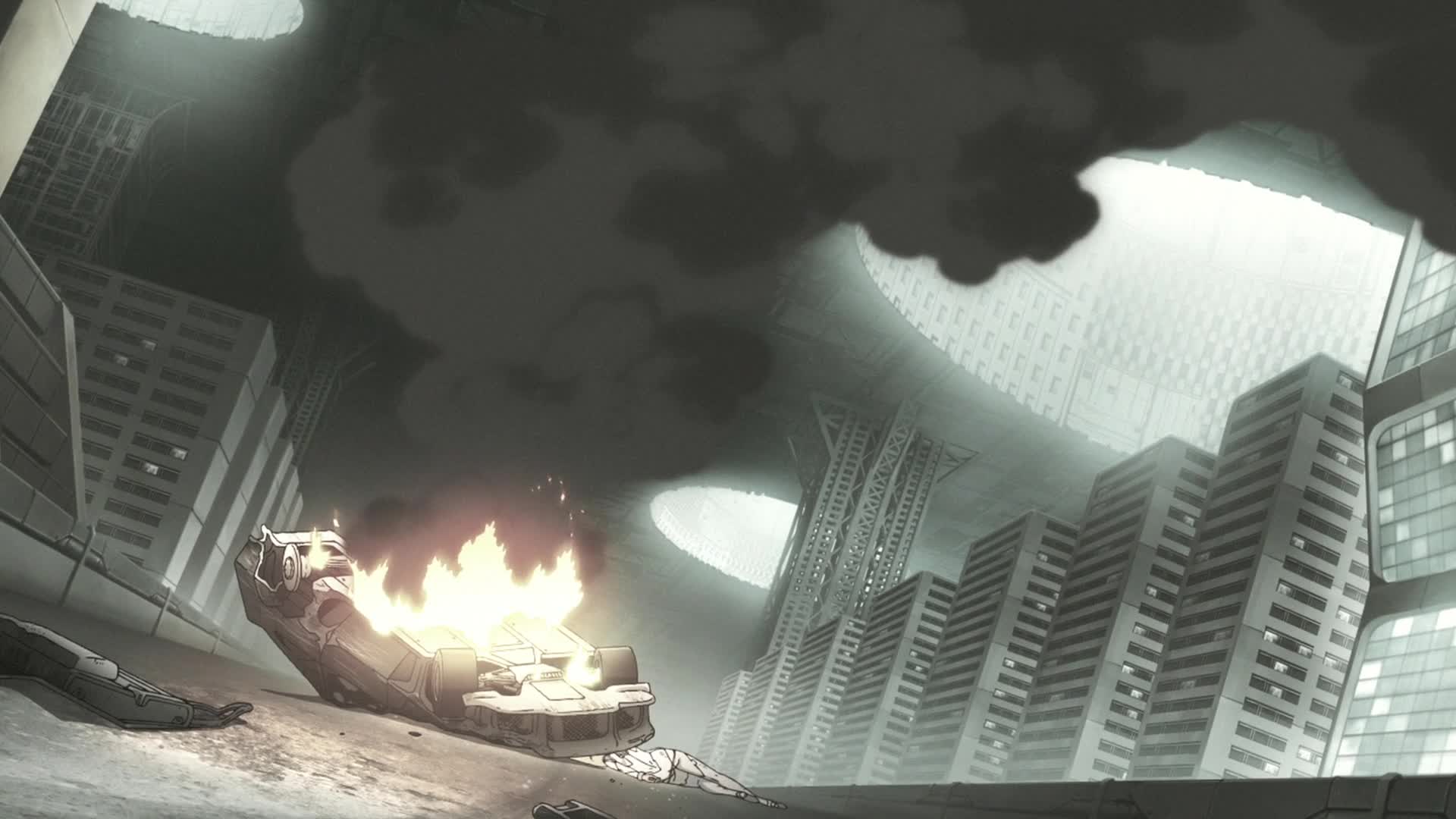
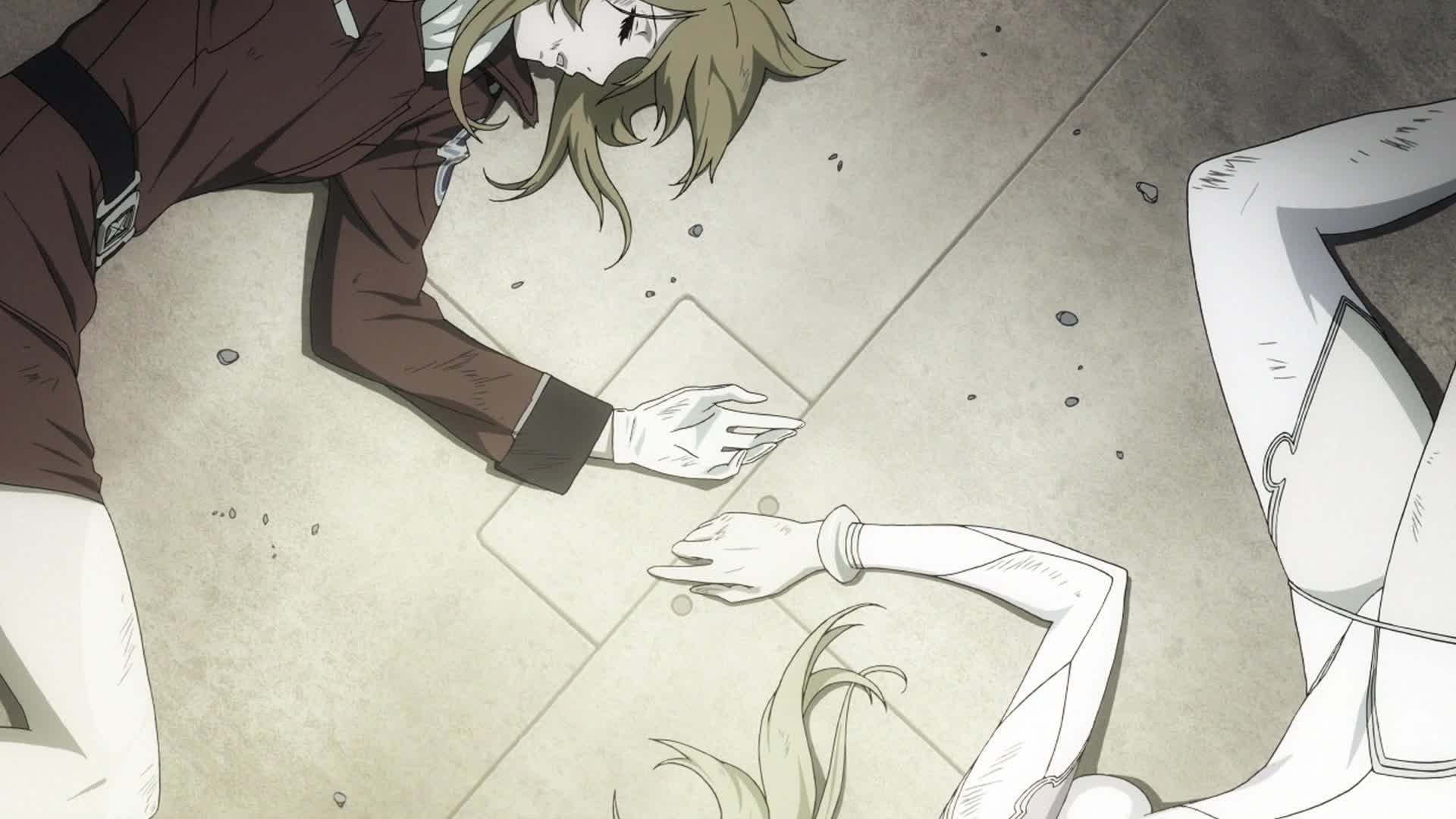
We flash back to that fateful day. We see a plume of black smoke rising from a burning car, overturned in the middle of a road. Lying unconscious next to it are Yuki and Yurisha. Sanada’s voice-over explains that no one knows if it was just an accident or a terrorist act. Yuki recovered from her injuries but lost her memory, while Yurisha lapsed into a coma. They did all they could for her, but she never woke up.
[DG]: They’re attempting to provide some closure on the Yuki/Yurisha identity crisis here, but to me Yuki’s origins were never beyond any shadow of a doubt.
An interesting question would be why terrorists would (a) know about Yurisha’s presence and (b) make an attack on her?
[LC]: I’m satisfied with this answer. We haven’t been told a lot about her past, but that’s nothing new. Did we know anything about her past in the original? Nope. We knew basically the same as we know here, the difference being that her parents were alive in the original and here they’re dead. It’s just that the information about her has been put into question by Ito for plot convenience. Now we have a credible character telling it like it was. Why would you not believe Sanada?! And even if you don’t… look, they’re right there, lying next to each other!
As for your questions about the terrorists, it’s never stated that it was an attack on HER. We’ve seen mentions of these attacks in other episodes, fruit of a society on the brink of desperation. In fact, it’s not even clear if it was an attack or just an unfortunate accident. But even if it was, it could be “just another” attack. I doubt anyone outside a very strict UNCF circle would know of her presence. And even if they did, why attack the last hope for mankind? Personally, I go with the good old “wrong place, wrong time” trope. That and the fact that they needed to fuel this useless sub plot.
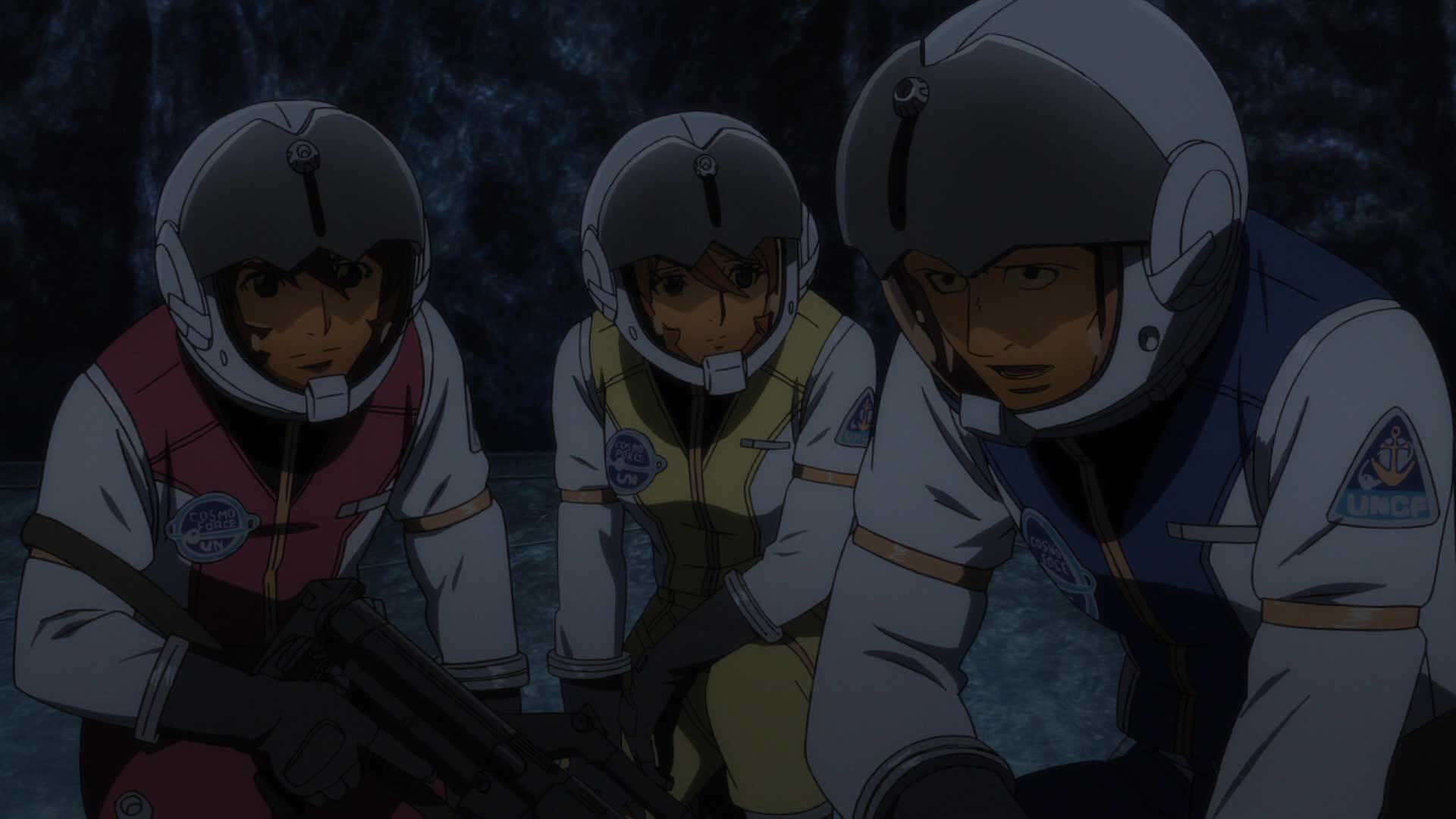
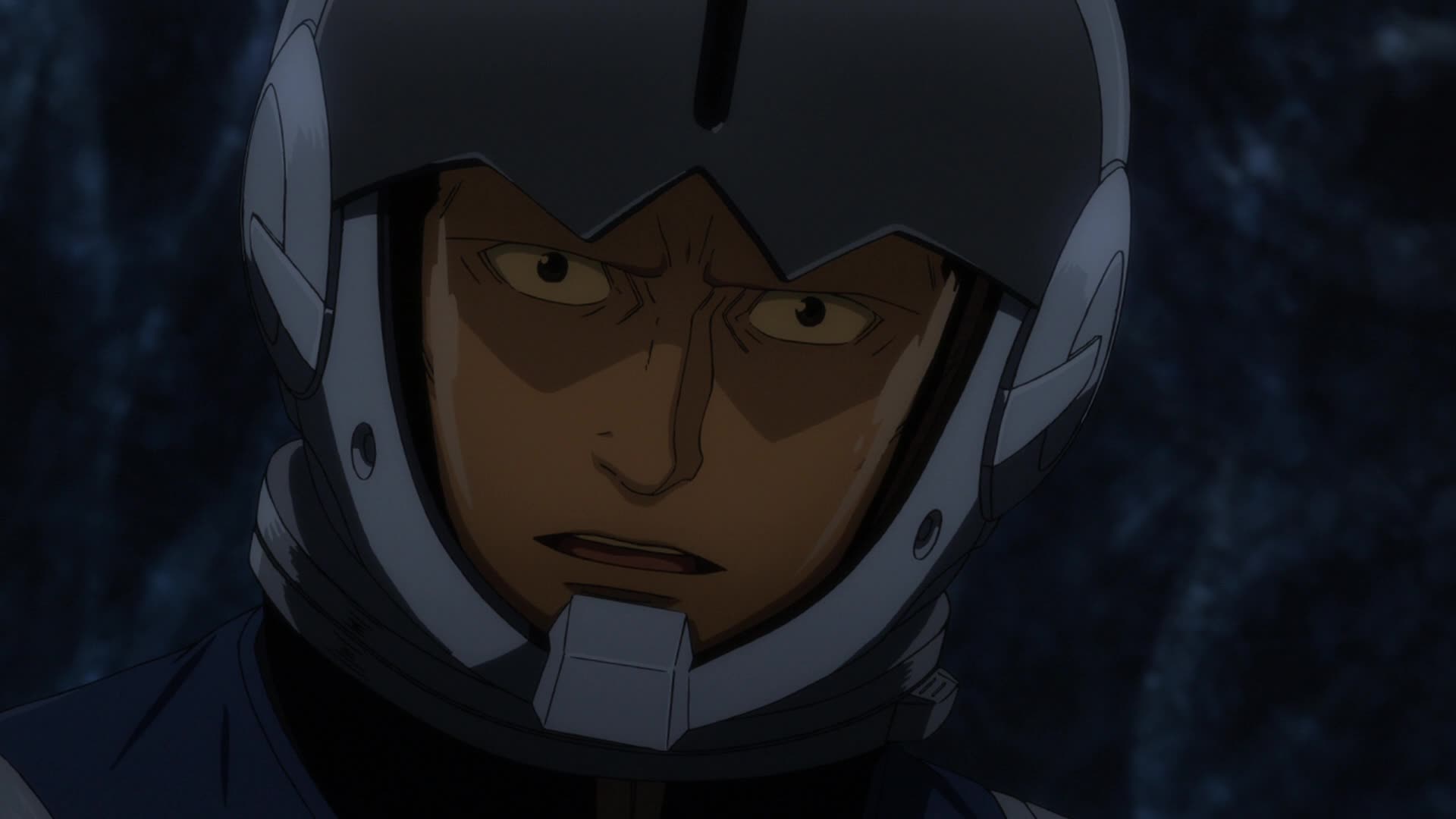
Kodai asks this was never spoken of before, and Sanada reveals a terrible truth: they still don’t know where Iscandar is located in the Large Magellanic Cloud. Confused, Yuki says they have the maps Iscandar sent and Kodai concurs, saying that data was entered into the Automatic Navigation System. To both officer’s surprise, Sanada reveals that the location doesn’t exist in the data. Yurisha was meant to show them the path. Kodai asks how then have they gotten this far. Sanada explains that they have followed Yurisha’s memories.
[LC]: This justification for having her hooked up to the Automatic Navigation System makes some degree of sense. What doesn’t is the lead up to it. Why provide a super detailed map of space if the most relevant piece of information required is not in it?! My personal wibbly-wobbly rationale derives from what we’ll learn in the next few episodes.
We learn that Yurisha was meant to observe the humans and their actions. One of the points of having them make the long journey to Iscandar was to assess their “worthiness.” It might seem like a petulant attitude, but given what we learn about Iscandar’s past, judging how the humans use technology and overcome terrible odds doesn’t seem that unreasonable. We may then assume that if they were deemed unworthy of salvation, Yurisha would be in a position to deny them the final piece of the puzzle, spelling certain doom for Earth.
Unfortunately, this accident left Earth without that piece of the puzzle from the very start, with no other way to get it than to use Yurisha as a component of the ship. I do wonder, where did they get the technology to “see” into a quasi-goddess’ memories?! Seems a bit advanced for Earth. But hey, plot advancement. It’s also interesting that this particular plot element echoes that of the original Yamato novelization, in which the location of Iscandar was also missing due to Sasha’s death.
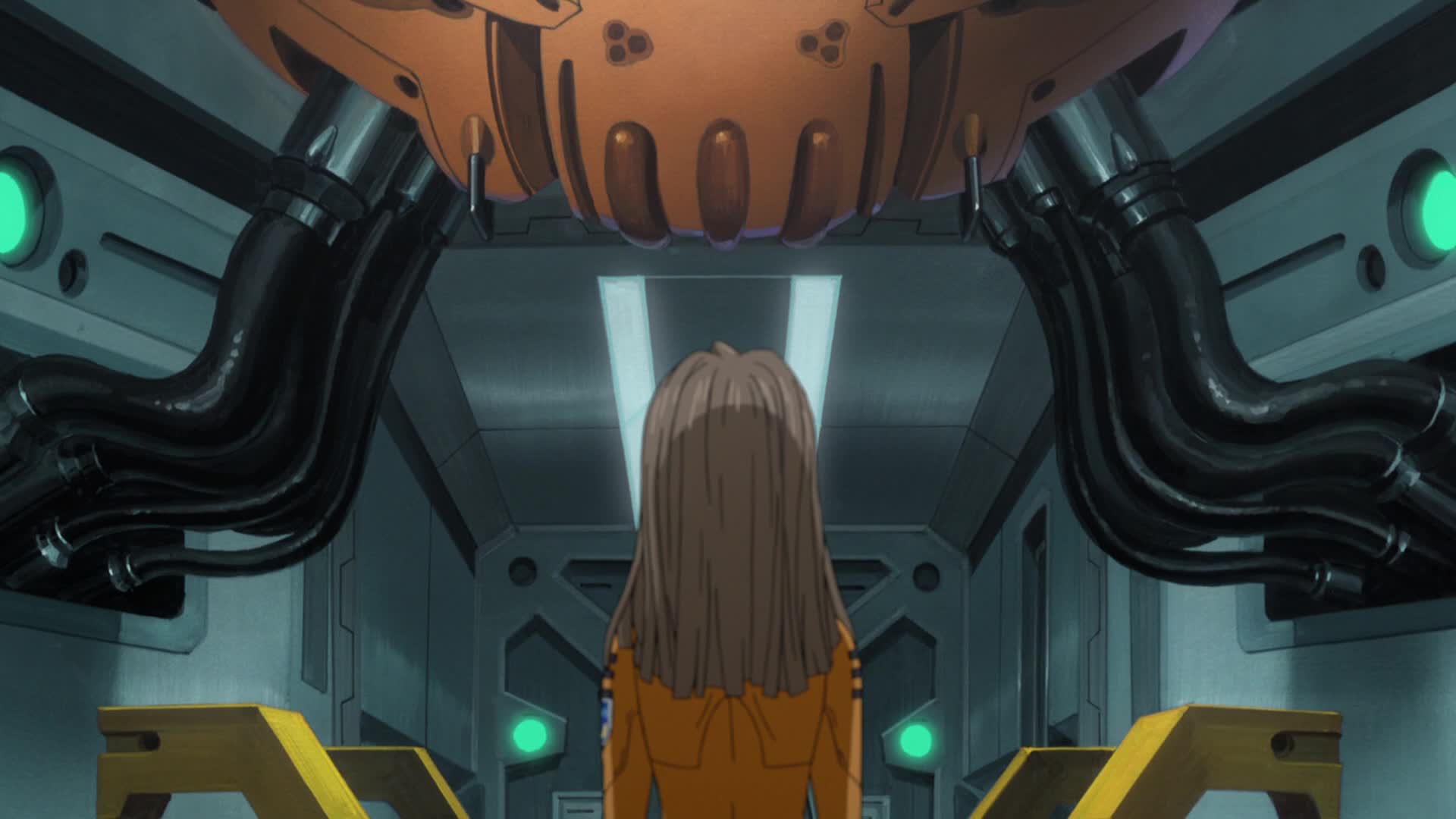
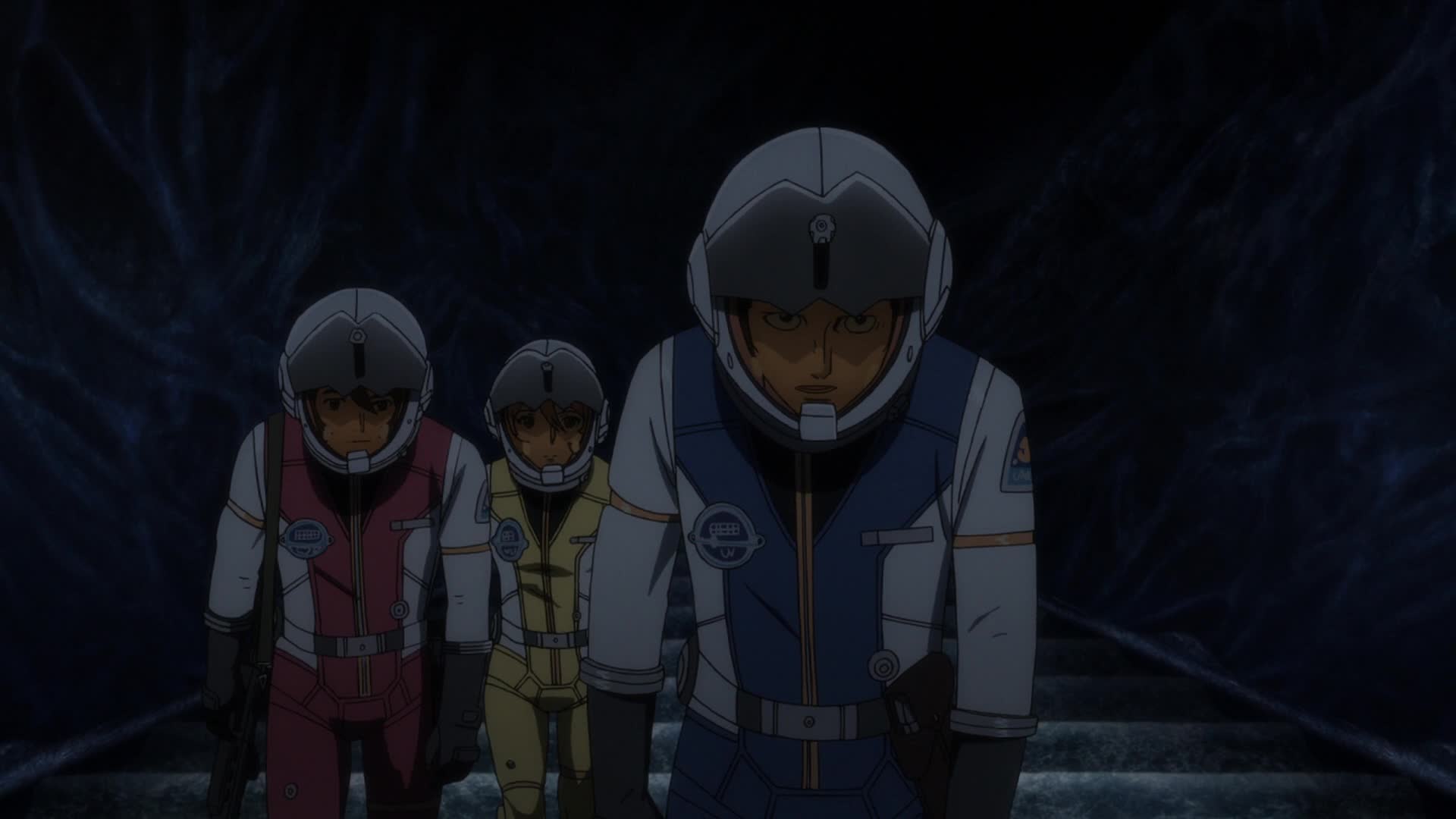
They realize the truth now confirmed by Sanada. Yurisha IS the core of the ship’s Automatic Navigation System. Aboard Yamato, Yuri(sh)a looks up at the hatch of the room containing the now less-mysterious capsule. Back at the satellite, Sanada continues with the revelations as the group walks up a long staircase. He explains that they’ve been searching for Iscandar by tracing Yurisha’s memories. He knows what they did is ethically wrong and they’ll have to take responsibility for that. Returning her home safely is also part of Yamato’s mission.
[LC]: Sure you have to take her home. She’s the only one who knows where home is. This does raise an important question; if she was indeed meant to go along on Yamato’s journey, what happened to her ship? Is it stowed somewhere back on Earth? Doubt she would just leave it behind, had she been conscious to have a say. Most likely it landed in the same way the other two we’ve seen so far. With a bang. Really, has any Iscandarian ship landed safely, anywhere? XD
[DG]: In my mind, there are three possibilities: (1) It crashed like Sheherazade did; (2) Whether (1) happened or not, it was cannibalized into parts for Yamato – the ship has a huge surface area (it is larger than Yamato going by the revised length in the Garmillas Design Works book), and they could have used its hull as the basis for Yamato‘s armor plating, then used, reverse-engineered, or simply broken up the remainder for parts and materials; (3) It’s stored in a hangar somewhere deep in the Fuji Base.
Going by your point that Yurisha would have accompanied Yamato as an observer if not for the accident, and the lack of resources making it unlikely that raw materials were still being mined, I lean toward Yamato being partially cannibalized from Yurisha’s ship – especially since the armor plating stood up to Garmillas warship cannons better than the Earth fleet.
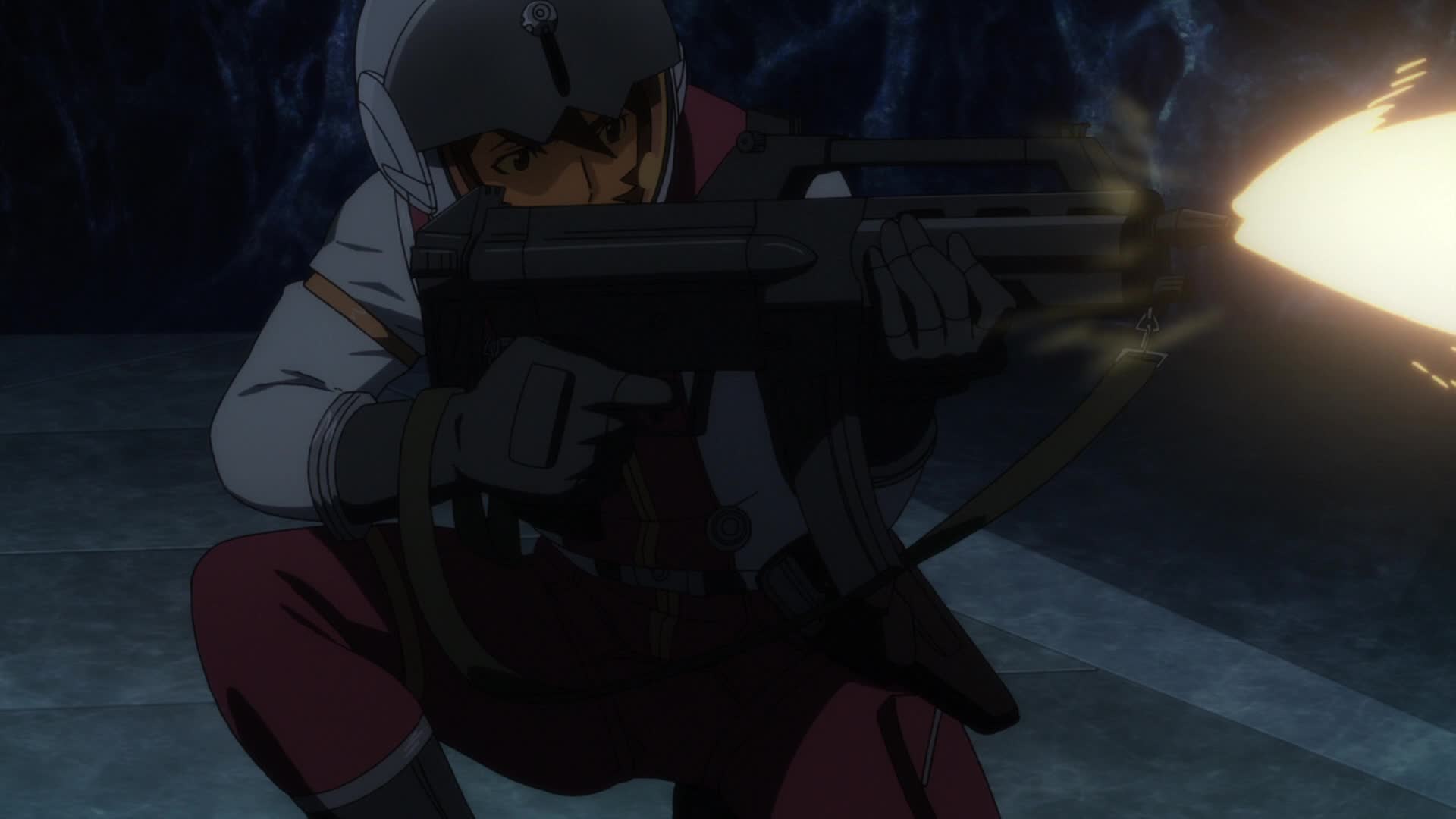
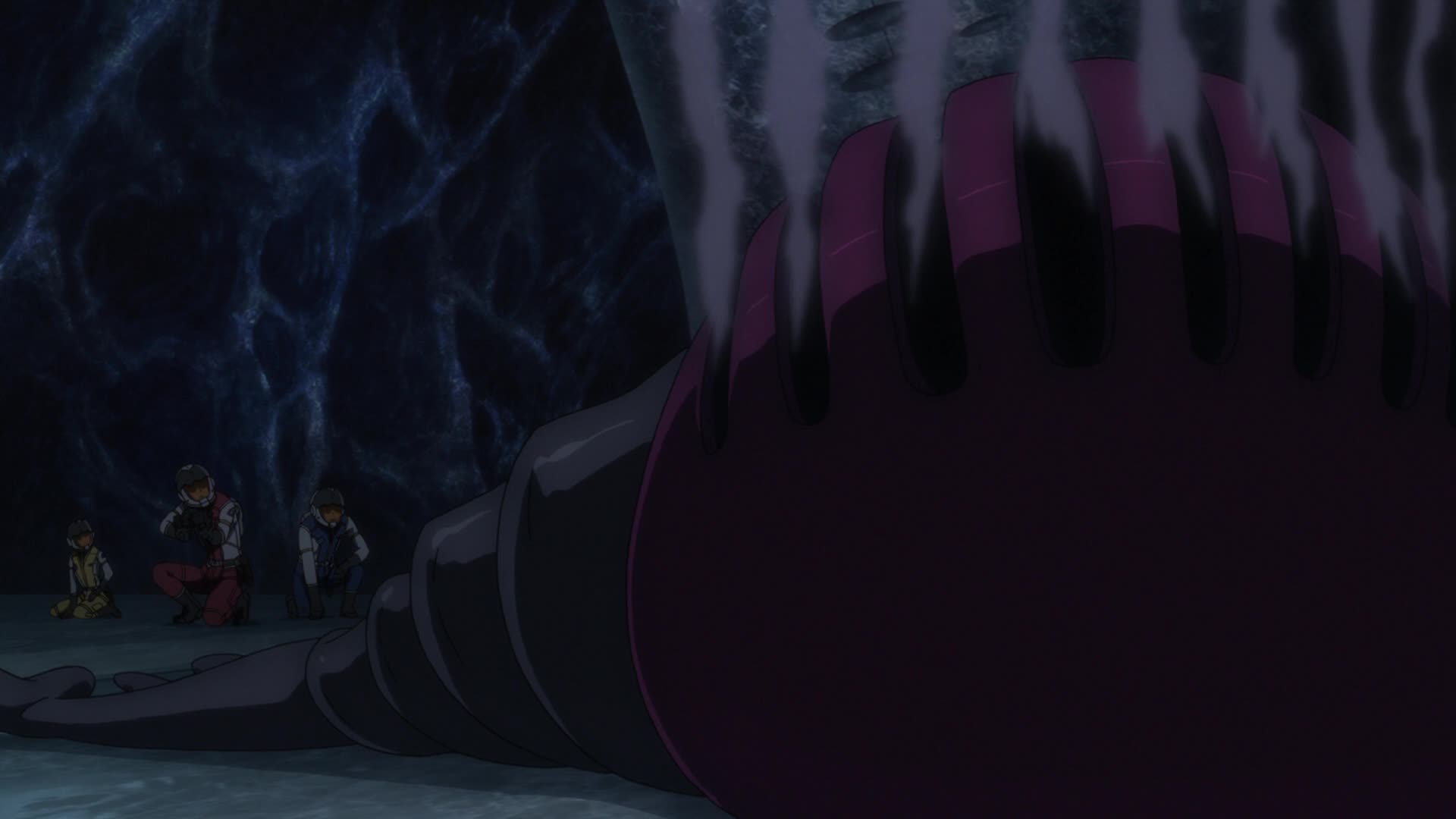
Yuki then wonders why she had the capsule with her. Sanada is about to tell her when Kodai pushes him aside, just in time to escape a shot from a guard robot. Kodai returns fire and puts it out of commission.
[DG]: Arrrgh!!! To me, this is the most important part of the whole Yuki/Yurisha storyline – why does Yuki have the message capsule? This is something that is not resolved even at the end of the series – and I can’t help but think it’s being saved for a future story.
[LC]: Yeah, I’m with you on this one. Most aggravating moment in the entire series. Yes, Daniel… even more than the missing thing in Episode 20 (move along). Made even more aggravating by the fact they never address this again!
We can assume what we saw in Episode 14 did actually take place, but before the accident. Maybe Yurisha gave her the capsule as a friendly offer to a new friend. Maybe it was given to Yuki in her role as liaison to relay Starsha’s message to the UNCF’s command, then Yurisha just let her keep it. After a couple of episodes with the bubbly Iscandarian prancing around, I could totally see her doing that. But it’s quite annoying that they answer so much in a single episode and leave this one little thread dangling.
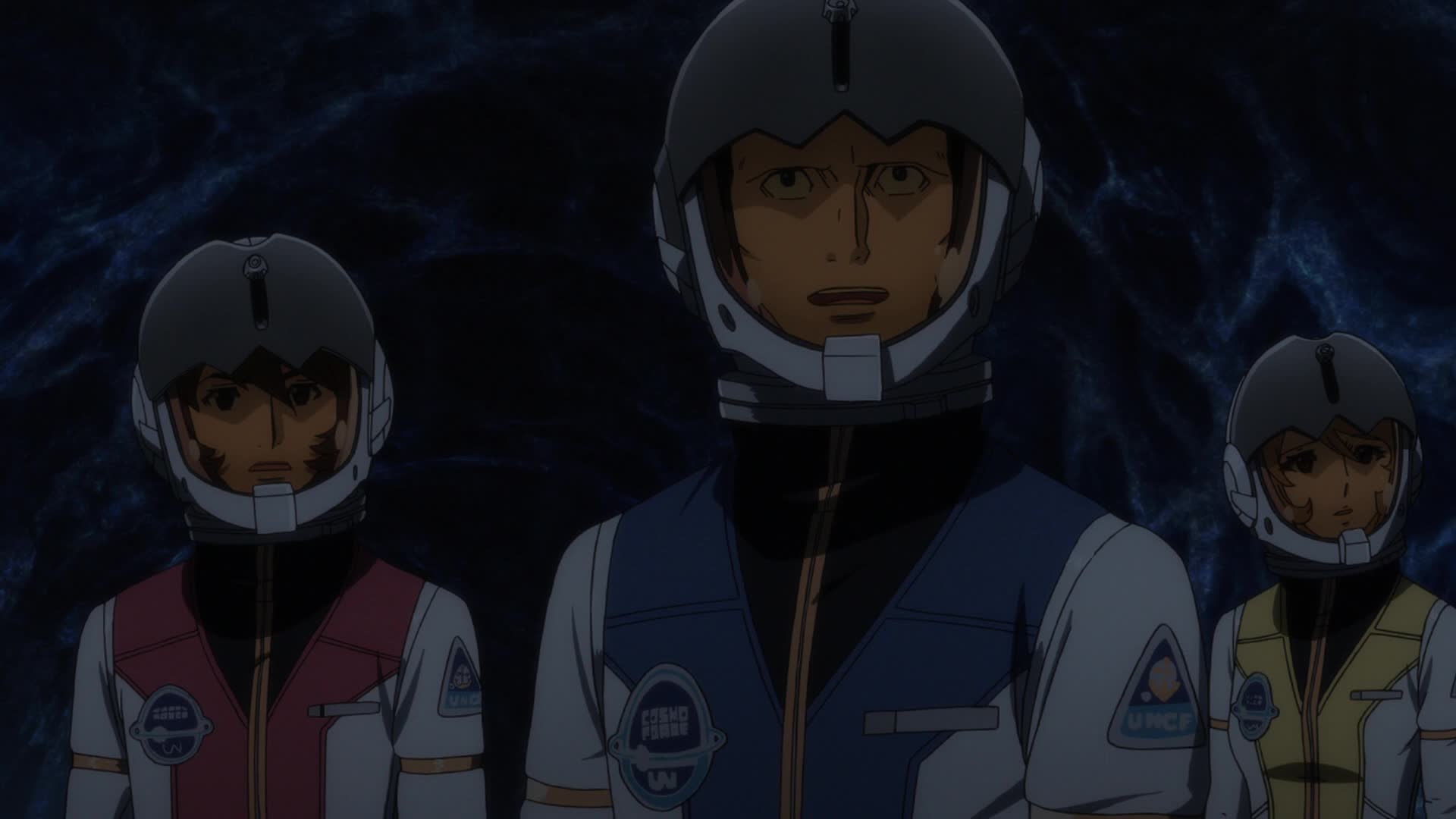
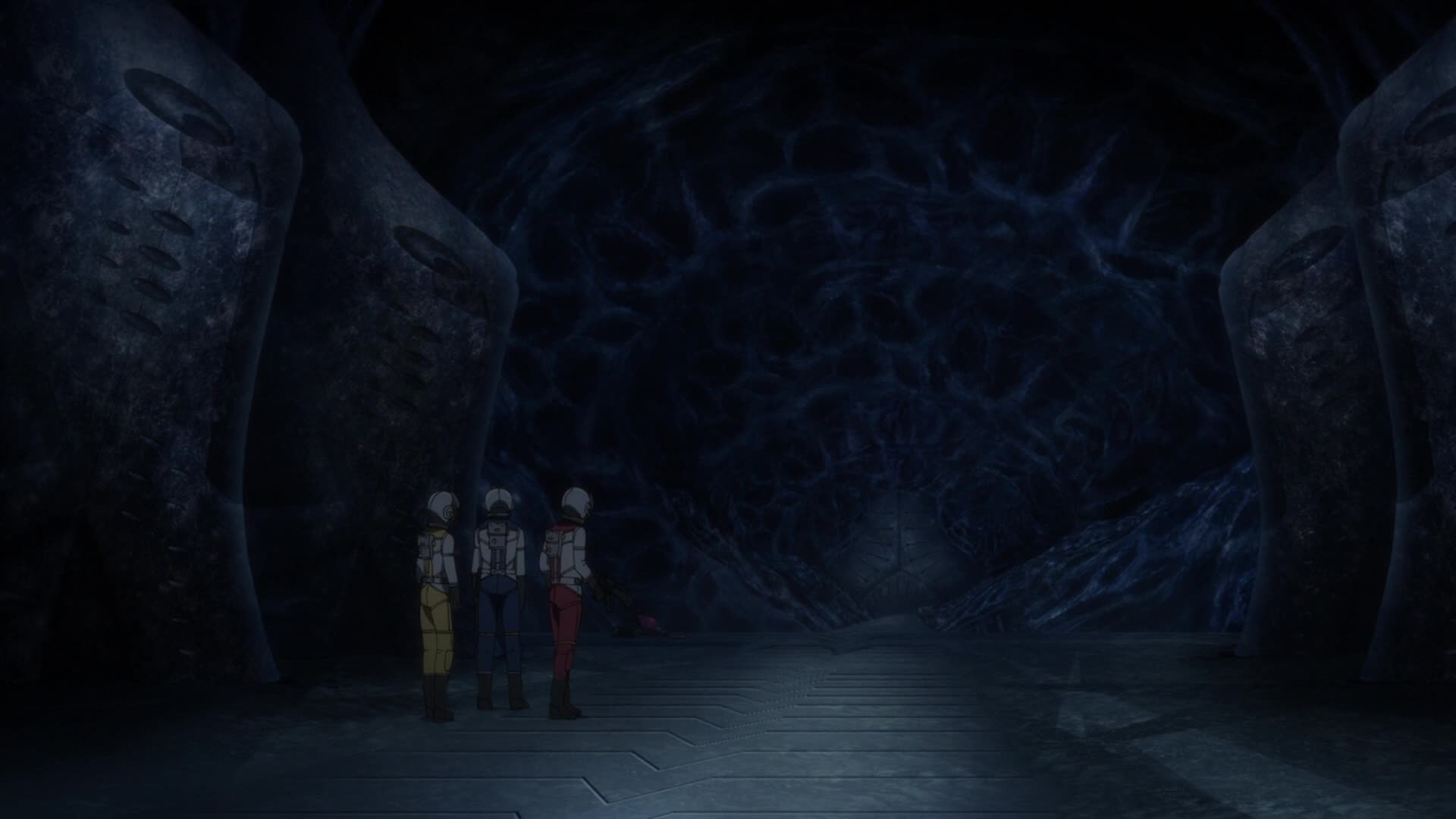
Sanada commends Kodai for a job well done and tells them they have reached their goal, the satellite’s control area. They look up at the enormous door as the satellite pulses around them, waiting…
[LC]: Curiously, in the original, it’s Kodai who gets distracted and pushed out of the way by Sanada. Nice role-reversal.
Break for commercial. This episode takes the prize for having longest first act, clocking at nearly 2/3 of the total episode time. Episode 11 is second by a couple of minutes.
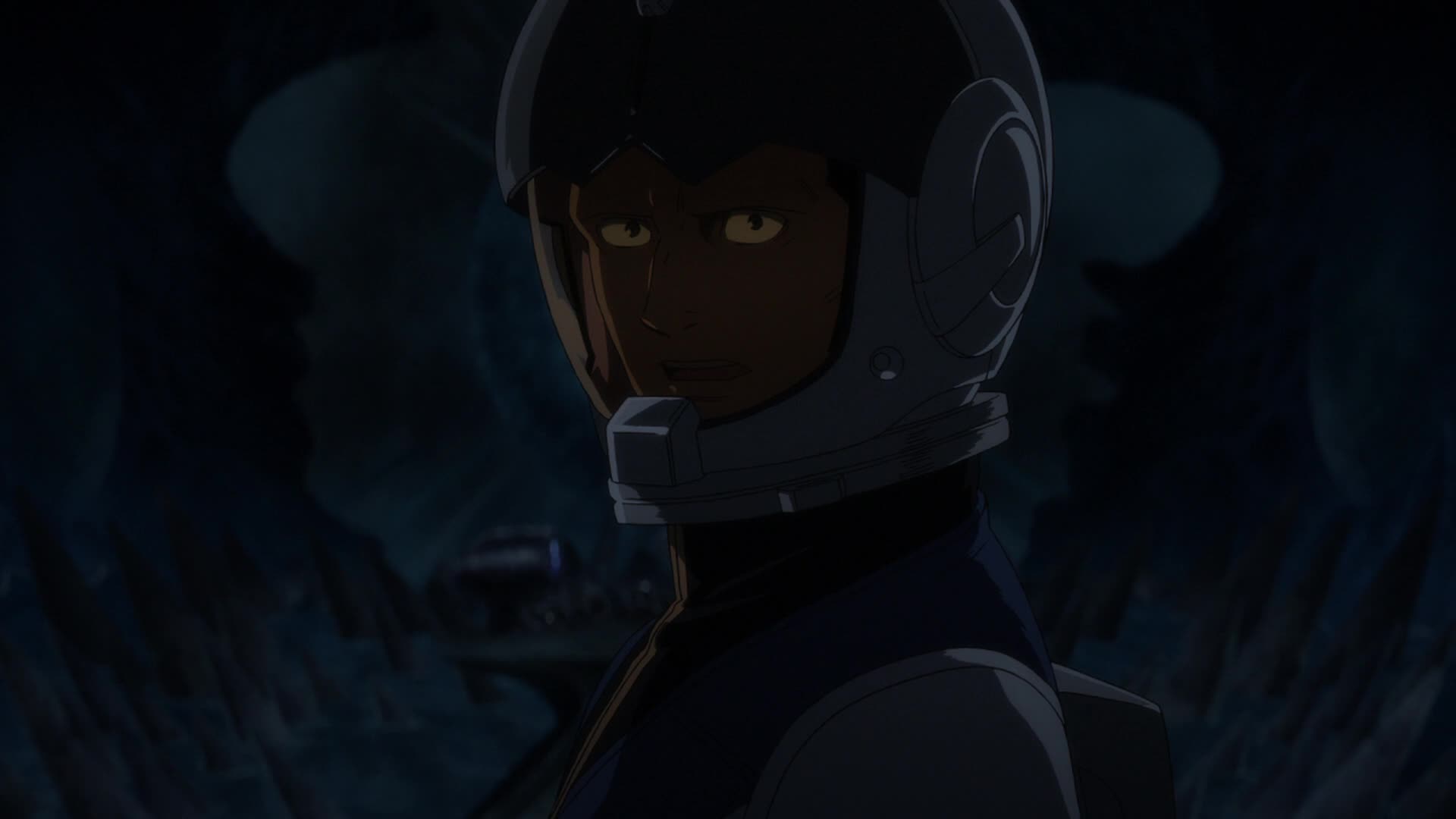
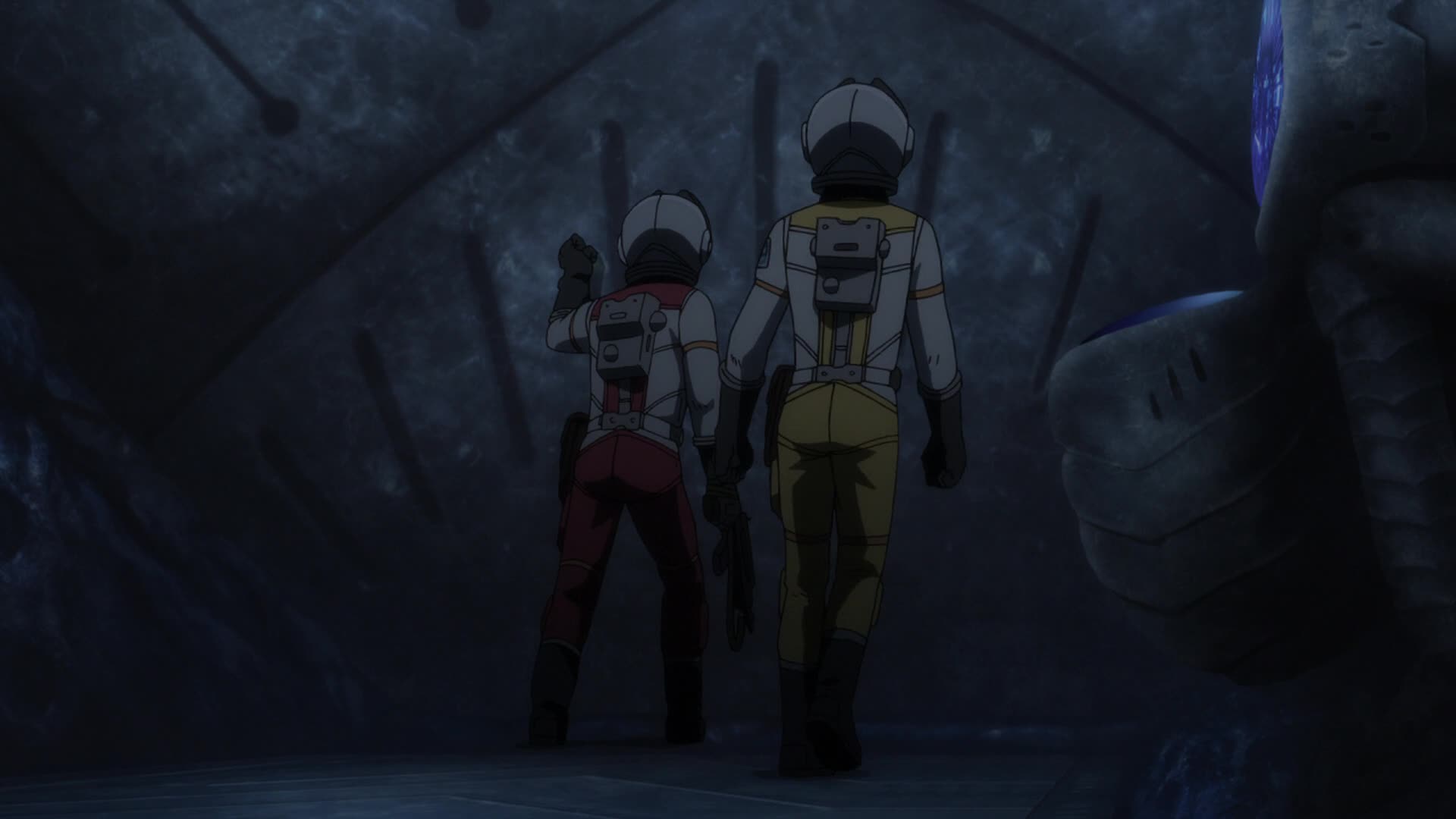
Sanada works the controls and his pad to unlock the door. Eventually he succeeds, and the door opens to reveal a large chamber overlooking the massive satellite core outside. He tells Kodai and Yuki to wait there as he works the controls inside. As he steps into the control room, a panel near Yuki shows some sort of reaction. She tries to warn Sanada but it’s too late – the door closes, separating them from the XO. Kodai bangs on the door, calling to Sanada.
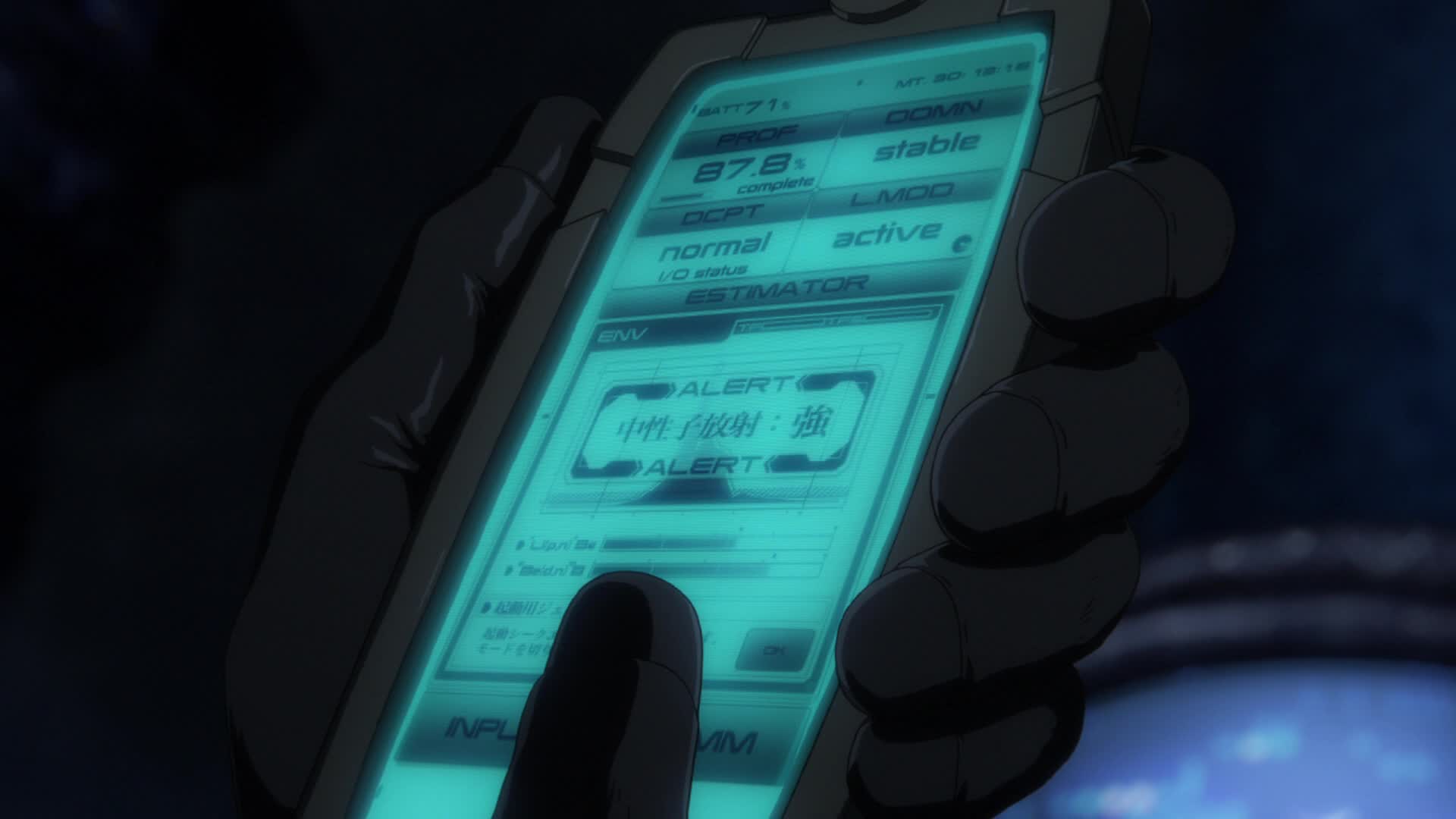
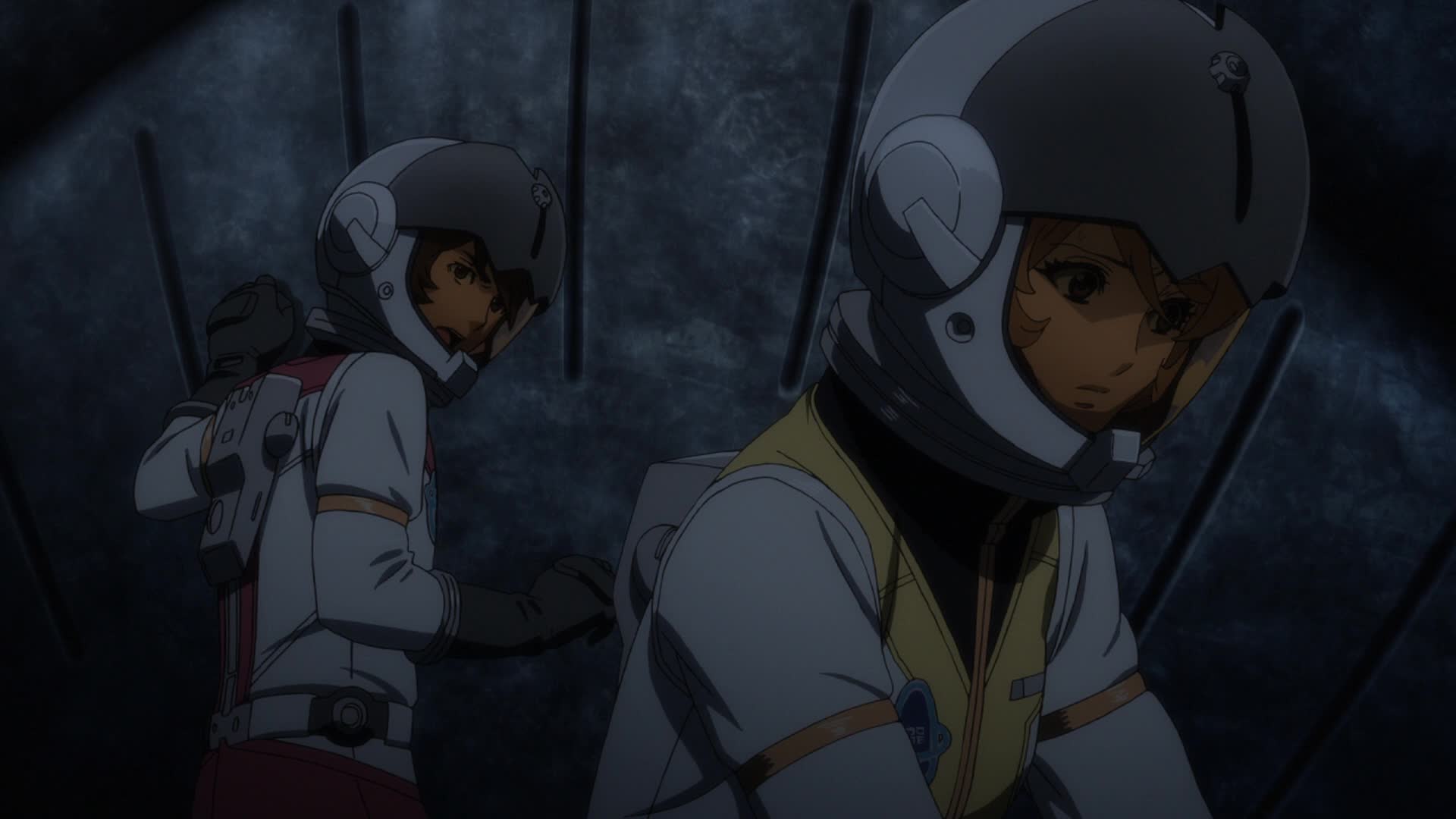
Inside, Sanada accesses the main panel, attempting to unlock the door. He confirms that if they restart the satellite, they’ll be able to open the subspace gate. But his joy is short-lived as a warning appears on the screen. After a moment he makes a decision, locking the door from the inside. Yuki realizes this as Sanada calls Kodai on the comm-link.
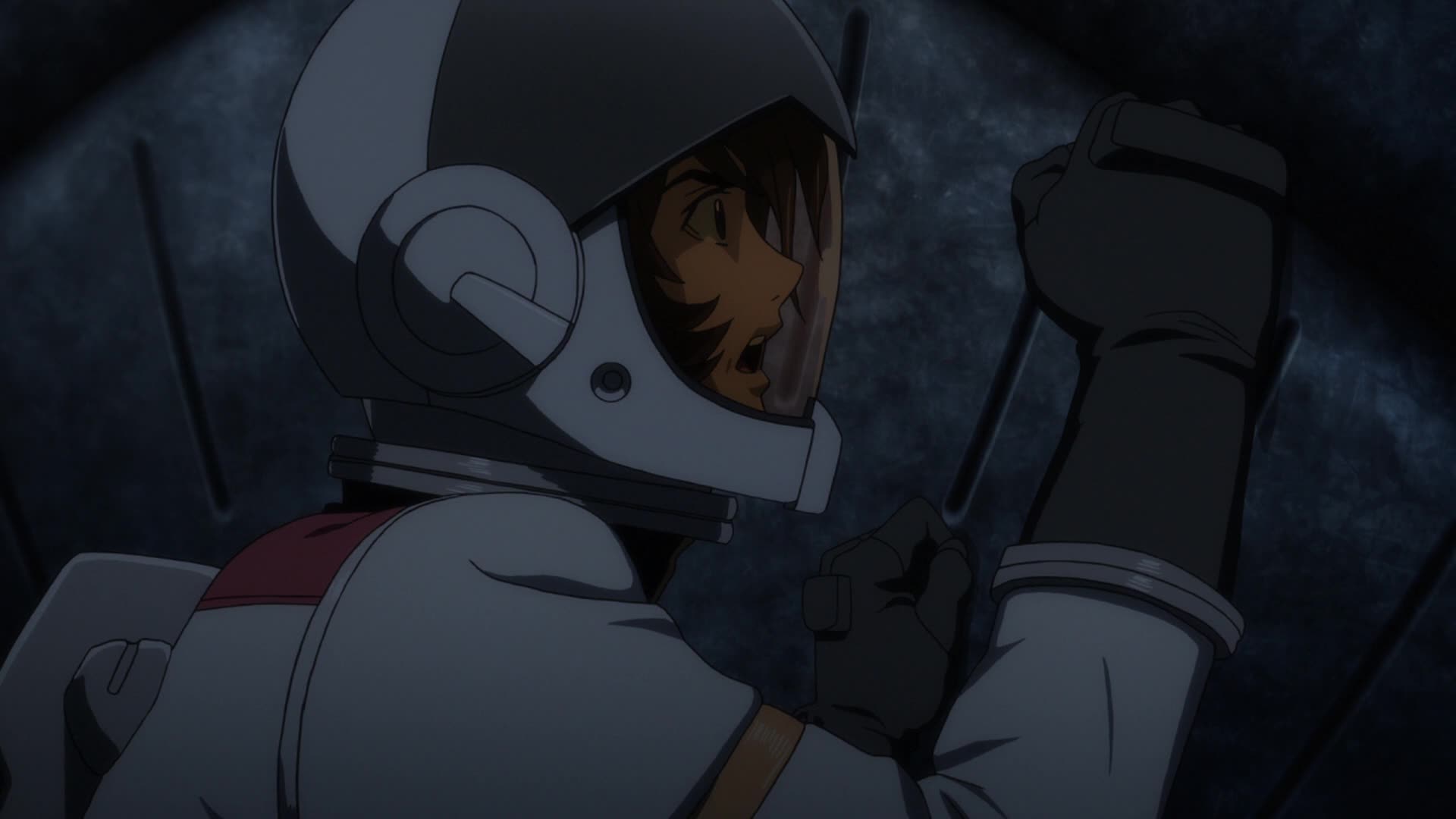
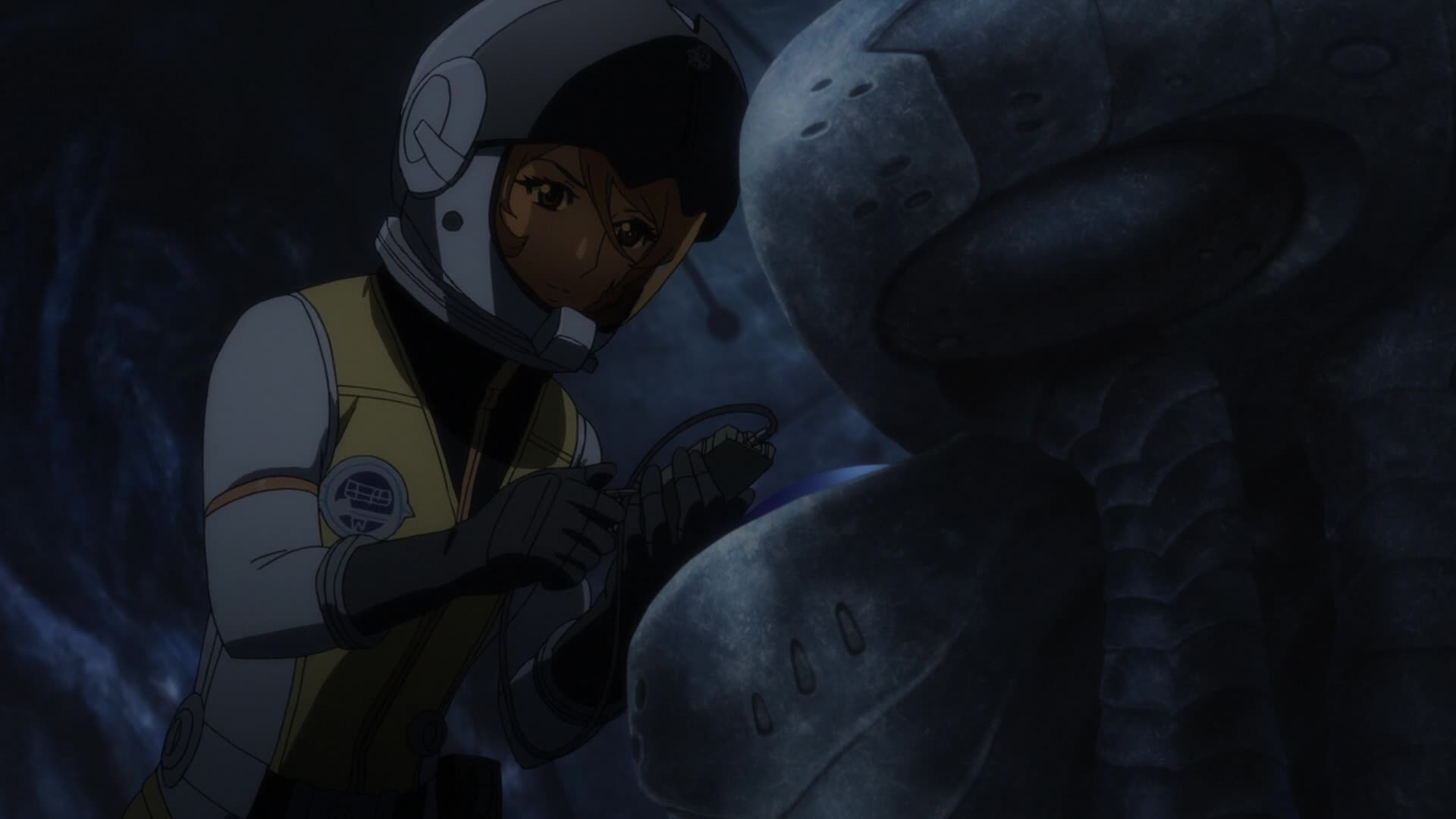
He explains that restarting the system will cause a massive neutron burst. Kodai and Yuki are in a shielded corridor, so they’ll be safe. Kodai has another sudden realization, asking Sanada if the control room is shielded too. Sanada’s silence is answer enough. Banging on the door, Kodai asks what he thinks he’s doing and Yuki asks him to stop. Increasingly desperate, Kodai begs him not to do it. Yuki tries to hack the outer panel to undo the lock.
[LC]: OK, someone explain this one to me. Kodai and Yuki will be fine because the corridor they’re in is shielded against radiation. Fine. But why is the corridor shielded and not the control room itself? I assume this neutron burst occurs whenever you have to restart the core. The core is restarted from that control room. So… why isn’t it shielded? Do they just send some expendable guy in, seal the door and let the guy die, every time a core has to be restarted?! “Dr. Slotin, report to the core activation room.” XD
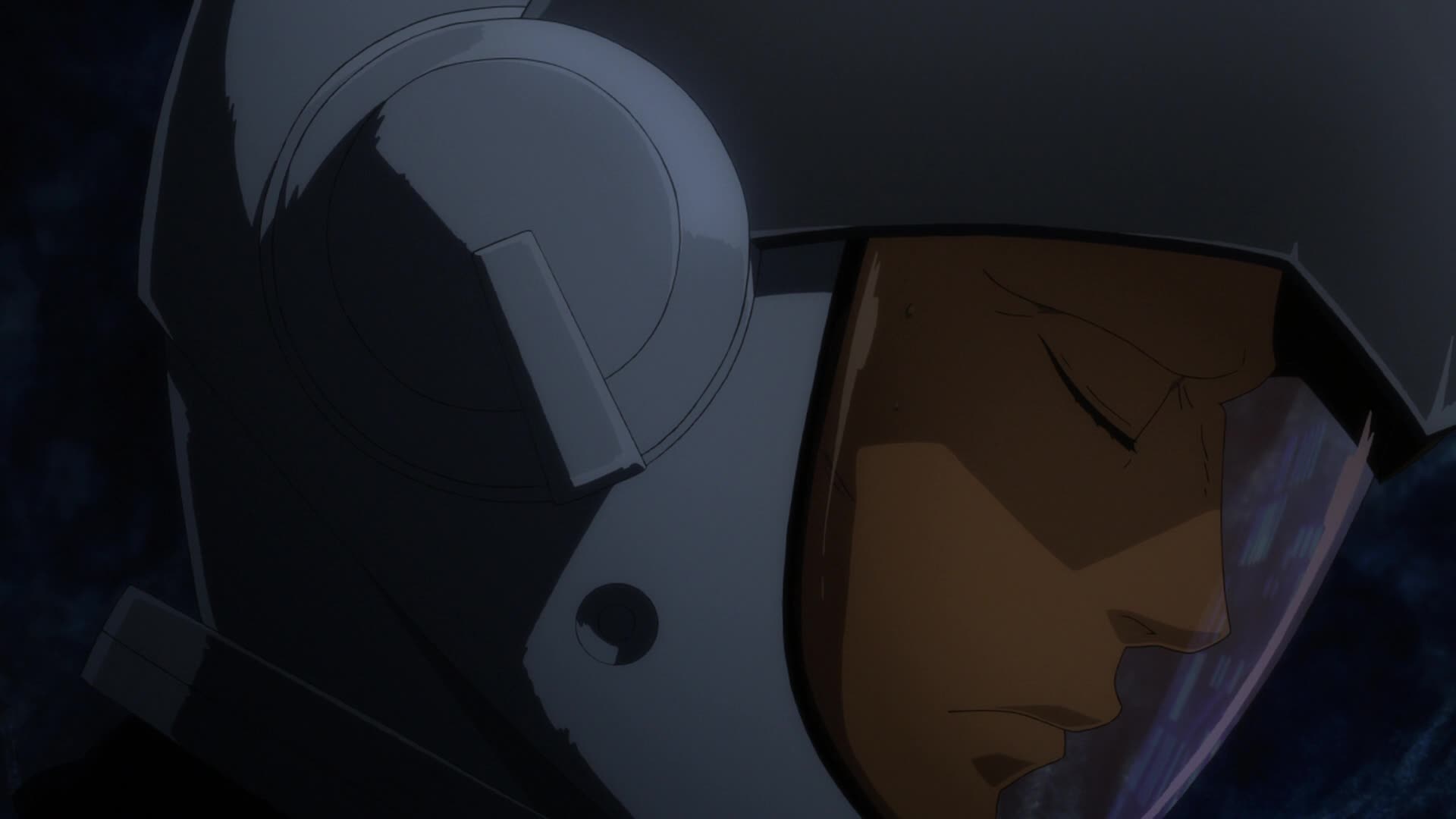
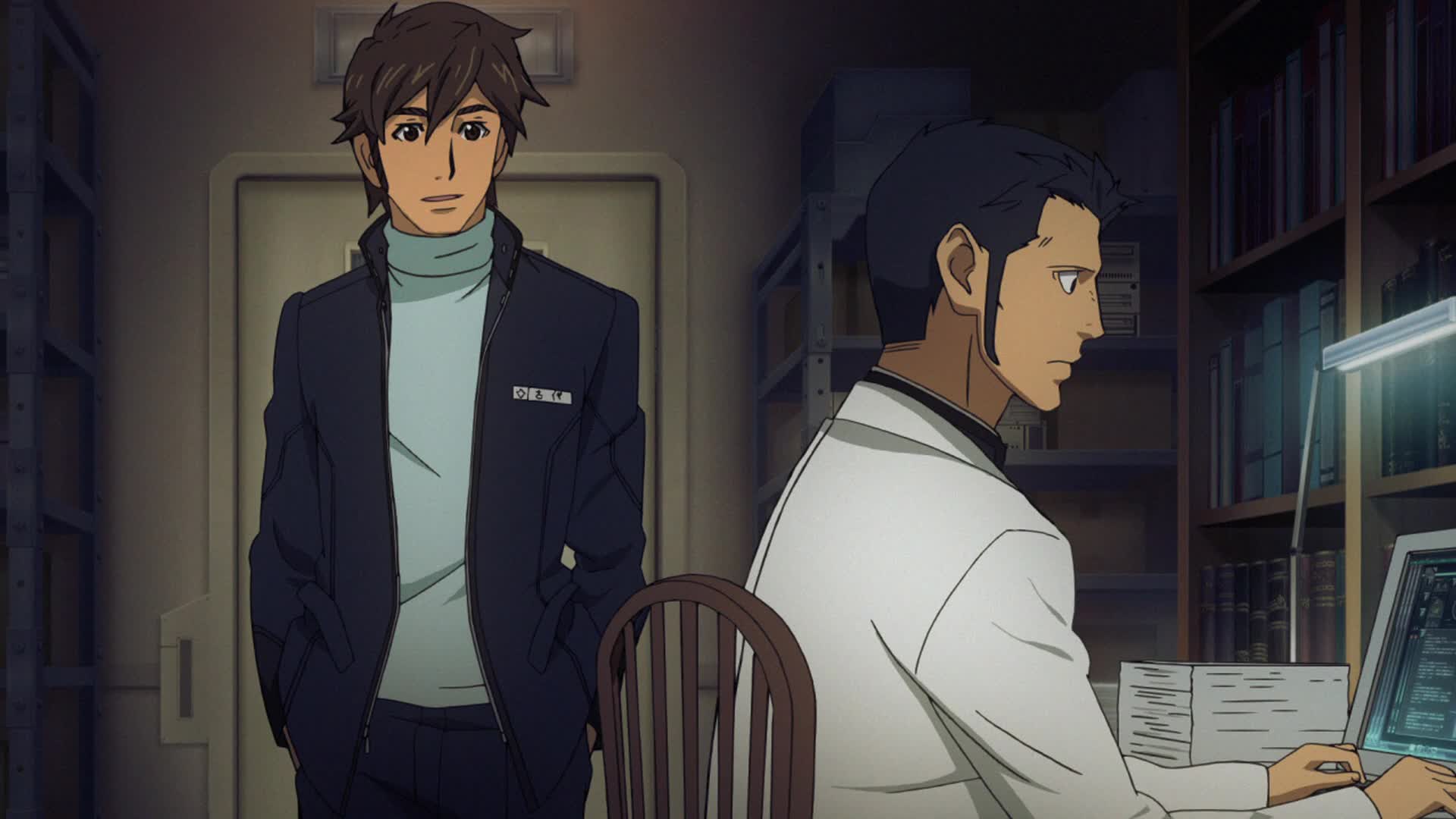
Inside, Sanada hears Kodai’s desperate pleas for him to open the door. He reveals to Kodai the name of his friend, the one who liked Chuya Nakahara: Mamoru Kodai. Kodai is in shock as Sanada tells him Mamoru was his best friend. We flashback to 2193. Mamoru enters Sanada’s office at the academy. Sanada tells him Niimi is not there. Mamoru tells him another meteorite has fallen, this time on Rio de Janeiro.
[LC]: Though we’ve seen Mamoru in the previous scenes, remember those were Niimi and Sanada’s memories. When they talked earlier, Mamoru’s name was not spoken. So this is an actual revelation as far as Kodai is concerned.
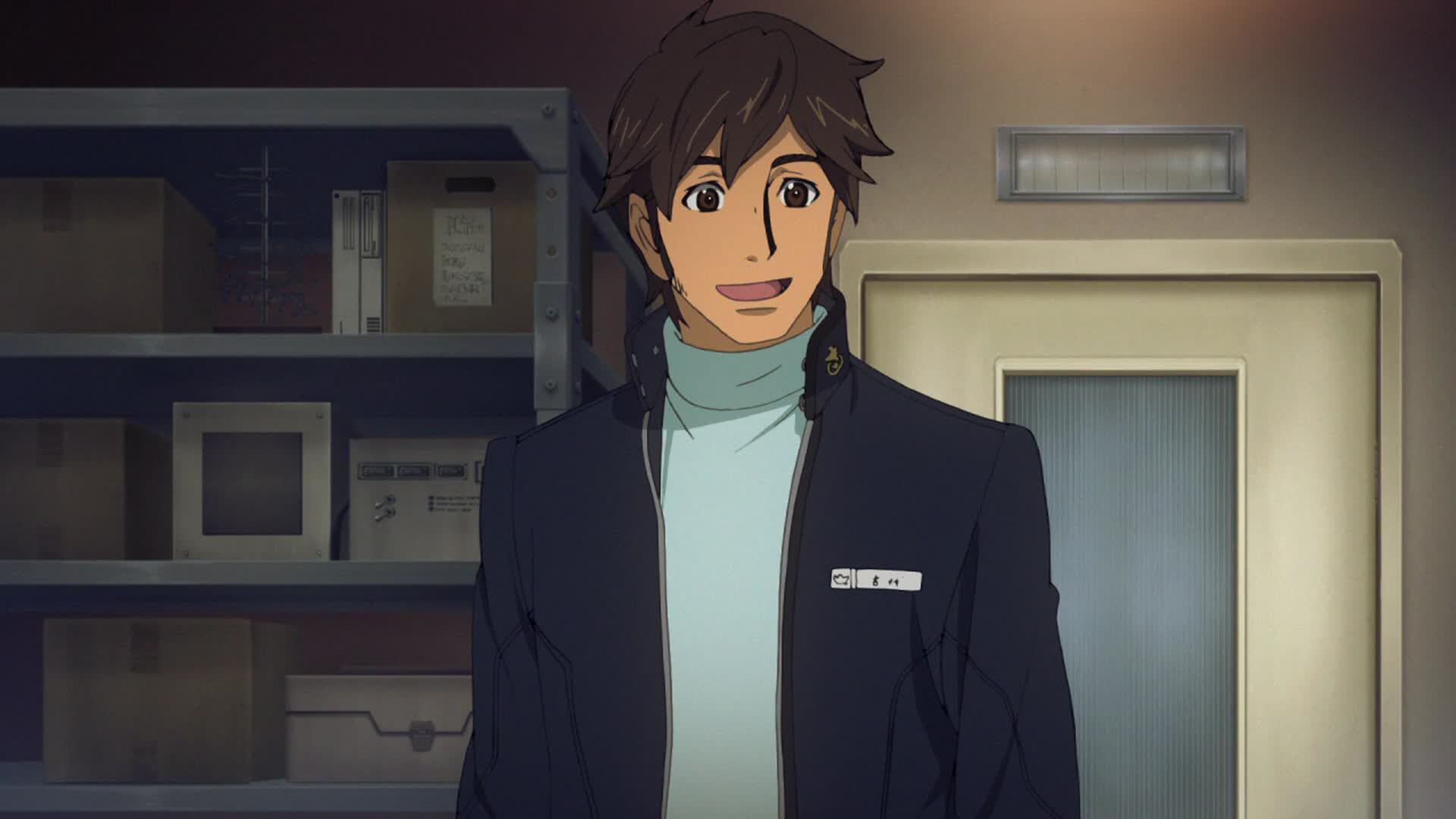
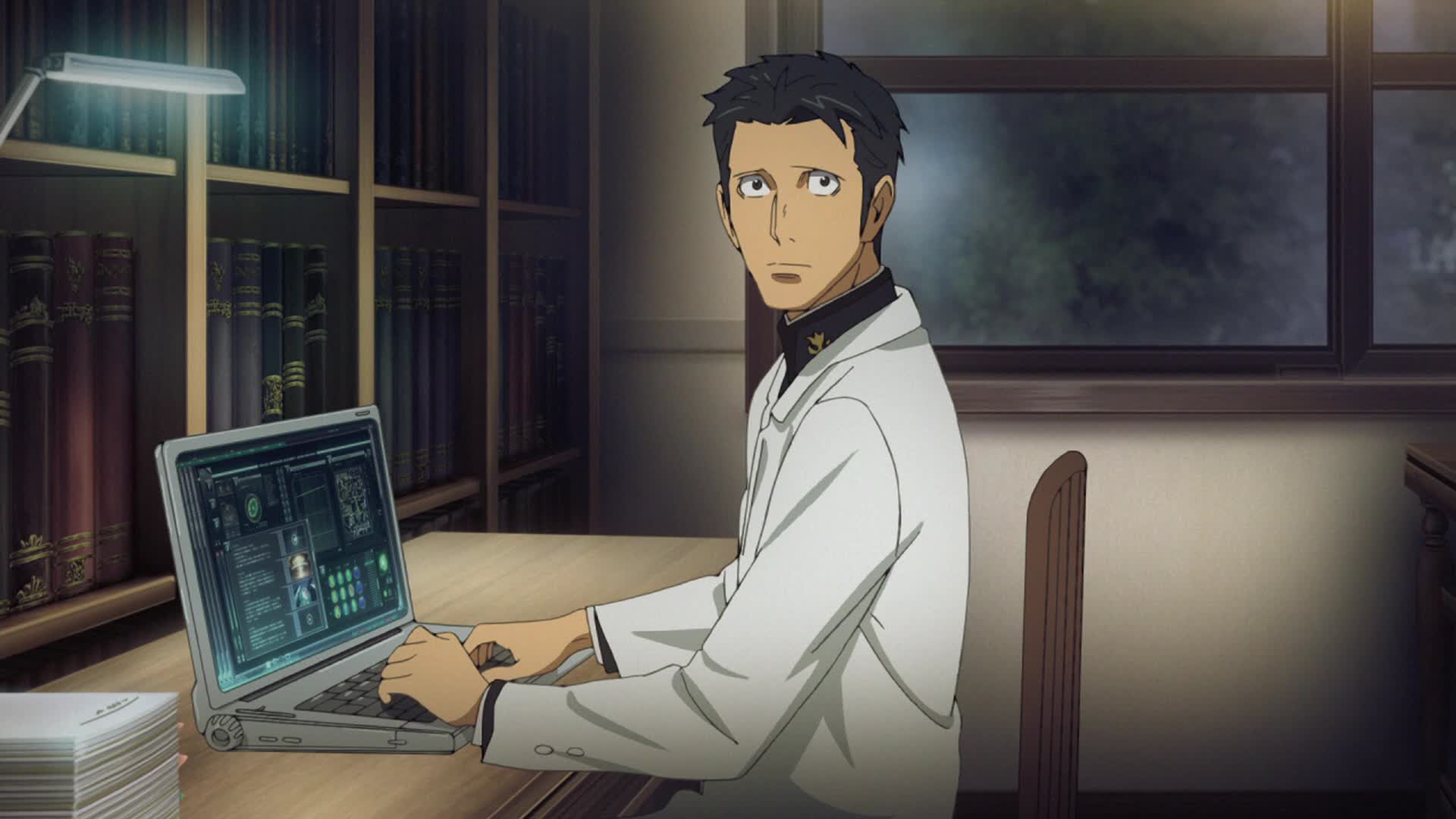
Sanada says they’re clearly being sent by the enemy, showing the aliens have changed their strategy. Mamoru pauses, then asks Sanada if he wants to go out and get some air, much to his friends’s surprise.
[DG]: Sanada’s response to Mamoru’s news that another meteorite has struck, this time in Rio, suggests that this is only the second or third time one has struck a city, meaning that the Second Battle of Mars takes place sometime in 2193.
The subtitles indicate this scene takes place in 2193. As Sanada and Mamoru go outside, the trees are still green but snow is starting to fall, suggesting it’s late 2193. Since they’re unlikely to be in the northern region, this is consistent with mid-late December.
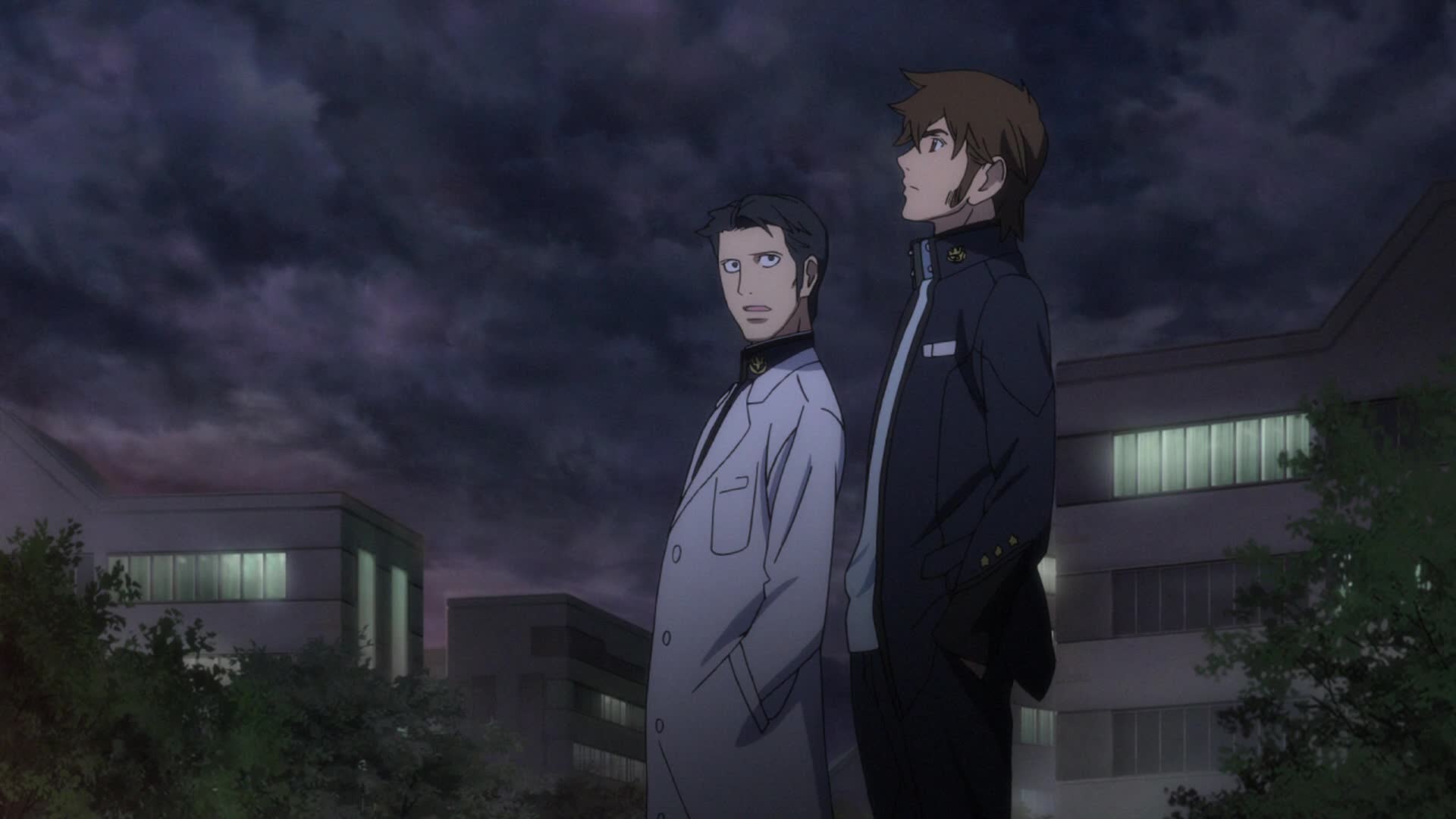
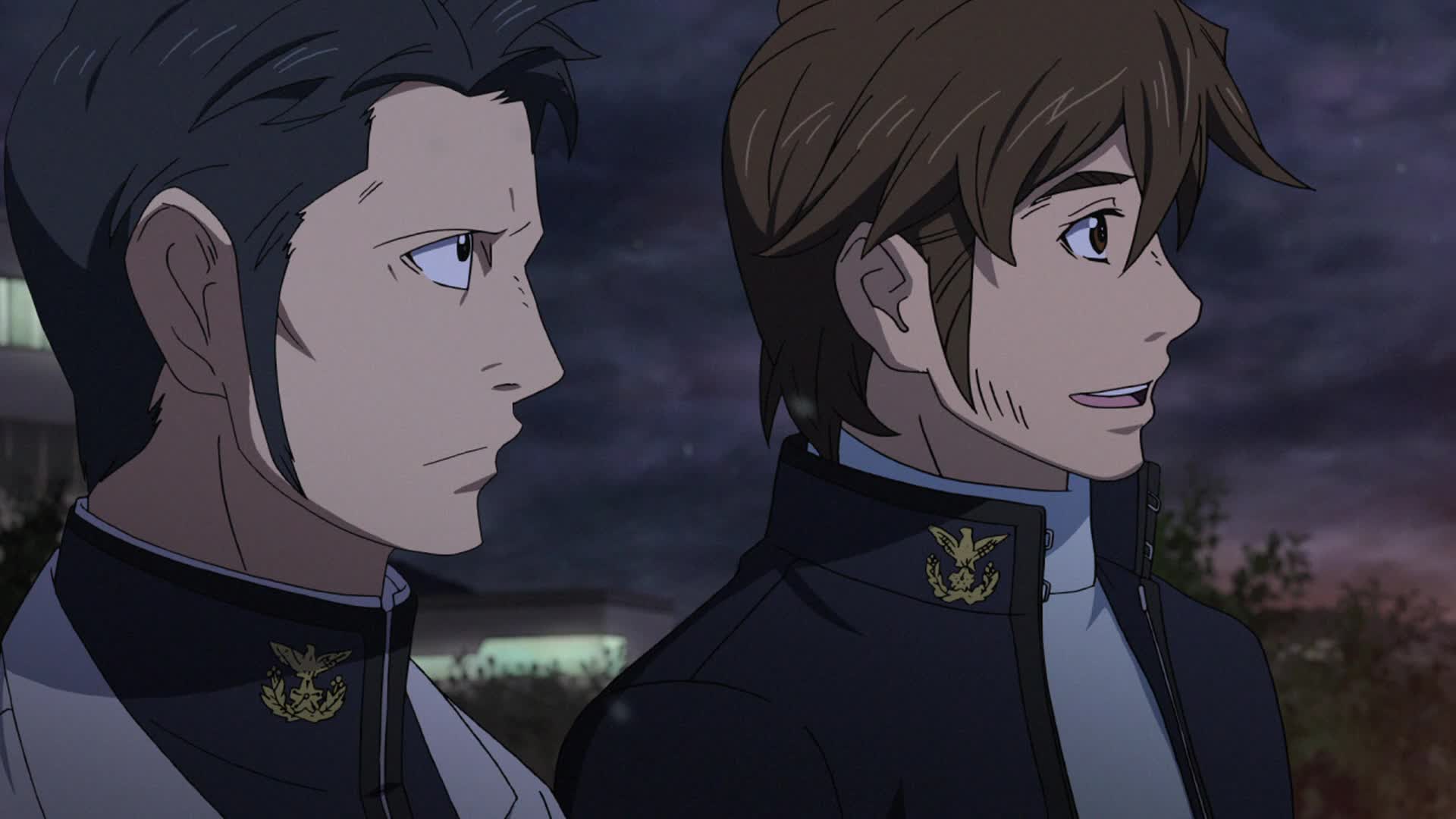
We see them standing in the academy’s grounds, the sky above them darkened as a result of the meteor strikes. Mamoru says the sky looks terrible and Sanada replies that there may be a nuclear winter. He asks Mamoru if he’s joining the Cosmo Navy after he graduates. Mamoru confirms this and asks Sanada what he’ll do. Sanada says he’s not cut for the military but there must be something he can do. Mamoru is confident he’ll find something. Something he couldn’t do in a million years. The snow starts falling around them.
[LC]: This leads back to what I said earlier. If Mamoru will only join the Cosmo Navy after he graduates, he couldn’t have been aboard Kirishima on Operation K2, which took place in the time span between the two flashbacks.
[DG]: For me, that’s not a minor inconsistency, it’s a significant one.
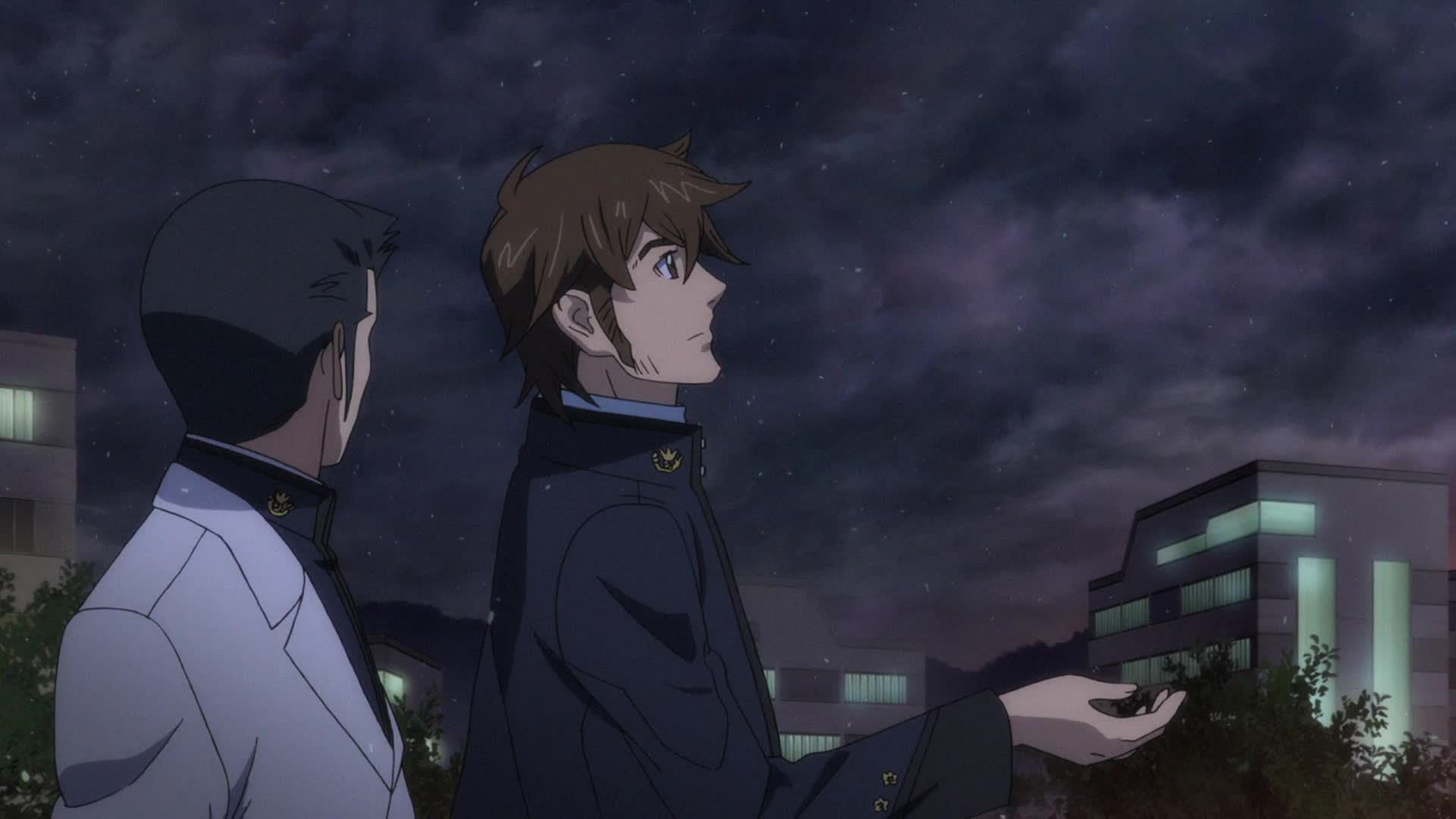
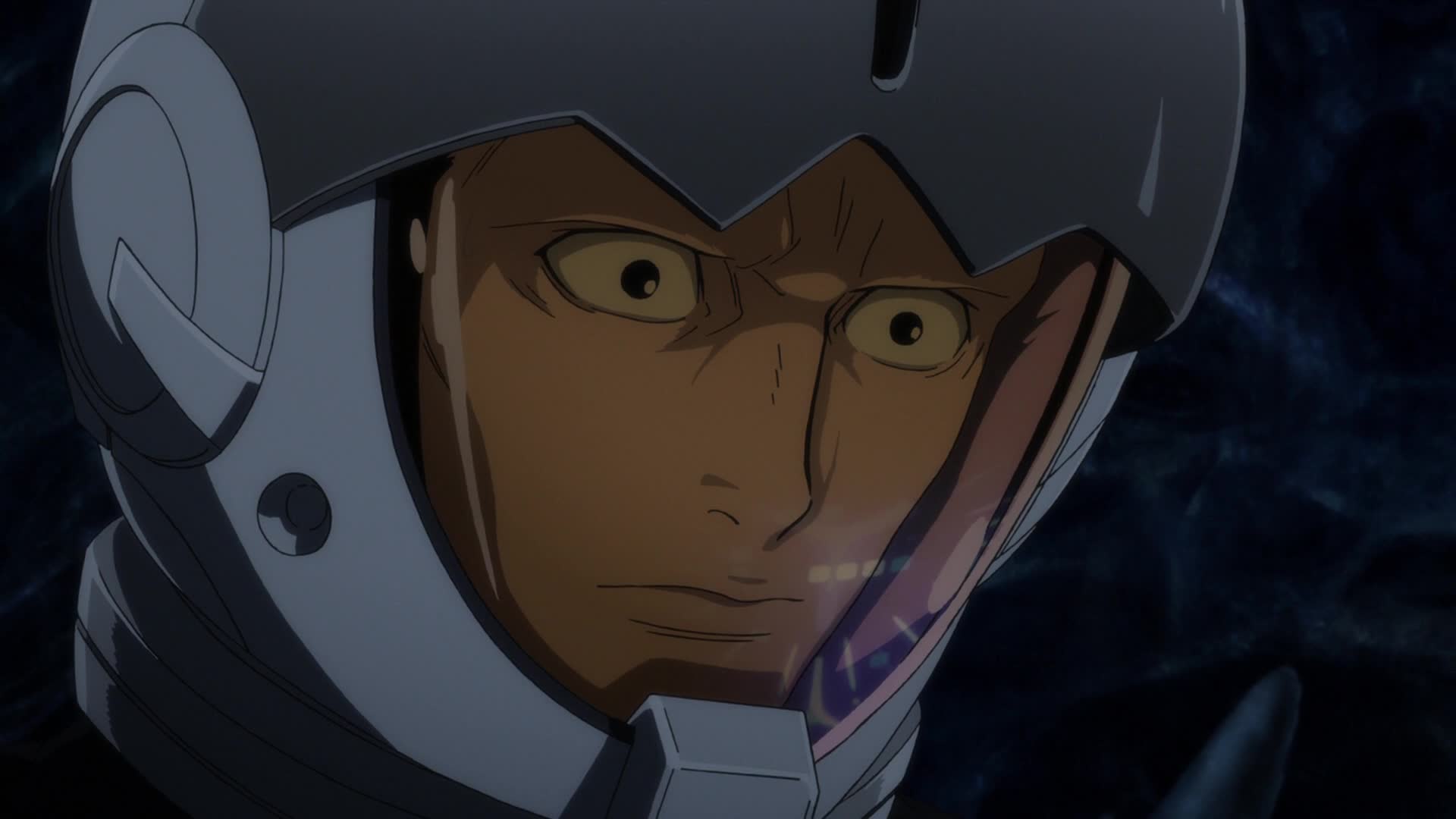
As Mamoru holds out his hand to catch the small snowflakes, he says the two of them are a poem and an equation; they both wish to protect the world in different ways. In that respect, they are the same. Sanada agrees. Looking up at the sky, Mamoru recites Nakahara’s poem, which Sanada concludes in the present day: “The sadness of being defiled causes snow to fall once more”
[LC]: All plot holes aside, the dialogue for this scene is quite beautiful, and sums up Mamoru and Sanada quite well. The man of passion and the man of logic, the soldier and the scientist, the poem and the equation.
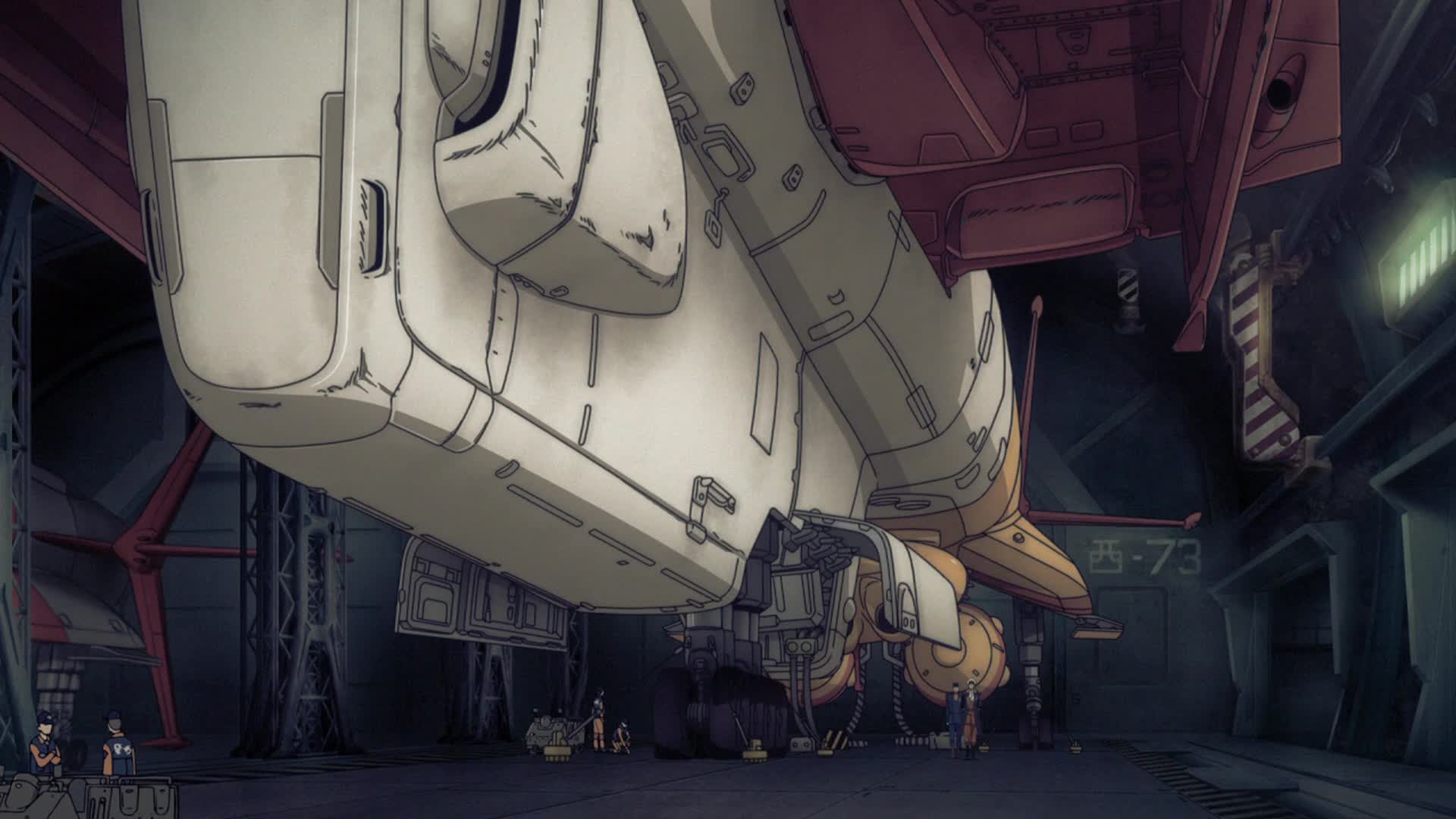
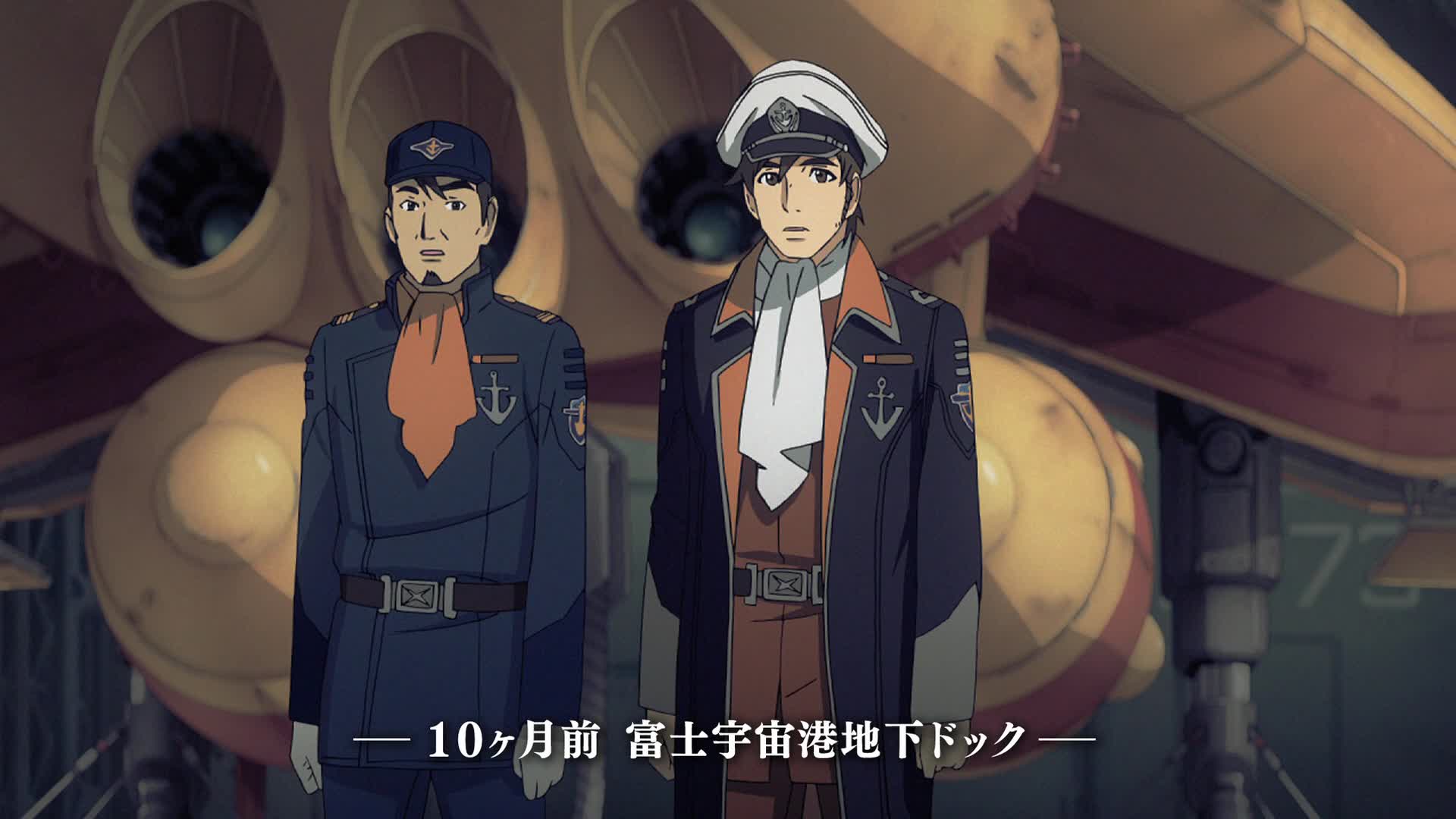
Kodai calls out to Sanada. He tells Kodai that even though Mamoru was his friend, he couldn’t tell him the truth about Operation M: that the whole fleet was just a decoy. Another flashback, this time to a few months prior. We see a large underground hangar, where the destroyer Yukikaze is being prepped for flight. Sanada enters the hangar where Mamoru and Ishizu, his first officer, prepare to board the ship. Ishizu salutes his captain and leaves him to talk to his friend.
[LC]: The screen tag reads “10 Months Ago – Far East Sector Underground Dock.” Based on all we know, even taking only on-screen events into account, this has to be an error. We know Operation M took place on January 17th, 2199. We also know that it took Kirishima 3 weeks to get to Mars. This lines up with what Kodai says in Episode 1, that he and Shima were dropped at Mars 3 weeks before Operation M. That would put the departure date of the fleet close to Christmas, 2198. (or December 24th, if you prefer). That’s roughly 4.5 months ago. No matter what angle you try, at least one that makes any sense, this tag is just plain wrong.
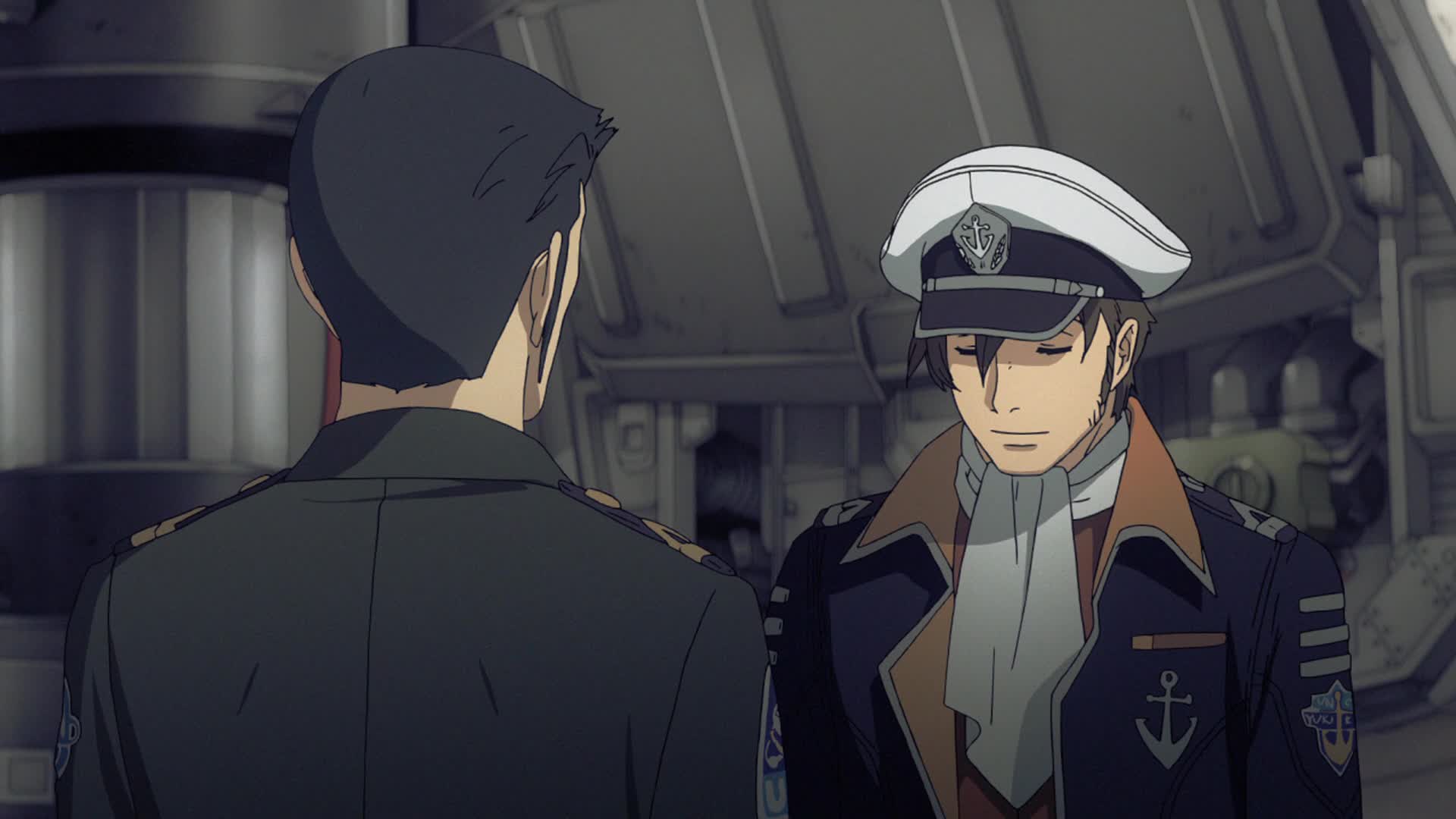
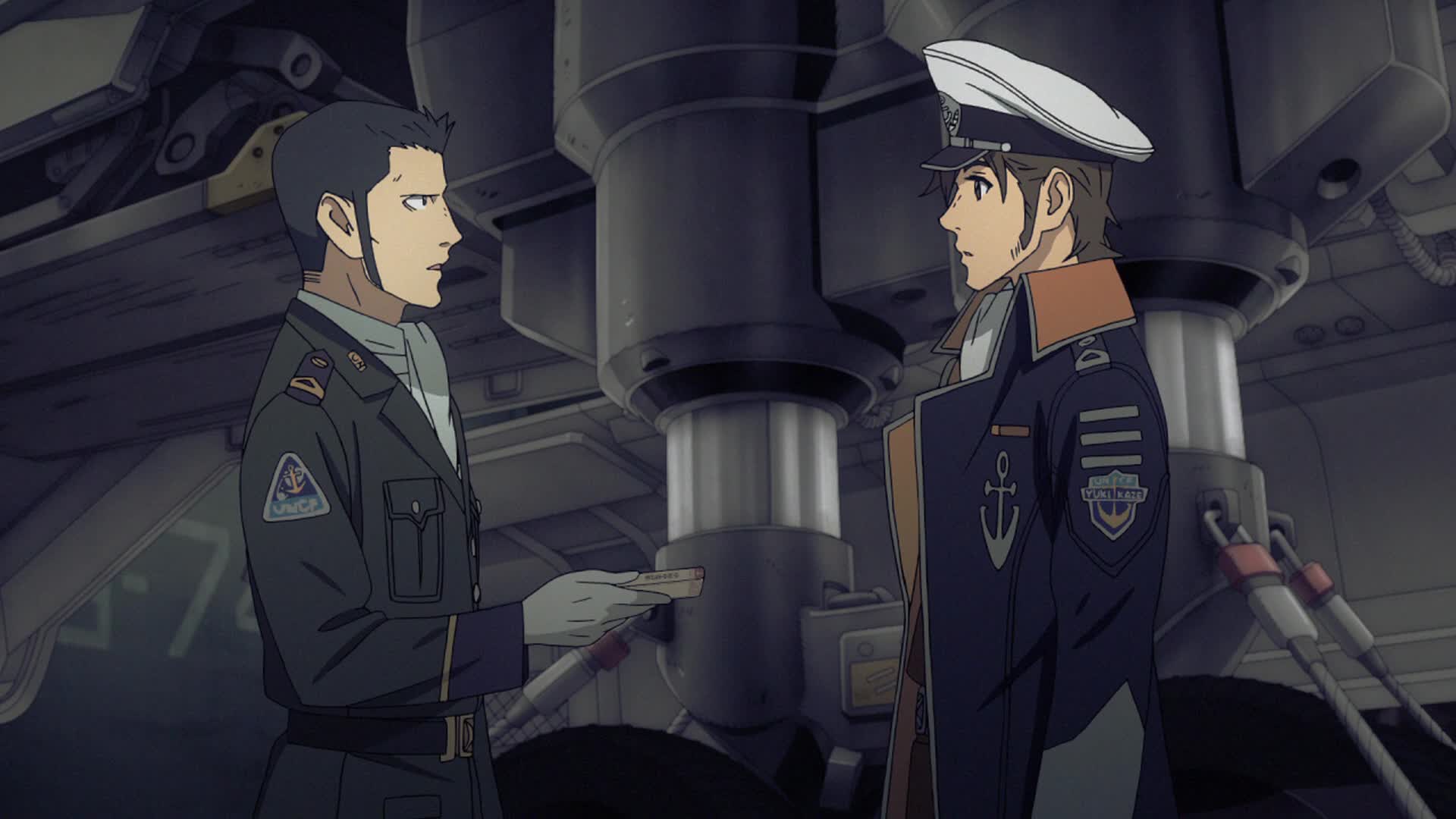
Mamoru says the operation will begin in the morning and that he doesn’t know how many ships will make it in time. But he’s confident and assures Sanada they’ll take out Pluto. Sanada asks him if he has talked to Niimi. With a sad expression, Mamoru tells him they broke up. Sanada takes the poetry book out of his pocket and hands it over to Mamoru but he tells Sanada to keep it. Sanada says he’s read it twice but still doesn’t understand why people like poems. Mamoru laughs and says he doesn’t hold back, which is met with a smile from Sanada.
[LC]: This is the only time they actually say Mamoru and Niimi were dating. Did Niimi know Operation M was just a decoy? From her reaction in the departure scene, we must assume so. I can understand not wanting to be with a guy that’s going to face certain death but breaking up with him, just before you basically send him to the slaughter?! That’s just not very nice. I prefer to think she broke up with him exactly because she couldn’t stand not telling him. It was either her relationship or her career. Still a bit heartless, but a bit better.
[DG]: In fairness, Mamoru didn’t say who broke up with whom. He might have been the instigator, as depicted in the manga version of this flashback.
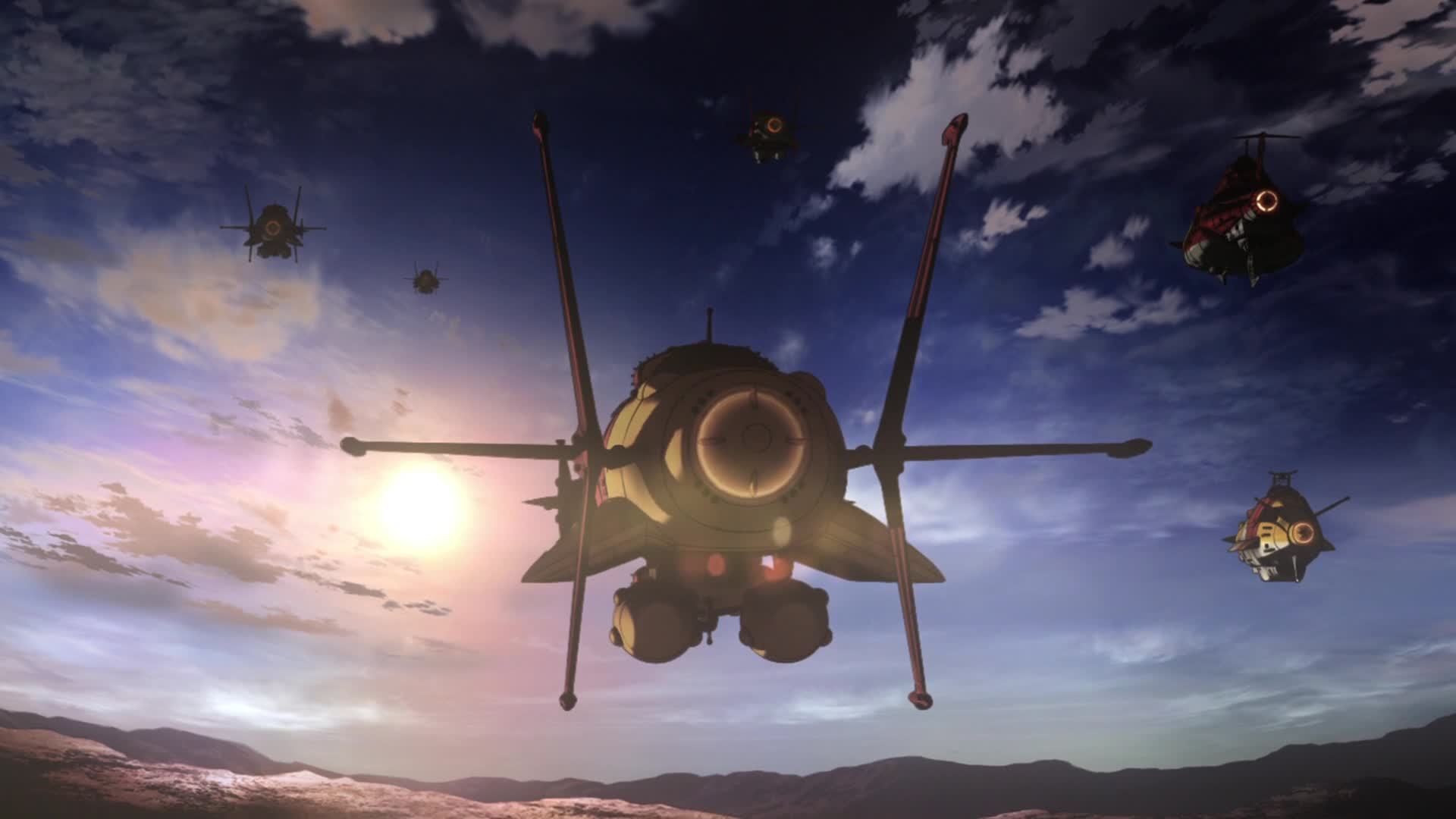

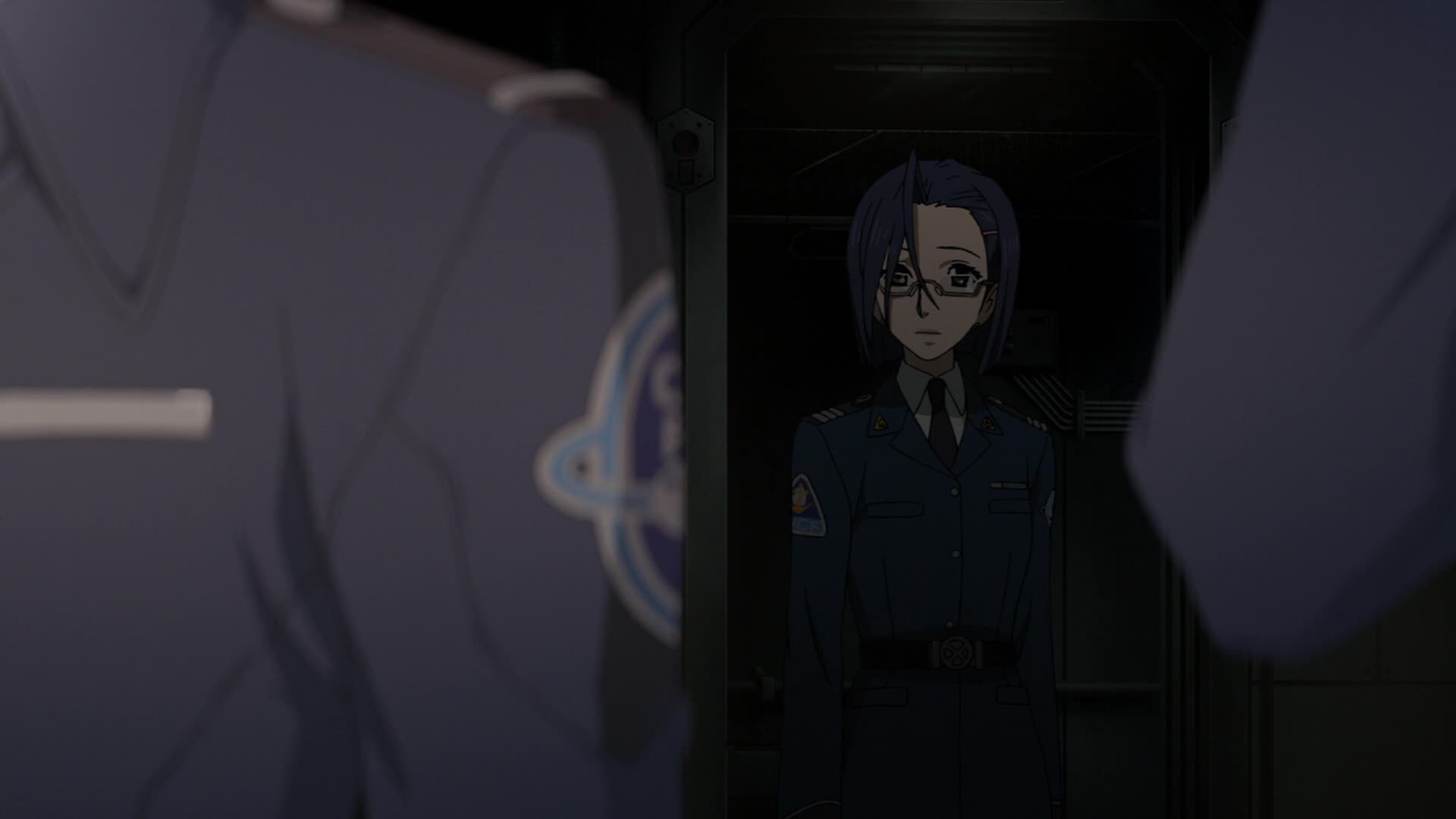
At sunrise, the fleet is raised to the surface and departs for their long journey toward Pluto. Mamuru and his crew salute those on the control bunker. Sanada – with Nakahara’s book still in hand – and those inside salute back. Hidden in the back, Niimi watches the scene before leaving.
[DG]: There are 30 ships in the group that we see launching, but only 22 took part in Operation M. Of these, we see Kirishima and at least seven Murasames. I guess we have to assume that either the extra nine ships were only escorting them into orbit or could not complete the trip to Pluto for whatever reason.
[LC]: This bookends the scene from Episode 4 so perfectly… Sanada and Niimi, once again looking at their friend/lover’s ship. The difference is that here Niimi turns and leaves, perhaps because the knowledge that Mamoru is departing for an almost certain death is too much. In 4 she stays put, facing the inevitable.
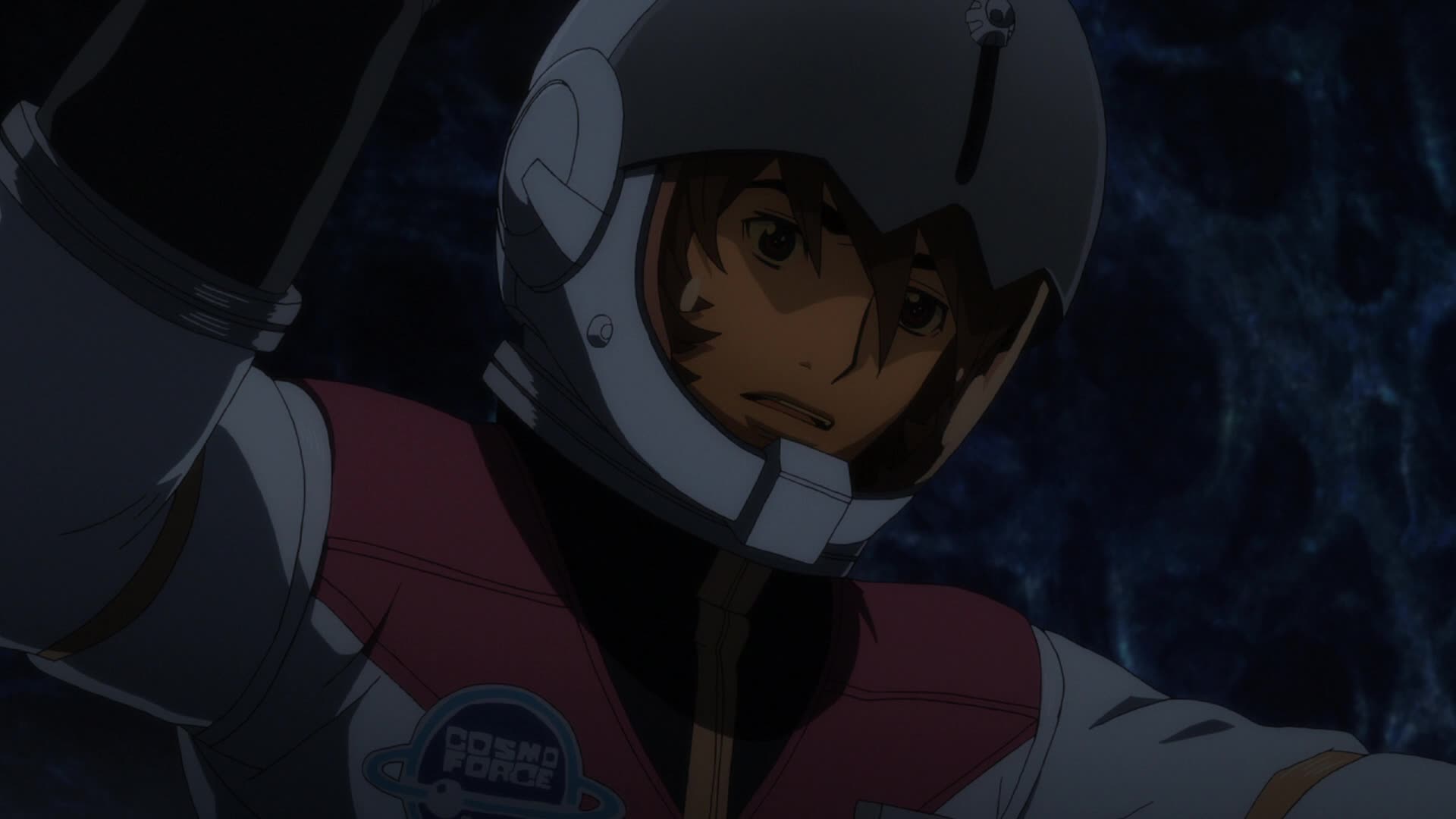
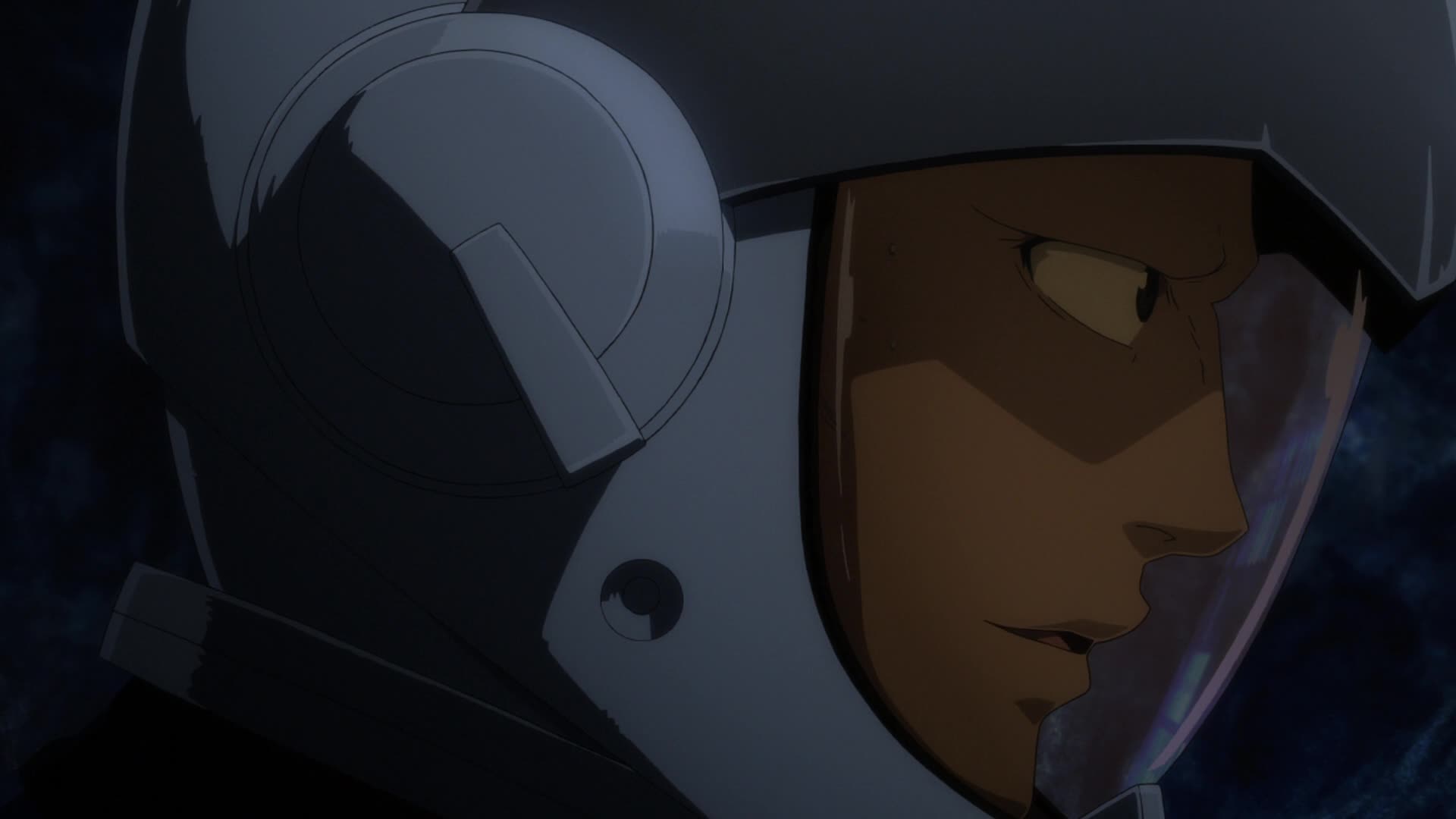
Sanada tells Kodai that the attack on Pluto being just a decoy was top secret. He didn’t have the courage to tell Mamoru the truth, he just obeyed his orders. That’s the kind of man he is. Outside, Kodai closes his eyes for a moment, taking in all these revelations. After a long pause, he tells Sanada that Mamoru would’ve gone to Pluto even if he’d known the truth. No matter the situation or how unreasonable the order, once he’d decided to do it, he would. That that is how is brother was. Sanada is caught by surprise. He agrees with Kodai’s words. He then speaks to Mamoru, telling him his brother is following in his footsteps.
[LC]: Yeah, I have to agree with Kodai. Mamoru would have gone to Pluto even if he knew the truth. Hell, he stayed behind to protect Kirishima’s retreat, and that spelled certain doom as well.
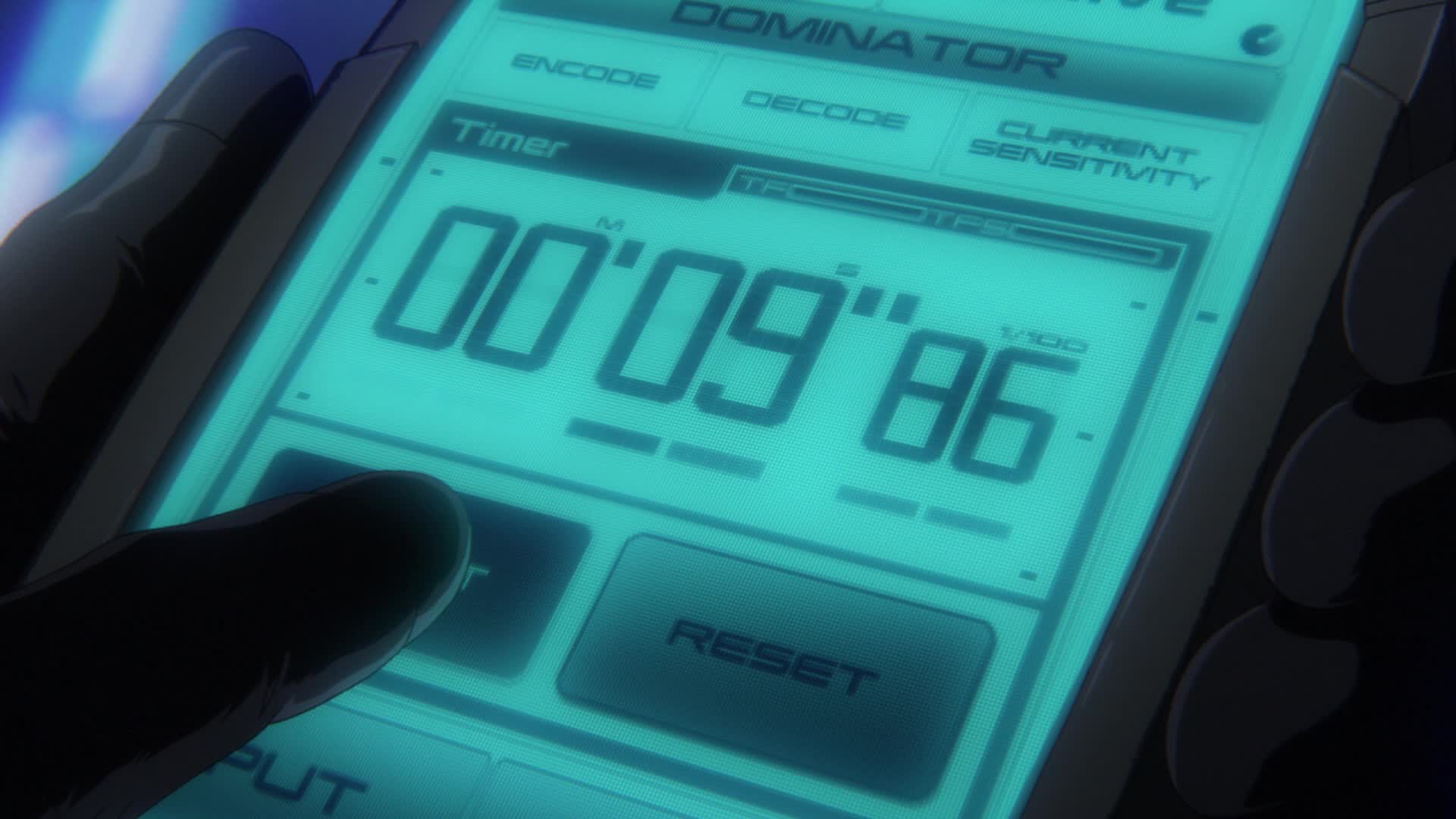
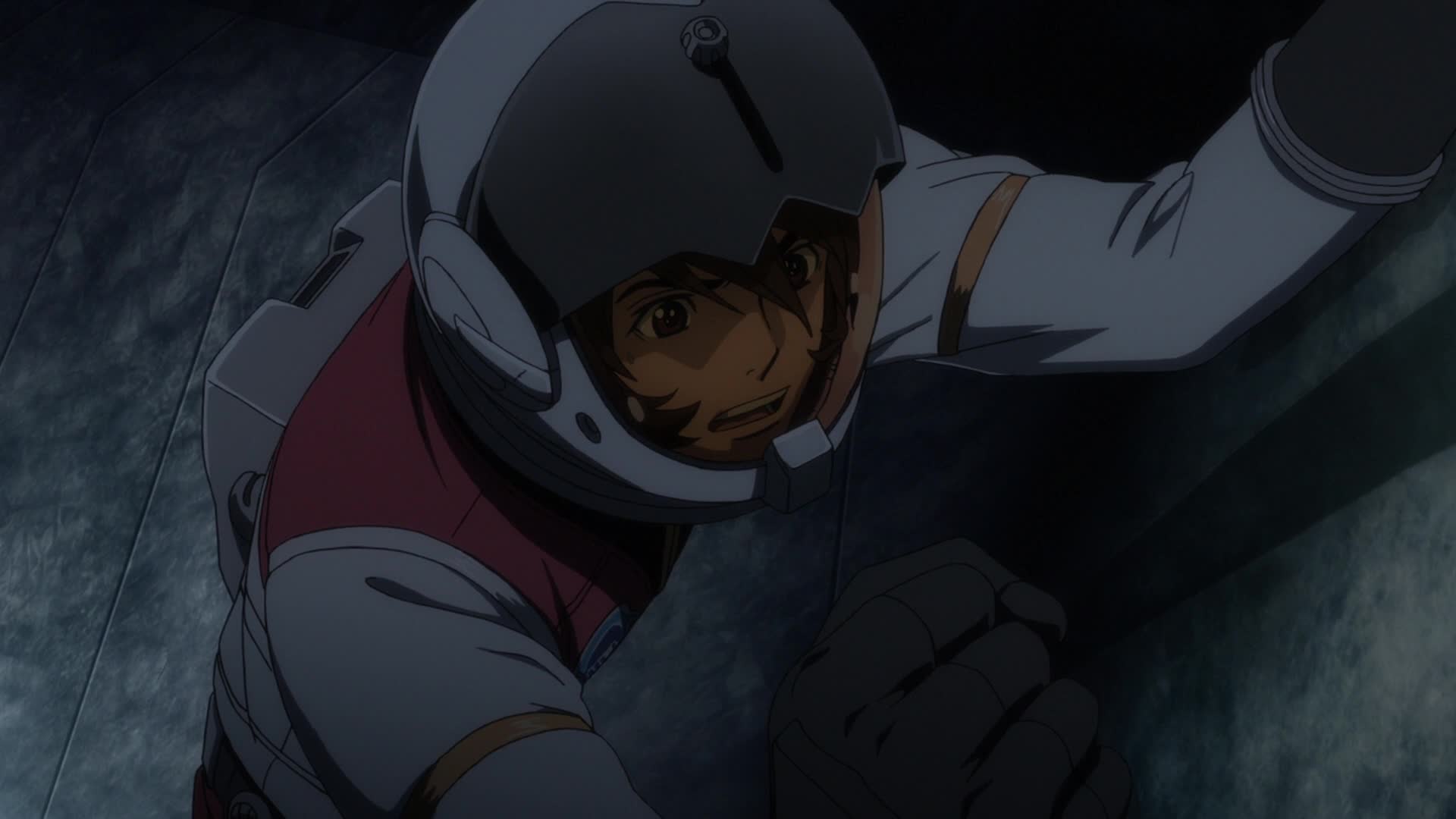
Kodai tells Sanada he didn’t know his brother liked poetry. Yuki is almost through the door’s encryption. Inside, Sanada recites the poem Mamoru loved while he programs the core for restart. He set the activation sequence and a 10-second countdown starts running in his pad. “The sadness of being tainted longs for nothing. The sun sets helplessly with the sadness of being tainted.”
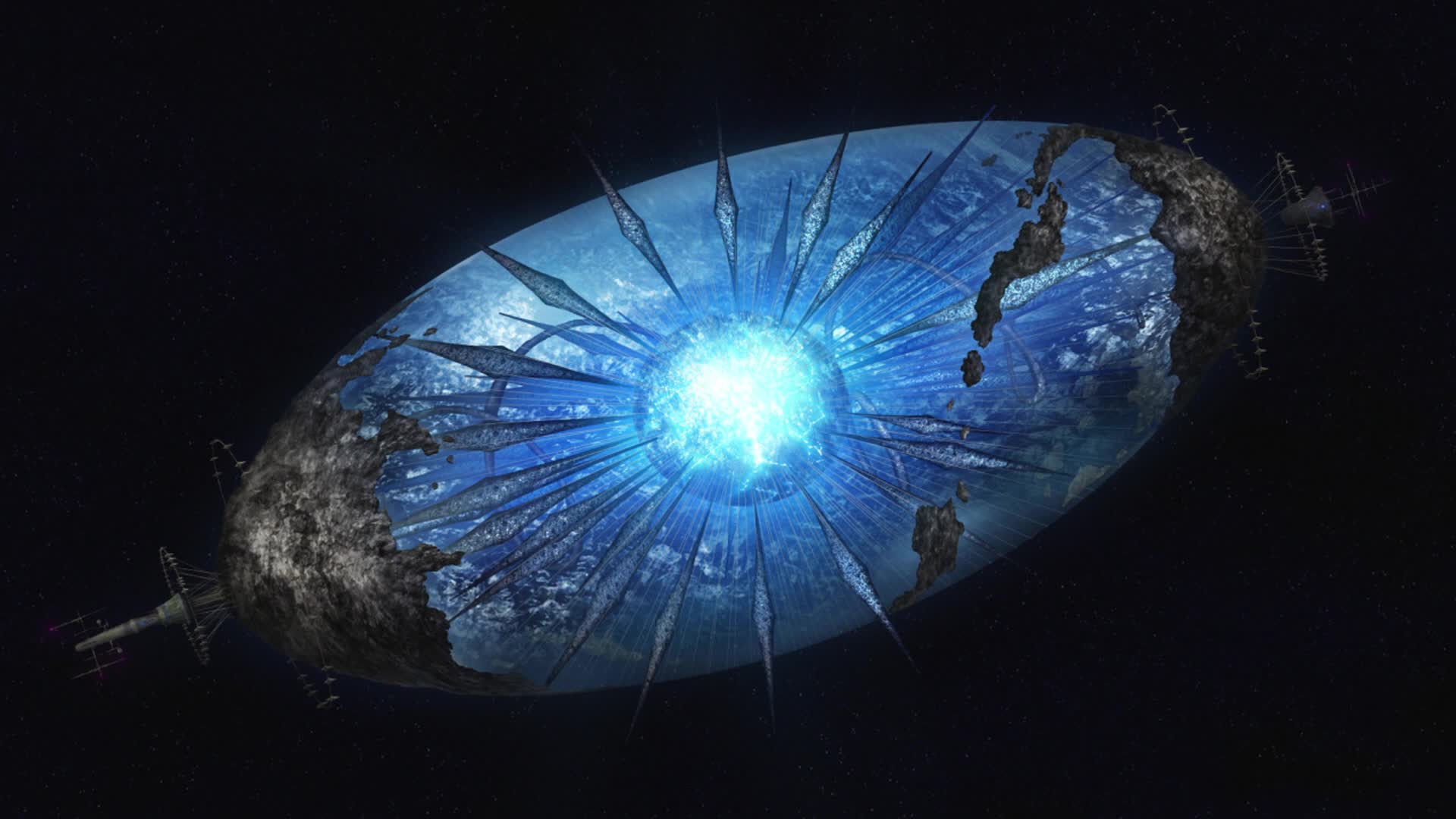
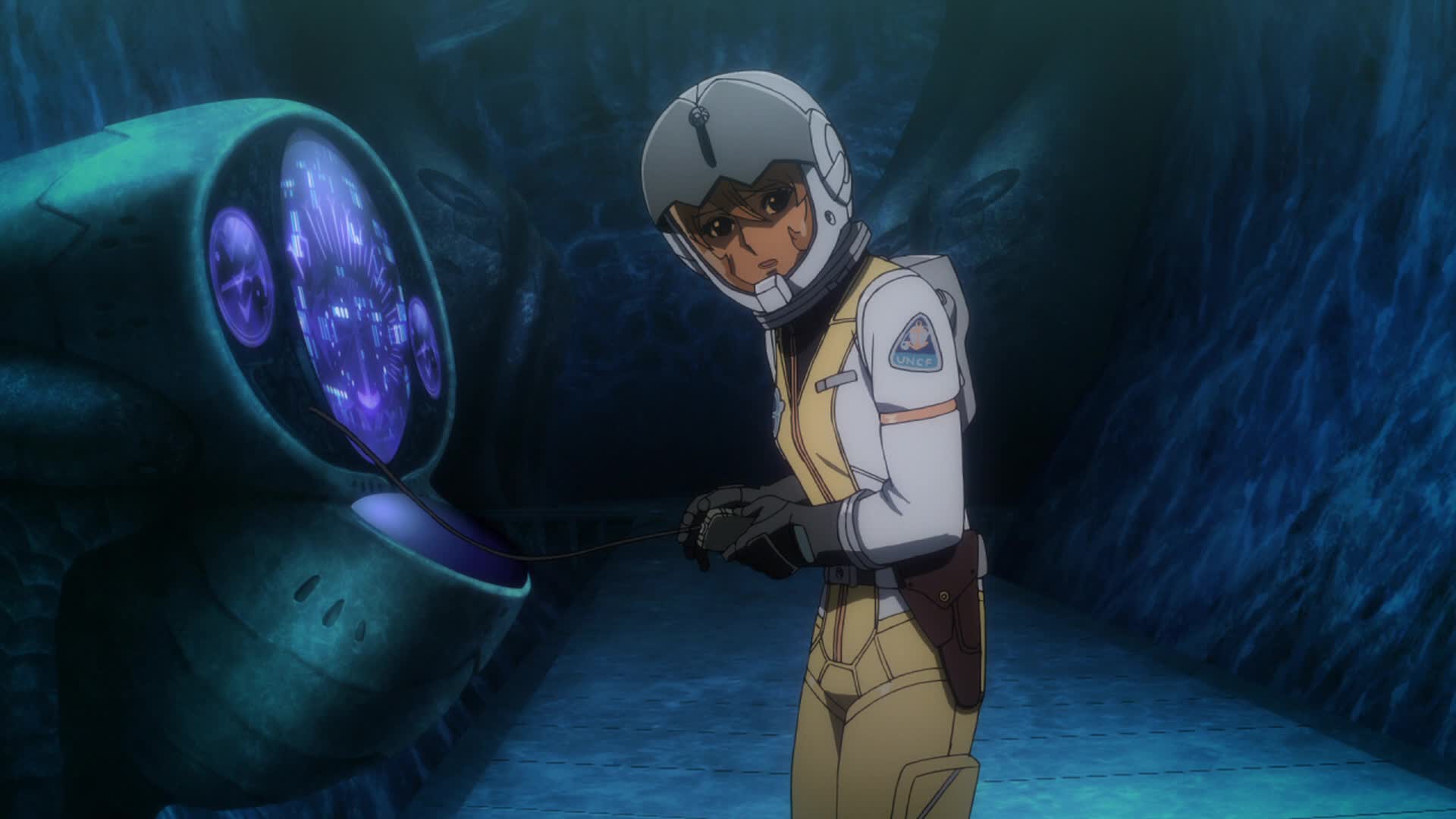
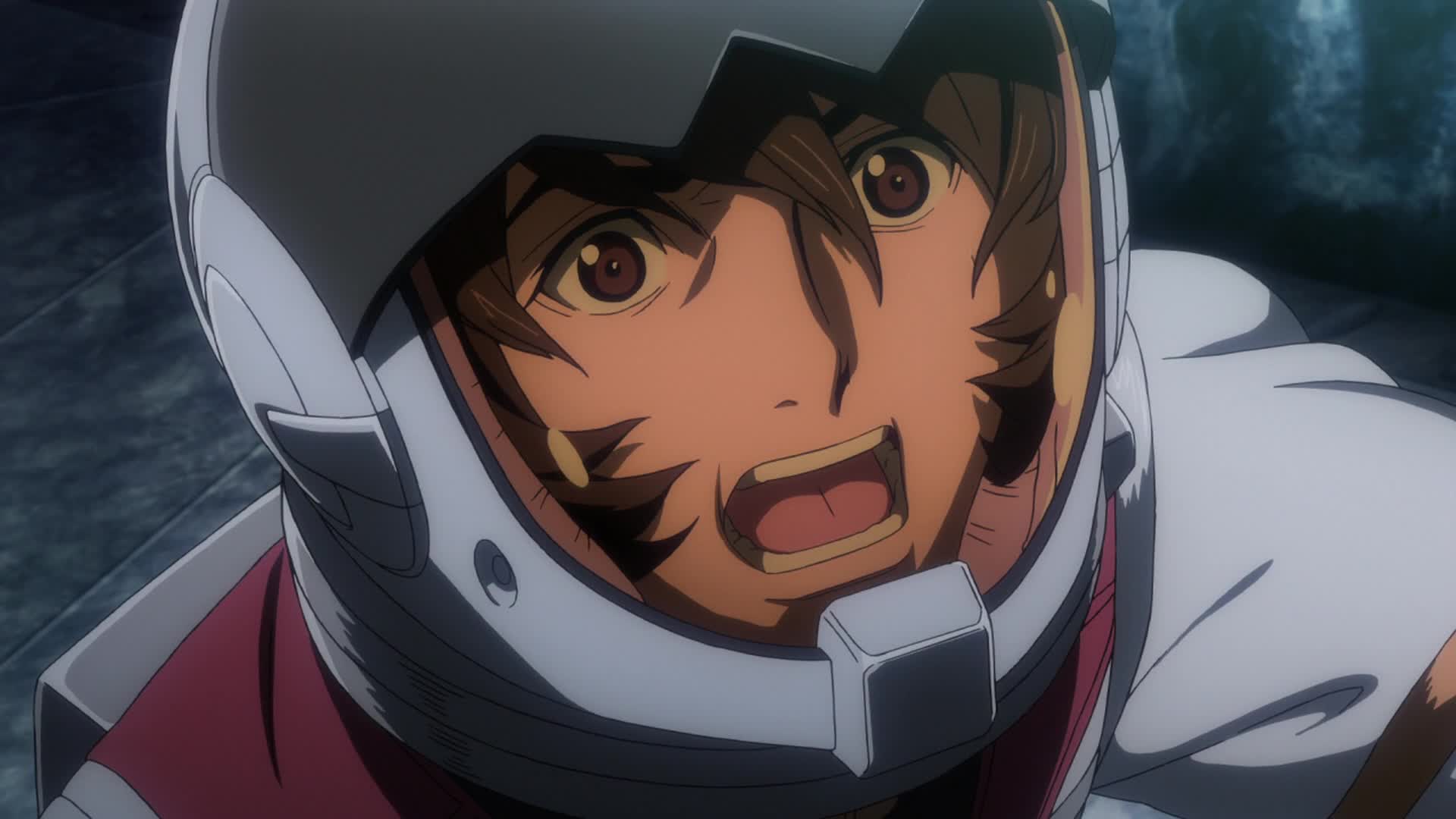
Desperate, Kodai tries to appeal to Sanada. He asks him what made his brother happy? What made him sad? Too late. The core comes to life and Yuki reports the inner chamber has been flooded by neutrons. No one could have survived that. In shock, Kodai lunges at the door, screaming Sanada’s name.
[LC]: This scene, with Kodai pleading for Sanada to stop and to tell him more about his brother, is really touching. Sure, we know Sanada will probably survive, but still…
This is even more poignant when we consider how much Kodai disliked Sanada at the start of the journey. Wonder if he now understands the question Sanada asked that infuriated him back in Episode 5. I guess Mr. Robot is human after all, Kodai?
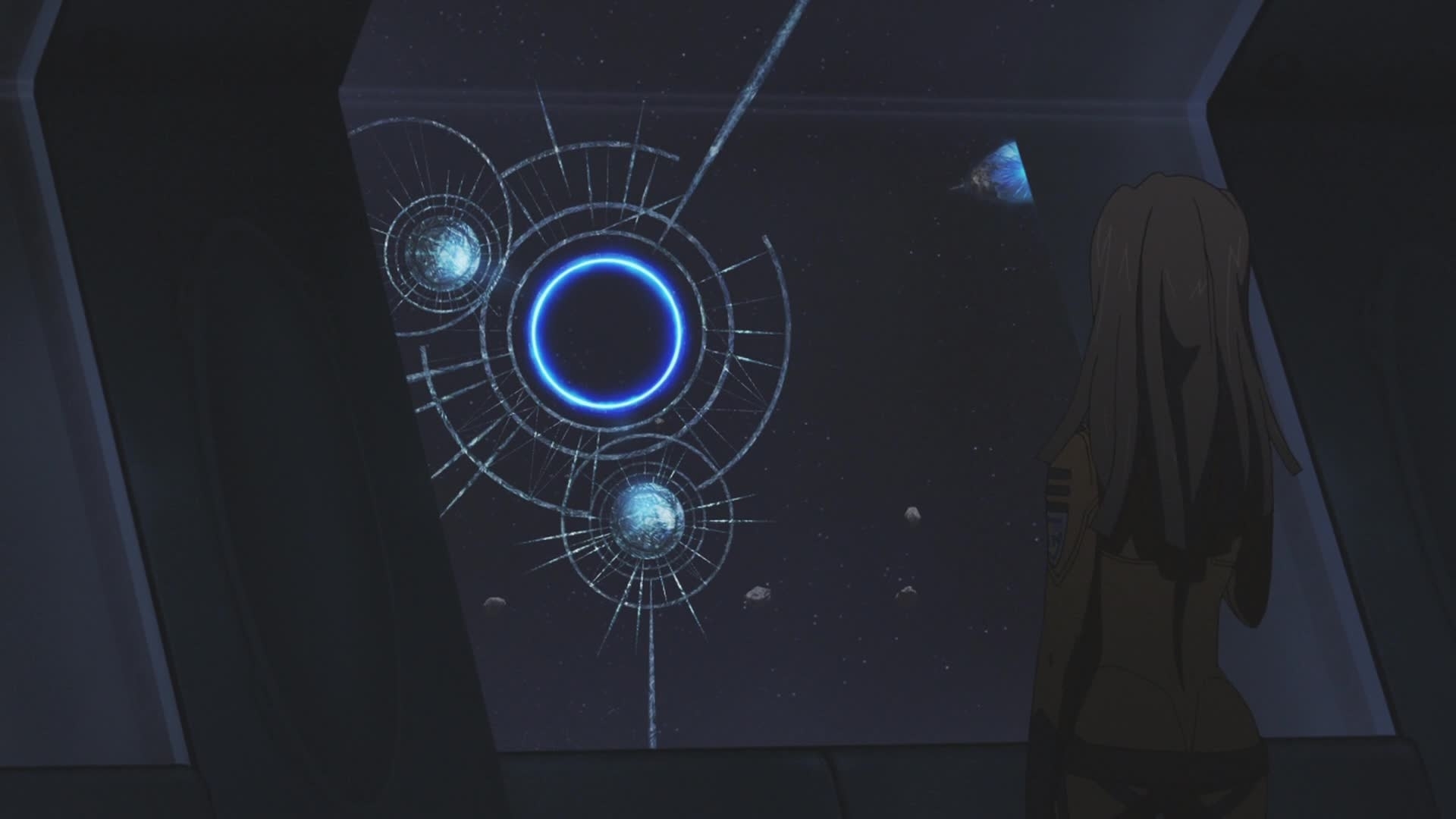
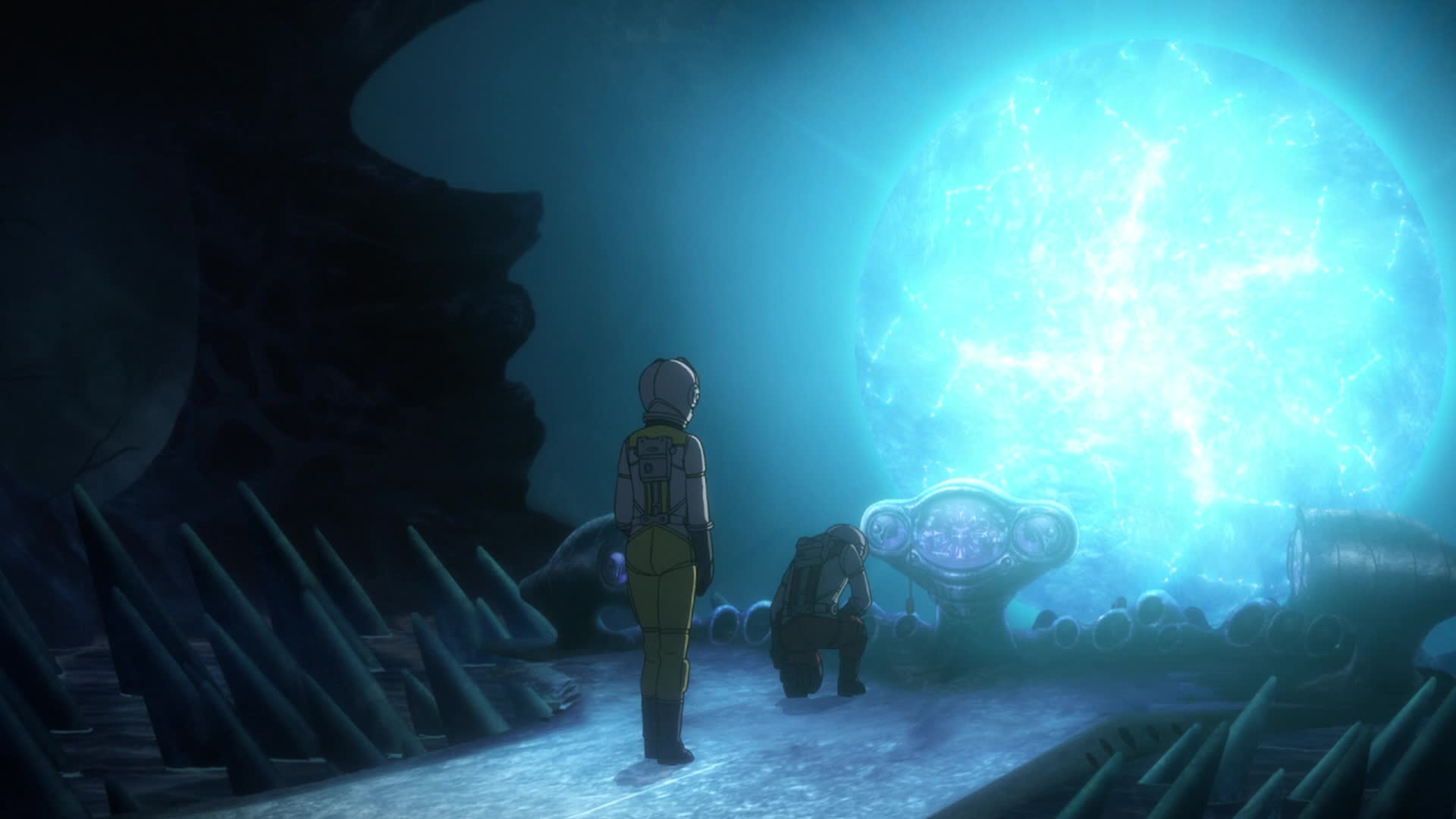
The subspace gate lights up, observed by Yuri(sh)a in bridge number two. She says the door has been opened and it is the path to the mother world. Yuki finally manages to unlock and open the control room door. They run inside but find no trace of Sanada. Kodai falls to his knees, saying he wanted to learn more about his brother. And about Sanada.
[LC]: Two things jumped out at me in this scene. One was the small pools of water surrounding the passage to the control console. The second was… where’s Sanada’s body?! This second question should also have occurred to the two officers unless they think he was vaporized. But that’s not how radiation kills you. Ask the afore mentioned Dr. Slotin. Immediate vaporization would have been a blessing. Acute radiation syndrome is much more unpleasant. So back to my original question… where’s the body?
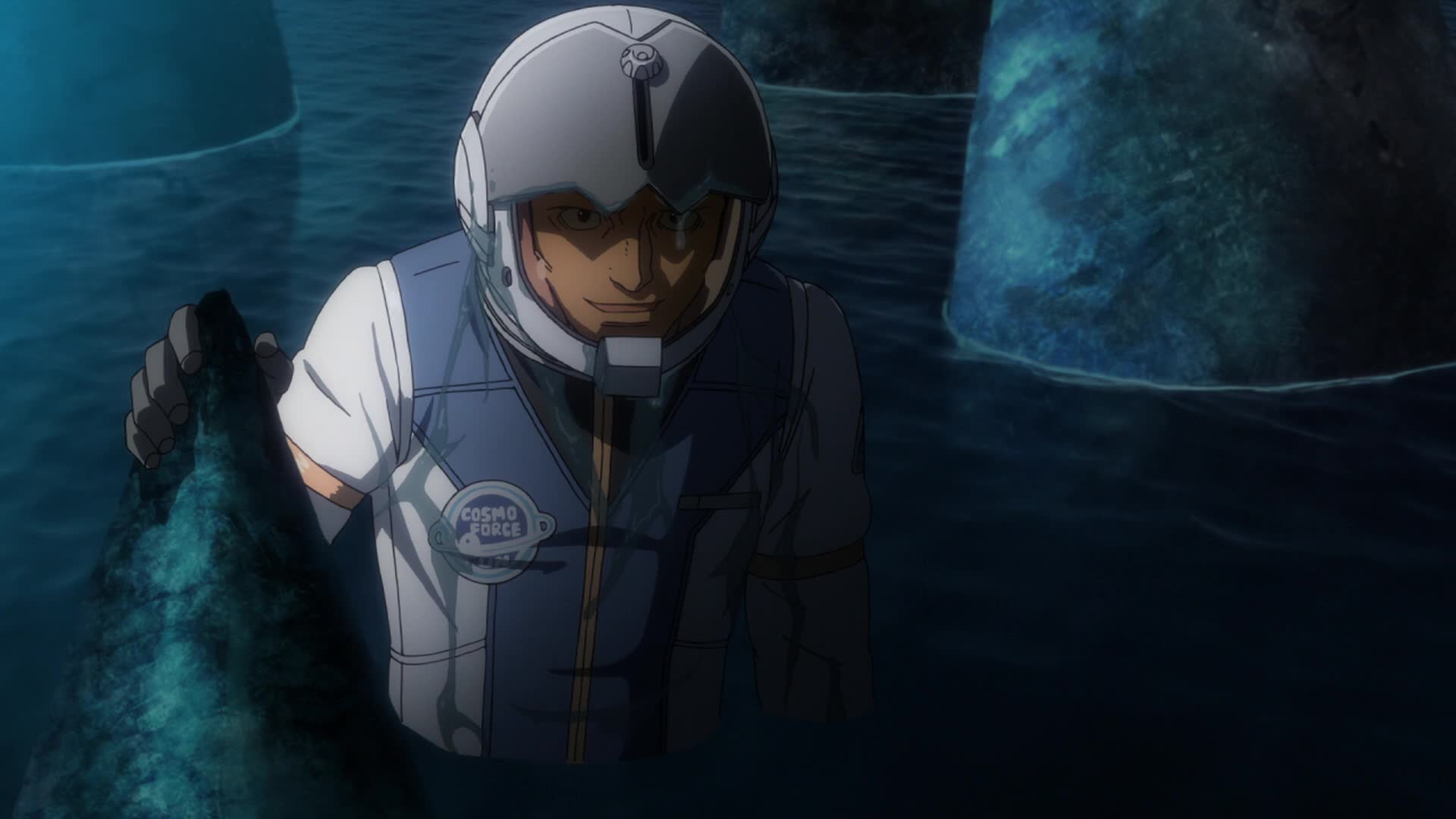
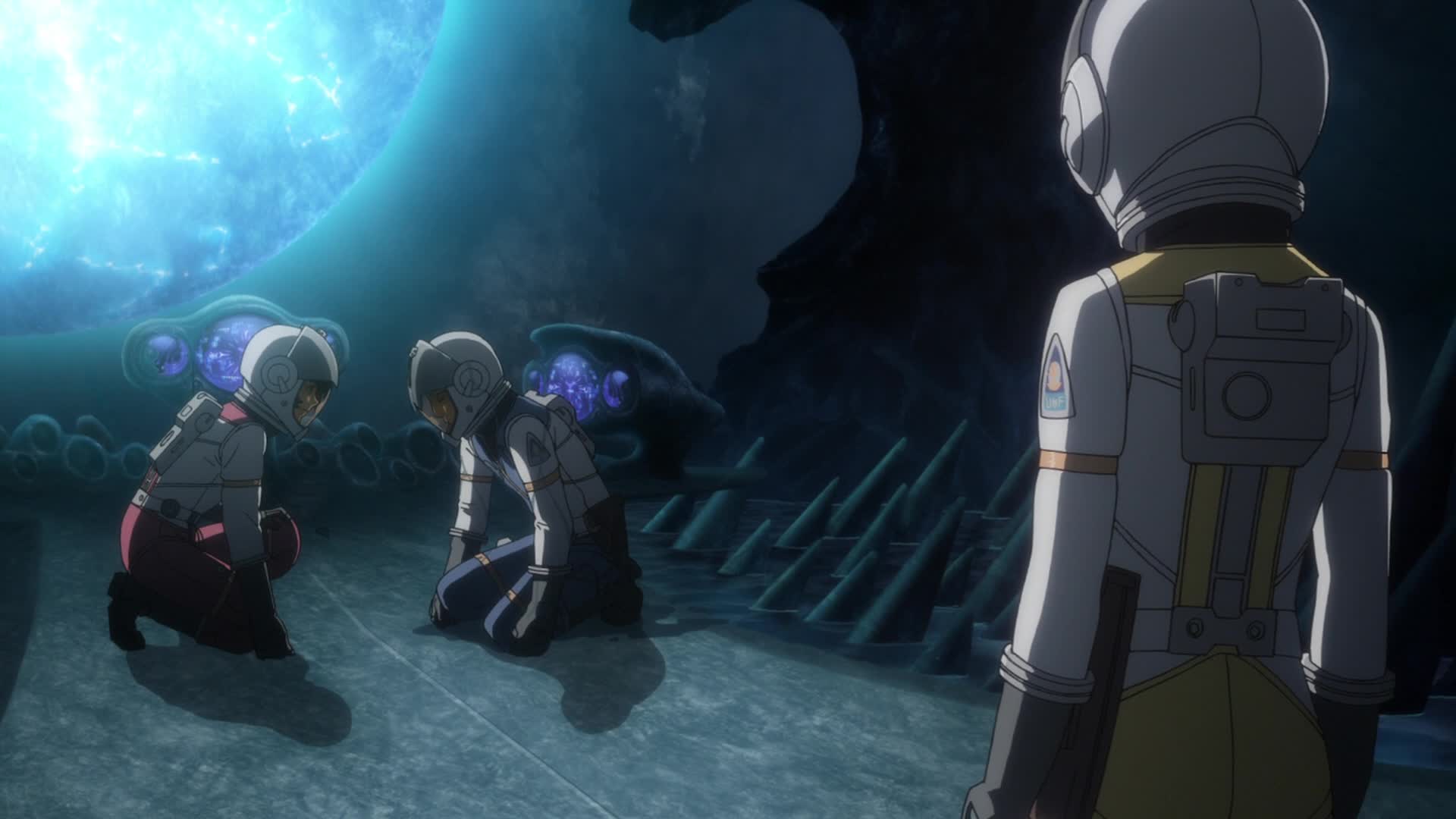
On cue, a hand emerges from the nearby pool of water, grasping a rock. Sanada rises from the pool, much to the surprise and relief of the two youngsters. Sanada explains that neutrons don’t pass easily through water. Kodai goes to him, saying Sanada really amazes him. He helps him out of the pool. The two exchange a gaze, marking a new level of understanding and friendship between them. Yuki watches the scene in silence, smiling.
[DG]:The look on Sanada’s face after he pops out of the the water reminds me of his grin when Kodai finds his soot-covered visage in the original Episode 18.
[LC]: Oh, surprise, Sanada’s not dead! XD
I just have a few questions about this scene. Yes, water is used as an effective shield against radiation. Perhaps not the most effective, but it’s widely used. What I question is if what appears to be a relatively shallow pool would provide sufficient protection. And why are there pools of water in this room at all?!
One can argue this is what they use to protect whoever they send in here to activate the core, answering my previous question. But as I said, wouldn’t it be easier to just shield the room? And if the pools are indeed to dive in and escape the neutron bursts, why are they filled with hazardous spikes?! Was this designed by Michael Bay?! (Those who didn’t get that reference, watch Armageddon and get back to me. 😉 )
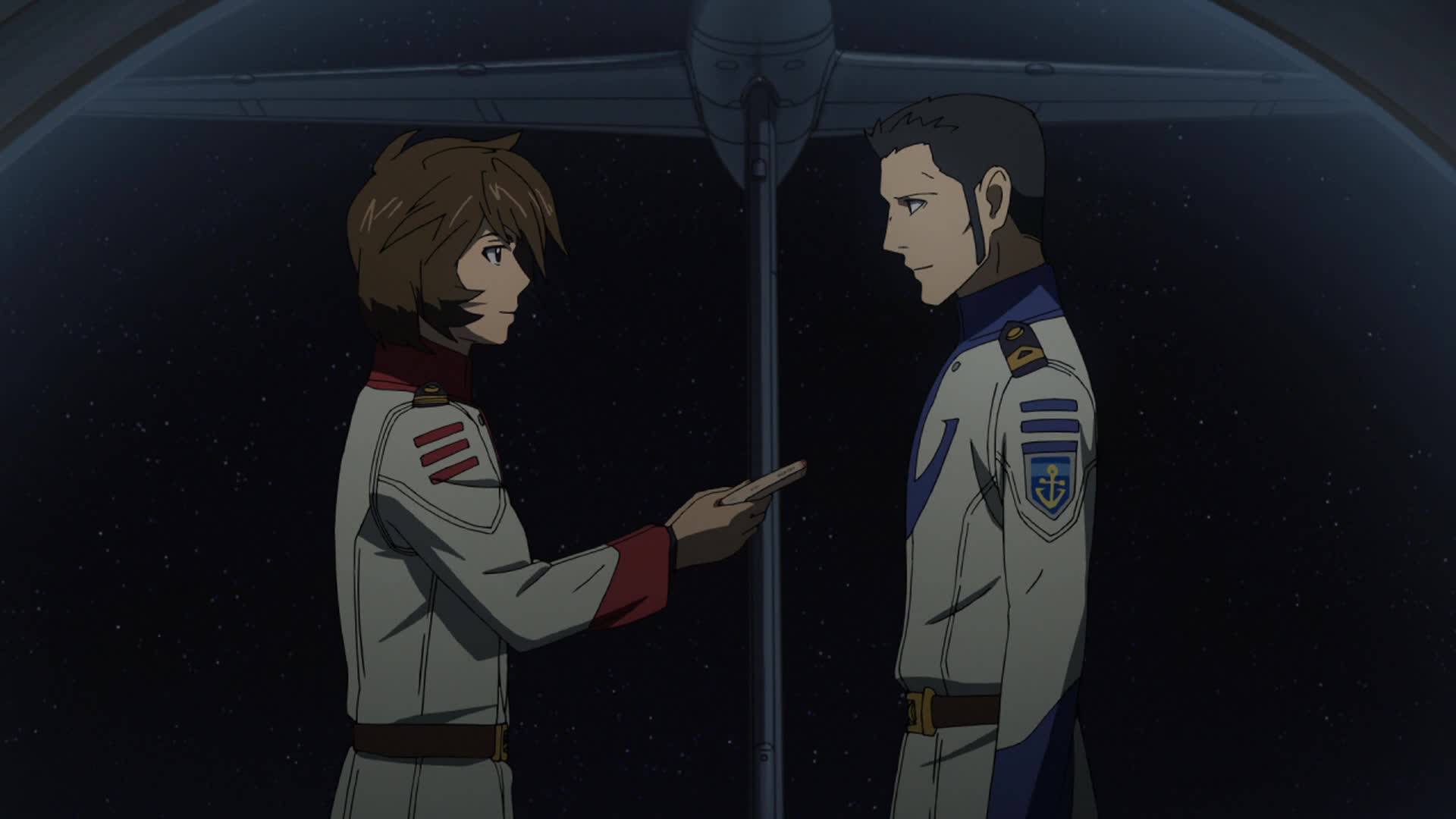
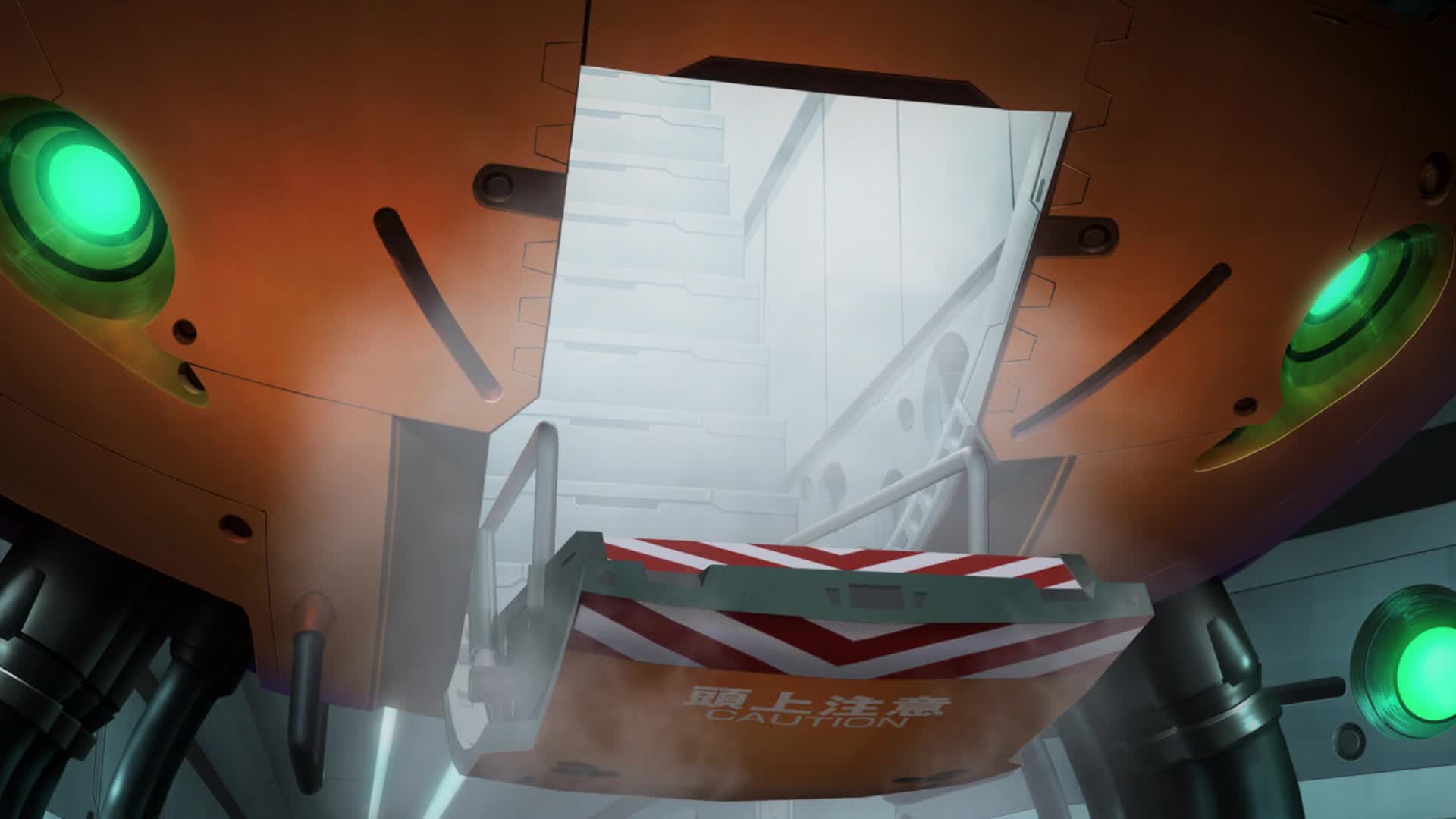
Back on board, Kodai and Sanada are in the rear observation dome. Sanada hands Chuya Nakahara’s book over to Kodai. Kodai holds it for a moment and gives it back to Sanada, but the XO wants him to keep it. Okita addresses the crew over the PA system, informing them the gate has been opened and that it will enable them to jump 30.000 light years.
[LC]: Nice solid moment between these two, bringing a satisfying episode to an end. Important questions answered, important backstories revealed, character development… this baby had it all.
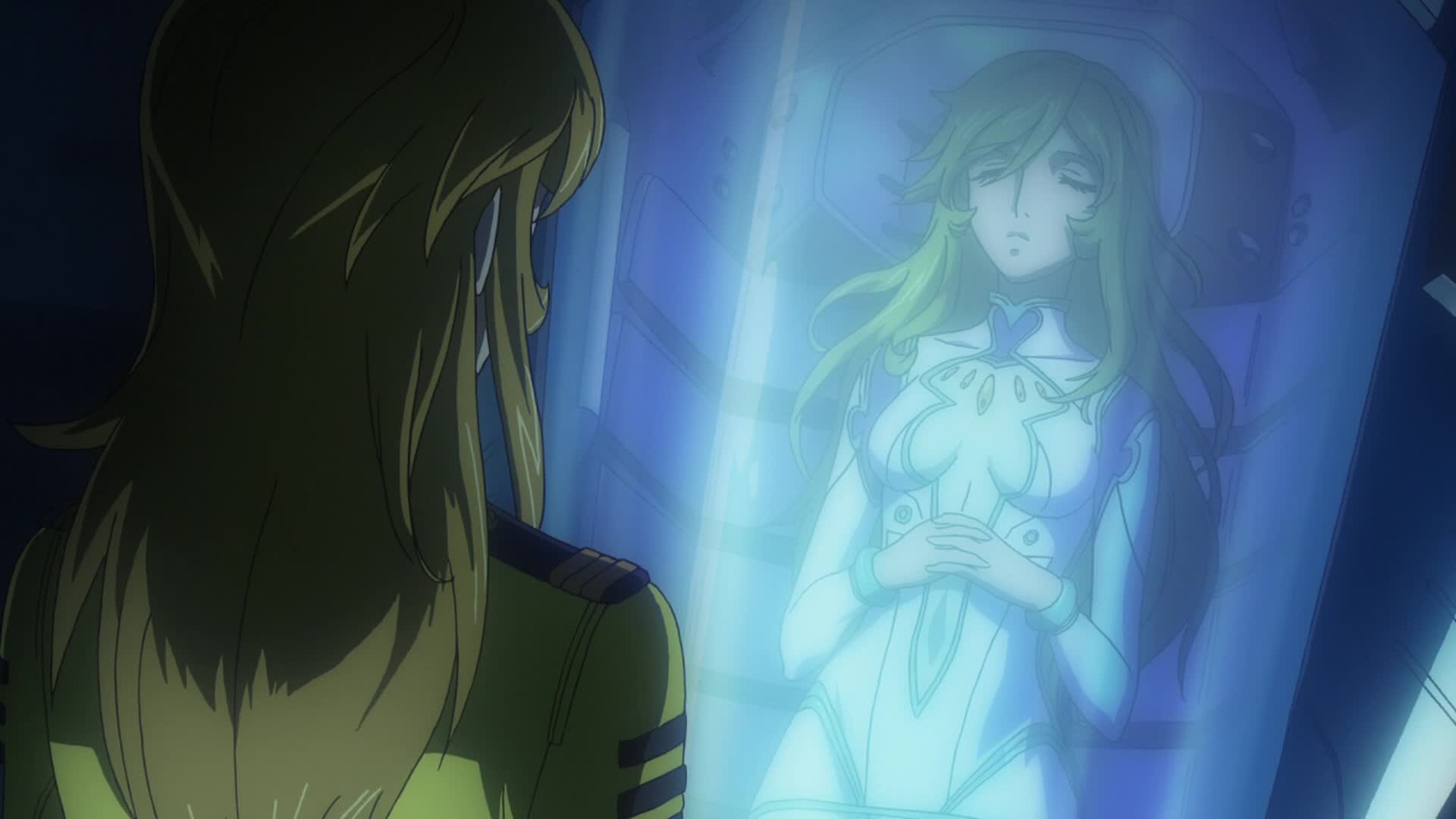
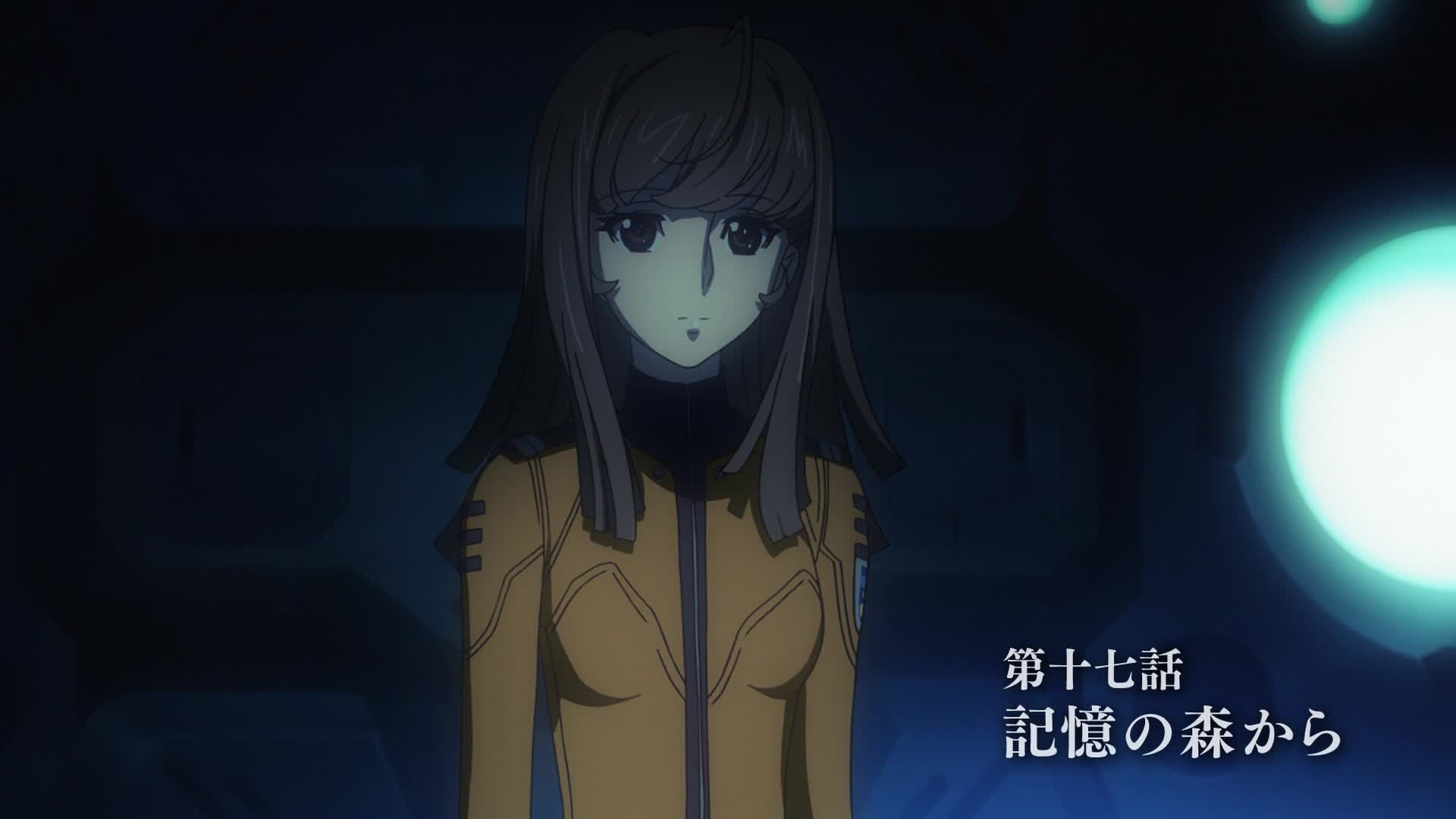
Yuki is in the Automatic Navigation data room and opens the access hatch to the navigation core. Okita says he has to clear something up. As Yuki climbs to the core chamber, he reveals that the rumor going around the ship, about an Iscandarian being on board, is true. But he clarifies that she is not a crew member and that she’s been asleep inside the Automatic Navigation Room. Yuki accesses the control console and the frost layer covering the stasis capsule dissipates. She looks inside, seeing the sleeping Iscandarian princess. When Yuki rhetorically asks if she is Yurisha Iscandar, something unexpected happens. From behind her, a familiar voice answers “no, now I am myself.” Yuki turns to face Misaki Yuri(sh)a, who identifies herself as Yurisha Iscandar.
[LC]: Finally, we get to see the real Yurisha, instead of just a vision or a “ghost.” This scene makes me wonder, does Yurisha’s stasis capsule come with a “frost layer to keep the mystery about what’s inside” generator or did Yuki turn off something important just to take a peek?!
I know I’ve used the sarcastic “Surprise!” line a few too many times but… Surprise! Misaki is Yurisha… except she’s not! XD
Well, at least we can put this ridiculous sub-plot behind us and move on to better things.
PREVIEW:
Balun. A lighthouse in space. The center of a network that connects the galaxy. A gigantic enemy fleet gathers, numbering 10,000 in all. Yamato sets a course straight through for the Large Magellanic Cloud.
Next time: Over the Black Light..
There are 273 days left before humanity becomes extinct.
RELATED LINKS:
Official website of Yamato 2199
Yamato Crew website
Chapter 5 Trailer Short Version
Chapter 5 Trailer Long Version
Episode 17 credits
Screenplay: Hiroshi Onoki
Storyboard: Soichi Masui
Director: Kiyoshi Egami
Chara Animation Director: Hiroki Takaki, Yasuhiro Nakura
Chara Chief Animation Director: Nobuteru Yuuki
Mecha Chief Animation Director: Masanori Nishii
Series credits
Original Story: Yoshinobu Nishizaki
Planning: Shoji Nishizaki, Mitsuhisa Ishikawa, Satoshi Kono
Original Character Design: Nobuteru Yuuki
Guest Character/Prop Design: Shinichi Yamaoka
Mecha Design: Junichiro Tamamori, Yasushi Ishizu, Kiminori Yamane, Yutaka Izubuchi
Set Design: Takeshi Takakura, Makoto Kobayashi, Takashi Watanabe
Concept Design Support: Kazutaka Miyatake
Chief Director: Akihiro Enomoto
Director of Photography: Takashi Aoki
Art Director: Minoru Maeda
Video Editing: Emi Onodera
Color Correction: Rumiko Suzushiro
Music: Akira Miyagawa, Hiroshi Miyagawa
Sound Director: Tomohiro Yoshida
Sound Effects: Mitsuru Kashiwabara
Chief Mecha Animation Director: Masanori Nishii
CG Director: Takashi Imanishi
General Director: Yutaka Izubuchi
Production: Space Battleship Yamato Production Committee
Production IG, Bandai Visual, Xebec, Bandai, Bandai Namco Games, Voyager Entertainment,
Tohoku Shinsha Film Corporation, Shochiku Co. Ltd., OLM, Lantis Co. Ltd.

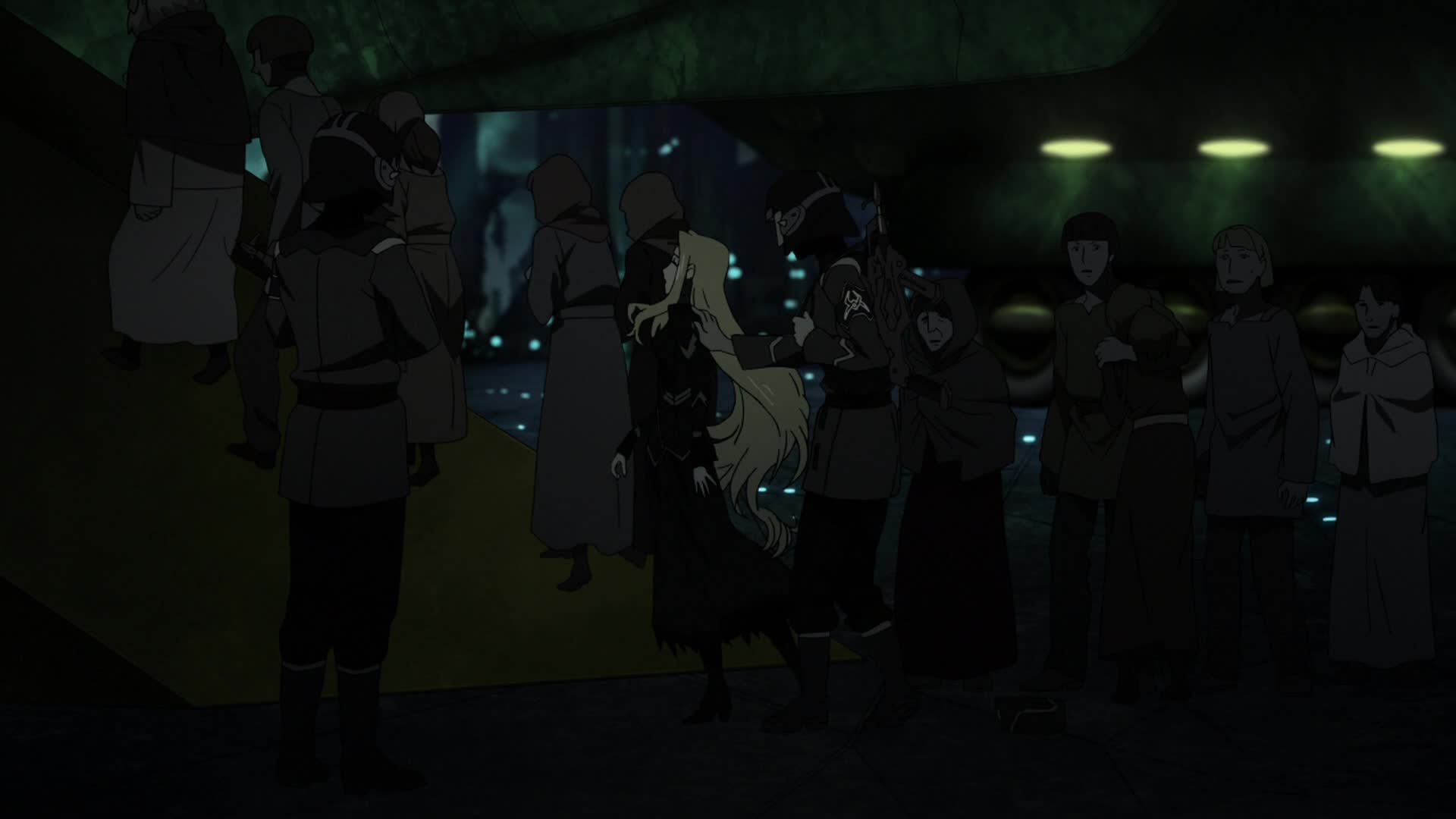
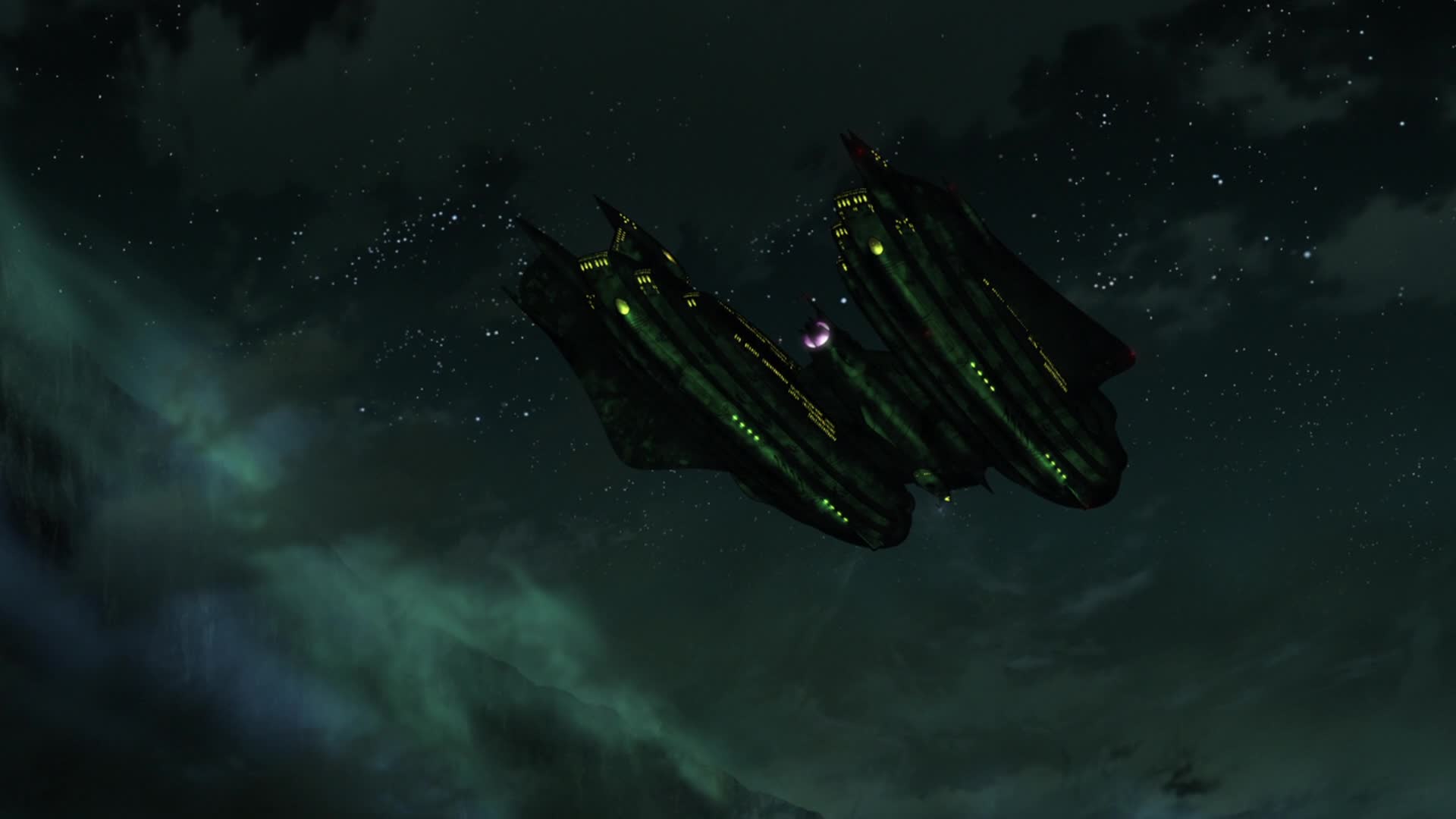
Hmm… What were the script-writers thinking when they put the sham trial into this episode!? Why not just say it took two weeks to “gather evidence” (or given Gimleh’s smug attitude, two weeks to fake the evidence)? Speedy trials are rare even in the real Twenty-First Century. Civilian trial dates for murderers are generally placed months, if not YEARS, after the defendant has been indicted unless a treasure trove of evidence that undoubtedly incriminates the defendant was found right at the scene. Here, Domel was likely locked up for some time while the lawyers scrambled around looking for a convenient solution. Circumstantial evidence is used for lack of anything else, so of course the judges leap to the conclusion that Domel ordered the murder using his wife to communicate with rebels. Either that or Domel and Deitz are getting tossed in jail to throw off the true assassin, but why was such a horribly planned “distraction” even employed?
Like you, I would like to have seen more of a judicial process and a more serious attempt to gather and present solid evidence against General Domel. Having said that, it’s important to remember that only democracies invest the time and effort in these things, not authoritarian states. Dictatorships (such as this recent example from North Korea: http://www.bbc.com/news/world-asia-35109452) have trials that go much, much faster. Under Dessler’s system–just like the Nazis or Stalin’s USSR or North Korea–if the Imperial Guard claims anything, it must be “true.”
I do not think that connecting Yurisha’s mind to the ship’s system was that far beyond Earth’s technological capacity. We know even from the original series that they have these mind probes that they use to interrogate captives: It is not that far a stretch to assume that these instruments could be developed into a handshake link between brain and computer.
The real problem with this technology is whether the data you want can be retrieved in a usable format. If I were to hook up a brain to a computer, I might end up reading complete nonsense on a screen. It’s not like the information you want is stored in a tidy virtual folder in somebody’s mental desktop space with the label “here I am, read me.” Or did some people have to be sacrificed in order to design a mind-to-map interface usable for Yamato?
One example: “Kodai tells Sanada he didn’t know his brother liked poetry. Yuki is almost through the door’s encryption.”
Why is Shiro Sanada always “Sanada” (last name) and Susumu Kodai usually “Kodai” (last name), but Yuki Mori is always “Yuki” (first name)? A reader who didn’t know better might suspect there was a little sexism going on….
This is how it’s been with Yamato since 1974. Instances of Yuki being referred to as “Mori-san” are extremely rare.
The 1974 original isn’t 2199, and the new show is stronger on gender equality than the first one (although more could be done). According to captions in 2199, she’s referred to as “Mori” or “Officer Mori” a lot (especially by Sanada), with “Yuki” coming up much less often in more formal situations. But I was really talking about the commentary here, not the episodes. The same thing happens with Melda Dietz, Elisa Domel, and Makoto Harada – usually called by their first names in the commentary, unlike the men. It’s the 21st century. Can’t we do better?
Yes we can, but we’re also inheriting decades-old pattern recognition. Far more people recognize “Kodai” over “Susumu” or “Sanada” over “Shiro.” For consistency we could go with all first names or all last names, but some recognition will be compromised regardless of the choice. Alternately, we could go with all full names, but that would get pretty tiresome after a few sentences. We go with what we believe to be the briefest, simplest form of communication at all times. There is no sexism behind it.
So painful… There are only two ways Sanada’s “sacrifice” could possibly make sense.
Either Sanada was serious in his attempt at self-sacrifice, but suddenly realized at the very last second that the water would protect him. But his setting a time for activation implies he knew he had an out, which means…
Sanada knew he had an out, but intentionally misled Kodai and maintained the fiction of self-sacrifice simply to troll Kodai. Whether the decision was made at the last second, just before setting up his timer, or whether he had thought it through even before locking Kodai and Yuki out of the control room is immaterial.
That’s pretty harsh manipulation from Sanada. But it’s the only way this scene makes sense.
I mean, or the whole implausible situation was just slapped together by some lazy writers for cheap drama, assuming the viewers would be as stupid as the younger Kodai.
I’ve always thought that Sanada could see a possible way to survive the situation but didn’t want to give his shipmates any false hope for his survival.
He’d probably feel a bit of a berk if he said he’d be fine, then jumped into the water to find it was only a couple of inches deep. Well, for a few seconds at least 🙂
Thoughts regarding Mamoru and Operation K2: the Royal Navy runs University RN Units which allow students to get a feel for naval life and the opportunity to go to sea on P2000 patrol craft, among other things. There’s no obligation to join the RN after they’ve graduated.
In Yamato, with a huge battle looming and the fate of humanity in the balance, I can quite easily see the Cosmo Navy requiring anybody with any sort of naval experience to step up to the line.